My most current blog entry:
USA Road Trip: The Wild West - Pipe Springs and Cove Fort
 Thursday, February 24, 2022 at 6:50PM
Thursday, February 24, 2022 at 6:50PM PIPE SPRINGS, ARIZONA
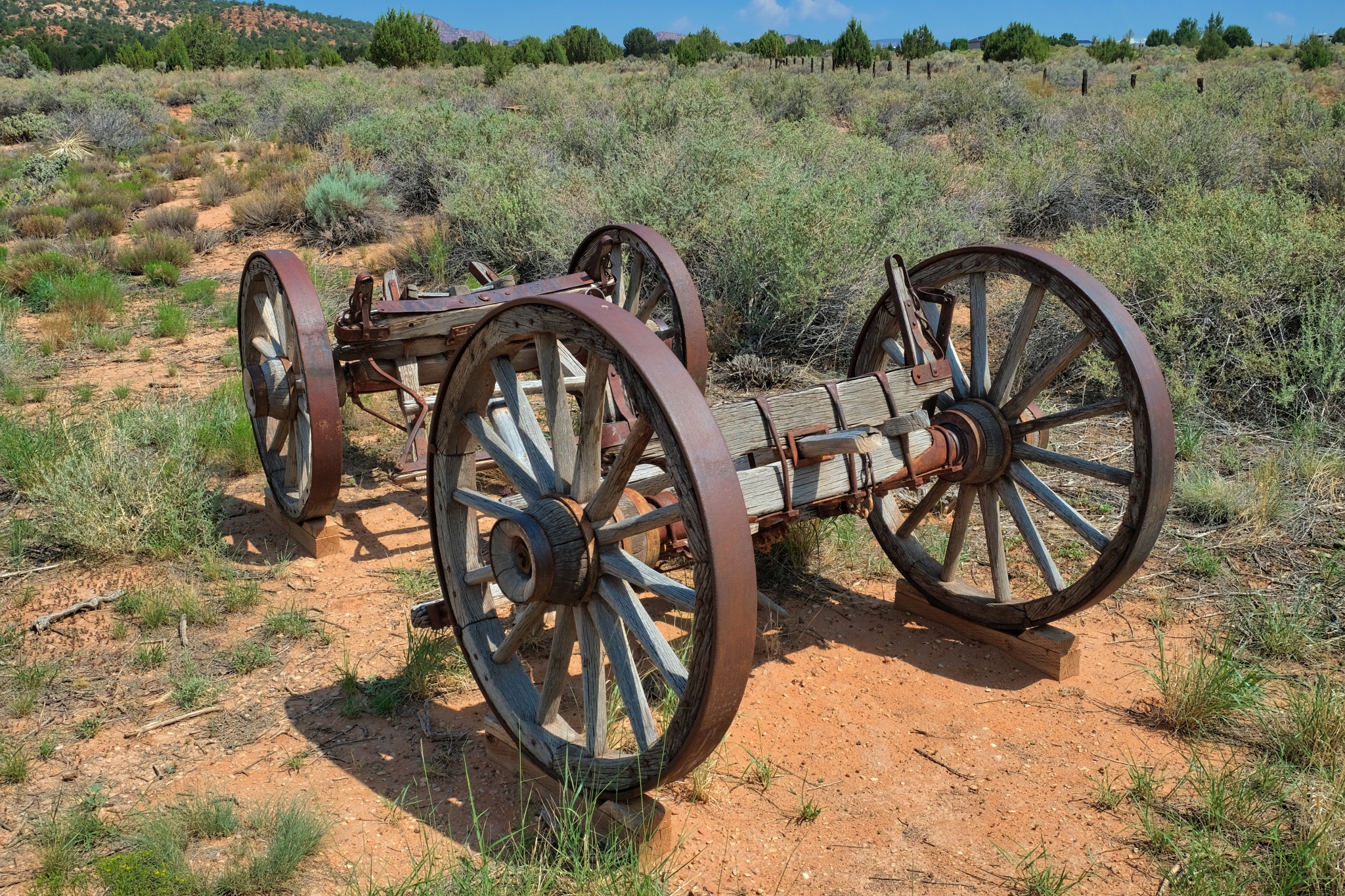 Out on the dry, high elevation chaparral of Northern Arizona, along the road between Zion National Park and the North Rim of the Grand Canyon . . . a remnant of a bygone era . . . The Wild West . . . Pipe Springs National Monument.
Out on the dry, high elevation chaparral of Northern Arizona, along the road between Zion National Park and the North Rim of the Grand Canyon . . . a remnant of a bygone era . . . The Wild West . . . Pipe Springs National Monument.
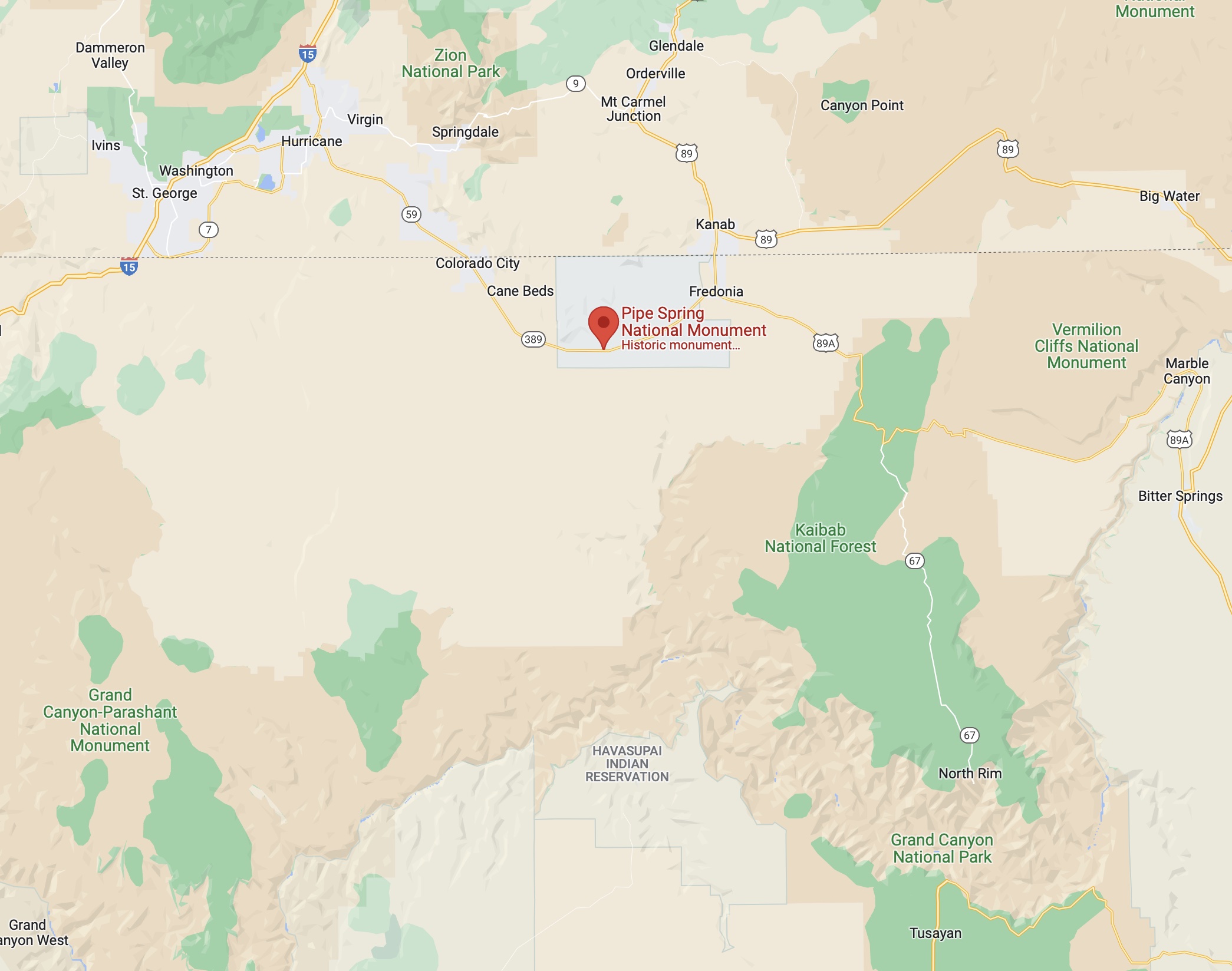 My road trip took me along many wonderful roads.
My road trip took me along many wonderful roads.
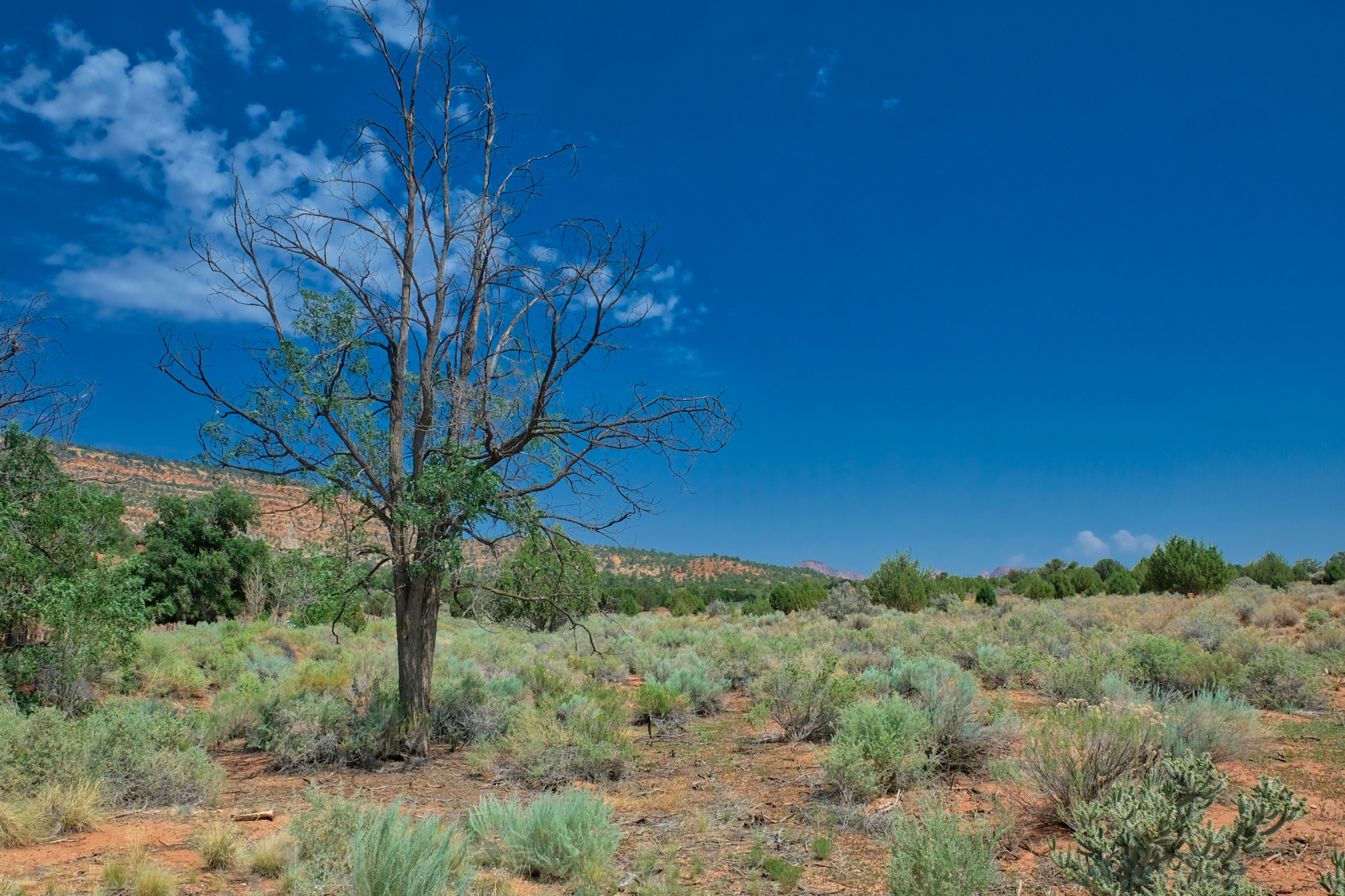 Pipe Springs is established as a grasslands preservation area to reestablish the area as it was before settlers arrived in 1850.
Pipe Springs is established as a grasslands preservation area to reestablish the area as it was before settlers arrived in 1850.
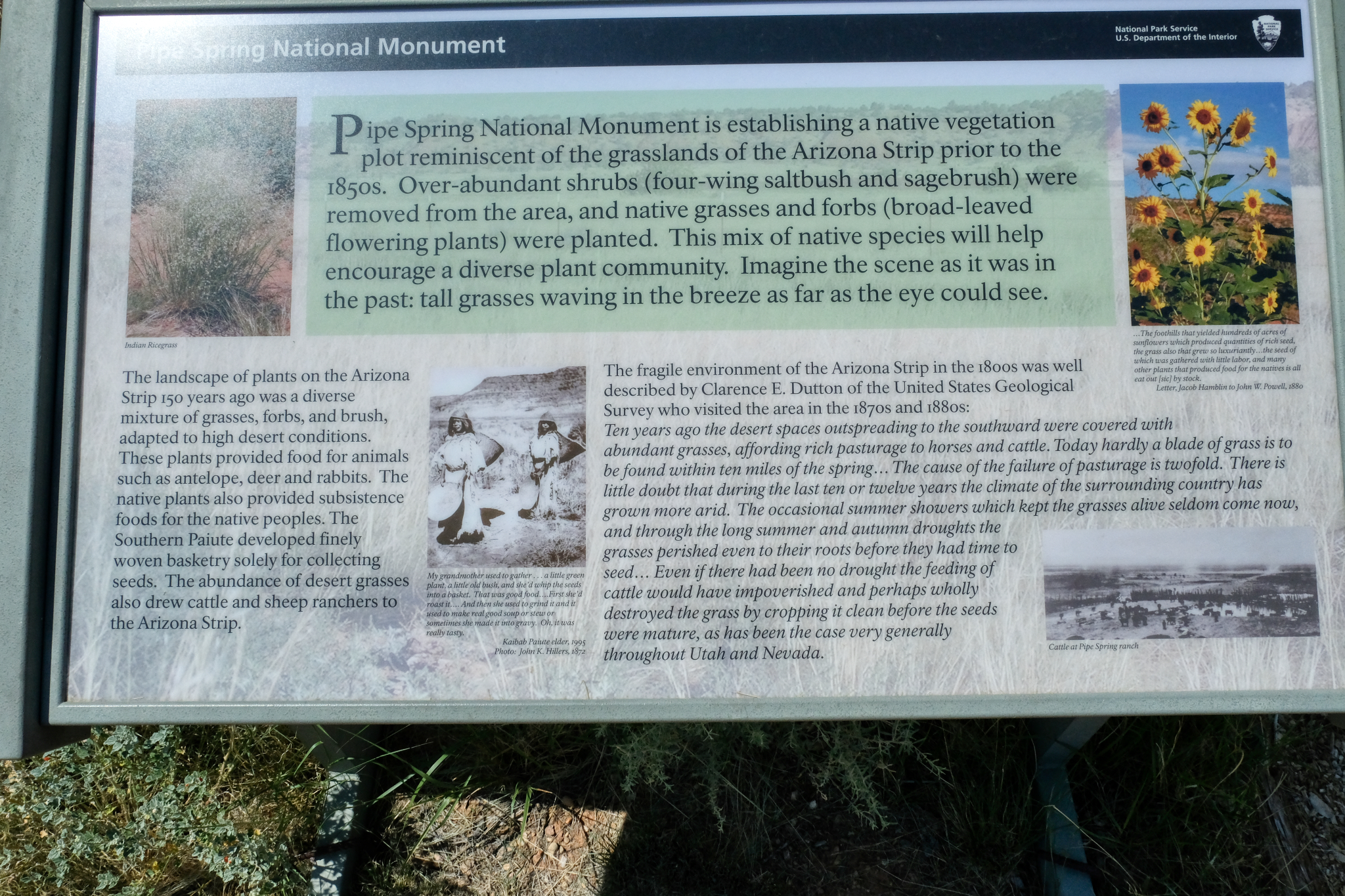 In addition to very informative signage, there was also a fine visitors center.
In addition to very informative signage, there was also a fine visitors center.
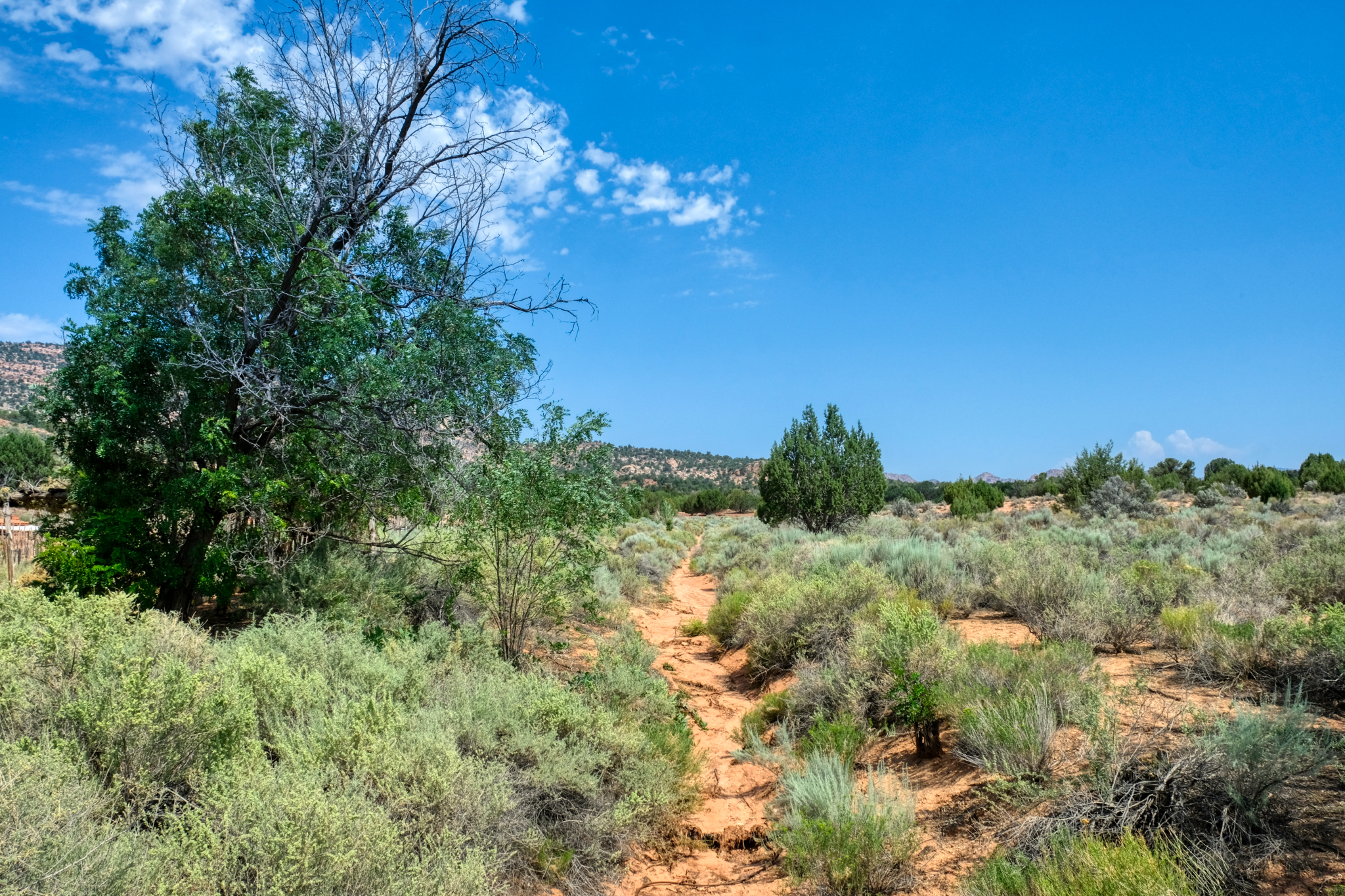 A nice place for a walk to nowhere.
A nice place for a walk to nowhere.
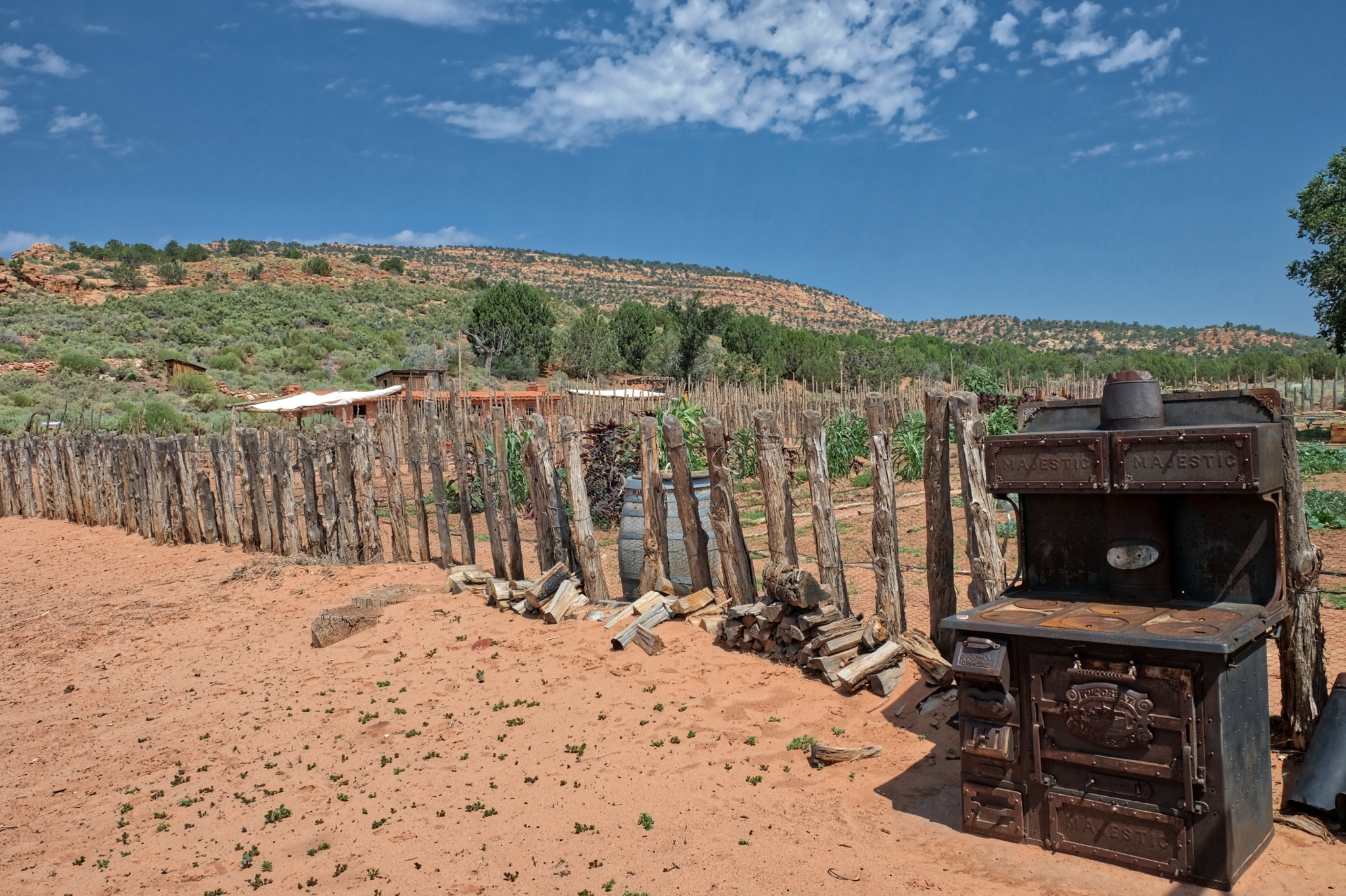 Pipe springs was established at a natural spring as a U.S. Army Calvary Fort, but it was also a self-sustaining farm to support the soldiers stationed there during 'The Indian Wars' in the region.
Pipe springs was established at a natural spring as a U.S. Army Calvary Fort, but it was also a self-sustaining farm to support the soldiers stationed there during 'The Indian Wars' in the region.
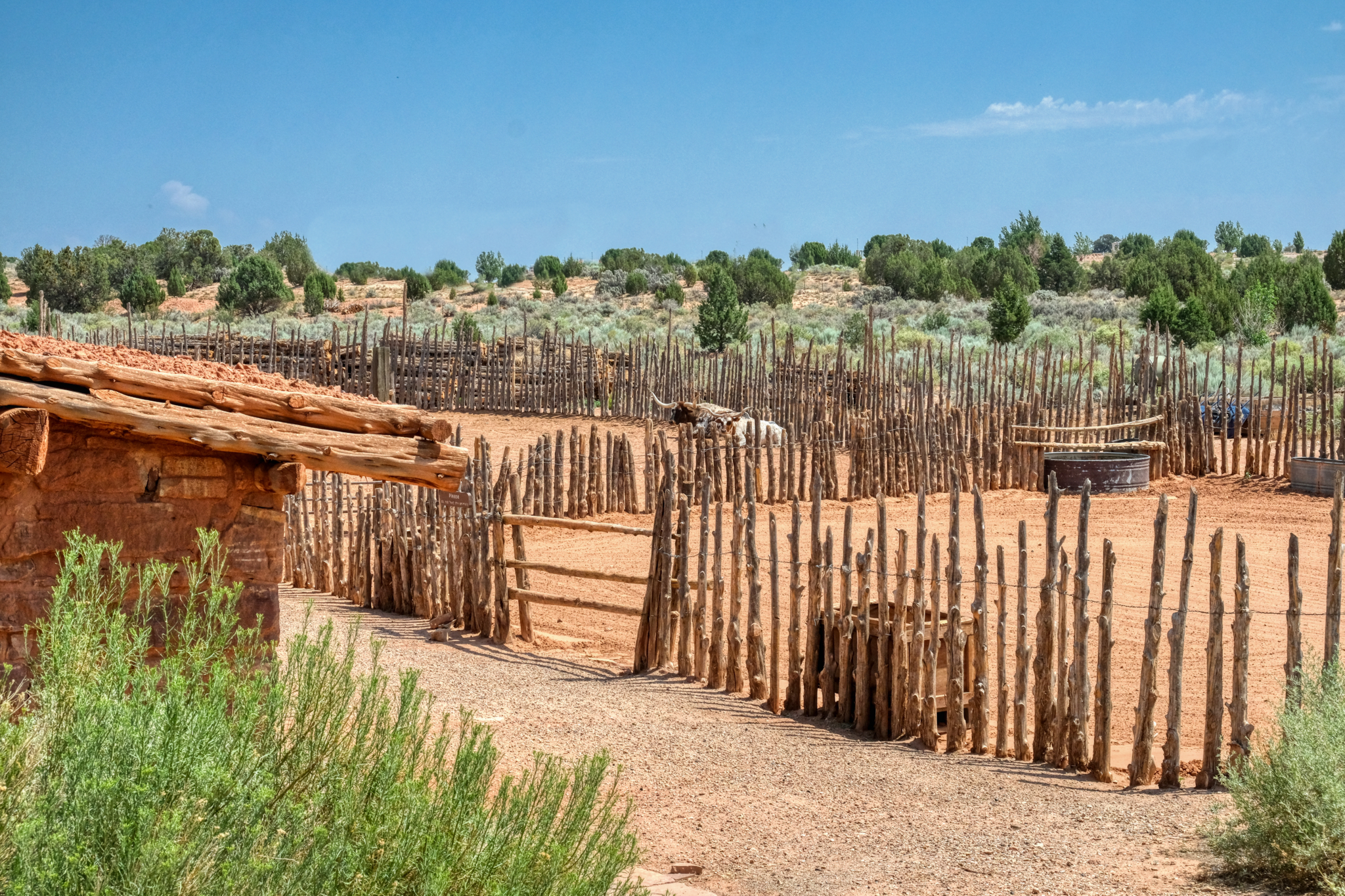 The National Monument still maintains a farm on site in the manner of the settlers and soldiers around 1850. A very nice depiction of the living conditions and methods of the early Western settlers.
The National Monument still maintains a farm on site in the manner of the settlers and soldiers around 1850. A very nice depiction of the living conditions and methods of the early Western settlers.
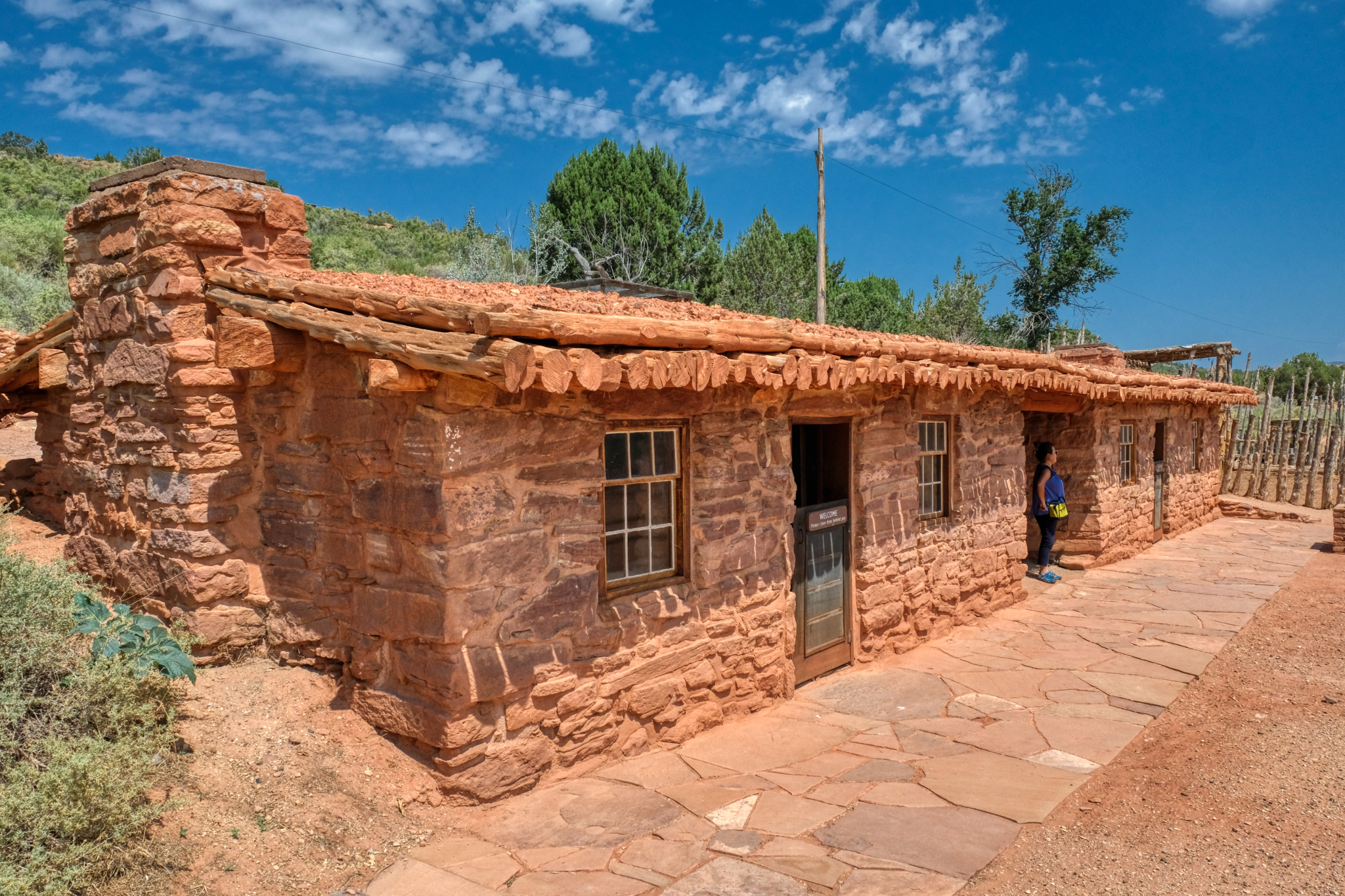 A nicely restored period blacksmith shop and tack house.
A nicely restored period blacksmith shop and tack house.
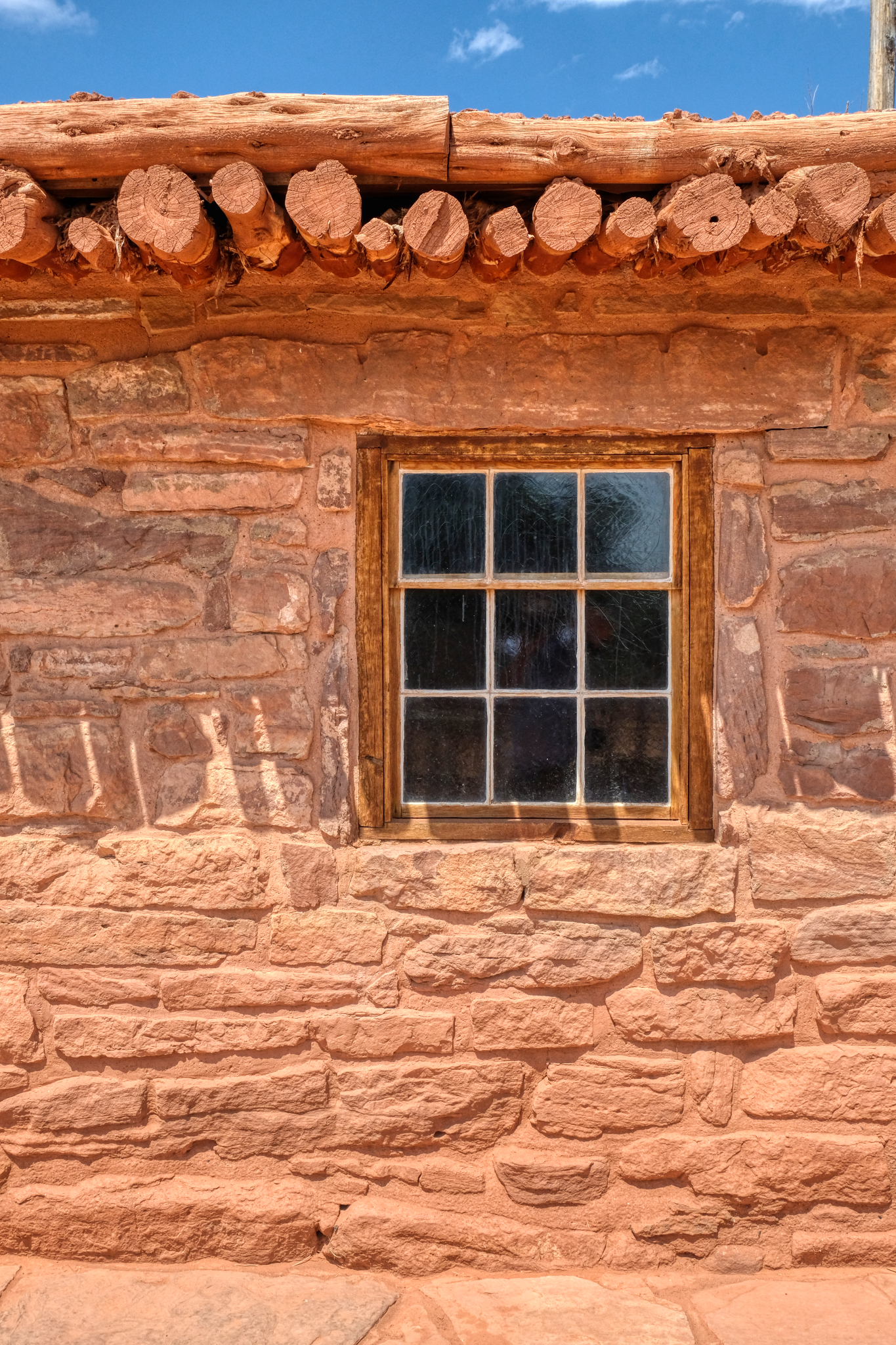 Beautiful stone construction.
Beautiful stone construction.
 It was a hot day near noon when we arrive . . . wonderful shadows on the orange stone tack house.
It was a hot day near noon when we arrive . . . wonderful shadows on the orange stone tack house.
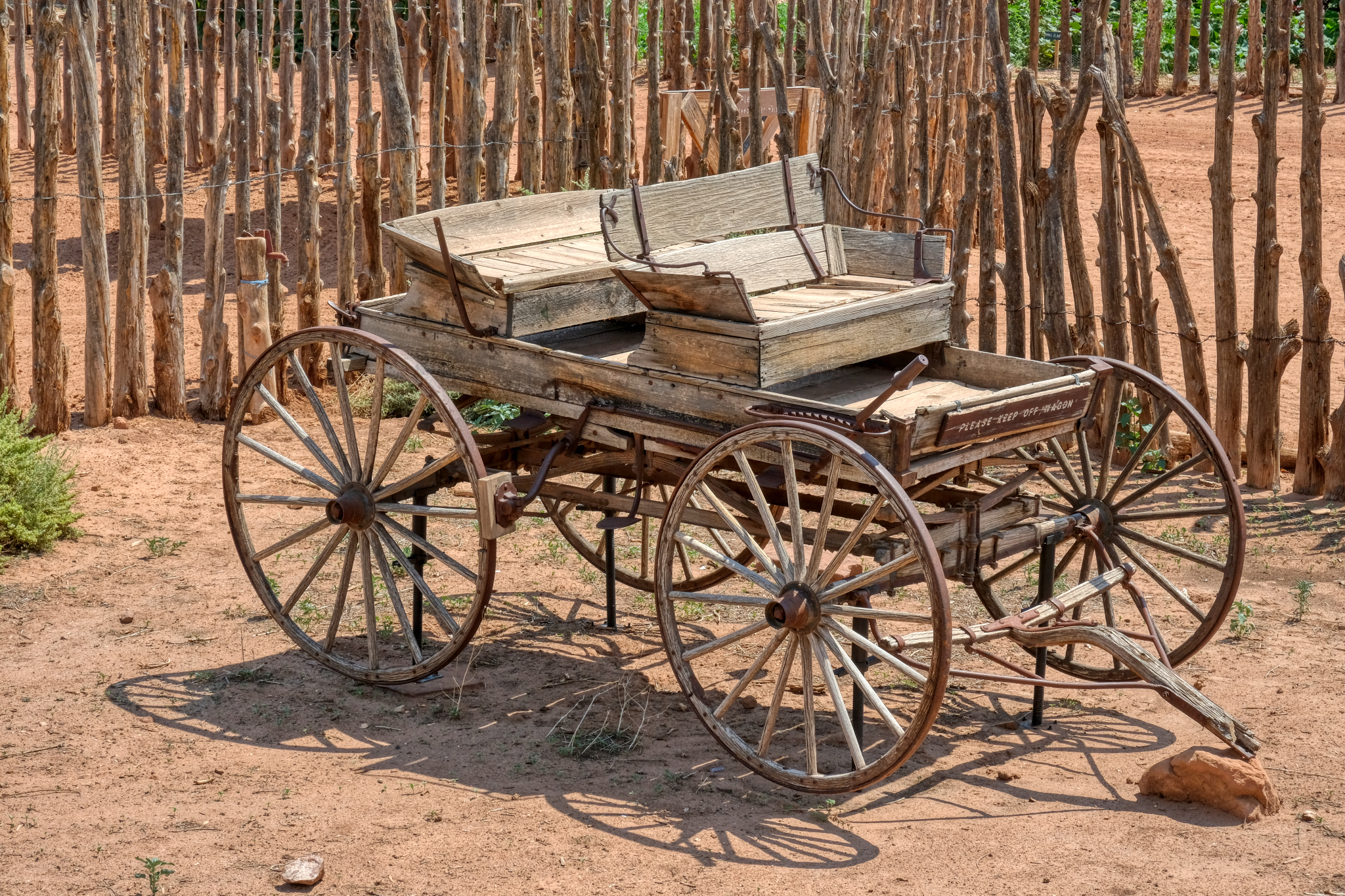 There were some beautiful antique wagons sitting about the grounds. This buggy was fantastic.
There were some beautiful antique wagons sitting about the grounds. This buggy was fantastic.
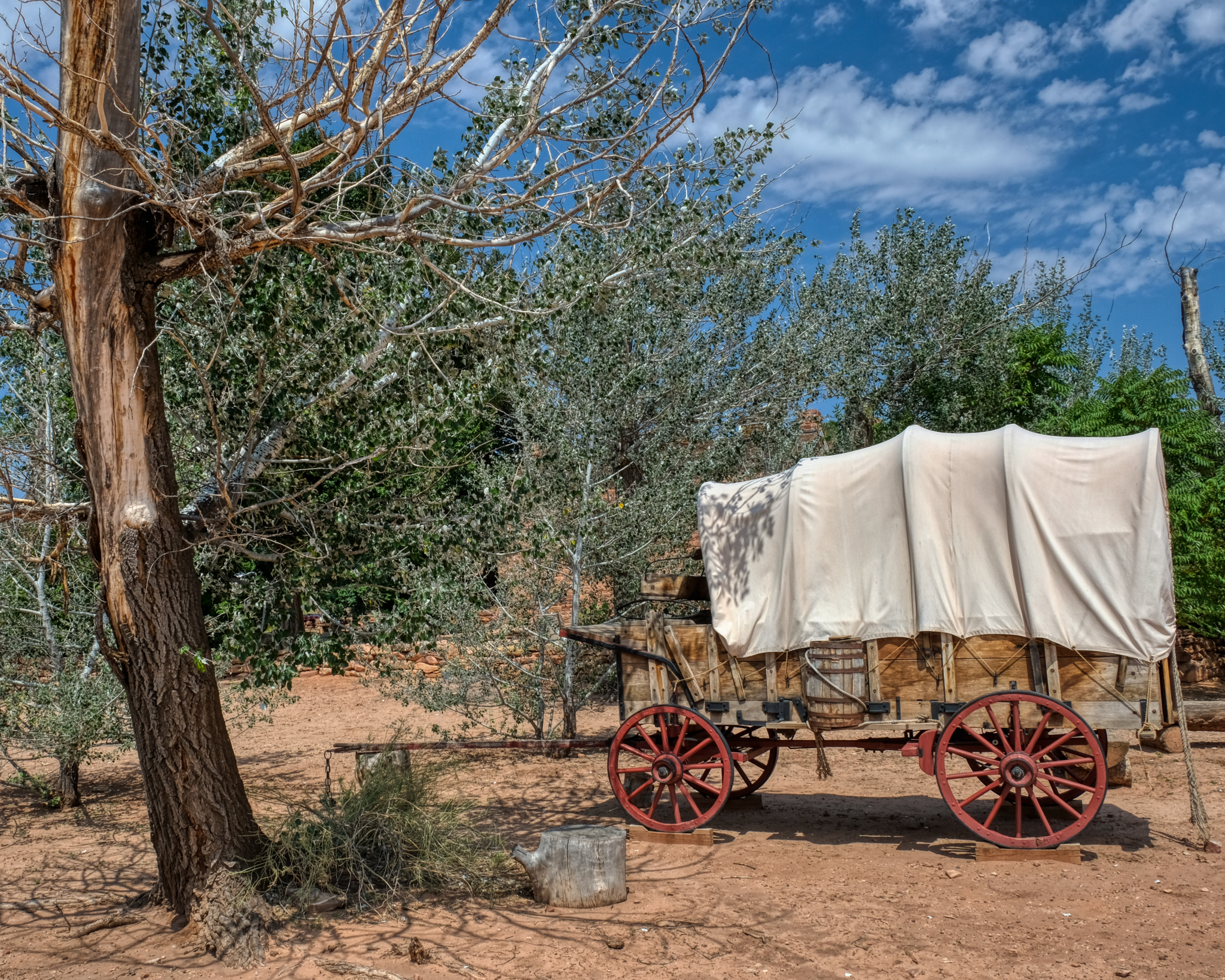 The classic western covered wagon.
The classic western covered wagon.
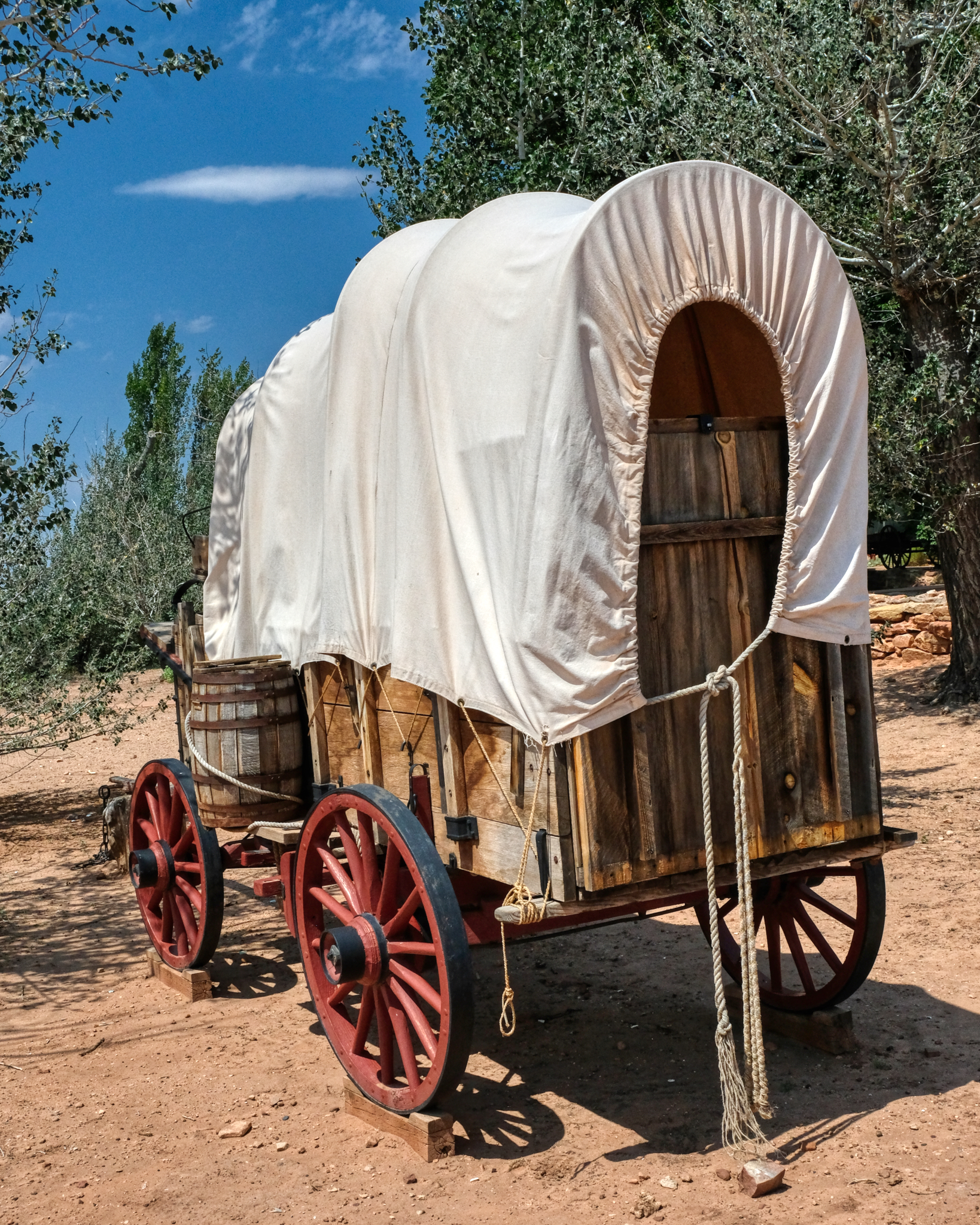 Can you imagine being one of the many thousands who crossed the breadth of America in one of these covered wagons. The faith, hope, and fortitude they must have had!
Can you imagine being one of the many thousands who crossed the breadth of America in one of these covered wagons. The faith, hope, and fortitude they must have had!
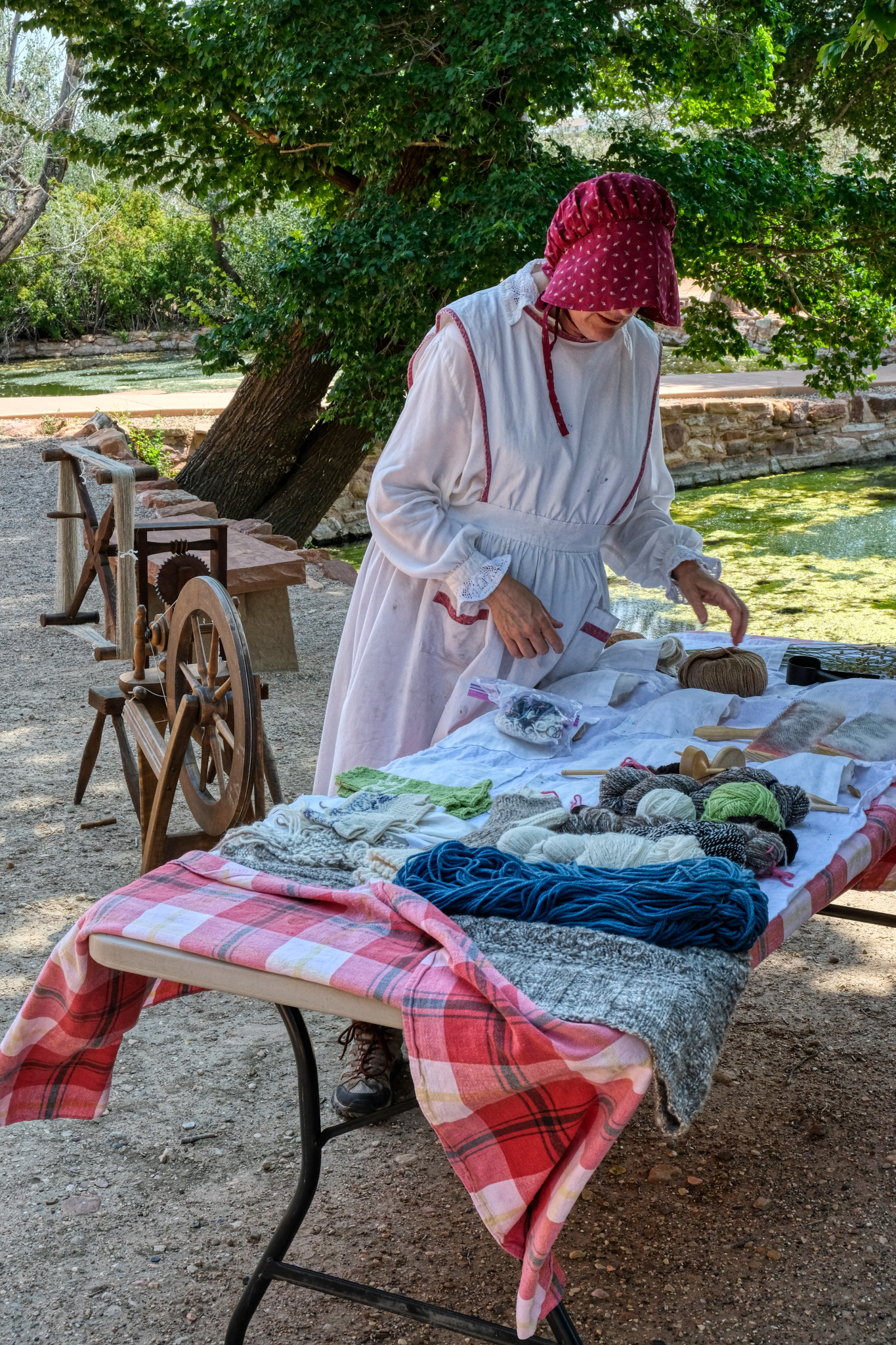 One of the park staff dressed in period costume displaying the kind of textiles the pioneers there would have been making in the 1860s.
One of the park staff dressed in period costume displaying the kind of textiles the pioneers there would have been making in the 1860s.
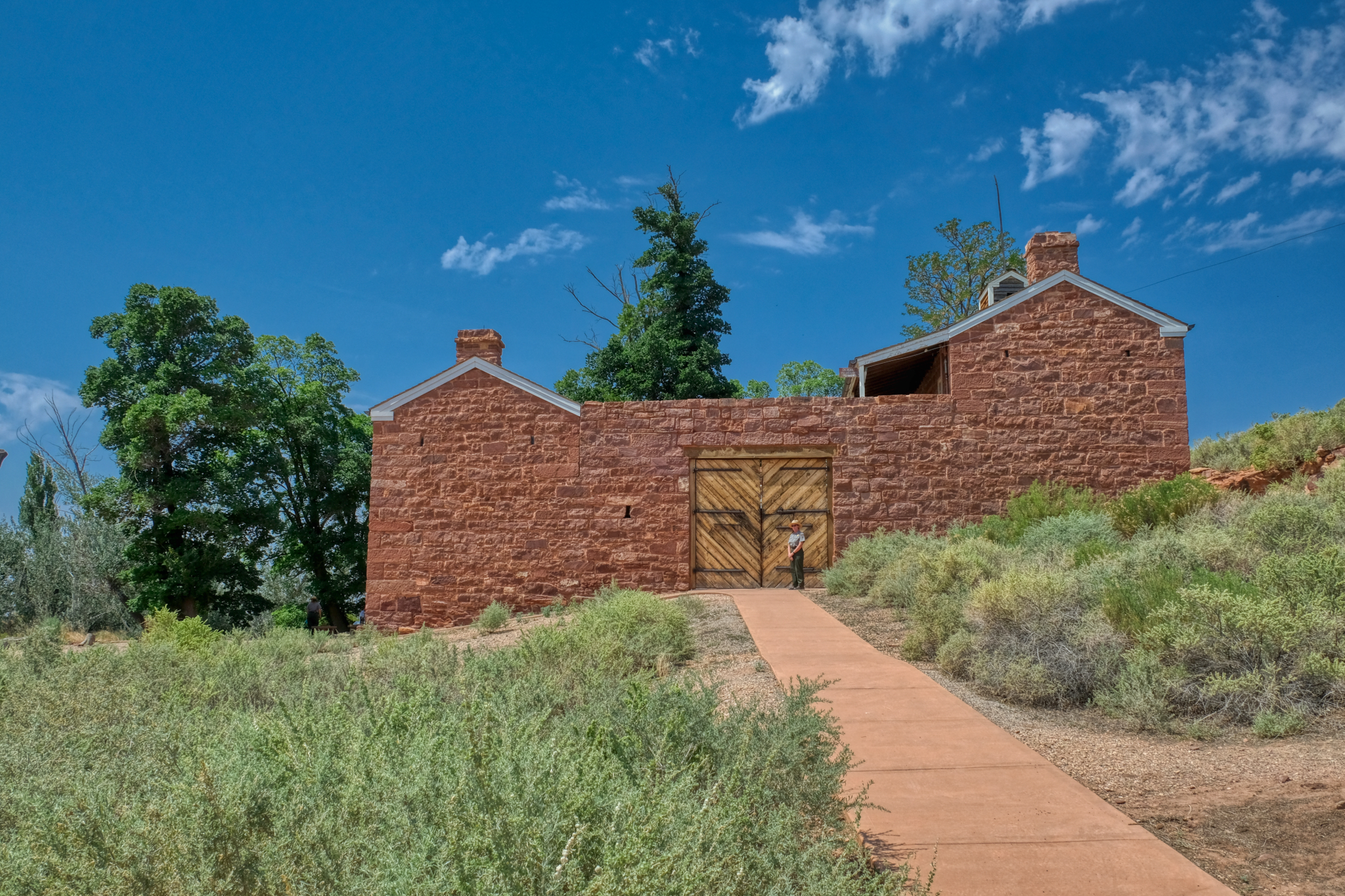 The real purpose of Pipe Springs was as a military fort to provide safety and security for settlers and ranchers during periods of 'Indian trouble.'
The real purpose of Pipe Springs was as a military fort to provide safety and security for settlers and ranchers during periods of 'Indian trouble.'
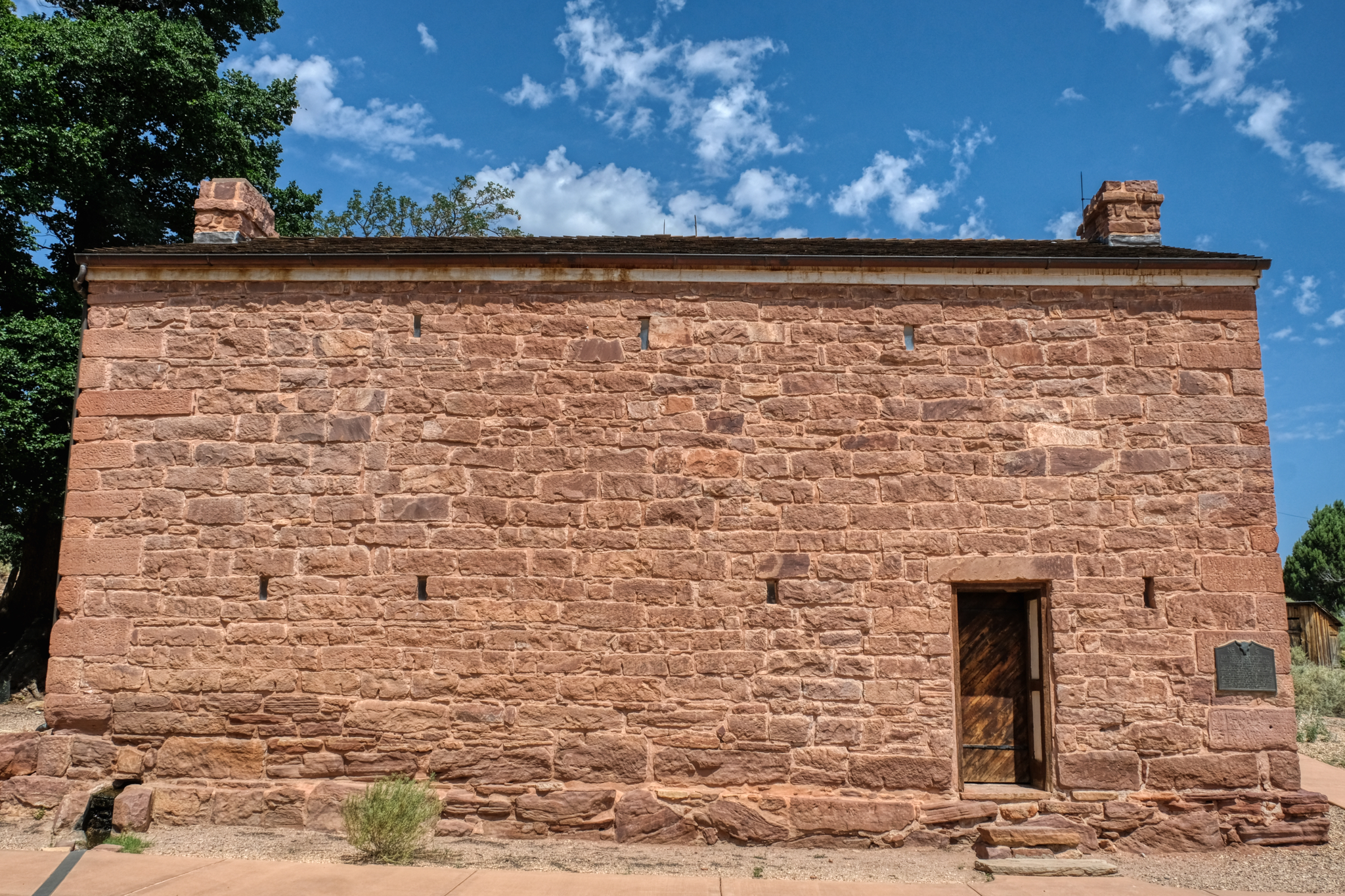 It looks very secure to me. We did not go on the inside.
It looks very secure to me. We did not go on the inside.
 A very photogenic old door at Pipe Springs Fort.
A very photogenic old door at Pipe Springs Fort.
 This photo represents, for me, the isolation of the fort within the vast western landscape.
This photo represents, for me, the isolation of the fort within the vast western landscape.
 Yep, the outhouse.
Yep, the outhouse.
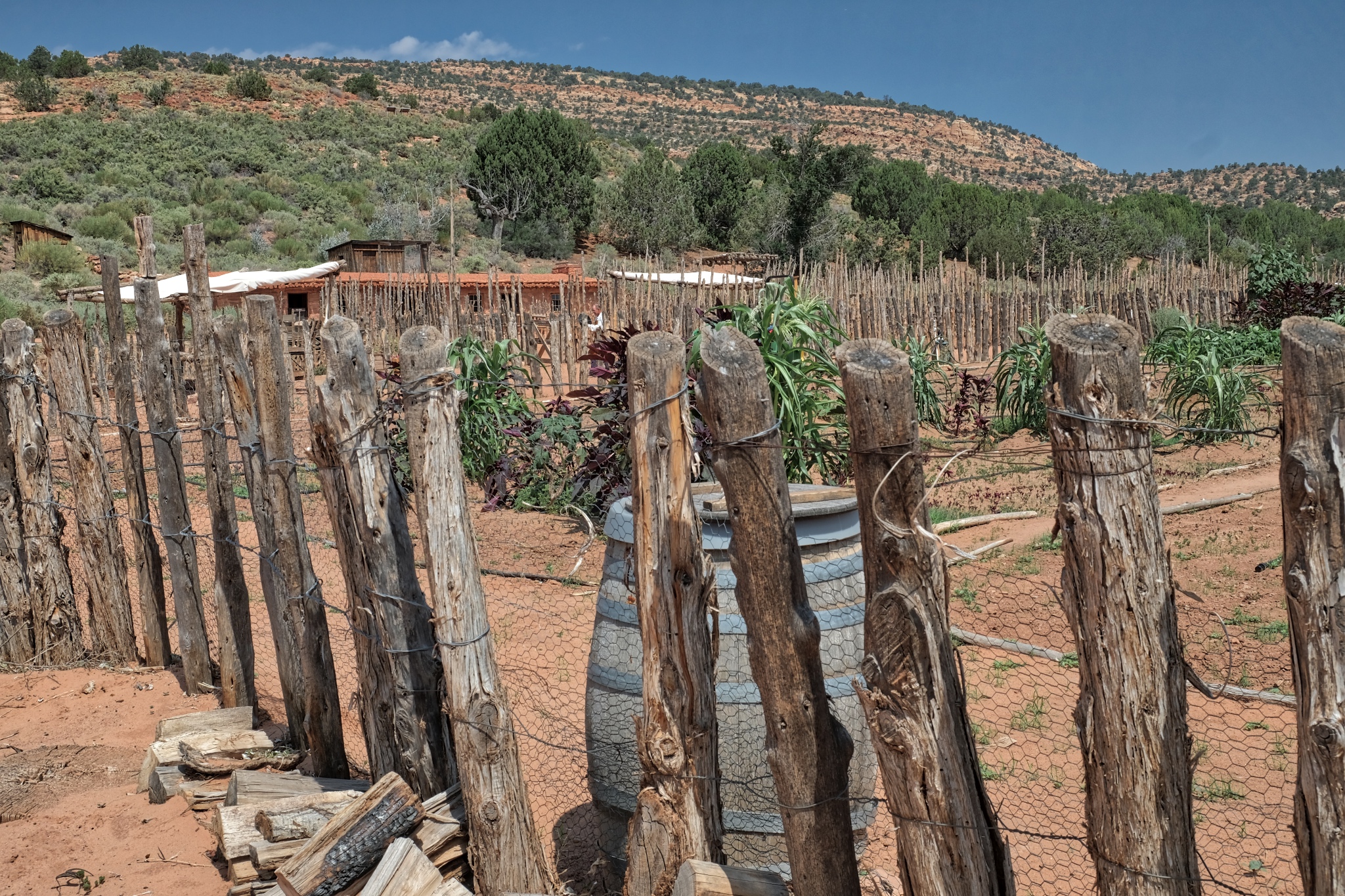 And so we left Pipe Springs to drive on toward the North Rim of the Grand Canyon.
And so we left Pipe Springs to drive on toward the North Rim of the Grand Canyon.
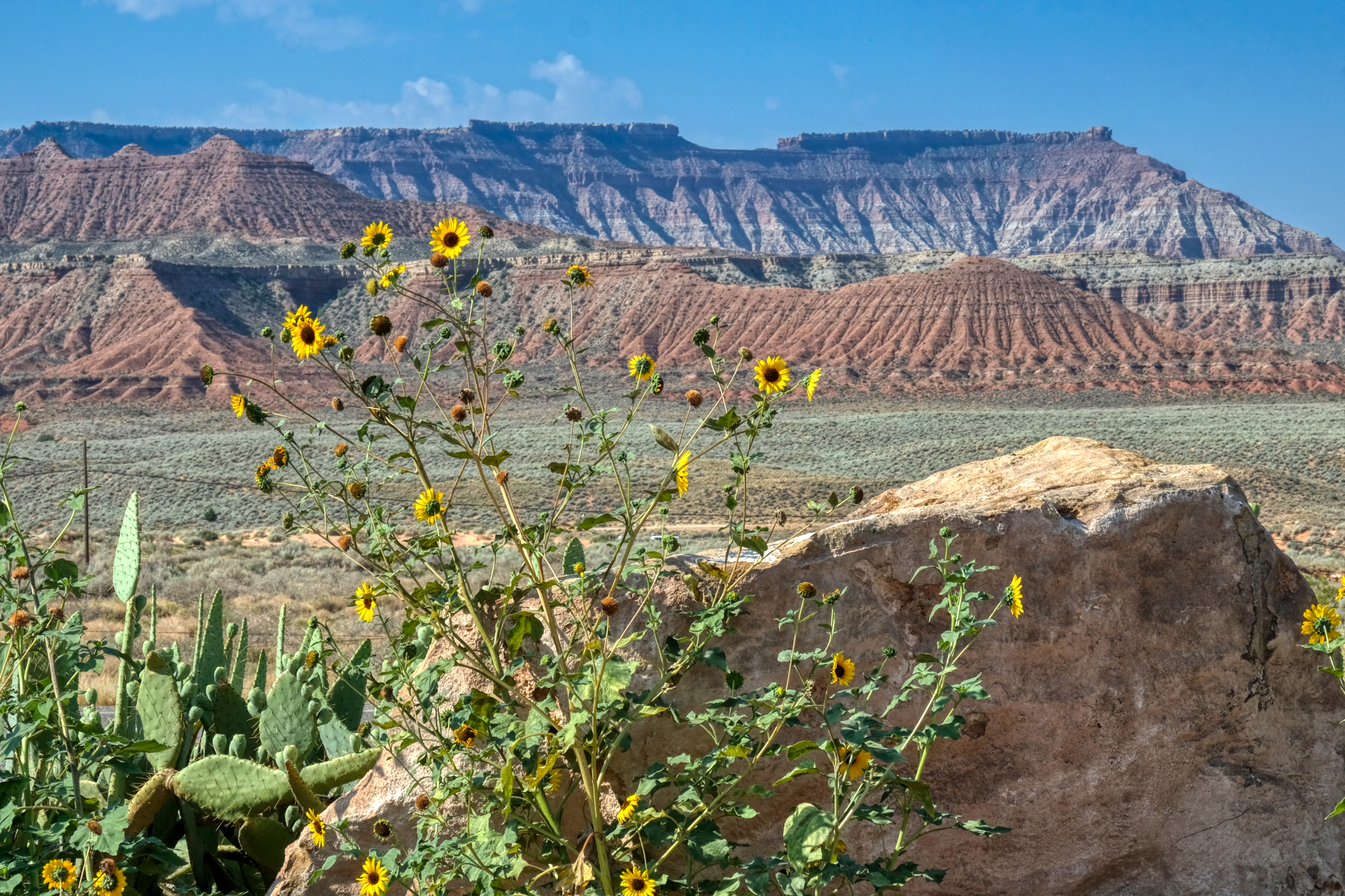 Driving along Arizona Highway 389 trough beautiful mesa country . . .with sunflowers?
Driving along Arizona Highway 389 trough beautiful mesa country . . .with sunflowers?
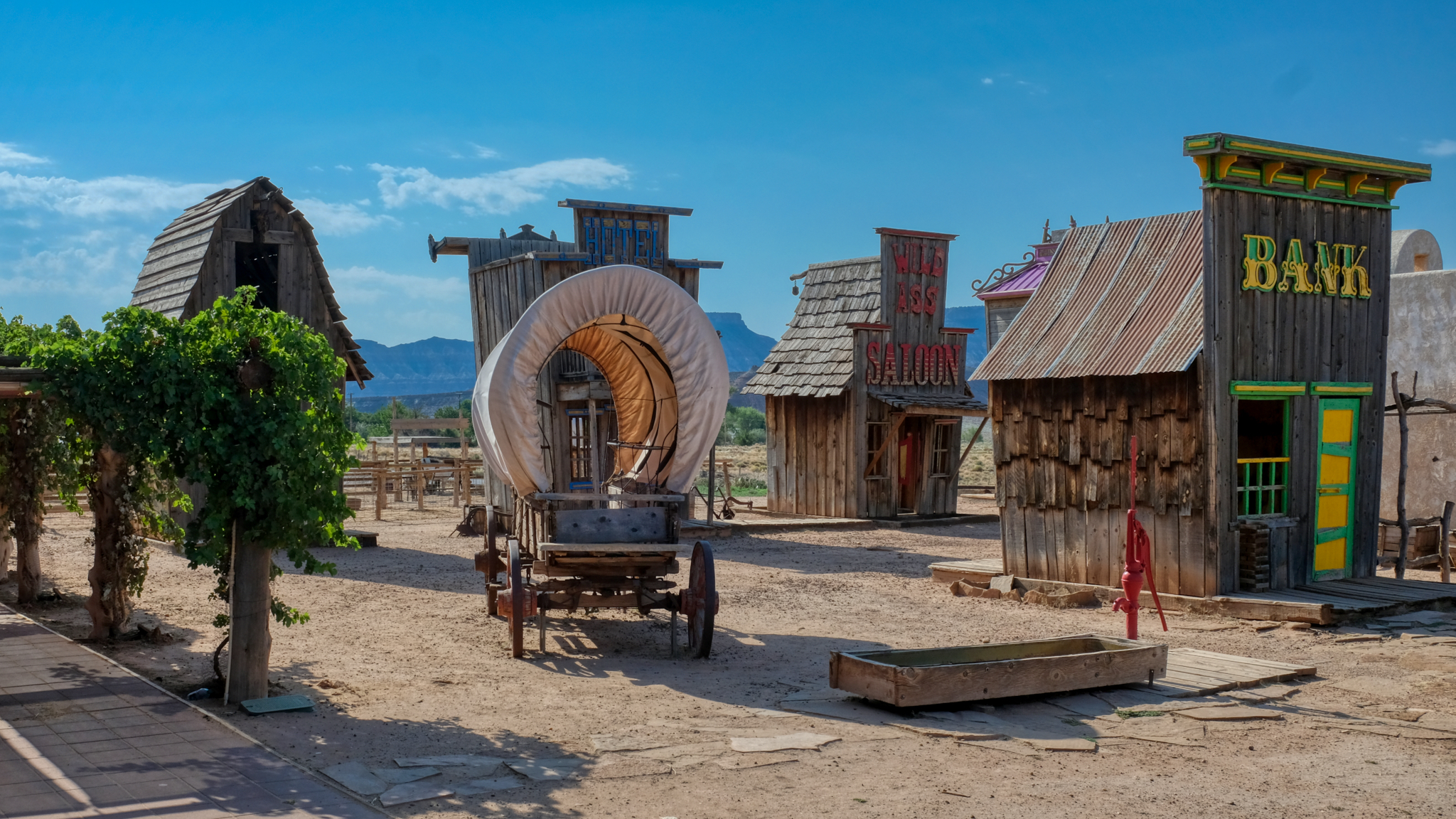 "Just another roadside attraction" . . . a "Wild West Souvenir Store" out along the highway with a cartoonish Wild West Town "Photograph You Family and Friends!" the sign said. I didn't pay the US$5.oo, but instead took photos through the fence . . . duh!
"Just another roadside attraction" . . . a "Wild West Souvenir Store" out along the highway with a cartoonish Wild West Town "Photograph You Family and Friends!" the sign said. I didn't pay the US$5.oo, but instead took photos through the fence . . . duh!
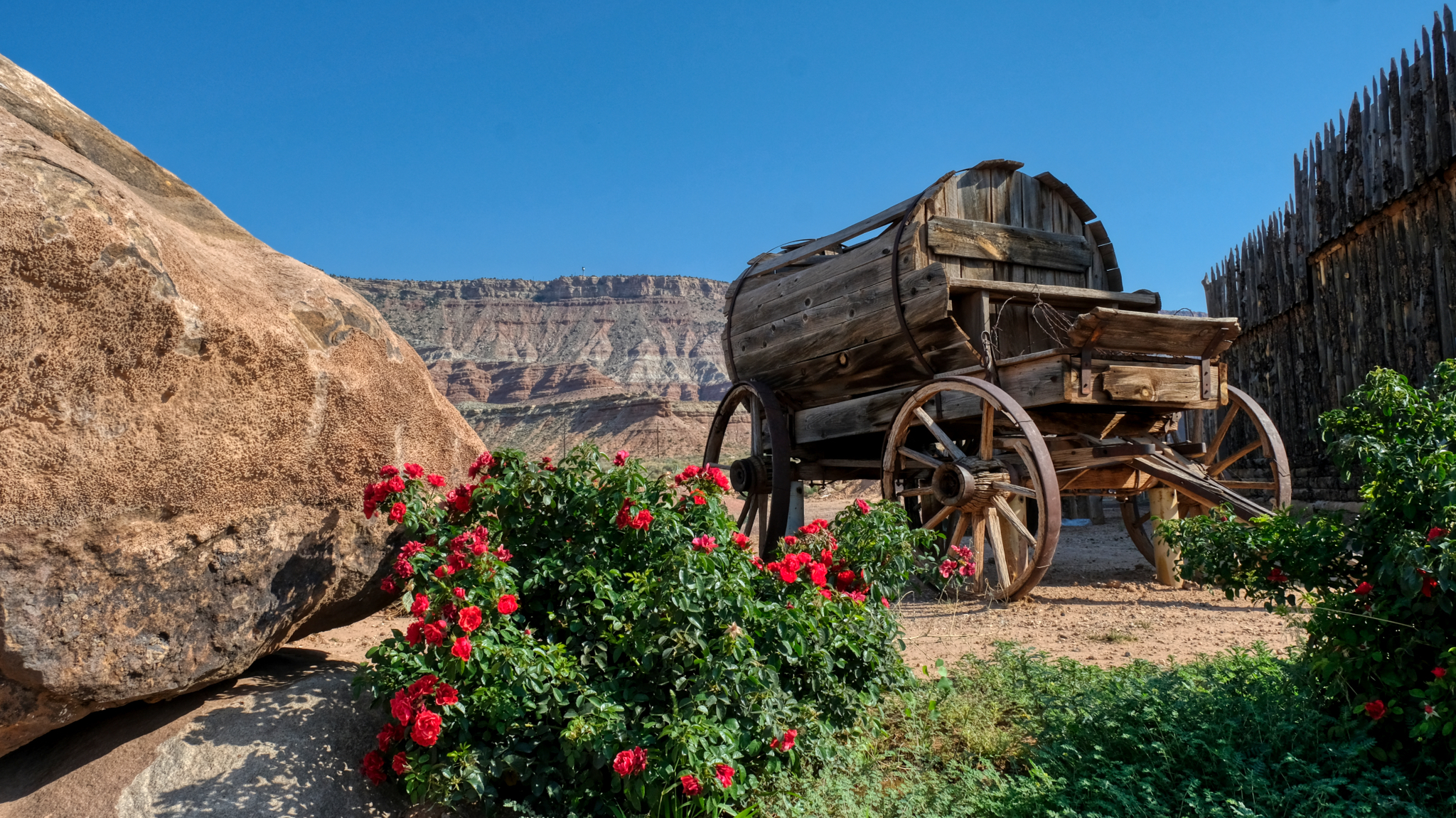 There was a magnificent antique water wagon out back of the store . . . a reminder of the realities of trying to survive in such a dry climate a century-and-a-half ago.
There was a magnificent antique water wagon out back of the store . . . a reminder of the realities of trying to survive in such a dry climate a century-and-a-half ago.
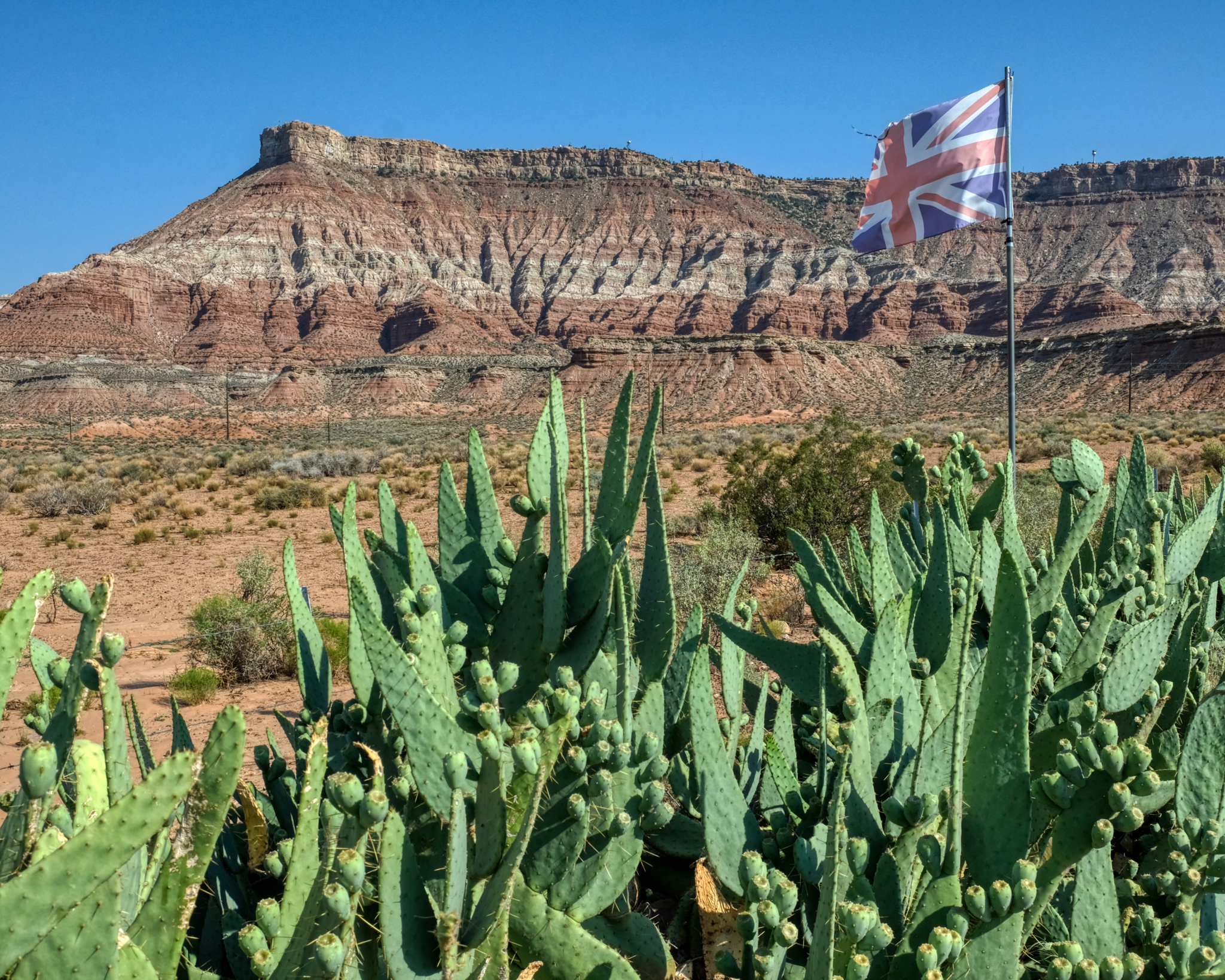 The Western Store was trying to lure tourists from the UK apparently.
The Western Store was trying to lure tourists from the UK apparently.
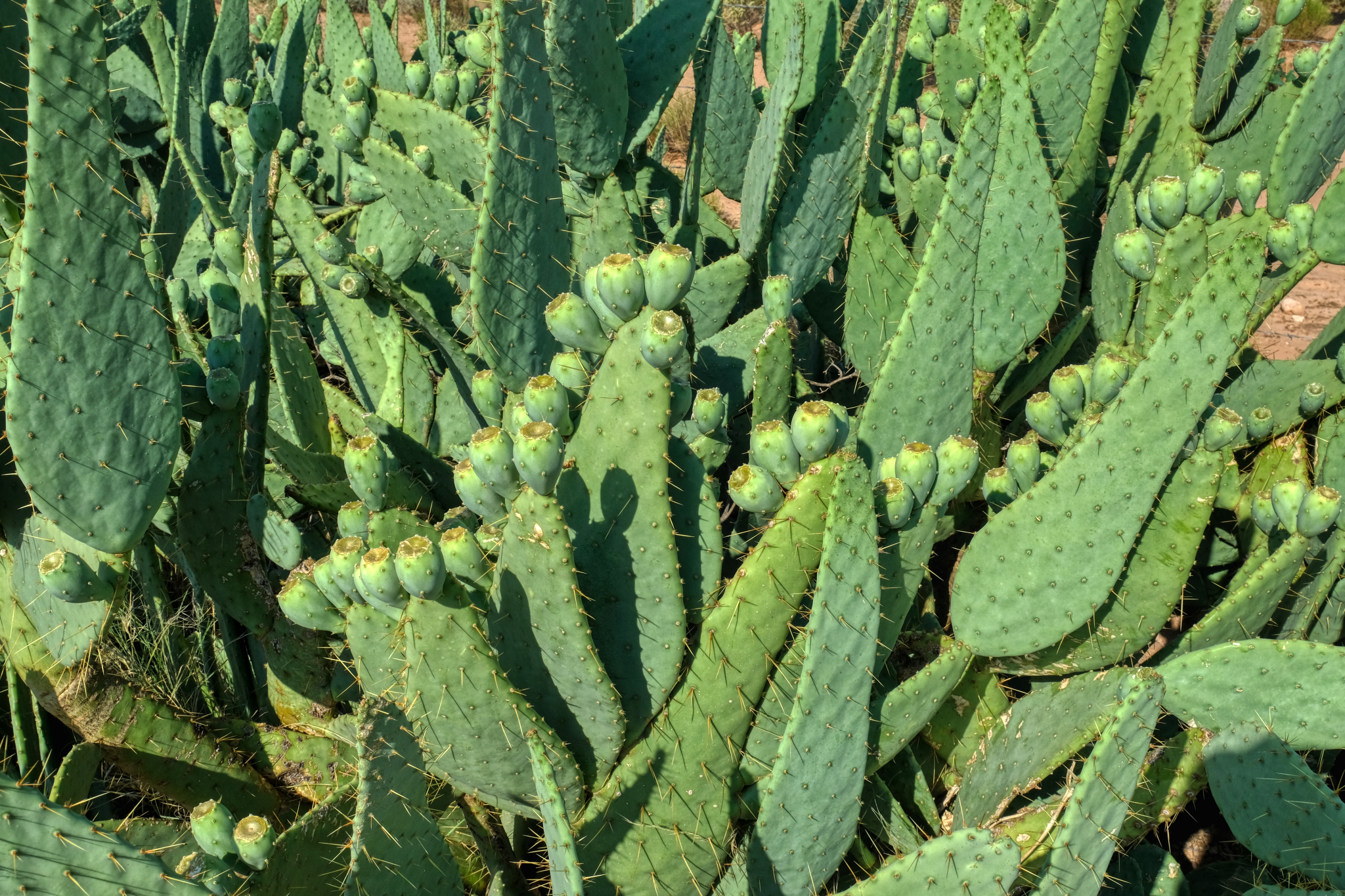 There was a fantastic clump of prickly pear cactus next to their fence.
There was a fantastic clump of prickly pear cactus next to their fence.
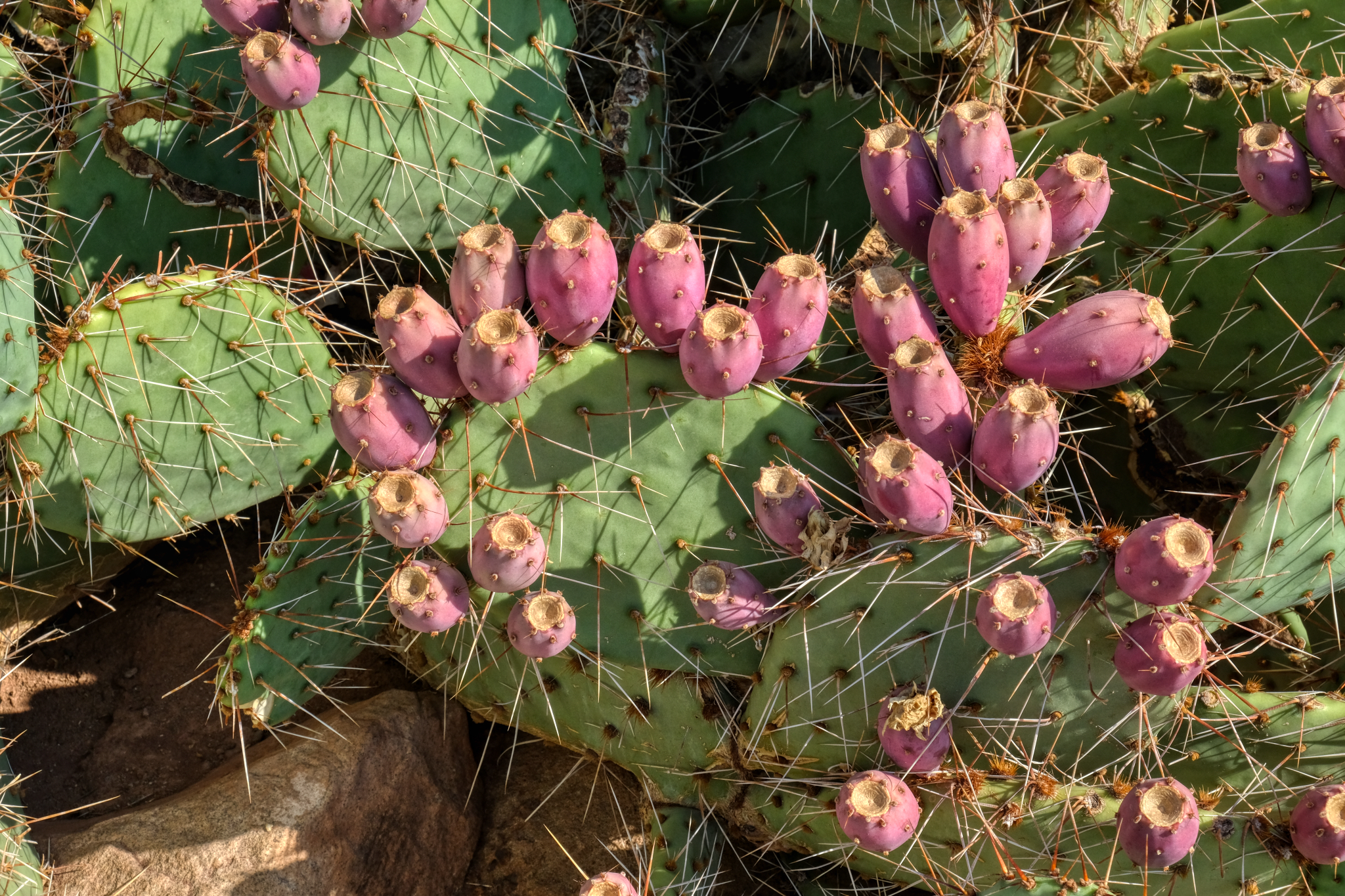 "The fruit of prickly pears (Opunita), commonly called cactus fruit, cactus fig, Indian fig, nopales or tuna in Spanish, is edible, although it must be peeled carefully to remove the small spines on the outer skin before consumption. If the outer layer is not properly removed, glochids can be ingested, causing discomfort of the throat, lips, and tongue, as the small spines are easily lodged in the skin. Native Americans like the Tequesta would roll the fruit around in a suitable medium (e.g. grit) to "sand" off the glochids. Alternatively, rotating the fruit in the flame of a campfire or torch has been used to remove the glochids. Today, parthenocarpic (seedless) cultivars are also available. The seeds can be used for flour." ****
"The fruit of prickly pears (Opunita), commonly called cactus fruit, cactus fig, Indian fig, nopales or tuna in Spanish, is edible, although it must be peeled carefully to remove the small spines on the outer skin before consumption. If the outer layer is not properly removed, glochids can be ingested, causing discomfort of the throat, lips, and tongue, as the small spines are easily lodged in the skin. Native Americans like the Tequesta would roll the fruit around in a suitable medium (e.g. grit) to "sand" off the glochids. Alternatively, rotating the fruit in the flame of a campfire or torch has been used to remove the glochids. Today, parthenocarpic (seedless) cultivars are also available. The seeds can be used for flour." ****
_____________________________________________
COVE FORT, UTAH
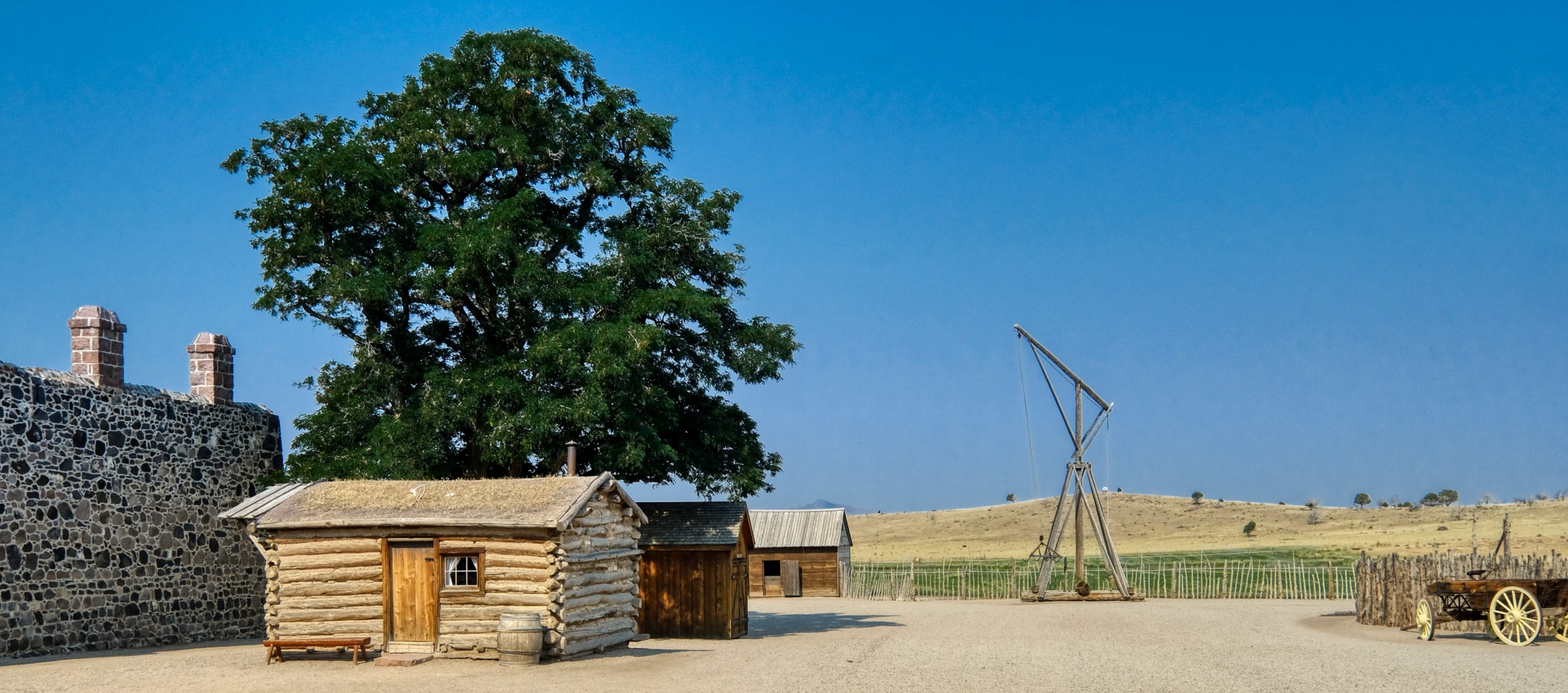 One of the joys of a road trip in the USA are the highway signs announcing "Historic Site Next Right Exit. Fort Cove". So, you take the next right off of I-15.
One of the joys of a road trip in the USA are the highway signs announcing "Historic Site Next Right Exit. Fort Cove". So, you take the next right off of I-15.
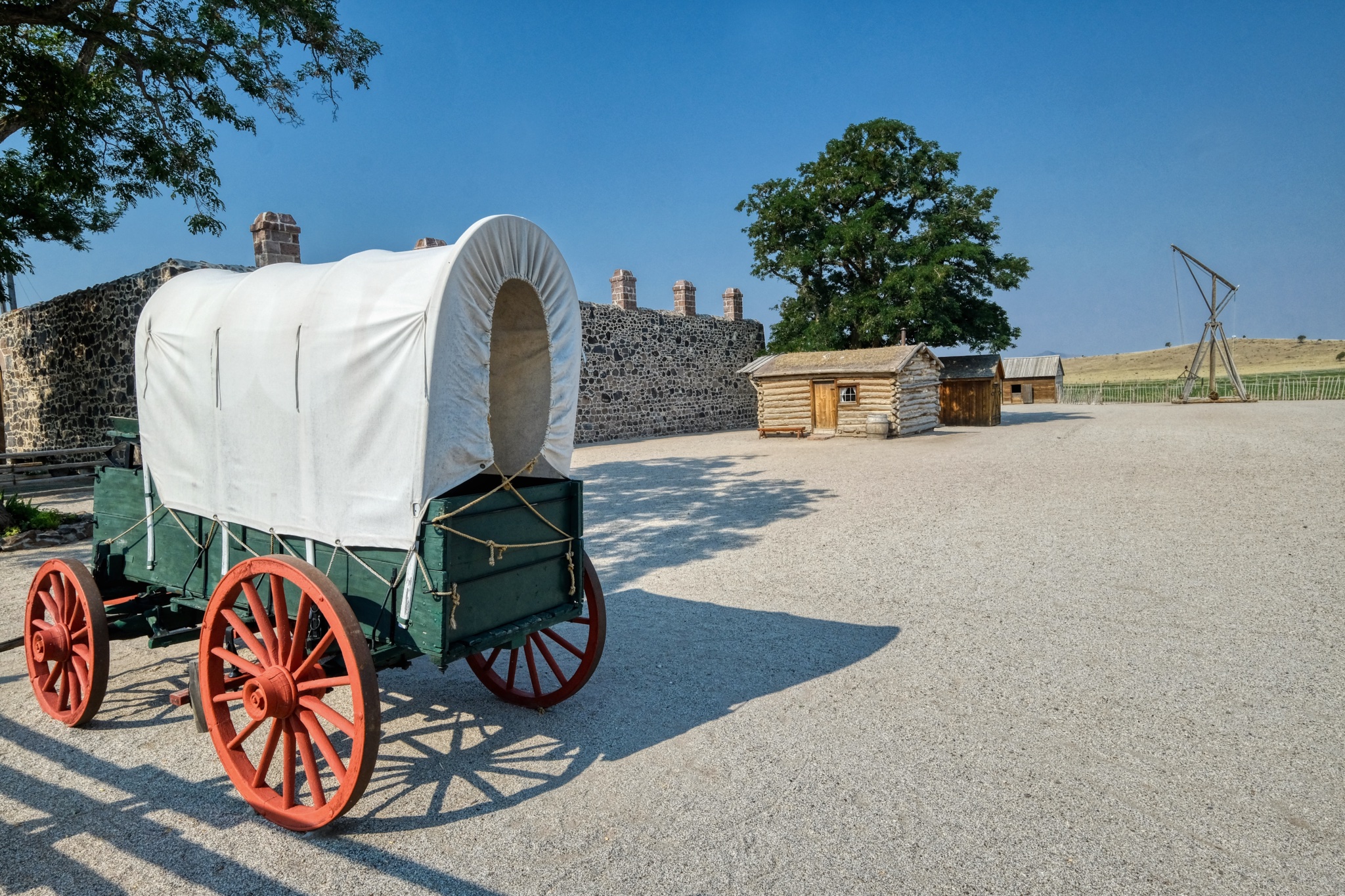
"Cove Fort is a fort, unincorporated community, and historical site located in Millard County, Utah. It was founded in 1867 at the request of Brigham Young. One of its distinctive features is the use of volcanic rock in the construction of the walls, rather than the wood used in many mid-19th-century western forts. This difference in construction is the reason it is one of very few forts of this period still surviving." ***
 A very nice recreation of an early pioneer cabin.
A very nice recreation of an early pioneer cabin.
 There was a fine reproduction barn, nearly new.
There was a fine reproduction barn, nearly new.
 The interior of the big barn had displays of period items, well, related to barns.
The interior of the big barn had displays of period items, well, related to barns.
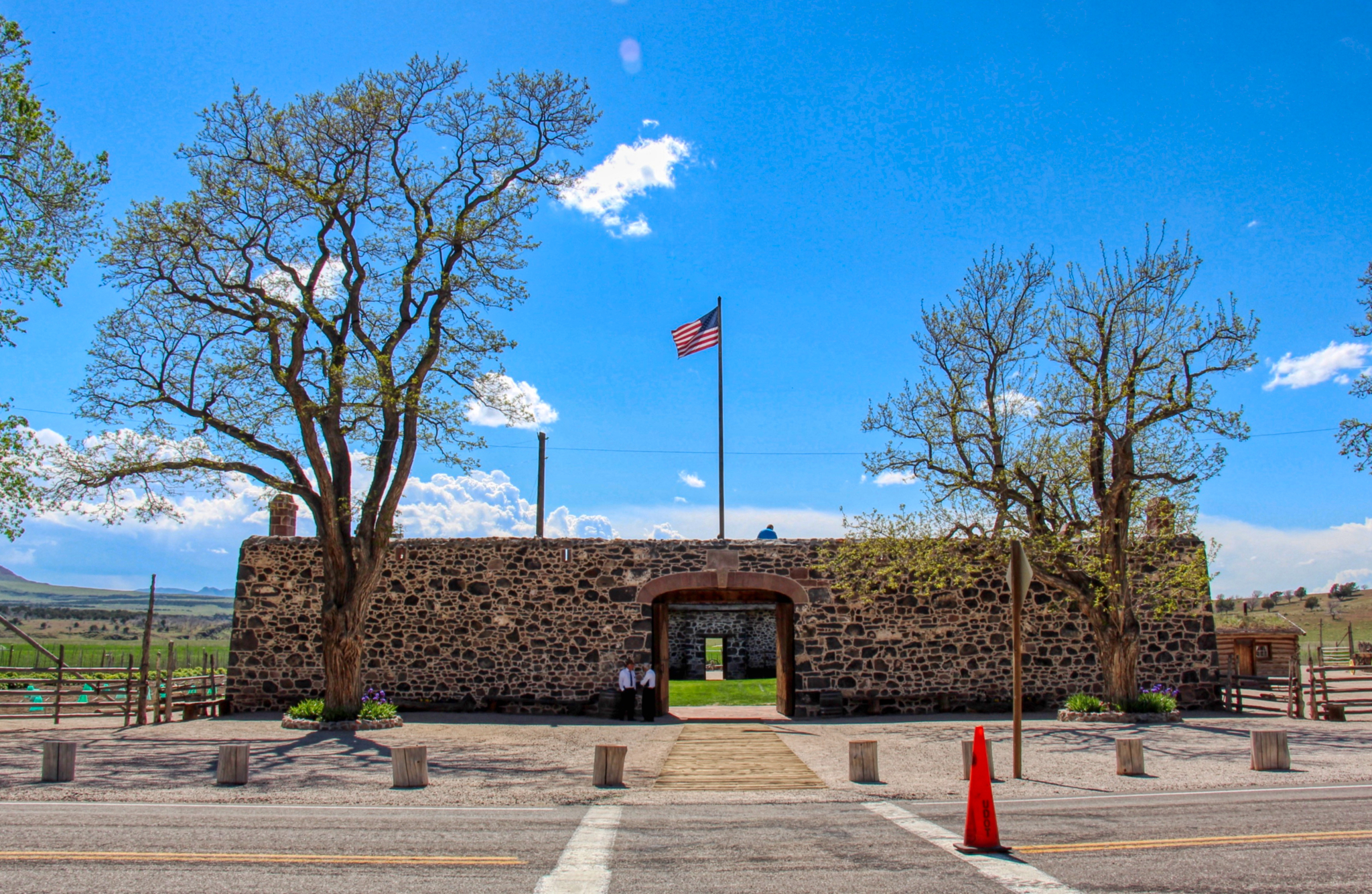 Fort Cove, Utah (Photo from Wikipedia)
Fort Cove, Utah (Photo from Wikipedia)
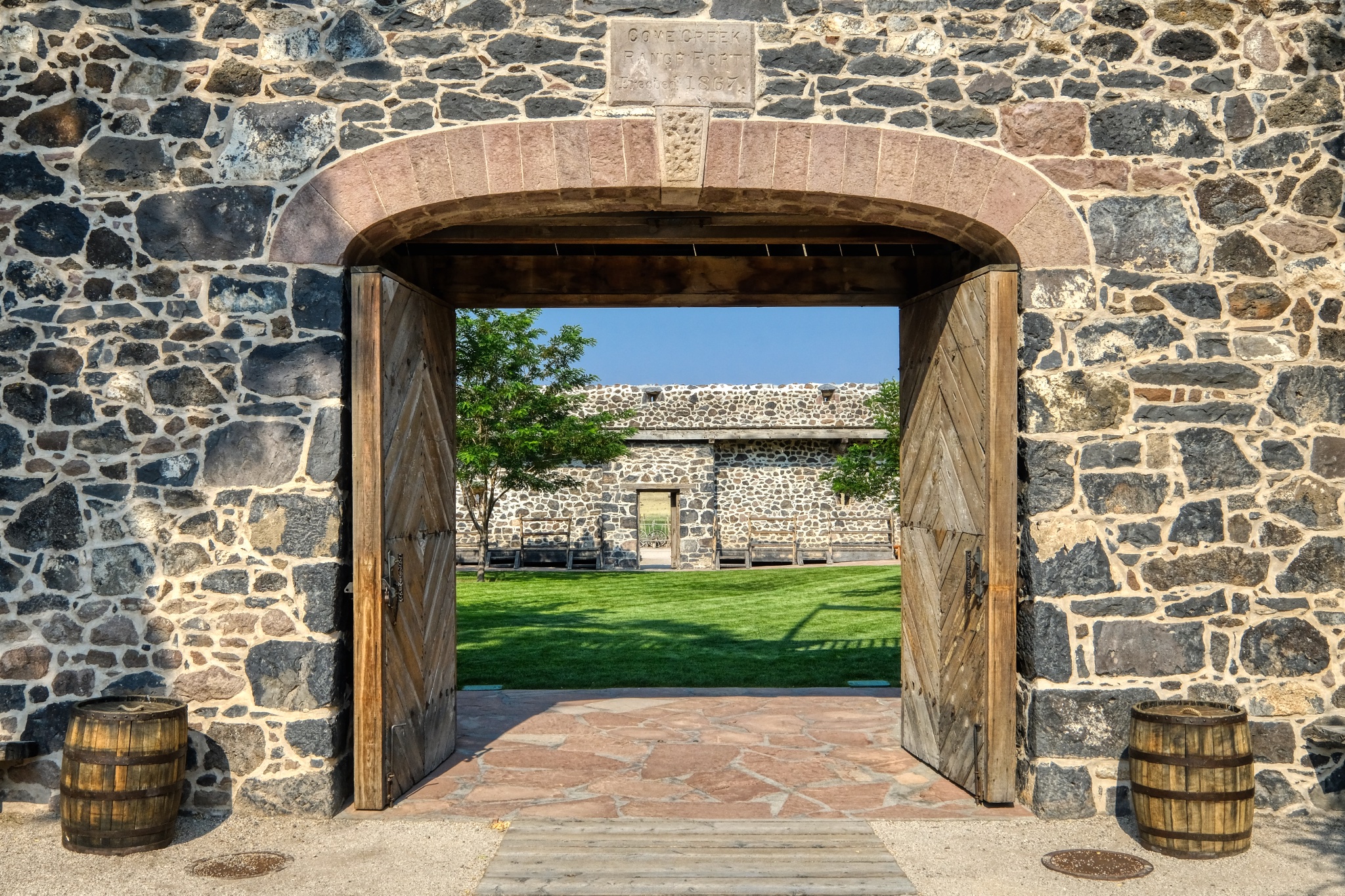 The 1867 Fort Cove gate.
The 1867 Fort Cove gate.
 I was surprised by the verdant green, lush lawn in the fort's inner courtyard. Imagine how wonderful this would have been to the soldiers posted here and the passing visitors in their covered wagons!
I was surprised by the verdant green, lush lawn in the fort's inner courtyard. Imagine how wonderful this would have been to the soldiers posted here and the passing visitors in their covered wagons!
 We went up the stairs to the roof of the fort for the view.
We went up the stairs to the roof of the fort for the view.
 Behind the fort was the vegetable garden.
Behind the fort was the vegetable garden.
 The garden path leading to displays of various Mormon settler shacks, sheds, and cabins that were trucked to the site and restored.
The garden path leading to displays of various Mormon settler shacks, sheds, and cabins that were trucked to the site and restored.
 A superb scarecrow!
A superb scarecrow!
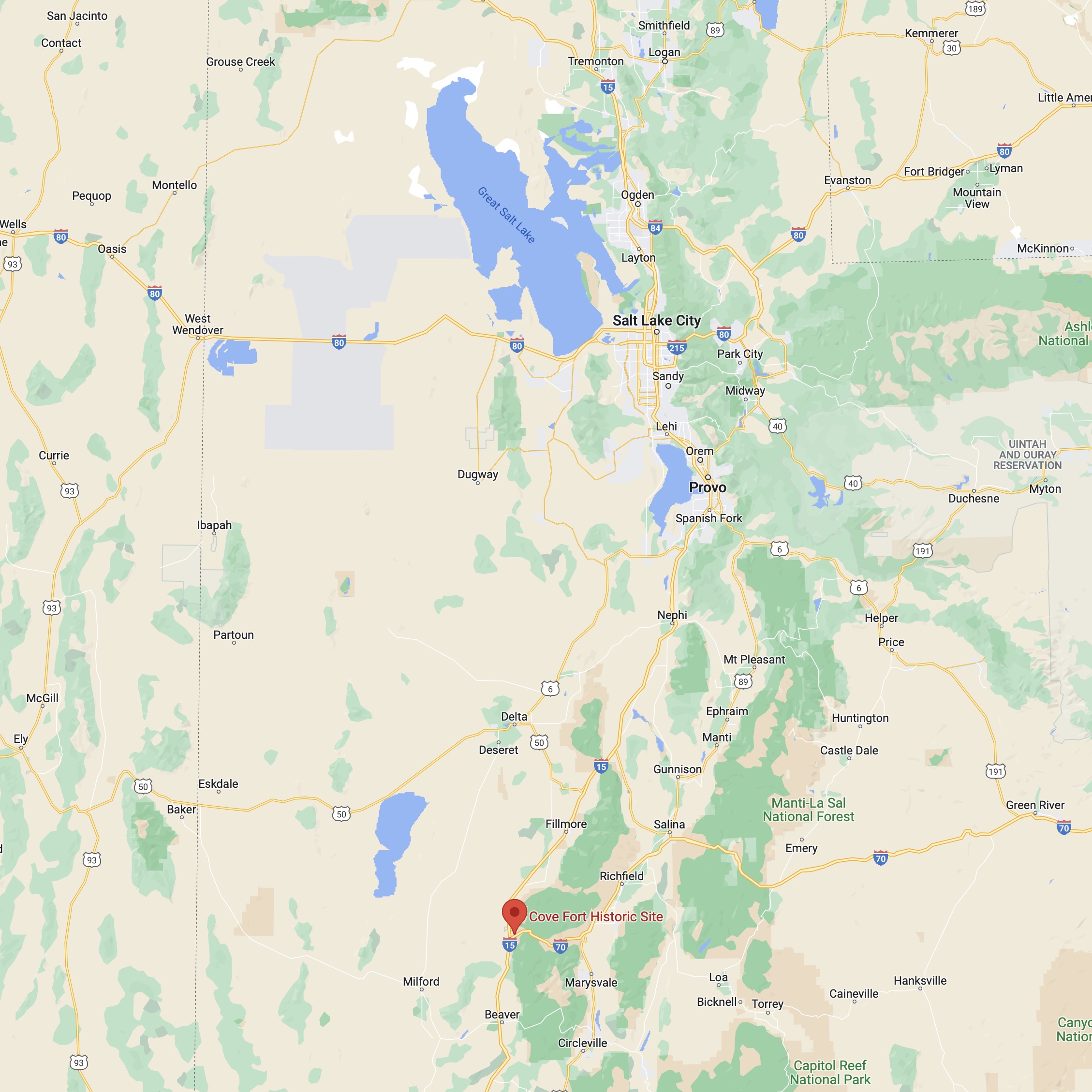
Then back out on the highway I-15 north . . . and an Allison Krauss and Willy Nelson concert in Bend, Oregon!!!
USA Road Trip: Collier Logging Museum, Oregon
 Sunday, February 6, 2022 at 2:51PM
Sunday, February 6, 2022 at 2:51PM 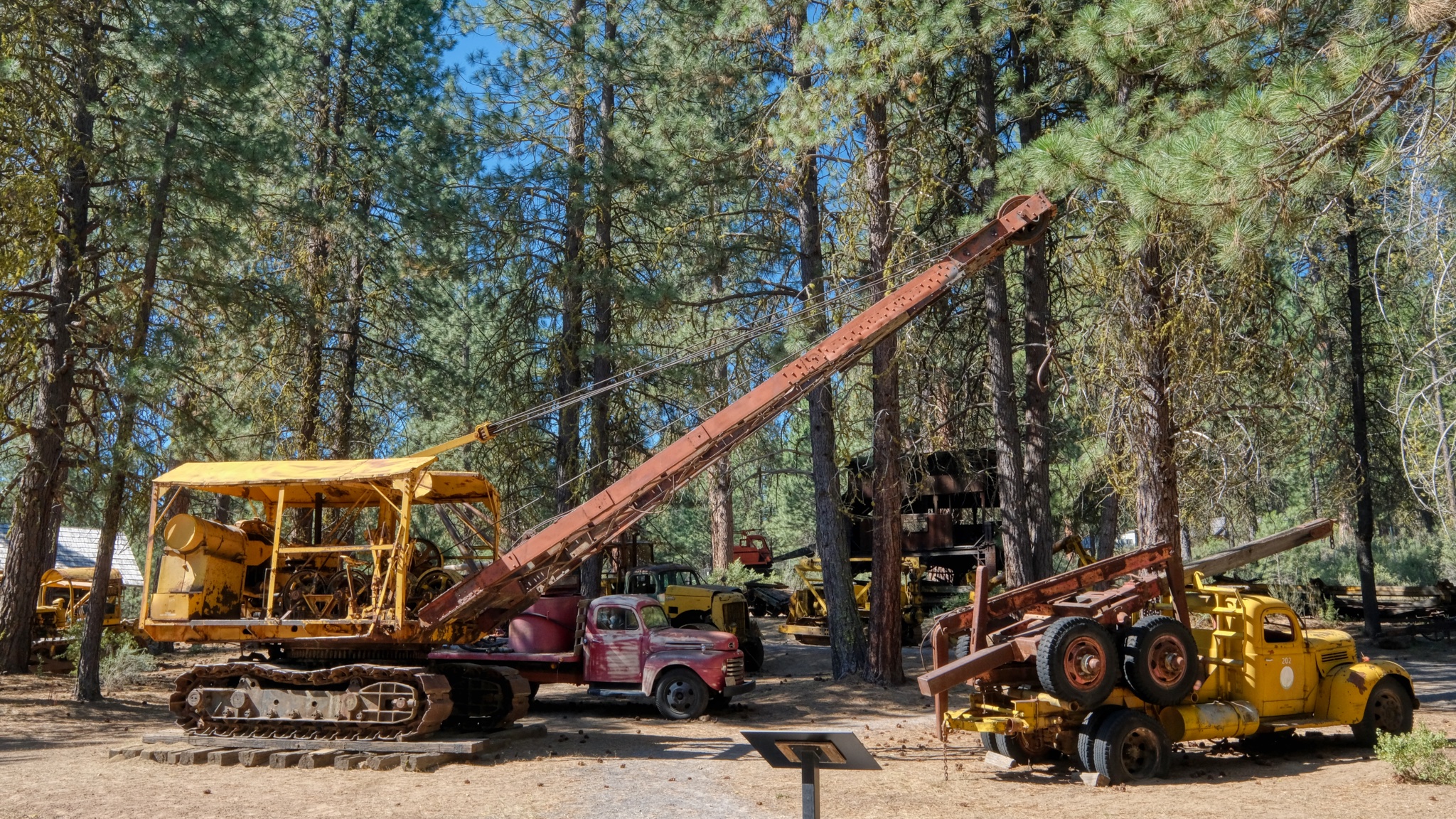 Heading south on old highway US97 -- taking the long way from Bend, Oregon to Lake Tahoe, California -- we happened upon the Collier Logging Museum. Of course I had to stop.
Heading south on old highway US97 -- taking the long way from Bend, Oregon to Lake Tahoe, California -- we happened upon the Collier Logging Museum. Of course I had to stop.
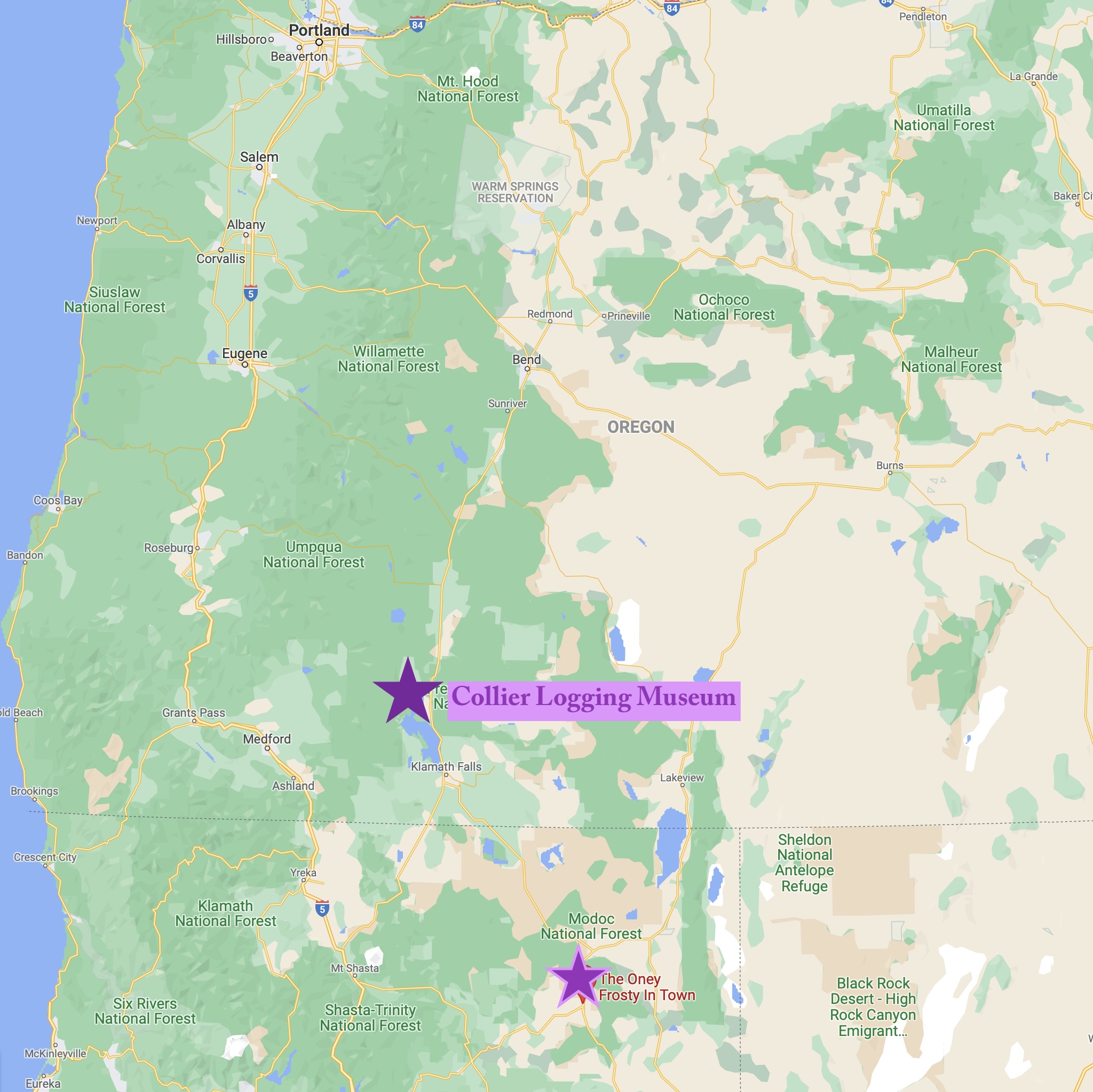 In southern Oregon, not too far from the California boarder . . . The Collier Logging Museum.
In southern Oregon, not too far from the California boarder . . . The Collier Logging Museum.
 I HAD to stop. I love these old machines . . .
I HAD to stop. I love these old machines . . .
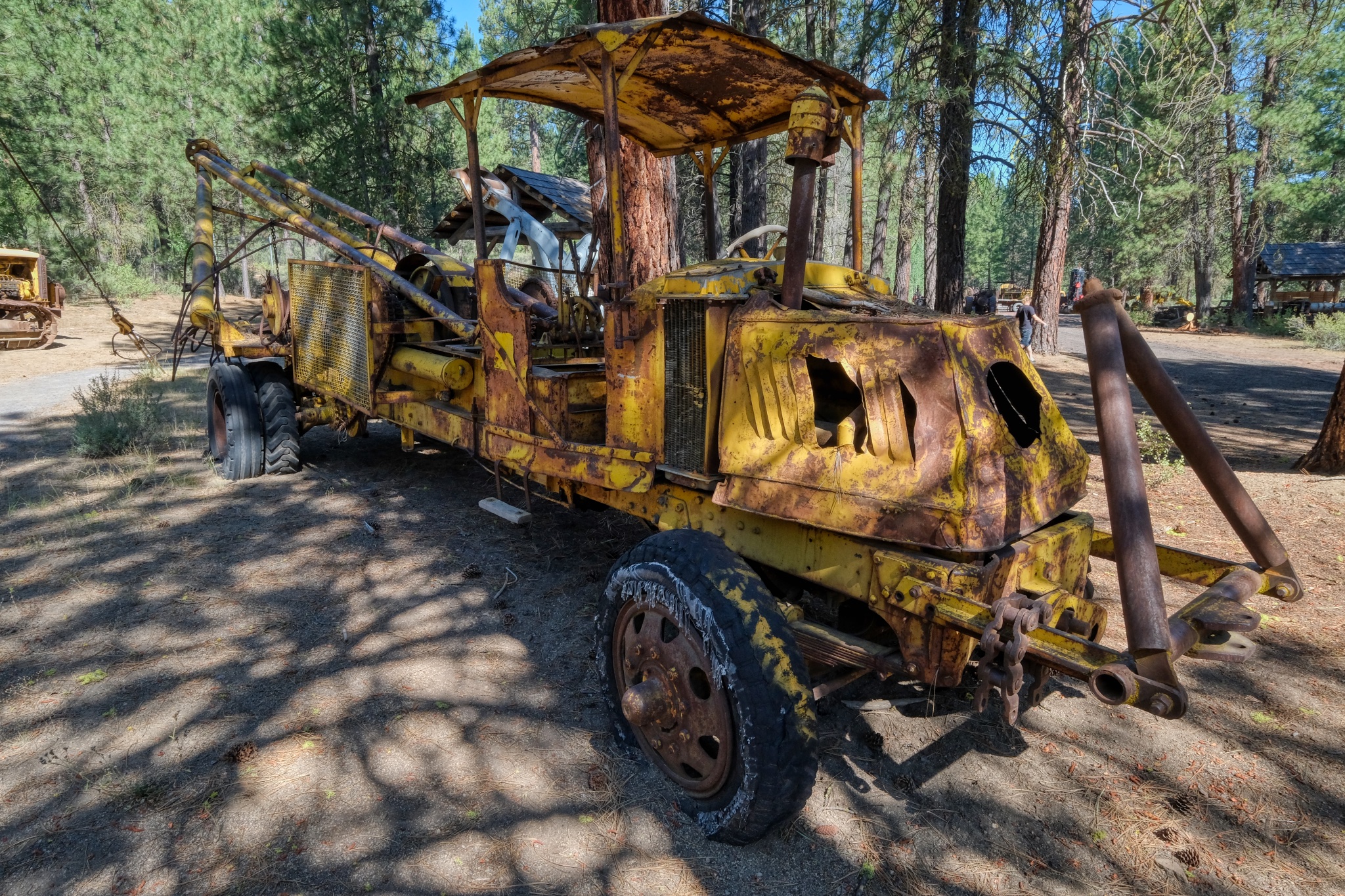 As a child I loved trucks of all kinds.
As a child I loved trucks of all kinds.
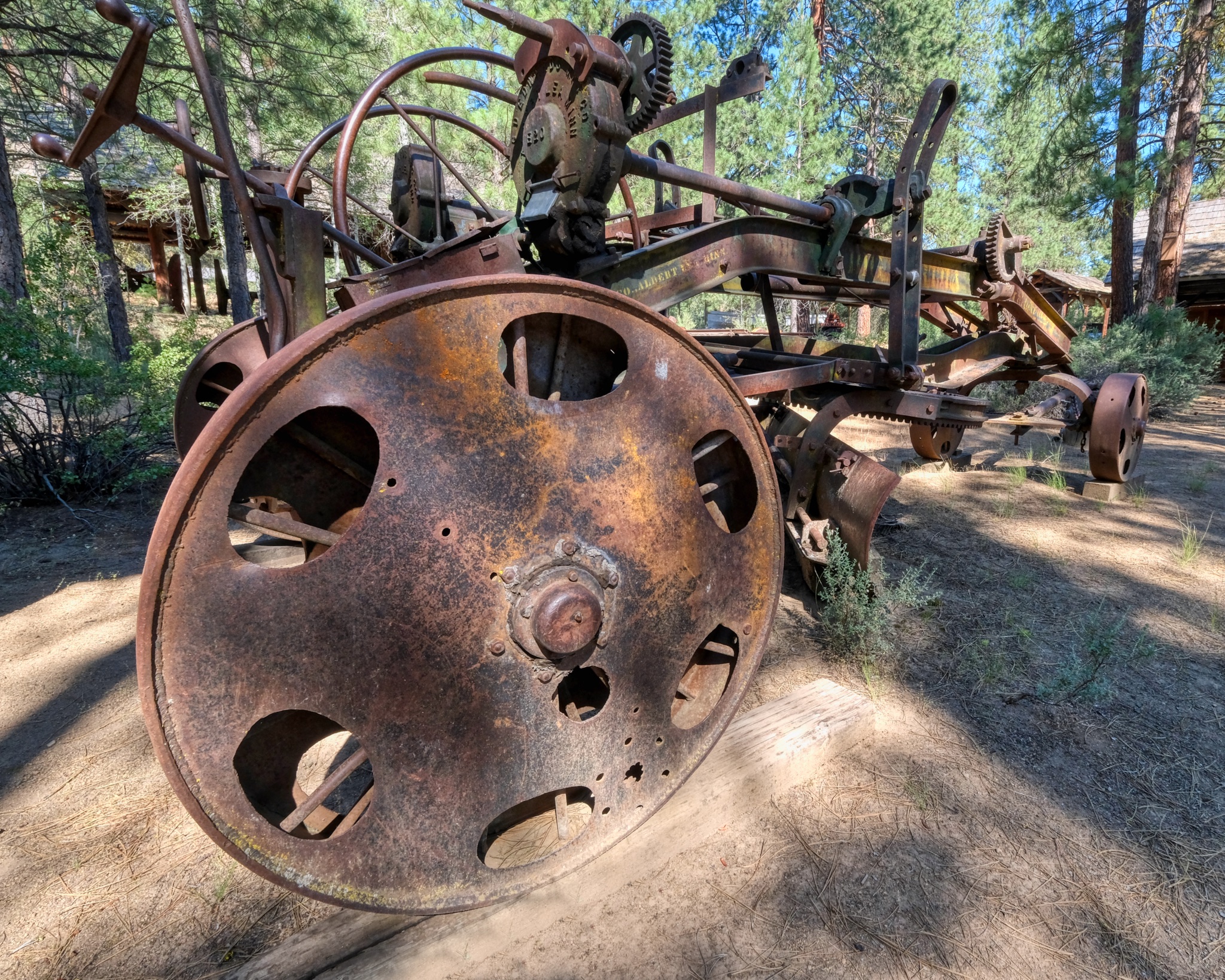 Giant steel wheels on this ancient road grader meant to be towed by a bulldozer.
Giant steel wheels on this ancient road grader meant to be towed by a bulldozer.
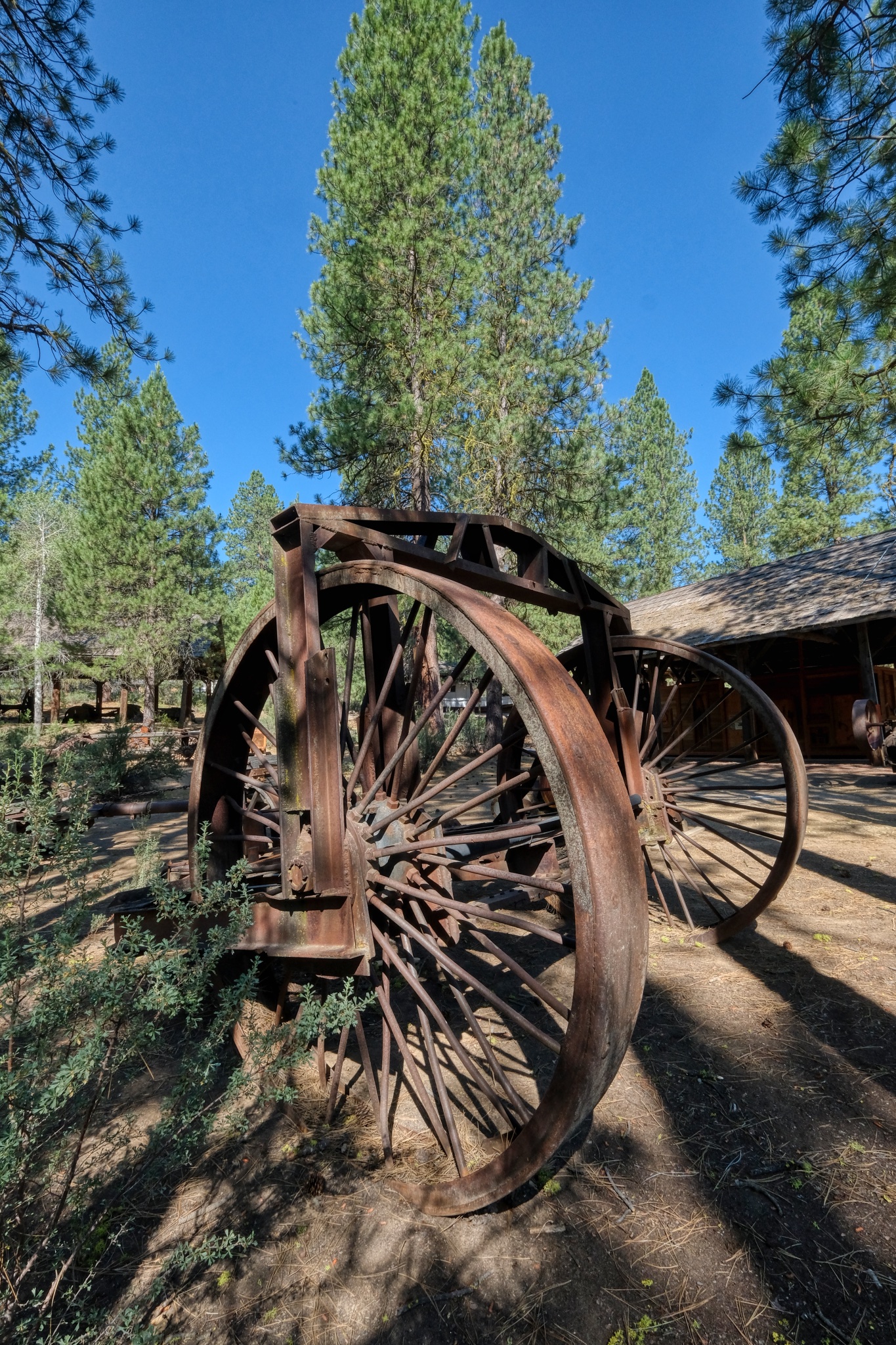 A pull along log skidder, also pulled by a bulldozer.
A pull along log skidder, also pulled by a bulldozer.
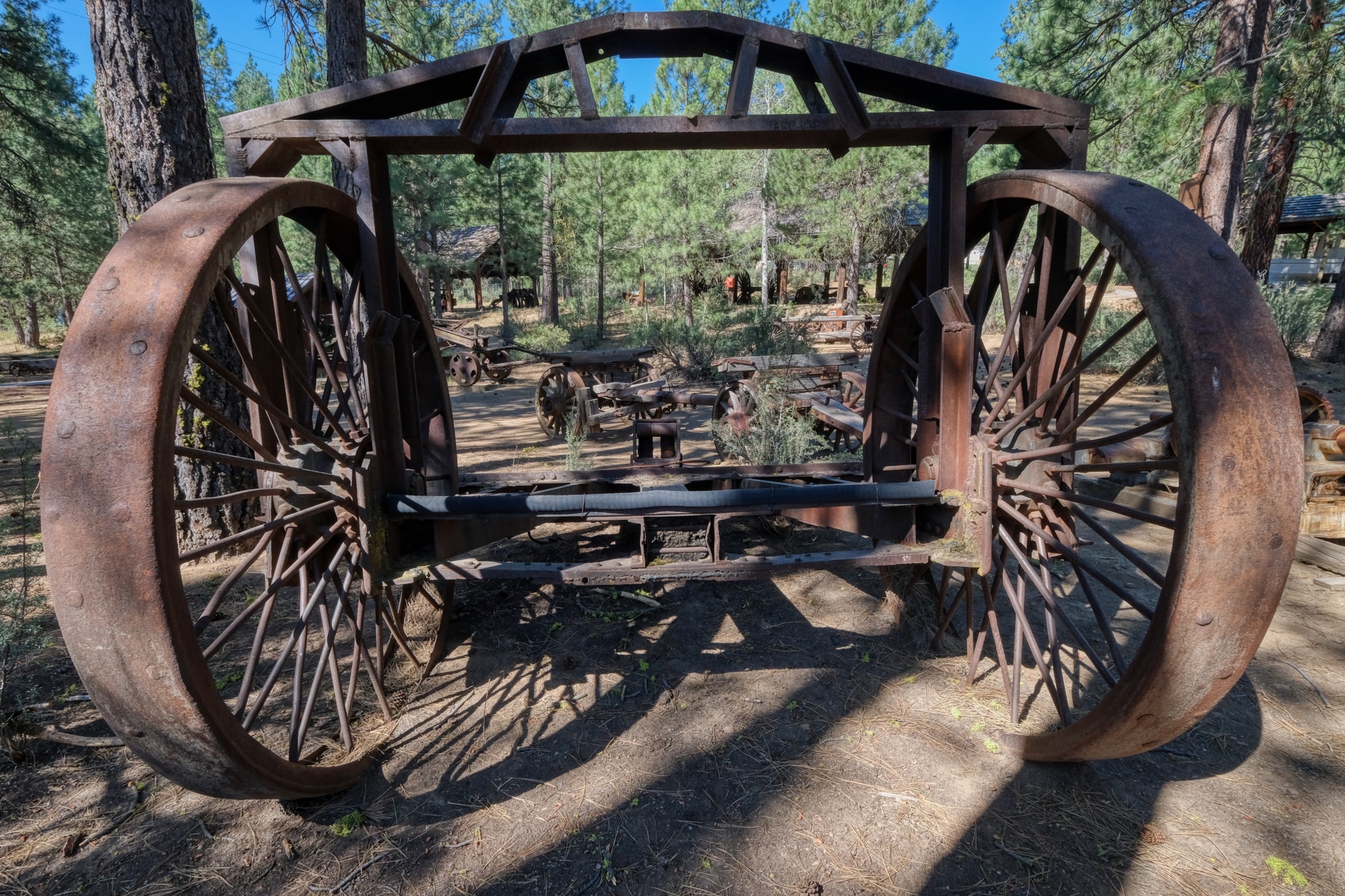 The front of a giant log would be lifted by this rig and then the other end dragged ("skidded") along in the forest floor.
The front of a giant log would be lifted by this rig and then the other end dragged ("skidded") along in the forest floor.
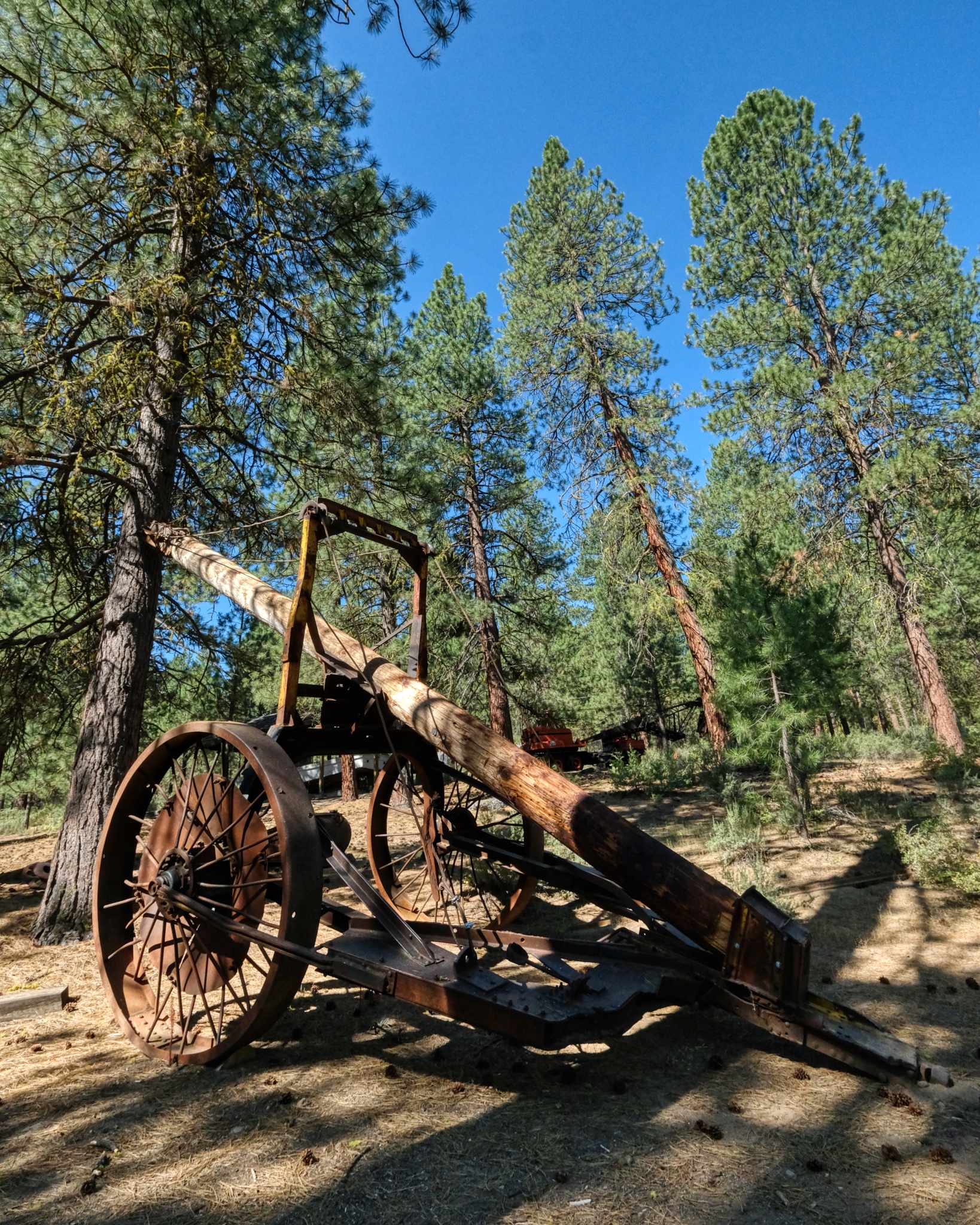 Another approach for skidding logs . . . .
Another approach for skidding logs . . . .
 The front of a log, or logs, were lifted and then skidded out of the forest to a roadhead for loading on trucks, or small gauge rail systems.
The front of a log, or logs, were lifted and then skidded out of the forest to a roadhead for loading on trucks, or small gauge rail systems.
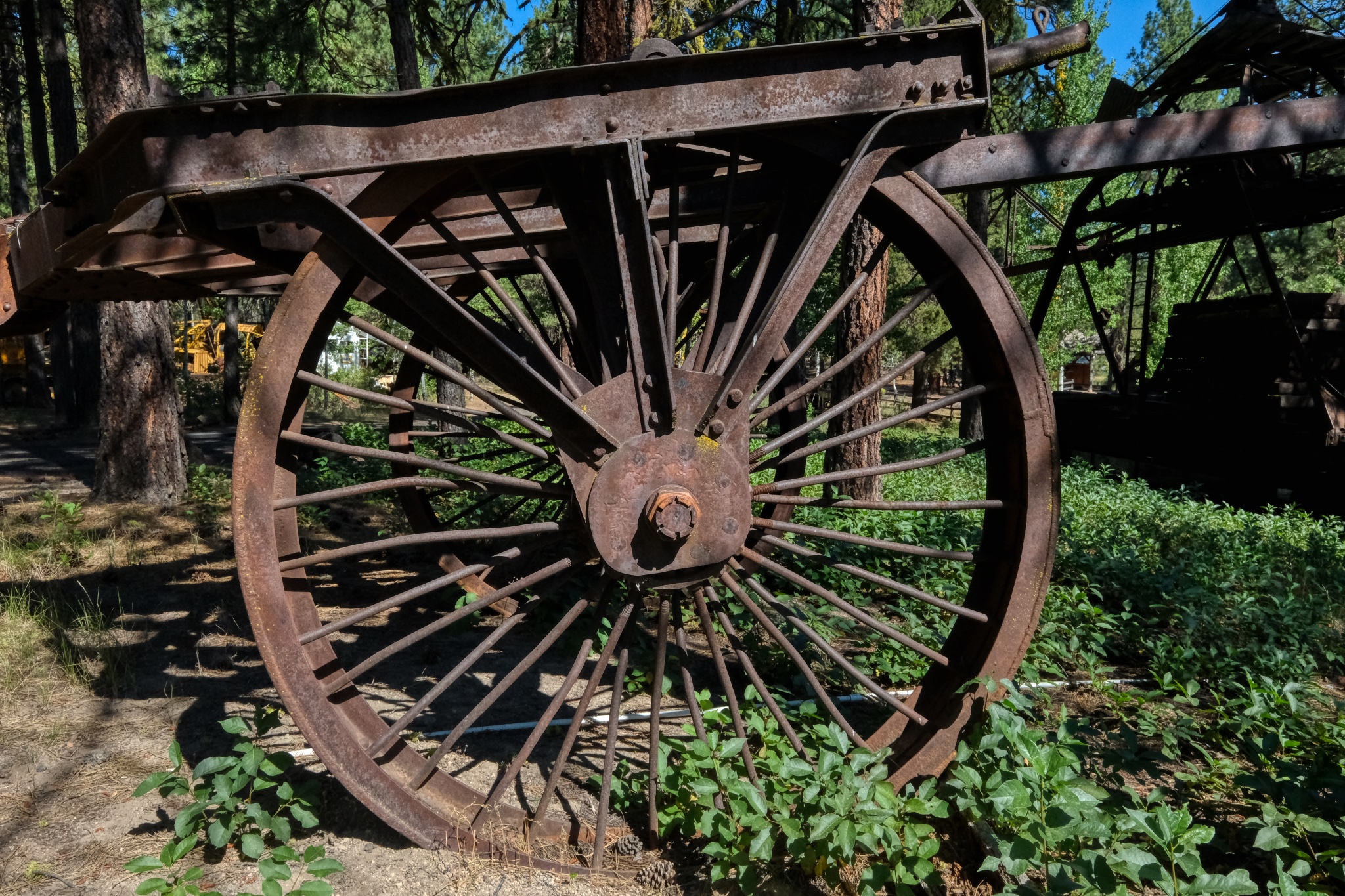 There were many of the large iron-wheeled wagons sitting out in the forest of the museum.
There were many of the large iron-wheeled wagons sitting out in the forest of the museum.
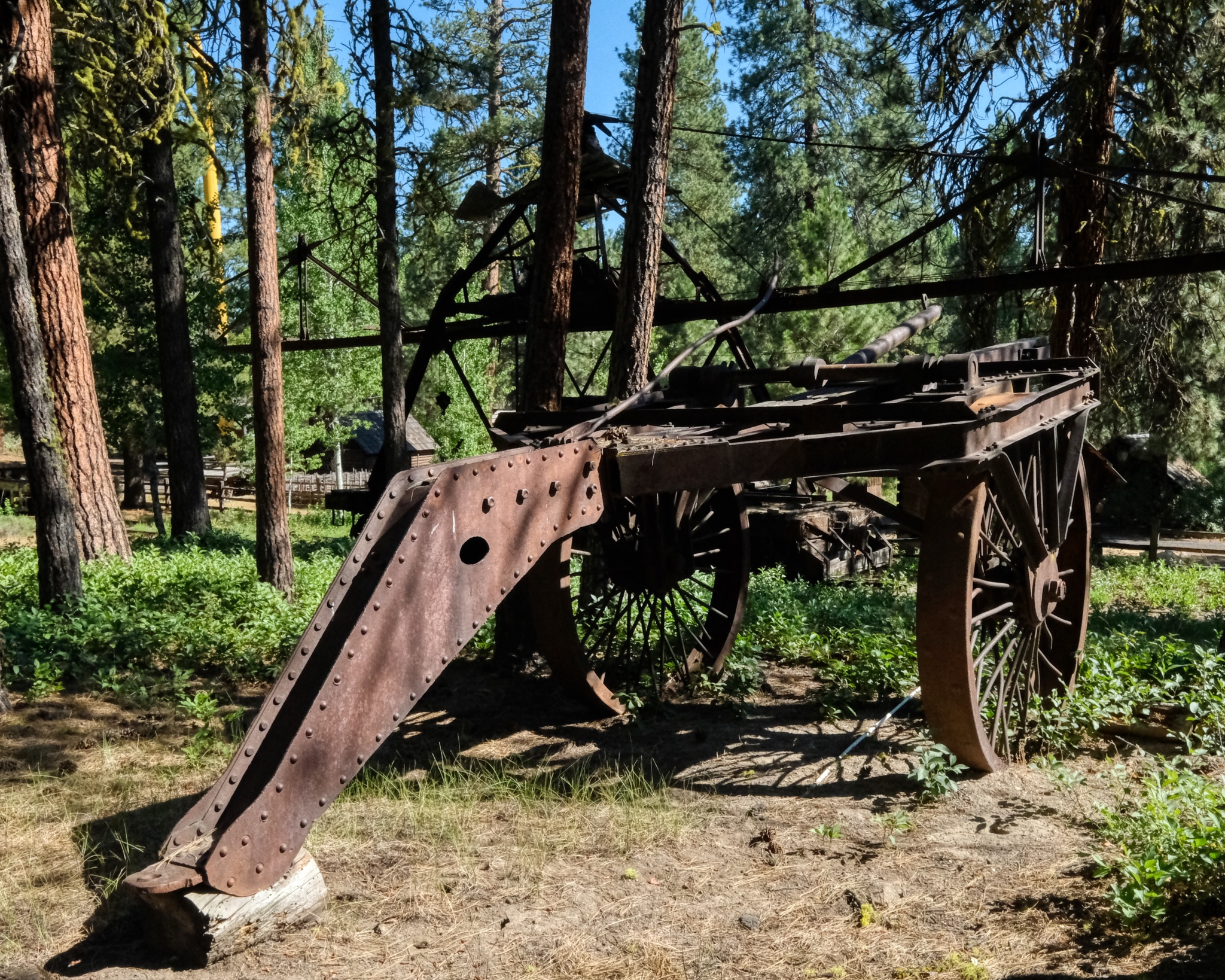 Big wagons for big work in the big forests of Oregon.
Big wagons for big work in the big forests of Oregon.
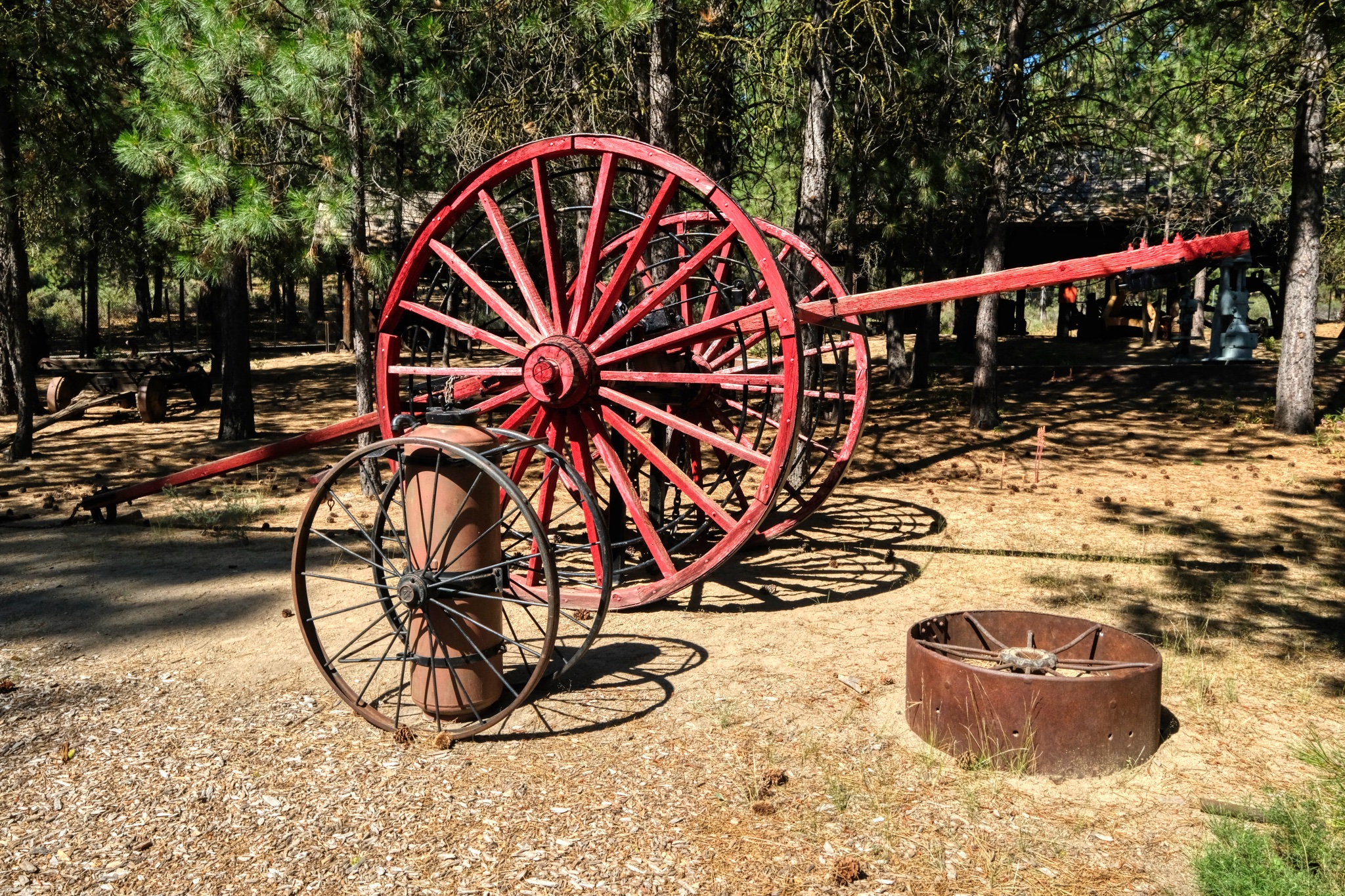 Big red wagon wheel . . . .
Big red wagon wheel . . . .
 One can imagine an old dozer chugging through the forest pulling one of these steel-wheeled skidders.
One can imagine an old dozer chugging through the forest pulling one of these steel-wheeled skidders.
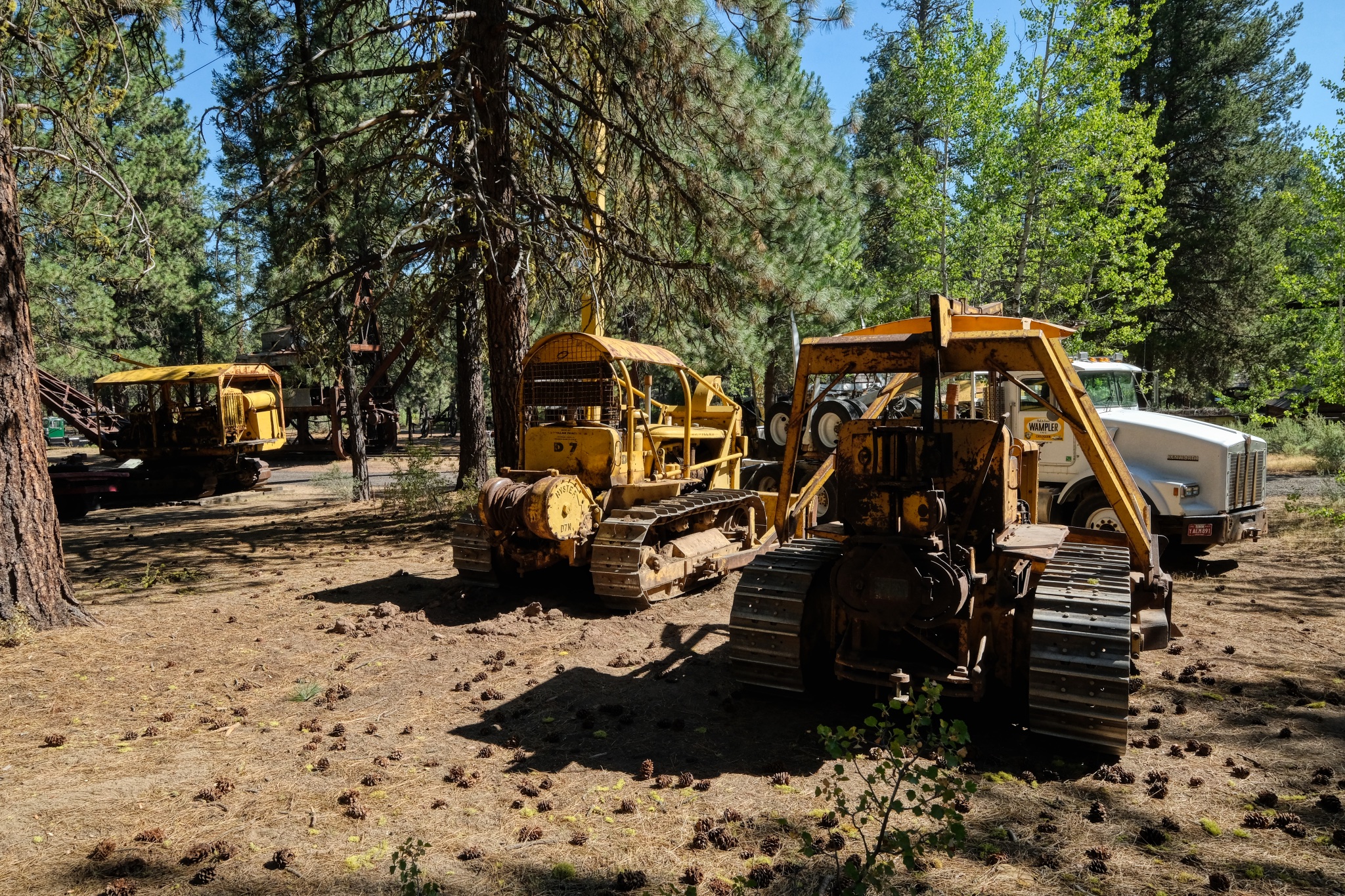 There were many old dozers sitting around in the pine straw.
There were many old dozers sitting around in the pine straw.
 Once the logs had been skidded to a landing, a crane, perhaps like this one, would load the logs onto trucks or a rail car.
Once the logs had been skidded to a landing, a crane, perhaps like this one, would load the logs onto trucks or a rail car.
 Very early on, a steam powered crane/log loader would be rolled out on rails.
Very early on, a steam powered crane/log loader would be rolled out on rails.
 In the foreground is an old "mule" diesel locomotive used to push around cranes and other rail cars out in the logging site. By the 1950s and 60s, road worthy truck-mounted cranes, like the one in the rear, became more widely used.
In the foreground is an old "mule" diesel locomotive used to push around cranes and other rail cars out in the logging site. By the 1950s and 60s, road worthy truck-mounted cranes, like the one in the rear, became more widely used.
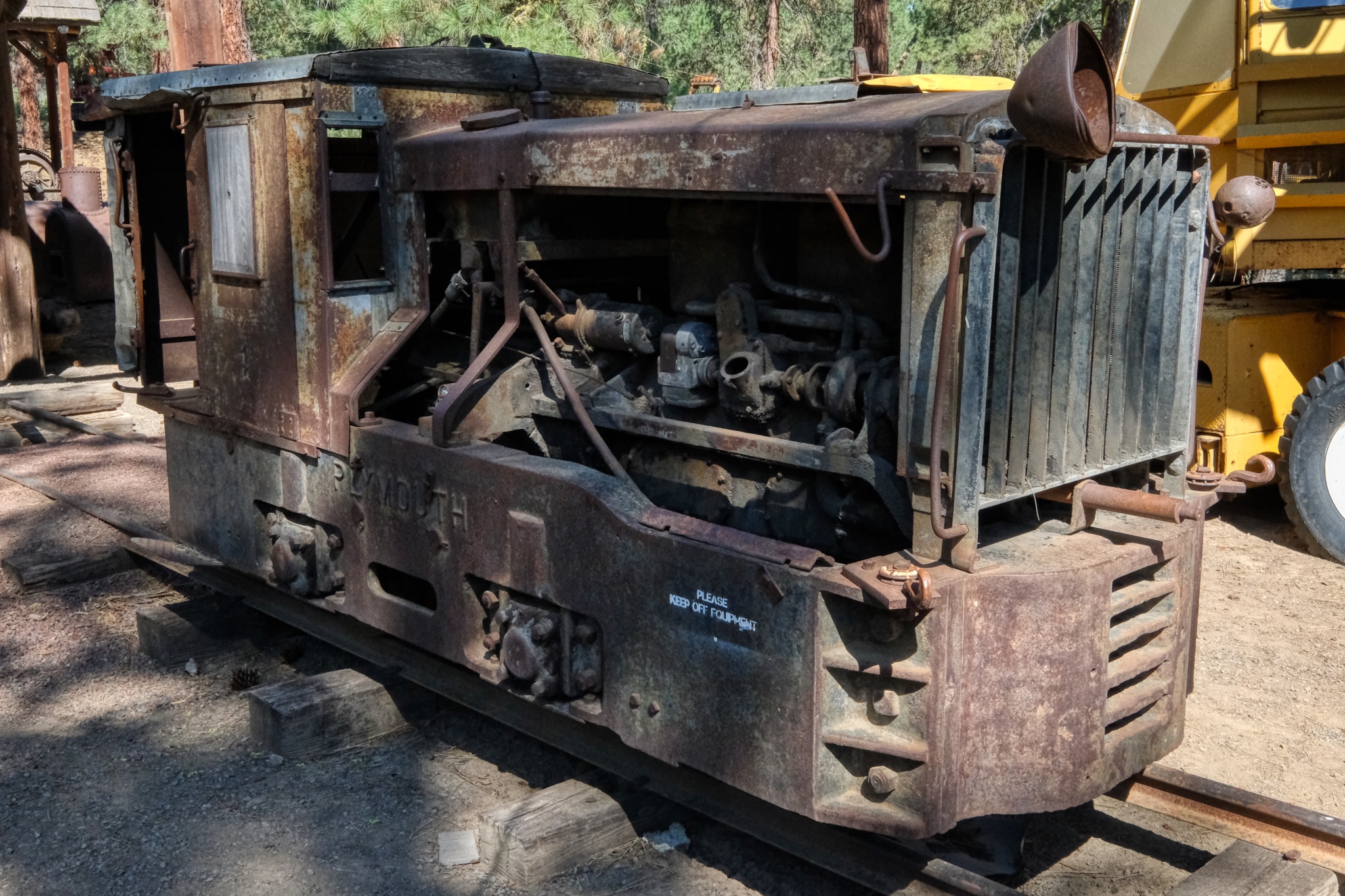 The little "mule" diesel locomotive.
The little "mule" diesel locomotive.
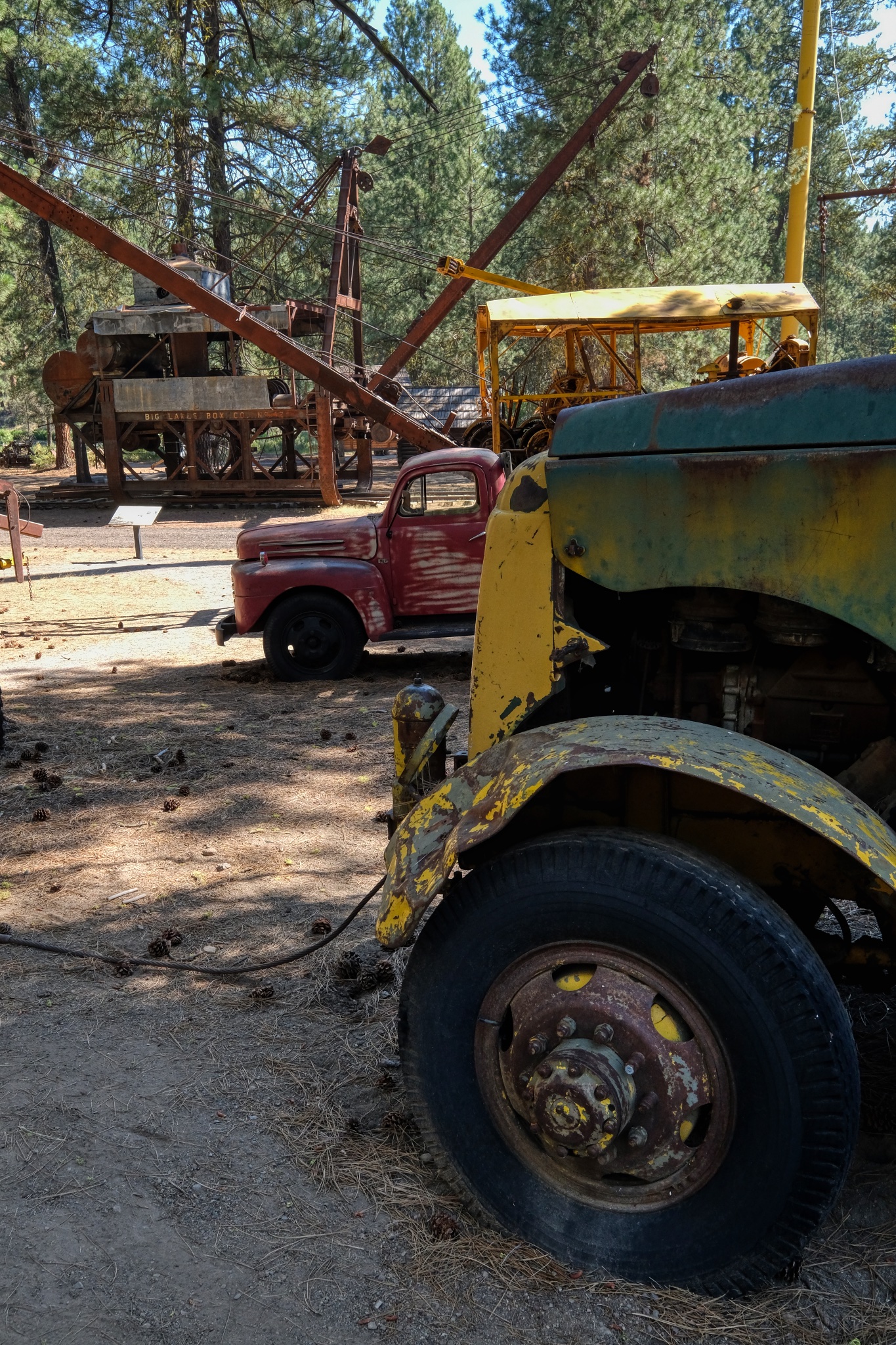 Old log trucks and log loaders to satisfy my little heart's content!
Old log trucks and log loaders to satisfy my little heart's content!
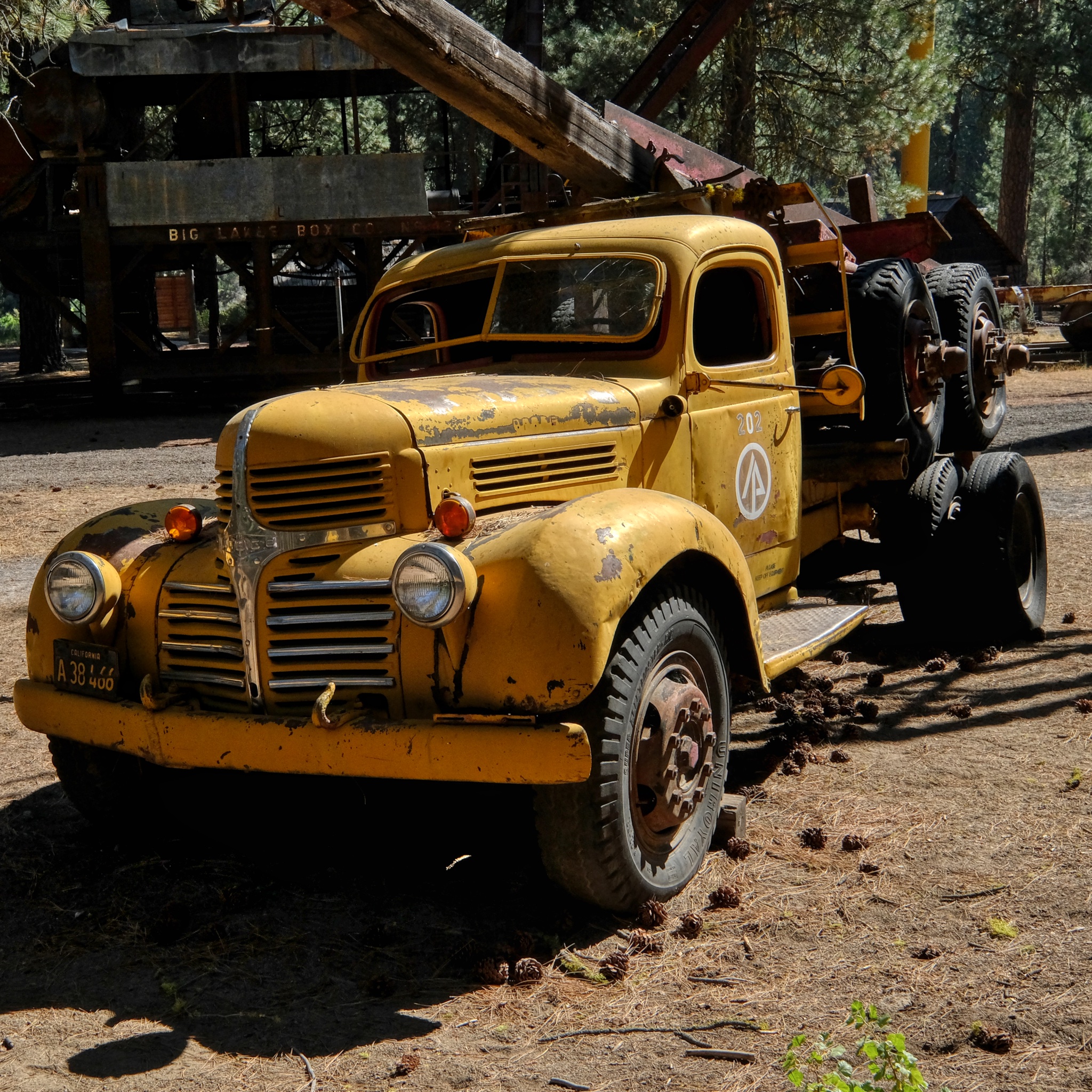 Much of the lumber used to build the houses on the west coast of the USA rode to the lumber mills on trucks like these.
Much of the lumber used to build the houses on the west coast of the USA rode to the lumber mills on trucks like these.
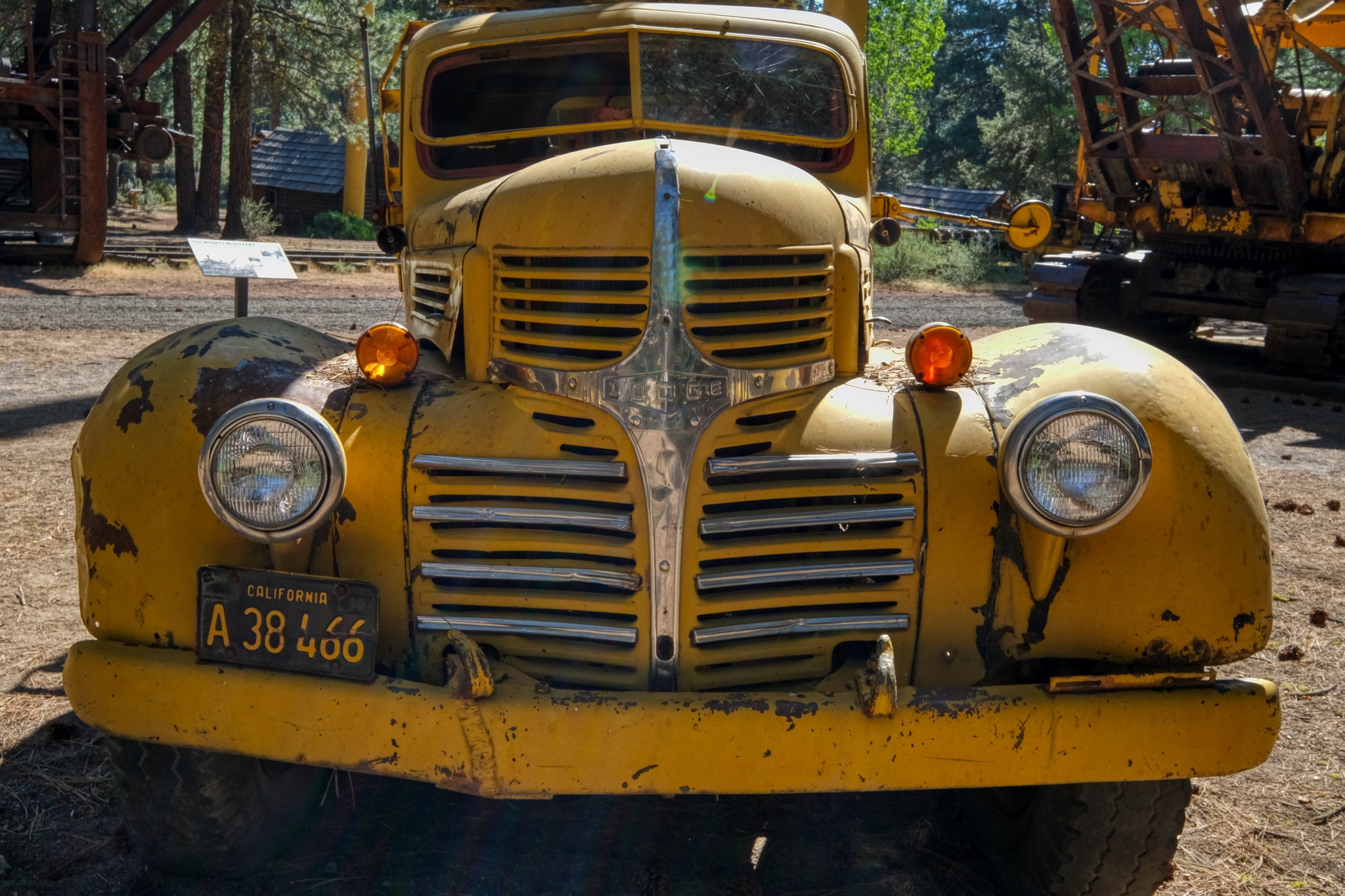 Not something you would want to see in your rear view mirror while going down a steep hill!
Not something you would want to see in your rear view mirror while going down a steep hill!
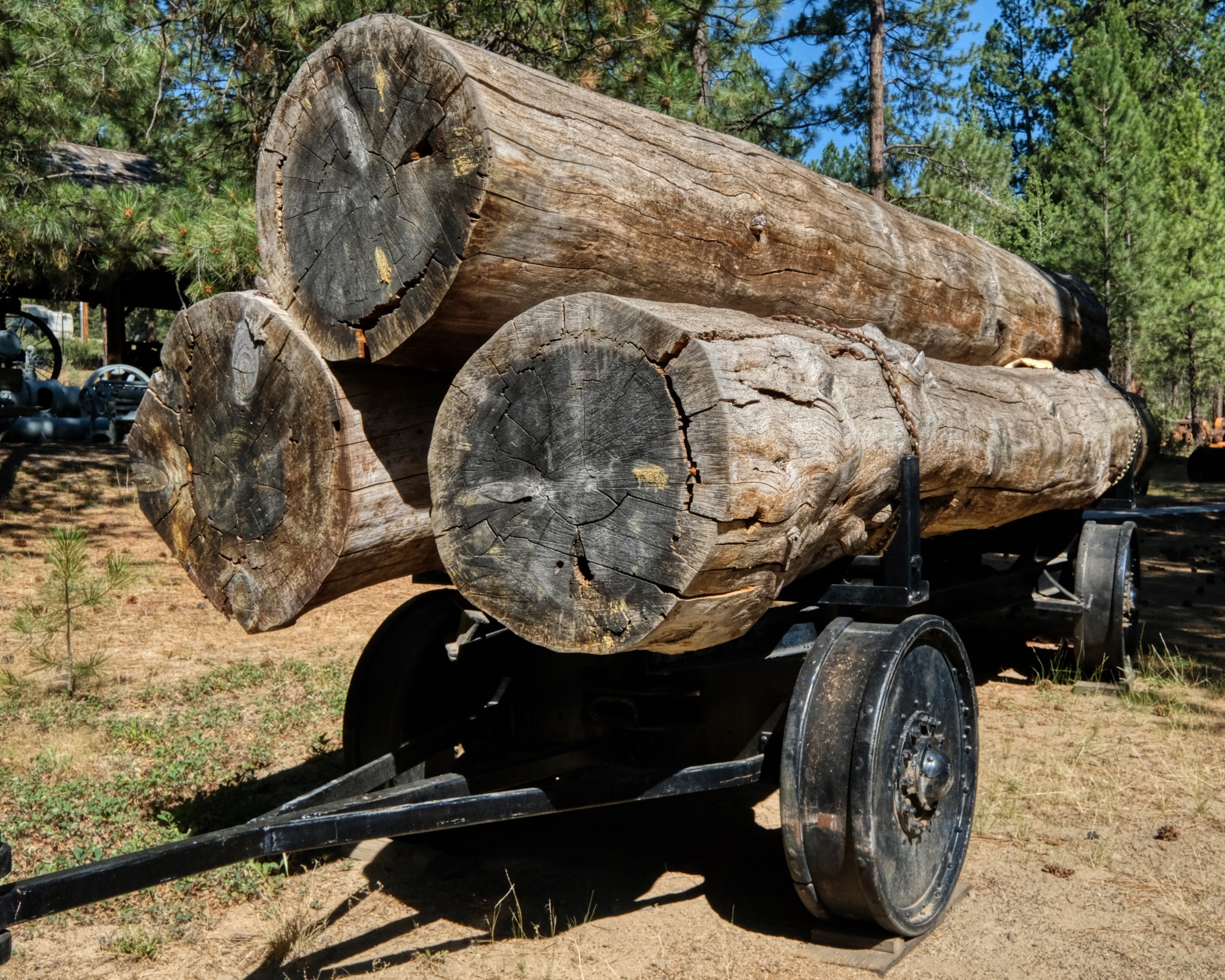 A very old steel-wheeled log trailer.
A very old steel-wheeled log trailer.
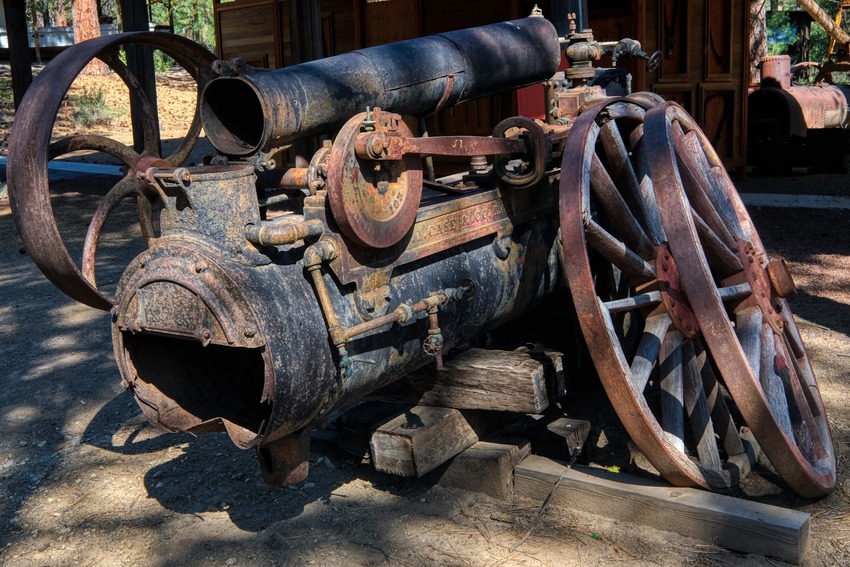 Steam powered pumps used in the wild woods early last century.
Steam powered pumps used in the wild woods early last century.
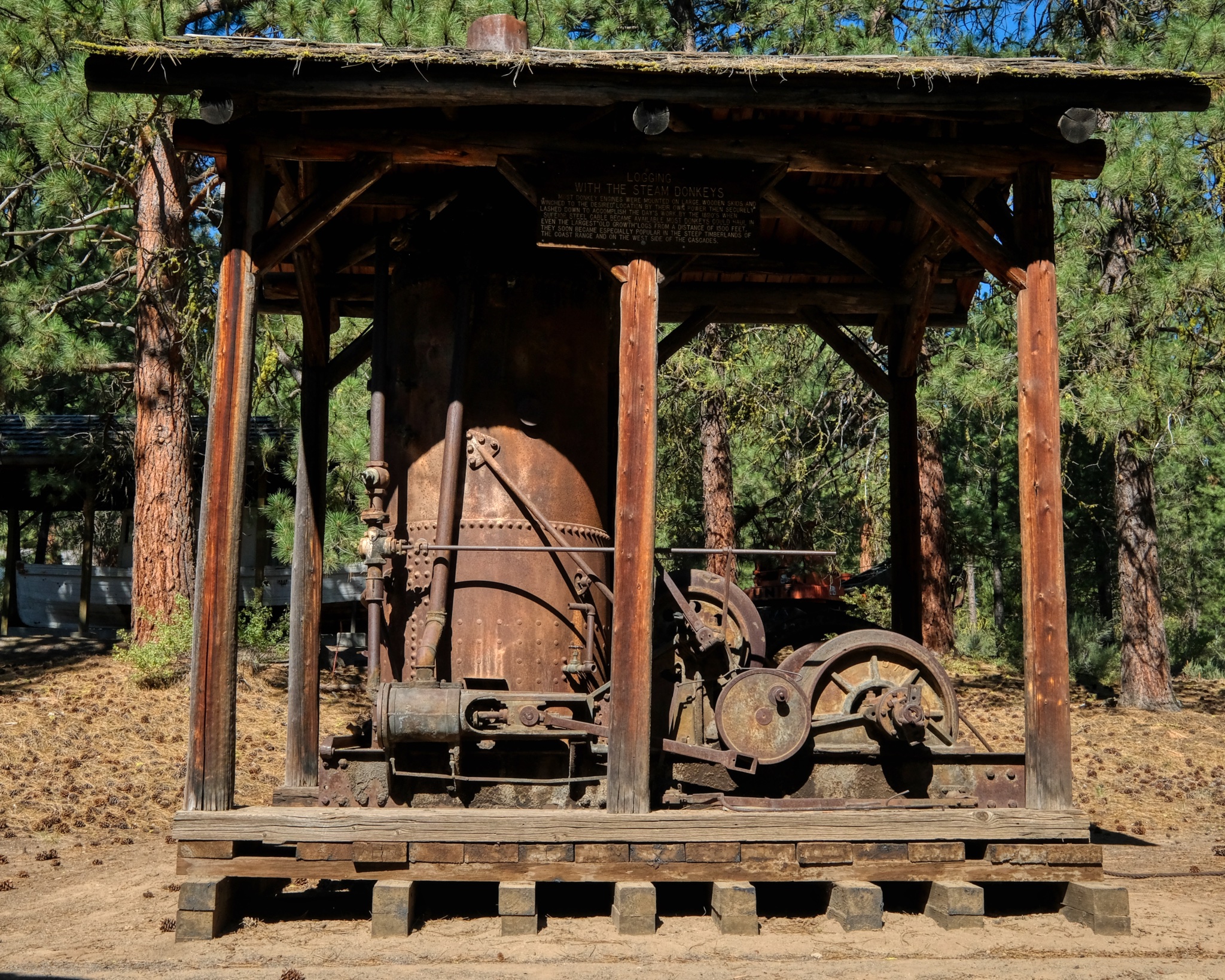 An antique steam powered winch . . .
An antique steam powered winch . . .
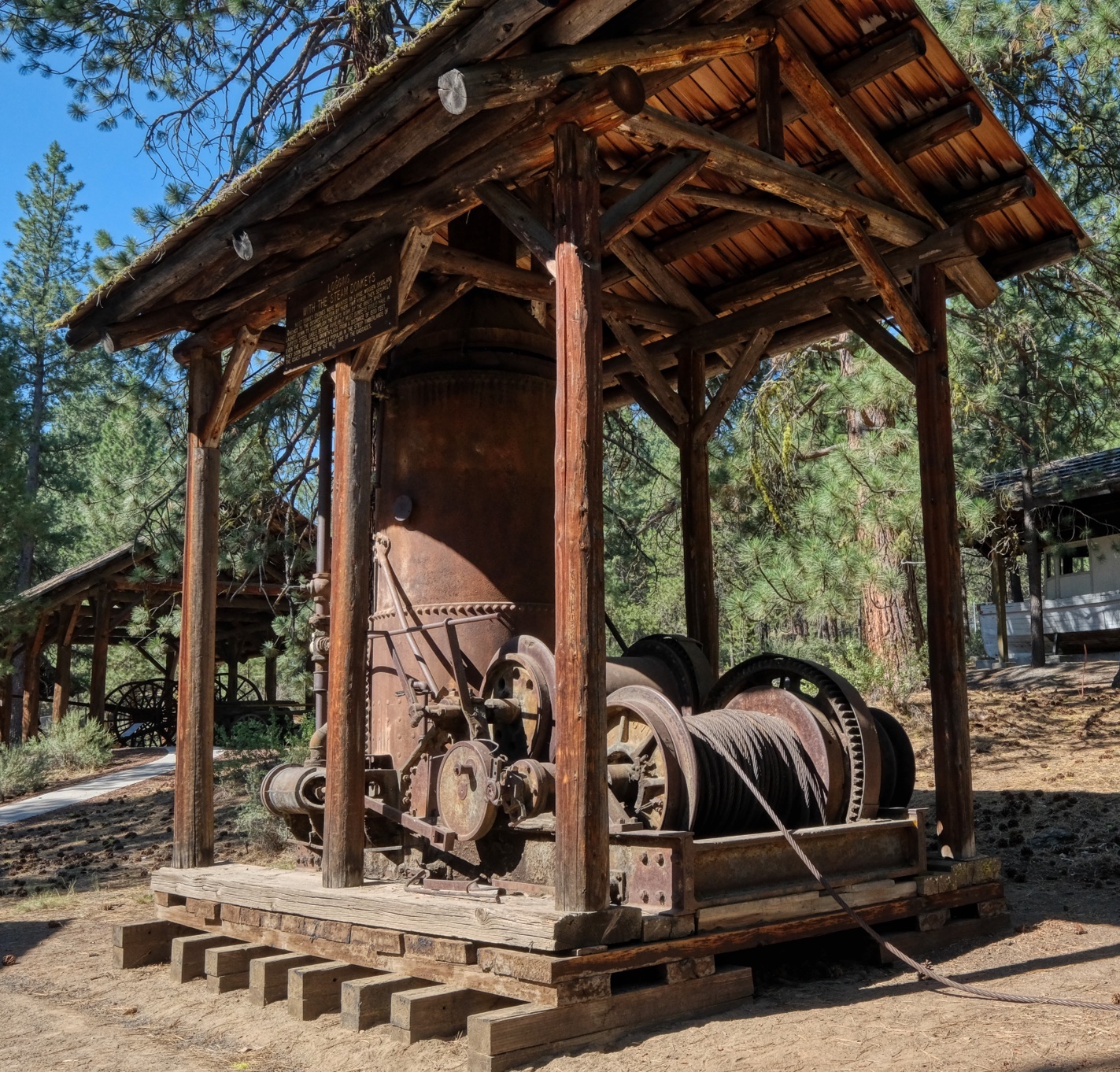 Steam winches mostly used for powering 'high lead' cables to drag logs up steep hills and across deep canyons.
Steam winches mostly used for powering 'high lead' cables to drag logs up steep hills and across deep canyons.
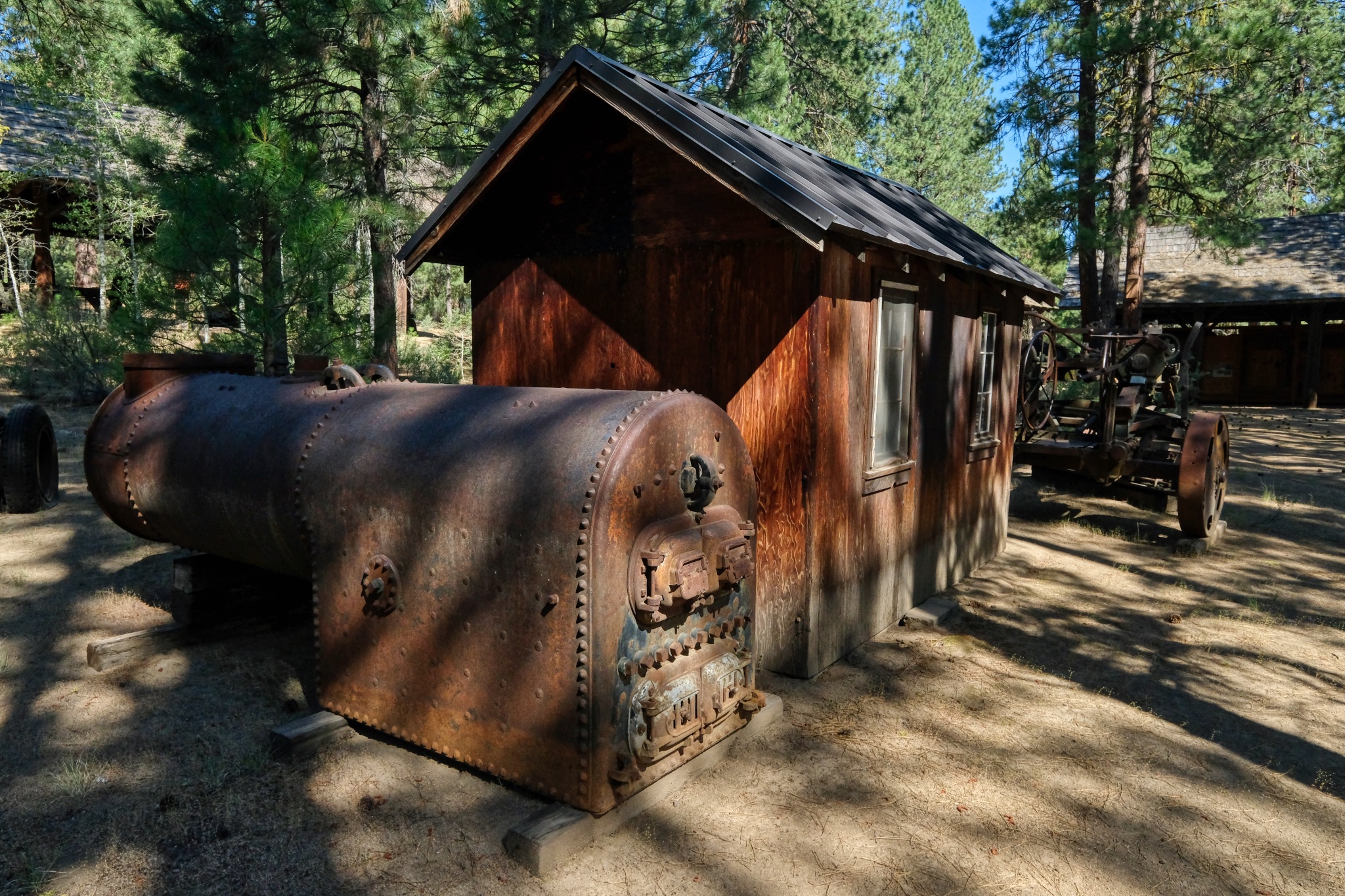 Remnants of big steam power systems laying around. Imagine dragging these up into the woods a century ago!
Remnants of big steam power systems laying around. Imagine dragging these up into the woods a century ago!
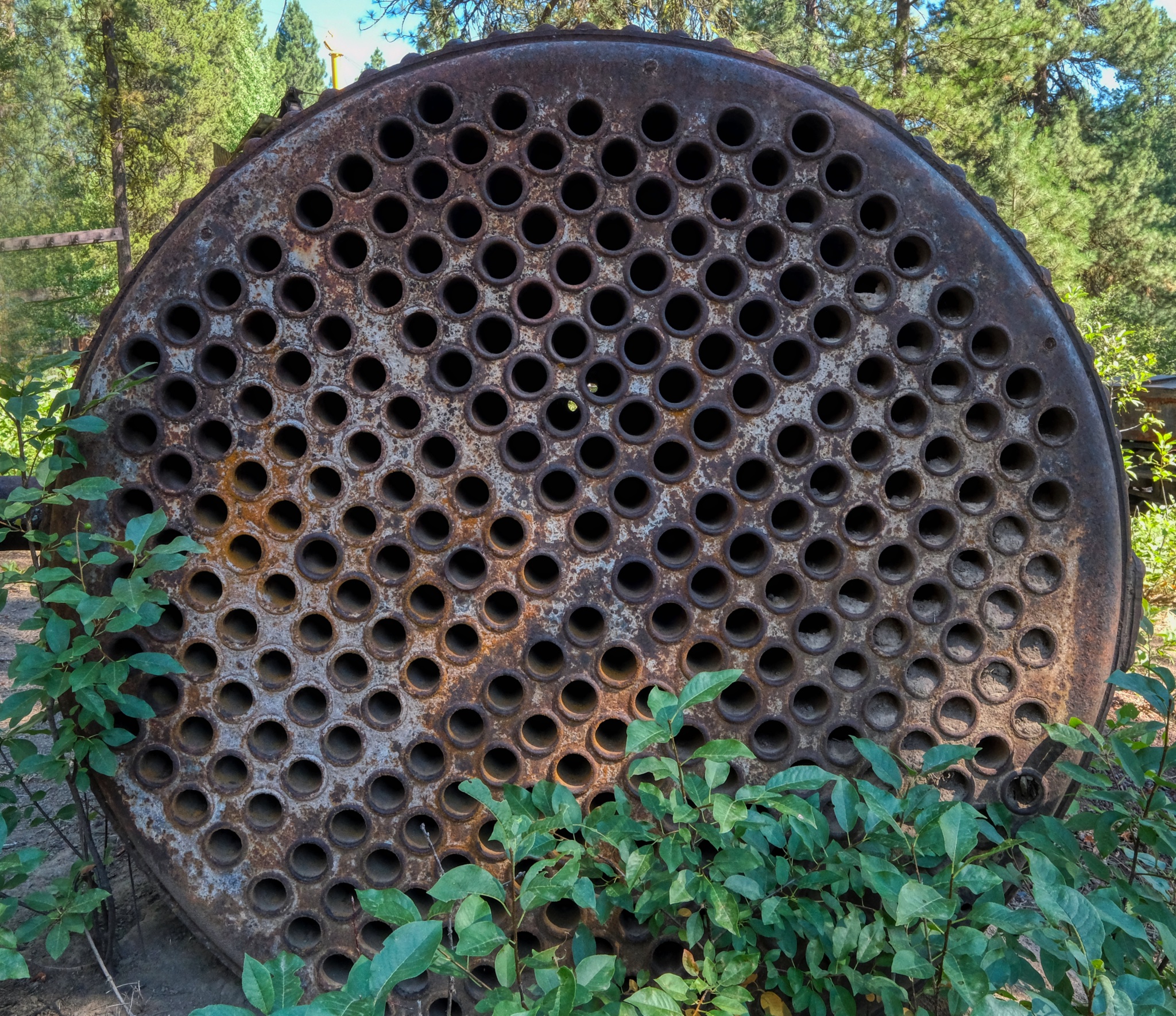 Boiler tubes.
Boiler tubes.
 Big sled winch used for high lead logging. Nice rigging blocks.
Big sled winch used for high lead logging. Nice rigging blocks.
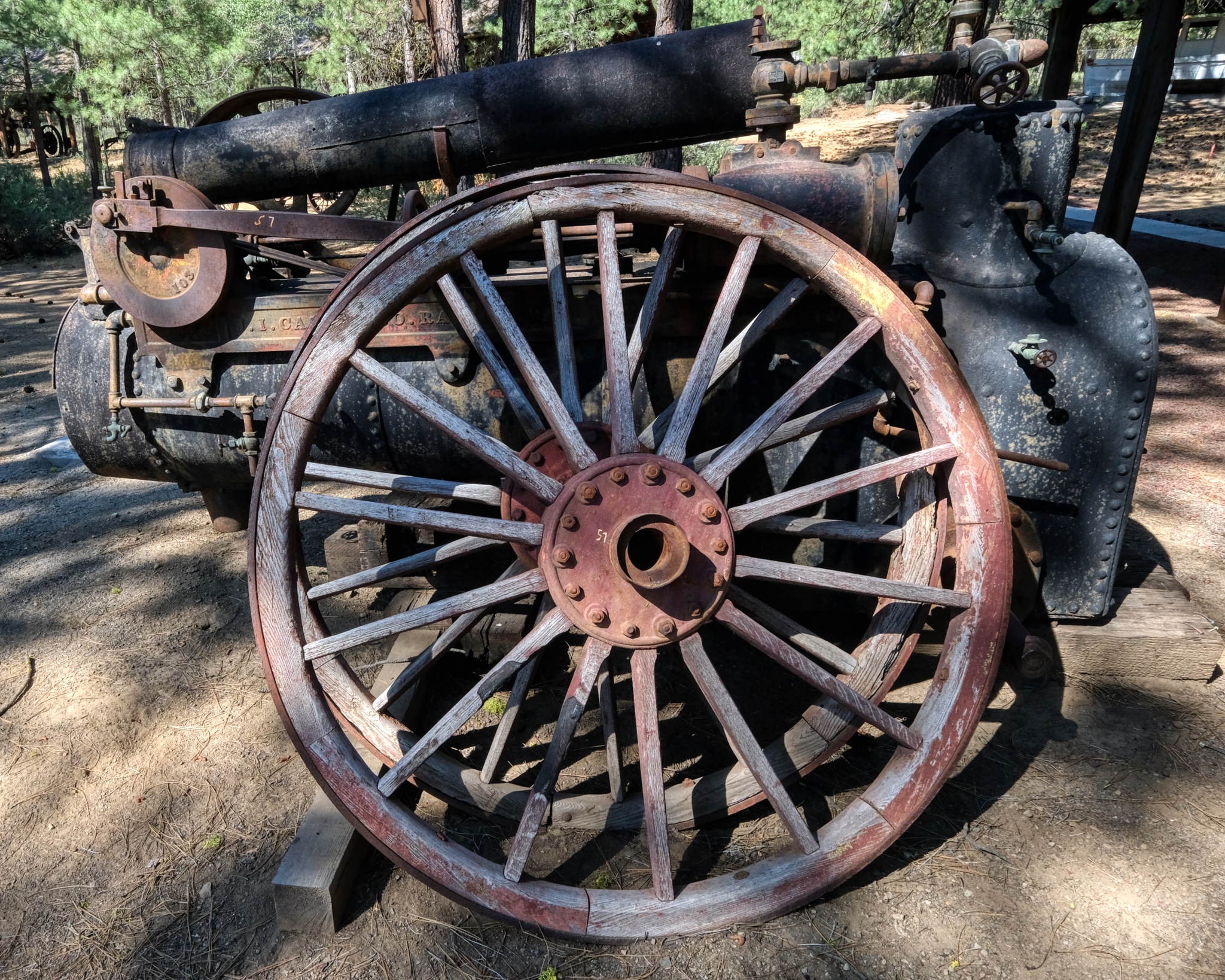 Wheeled steam pump wagon.
Wheeled steam pump wagon.
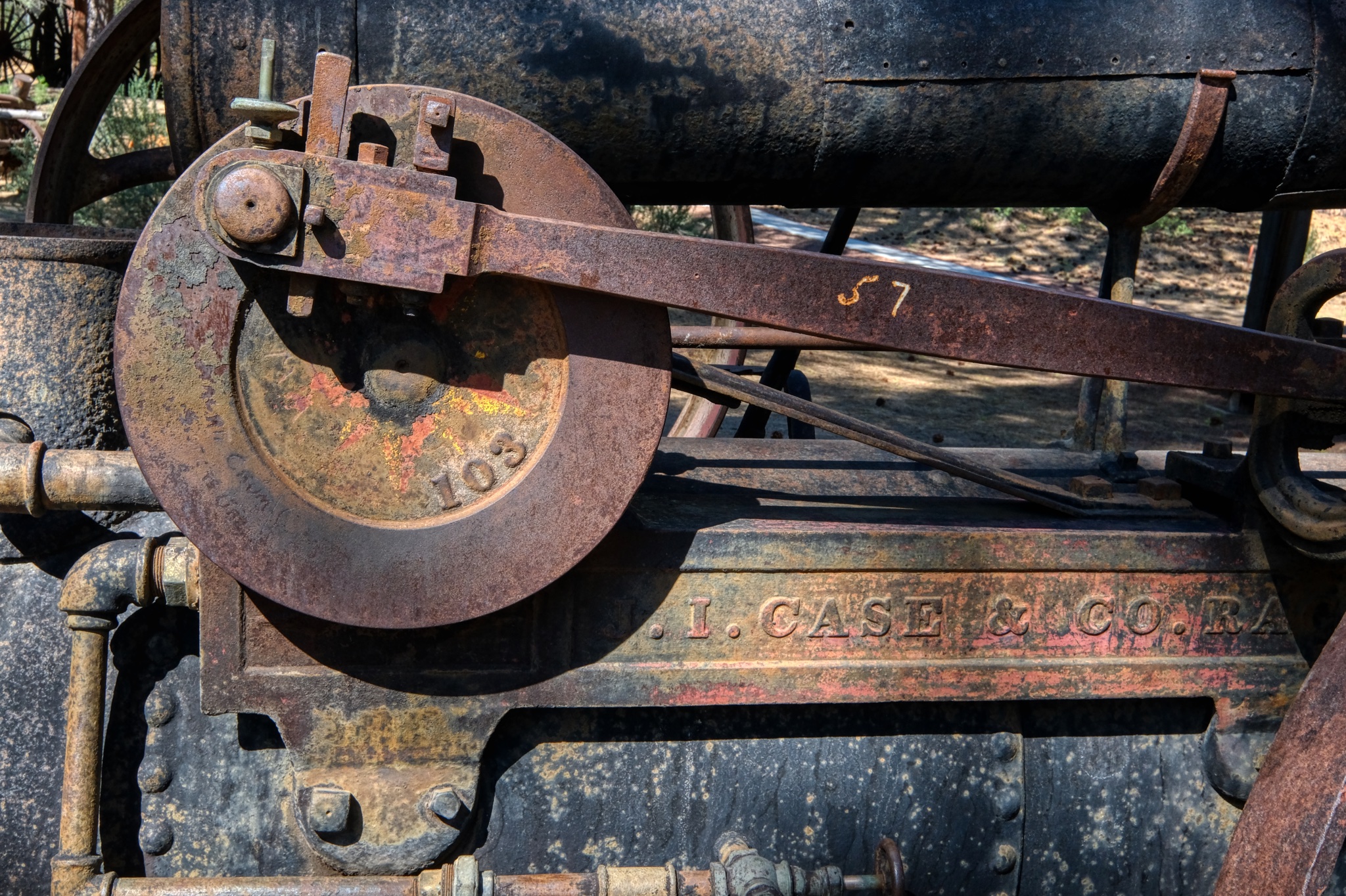 Marvelous machine work from a bygone era.
Marvelous machine work from a bygone era.
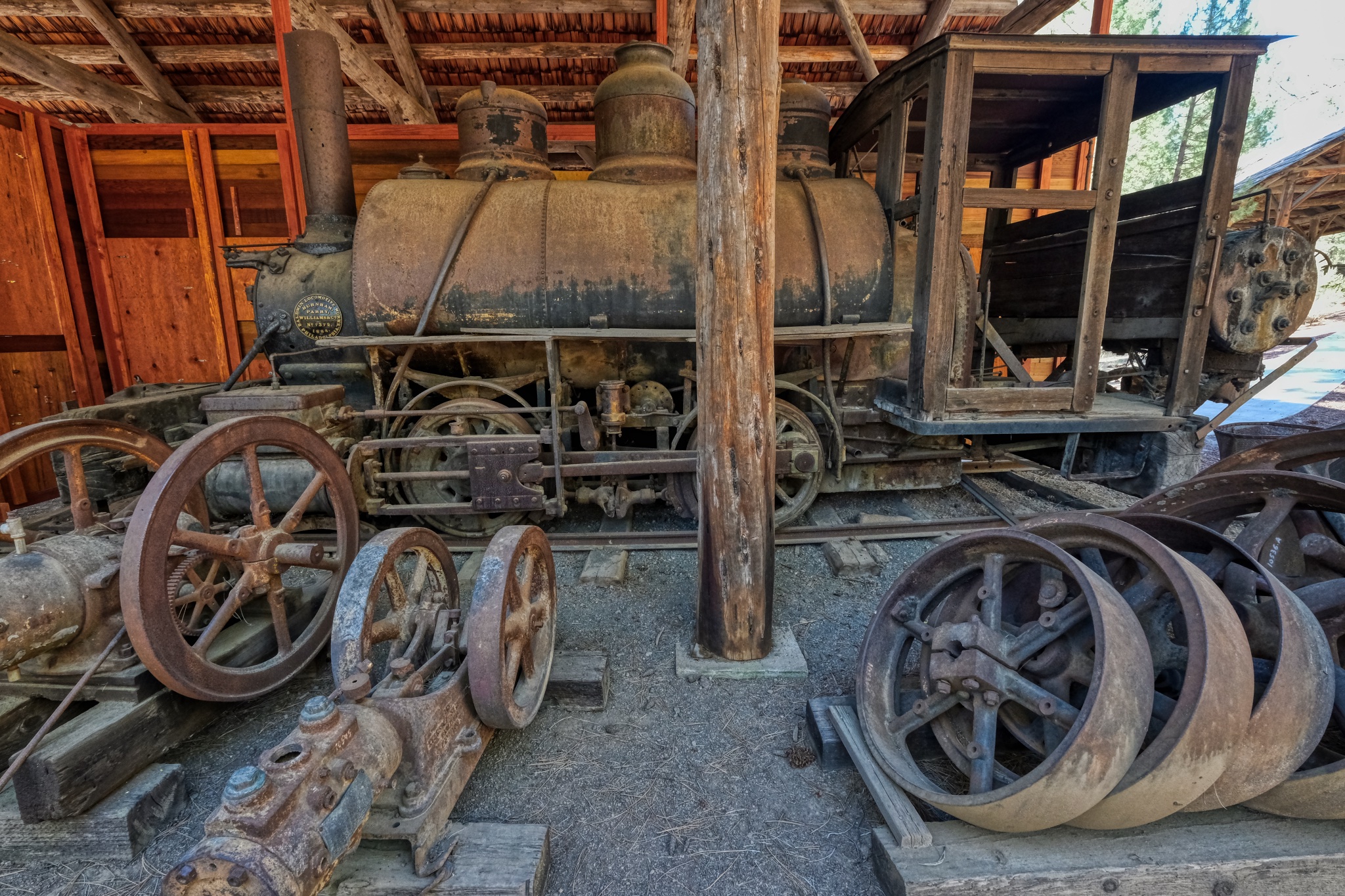 1880s locomotive shed with lots of old machinery here and there.
1880s locomotive shed with lots of old machinery here and there.
 A rail track-laying crane needed to build access rail lines into the old forests.
A rail track-laying crane needed to build access rail lines into the old forests.
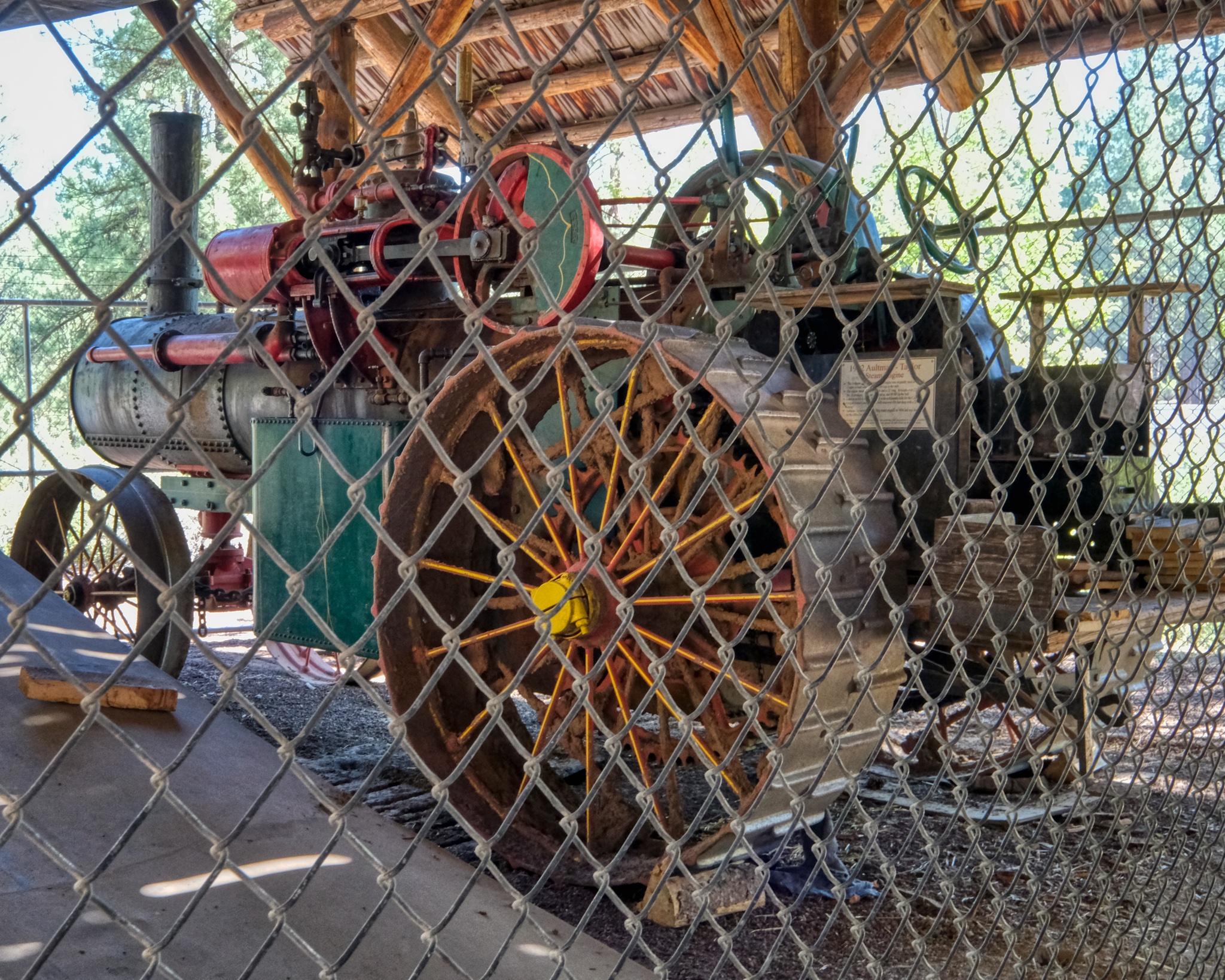 1912 Aultman-Taylor steam engine . . . WOW!
1912 Aultman-Taylor steam engine . . . WOW!
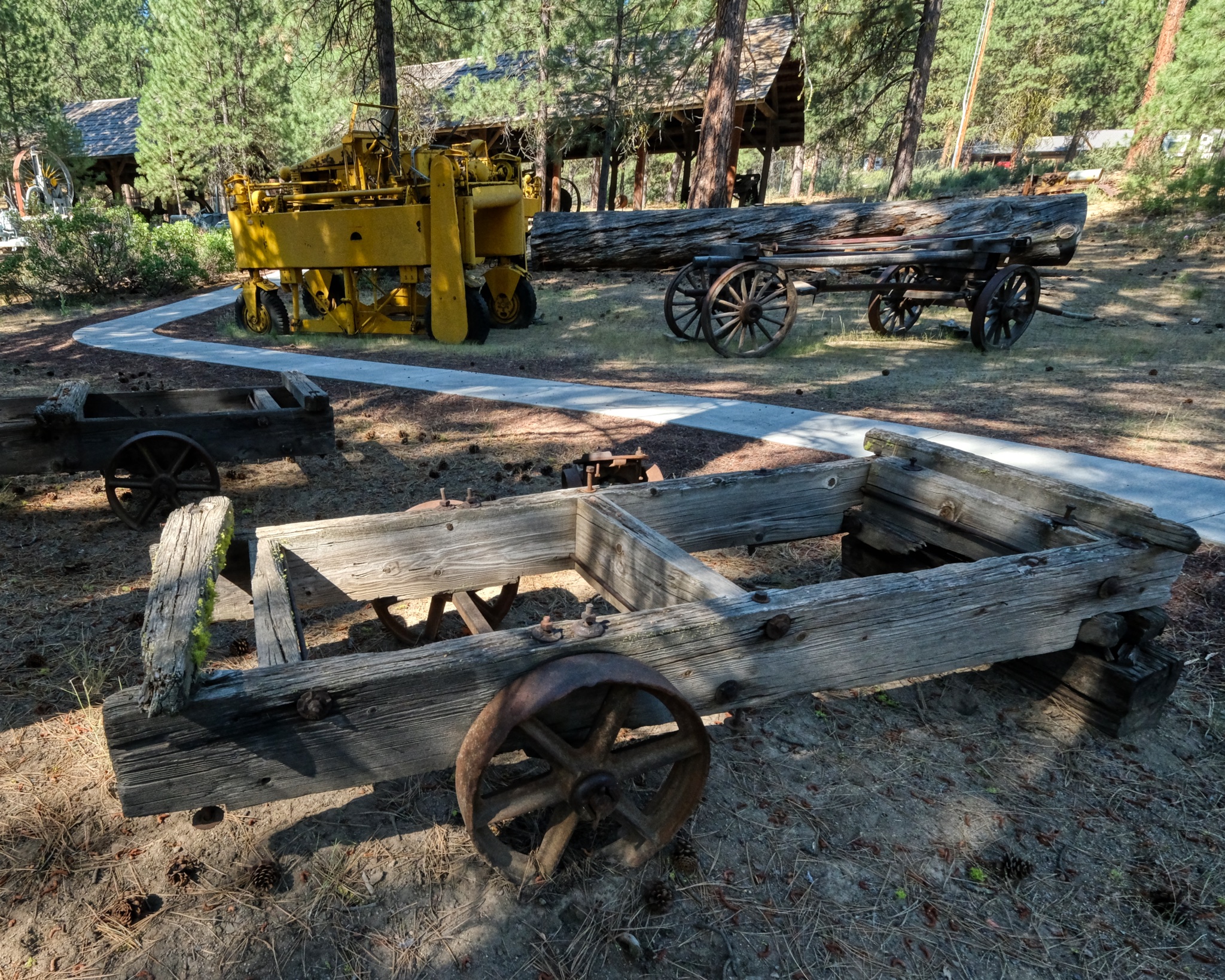 These lumber movers (yellow machine in the back) were still common in Oregon lumber mills in the late 1970s (when I worked in Oregon lumber mills!).
These lumber movers (yellow machine in the back) were still common in Oregon lumber mills in the late 1970s (when I worked in Oregon lumber mills!).
 Yep, you need a saw blade ("head saw") this large to cut some of these giant trees in the lumber mill.
Yep, you need a saw blade ("head saw") this large to cut some of these giant trees in the lumber mill.
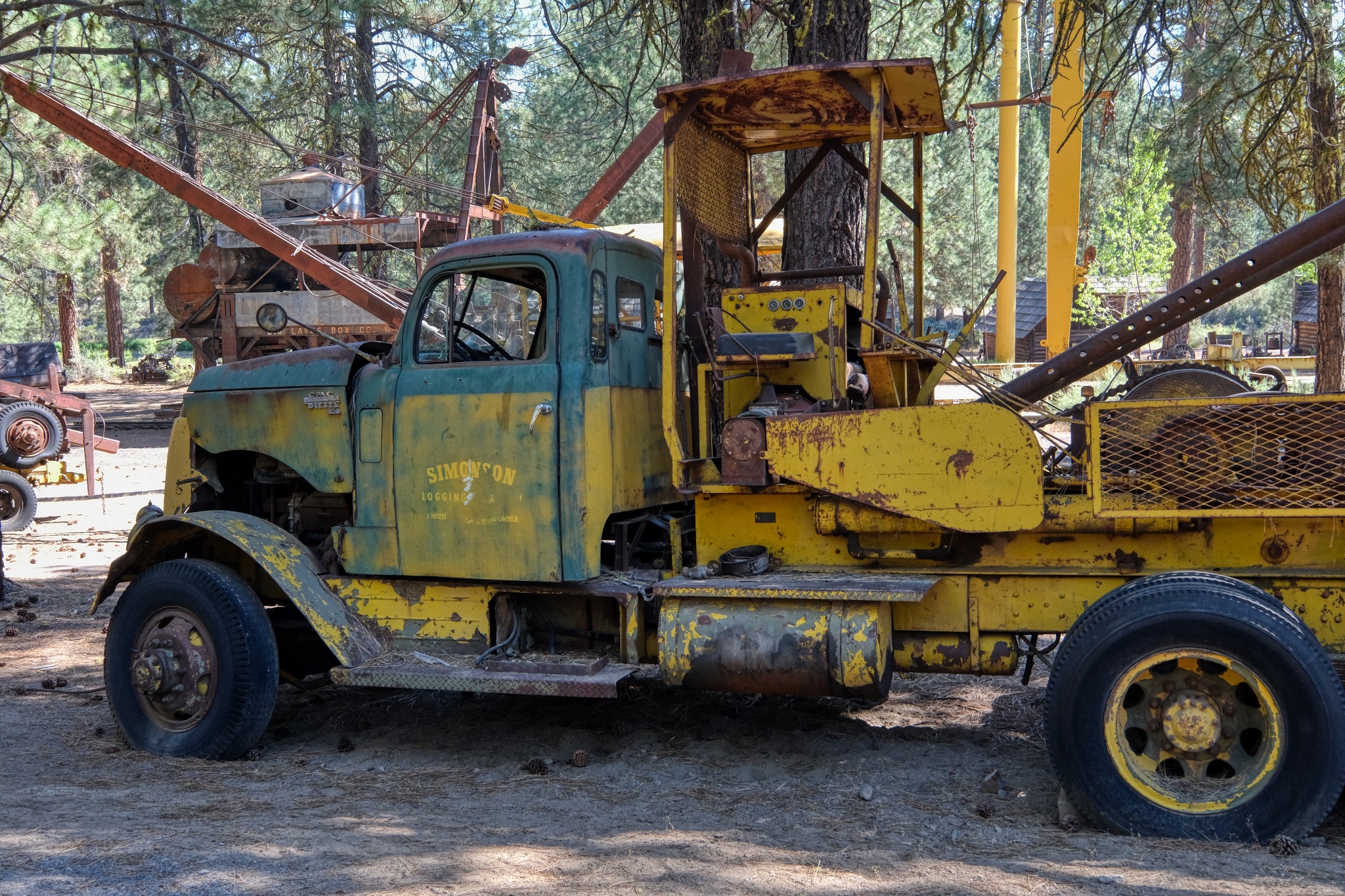 A well used high lead winch truck . . . Simpson Lumber Company.
A well used high lead winch truck . . . Simpson Lumber Company.
ONEY, CALIFORNIA
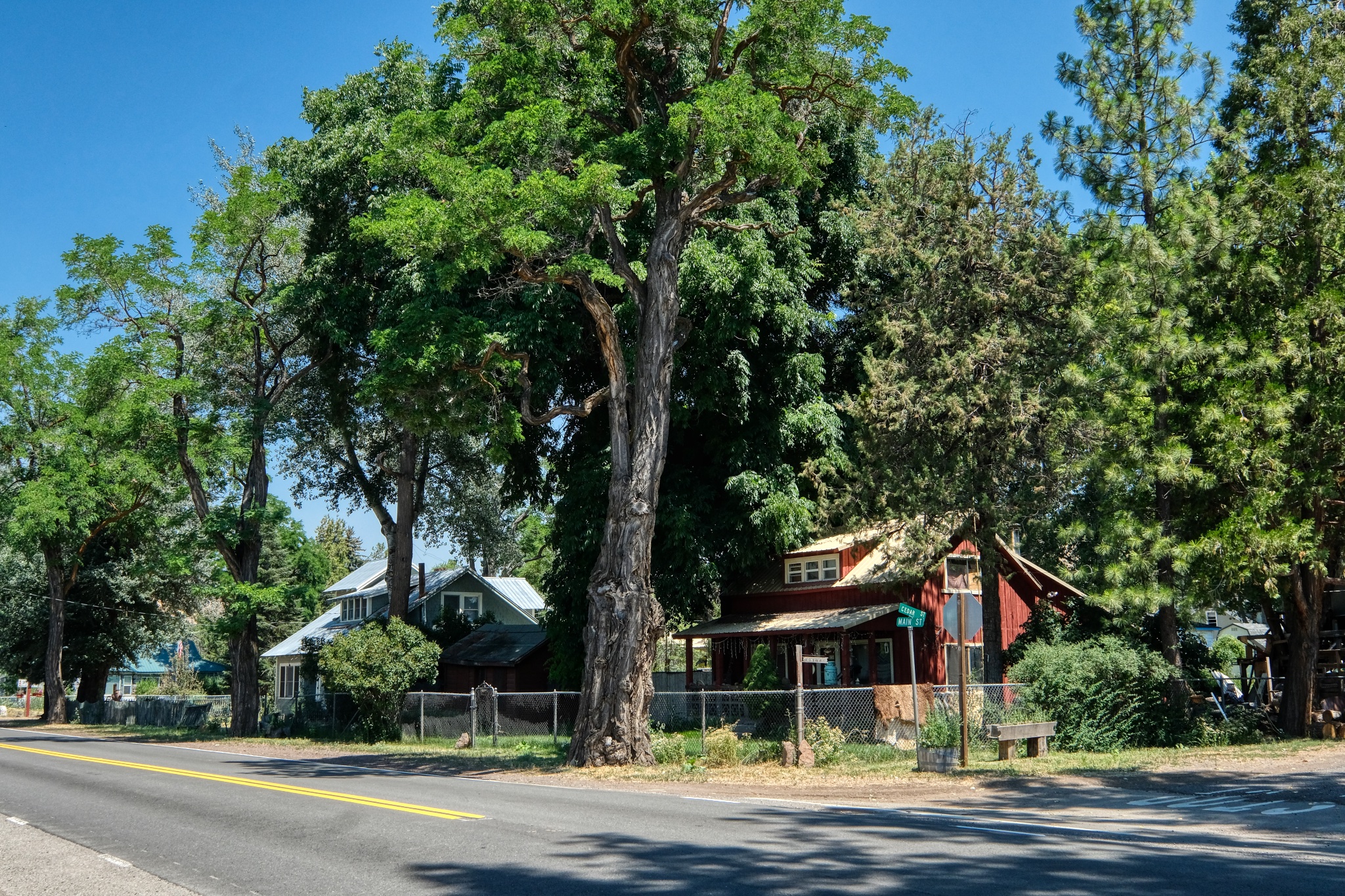 Located in the extreme northeast corner of California, Oney is a beautiful place . . . but the winters must be severe in such an isolated place.
Located in the extreme northeast corner of California, Oney is a beautiful place . . . but the winters must be severe in such an isolated place.
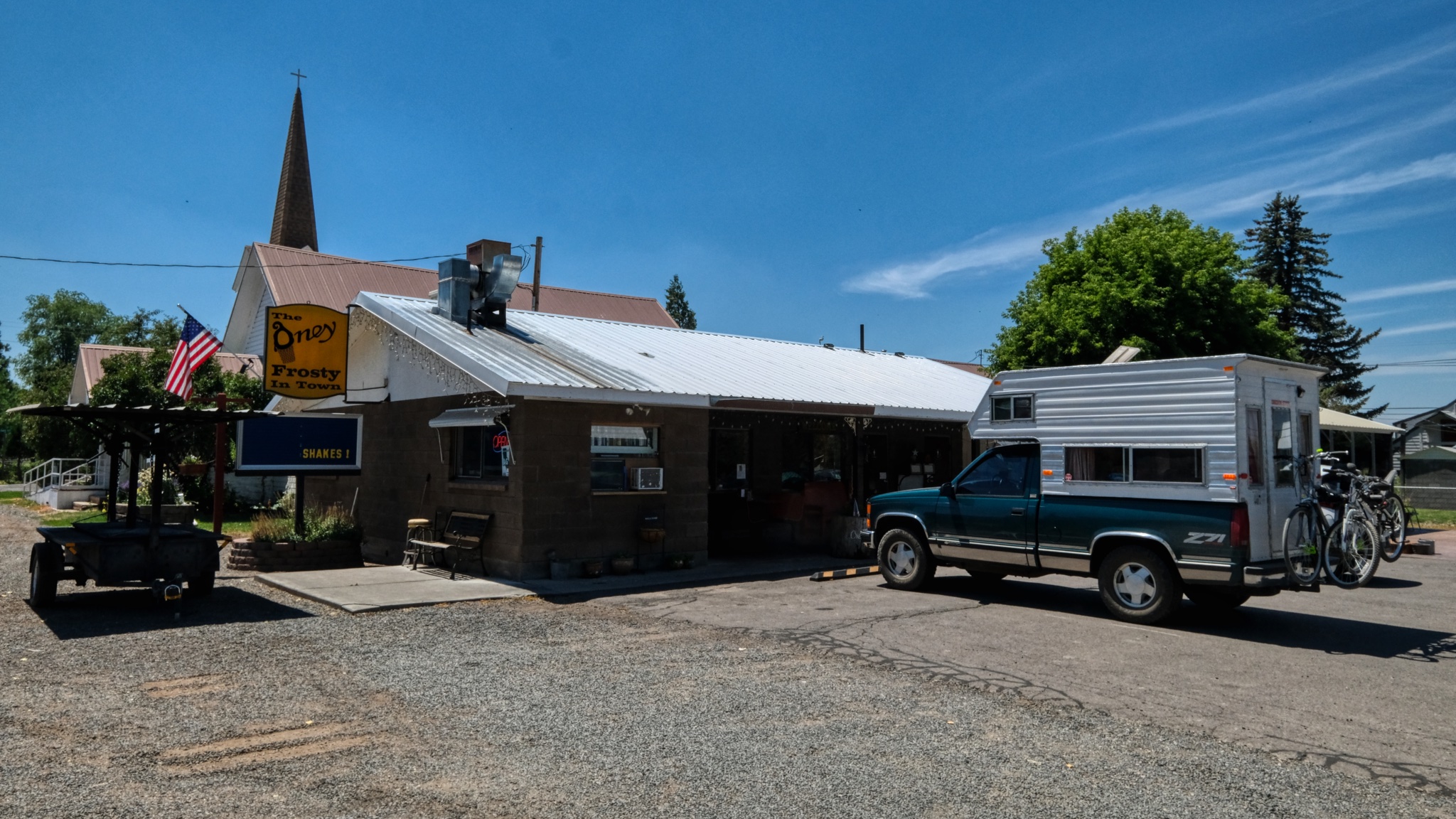 "The Oney Frosty In Town". -- in Oney, California. After driving a long stretch on winding two-lane mountain roads from Klamath Falls, Oregon, the Frosty was a welcome sight.
"The Oney Frosty In Town". -- in Oney, California. After driving a long stretch on winding two-lane mountain roads from Klamath Falls, Oregon, the Frosty was a welcome sight.
 I was not disappointed! The choices were pure Americana . . . and delicious.
I was not disappointed! The choices were pure Americana . . . and delicious.
 Dr. Jeff Harper
Dr. Jeff Harper
Unfortunately, the following year a major forest fire burned all around the Logging Museum . . . . but fortunately, only a few of the antique machines were damaged. The firefighters saved 90% of the collection!
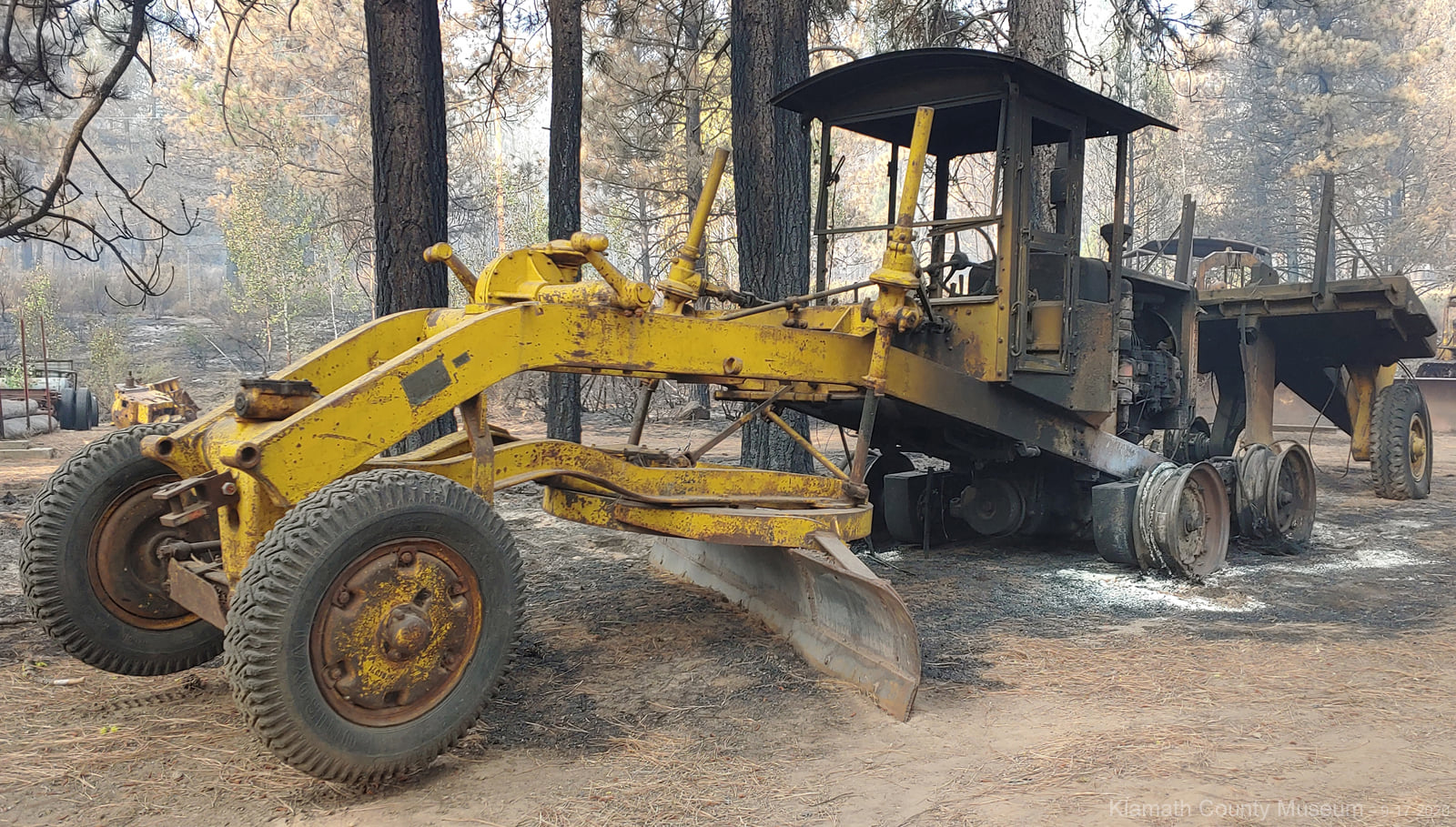
USA Road Trip: Old Country Store, Kewanee, Mississippi
 Thursday, January 27, 2022 at 6:31PM
Thursday, January 27, 2022 at 6:31PM 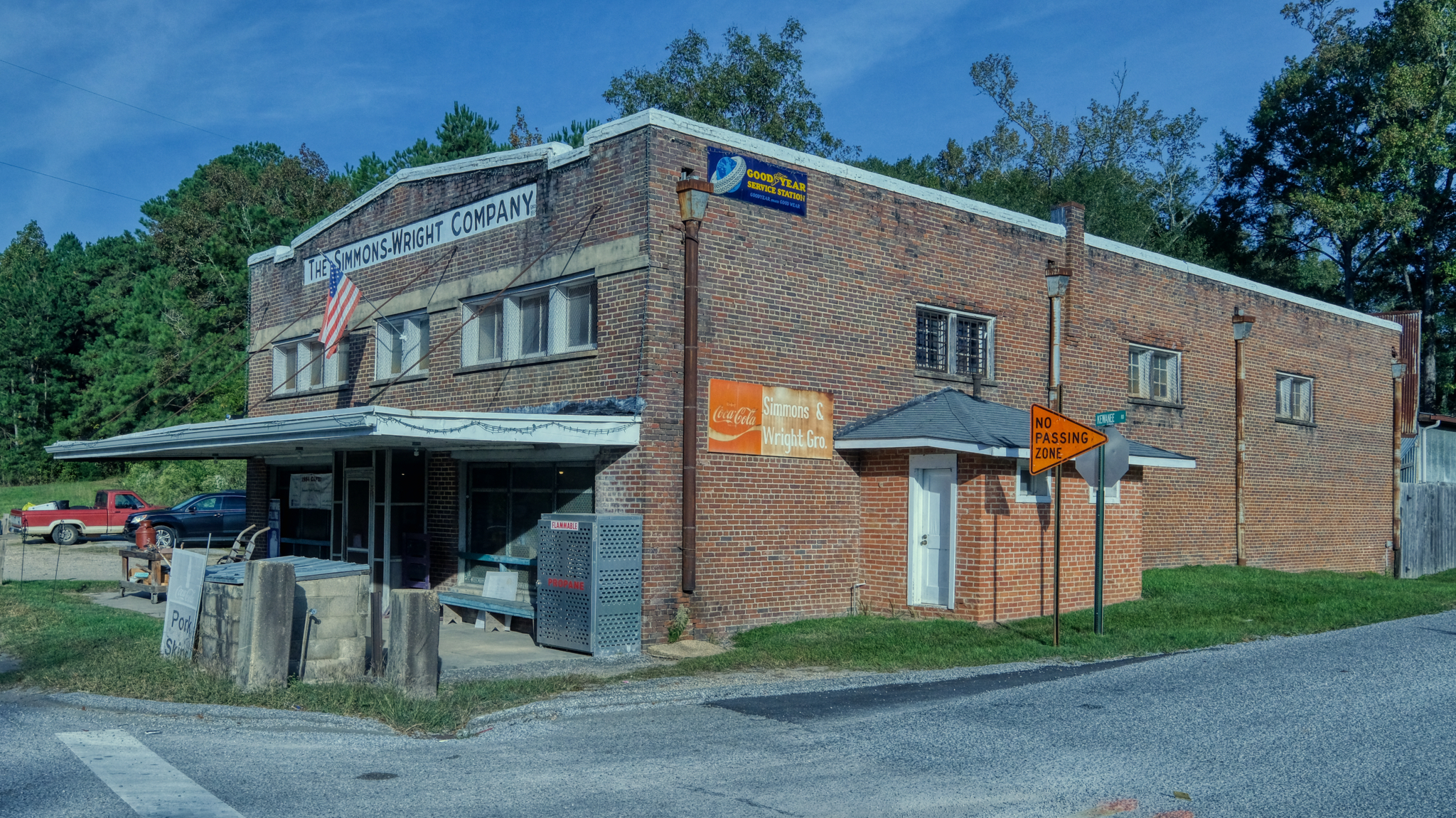 Just travelling along the highway from Leesville, Louisiana to Selma, Alabama, via Natchez, all the way across Mississippi with my friend Bud riding along, we pulled off on a side road to seek refreshment and saw this gem from an older America: The Simmons-Wright Company store.
Just travelling along the highway from Leesville, Louisiana to Selma, Alabama, via Natchez, all the way across Mississippi with my friend Bud riding along, we pulled off on a side road to seek refreshment and saw this gem from an older America: The Simmons-Wright Company store.
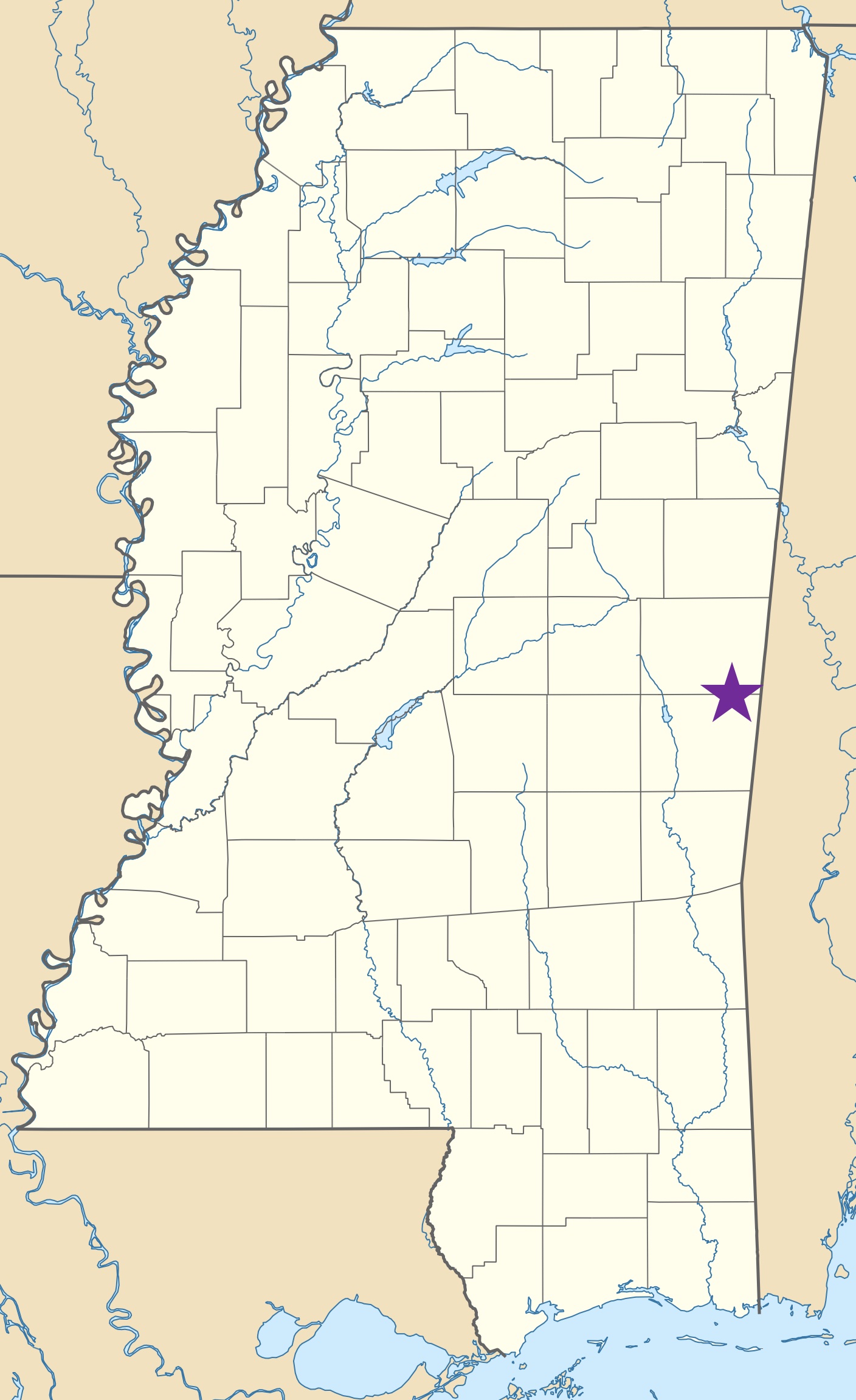 Only a mile or two before the Mississippi - Alabama state line.
Only a mile or two before the Mississippi - Alabama state line.
 The Simmons-Wright Company is a historic general store established in 1884 in Kewanee, Mississippi, a small town just outside Meridian in Lauderdale County. The building was listed on the National Register of Historic Places in 2008. It looked inviting, so we walked right in.
The Simmons-Wright Company is a historic general store established in 1884 in Kewanee, Mississippi, a small town just outside Meridian in Lauderdale County. The building was listed on the National Register of Historic Places in 2008. It looked inviting, so we walked right in.
 A peek through the dusty window before we entered foreshadowed the delights within!
A peek through the dusty window before we entered foreshadowed the delights within!
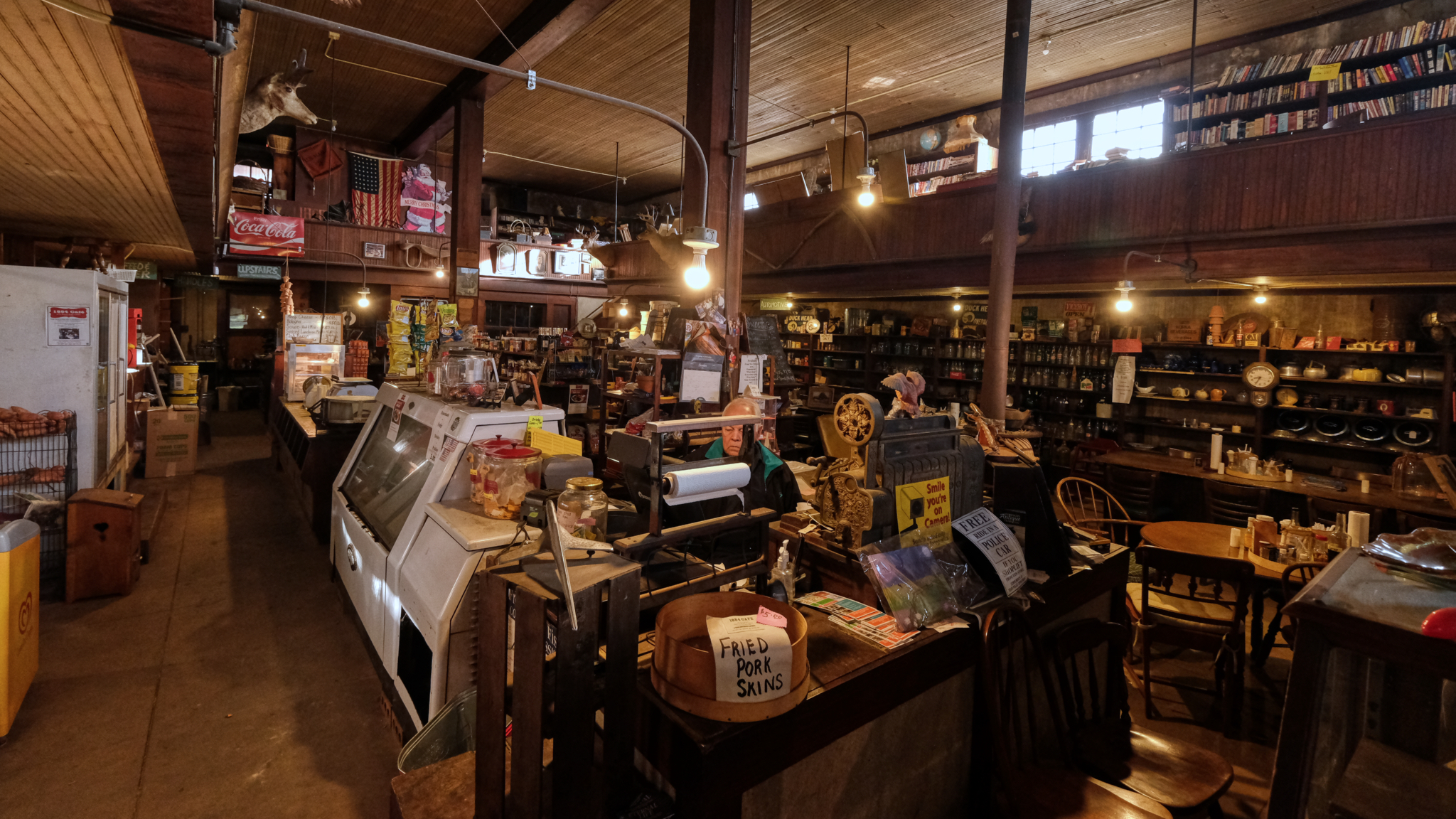 OMG! We walked in to find this time capsule of another era; the general store. I am old enough to remember these kinds of stores from my childhood living in The South, but never imagined one would have survived, intact from that time.
OMG! We walked in to find this time capsule of another era; the general store. I am old enough to remember these kinds of stores from my childhood living in The South, but never imagined one would have survived, intact from that time.
 All original store fittings, shelves, coolers . . . .
All original store fittings, shelves, coolers . . . .
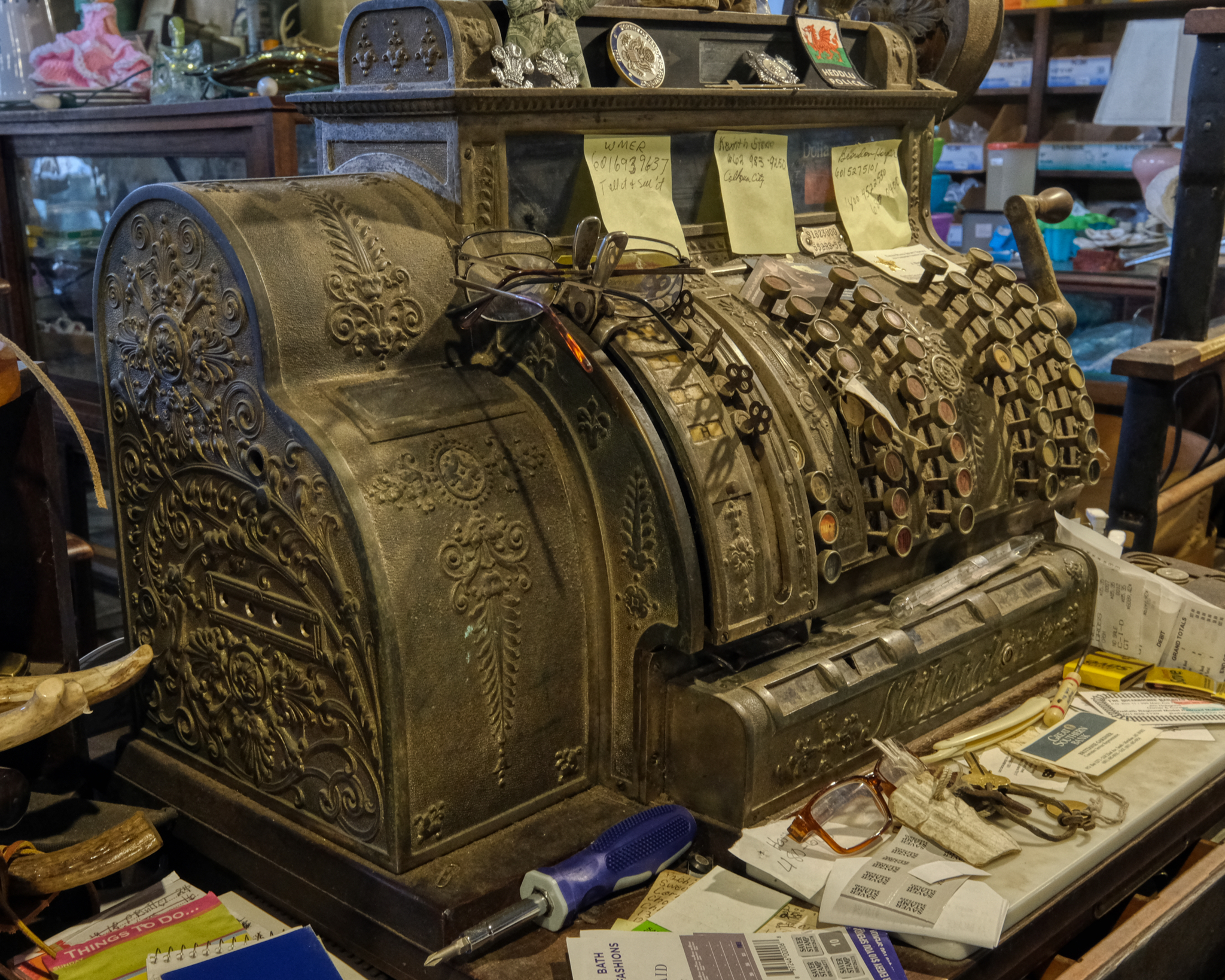 . . . there was even the 'origional' cash register. Amazing.
. . . there was even the 'origional' cash register. Amazing.
 The cash register was a masterful work of art from a bygone era. The mess around the store must have made it feel like a comfortable old shoe to the old man sitting behind the counter. He kept a good eye on us as we wondered around.
The cash register was a masterful work of art from a bygone era. The mess around the store must have made it feel like a comfortable old shoe to the old man sitting behind the counter. He kept a good eye on us as we wondered around.
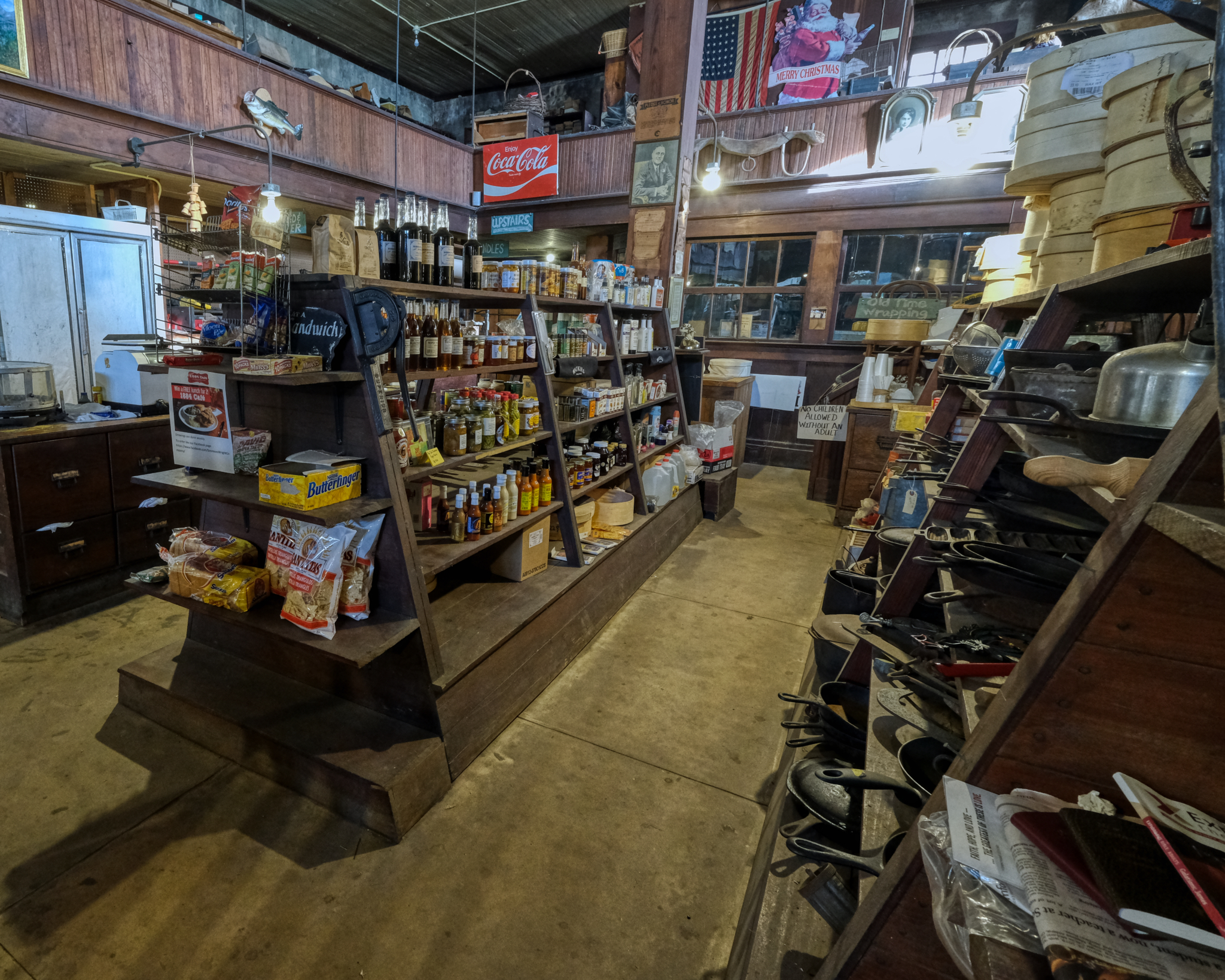 A little bit of everything a person might want to stop in and get on the way home from the mill job. I love the hand made "No Children Allowed Without An Adult" sign.
A little bit of everything a person might want to stop in and get on the way home from the mill job. I love the hand made "No Children Allowed Without An Adult" sign.
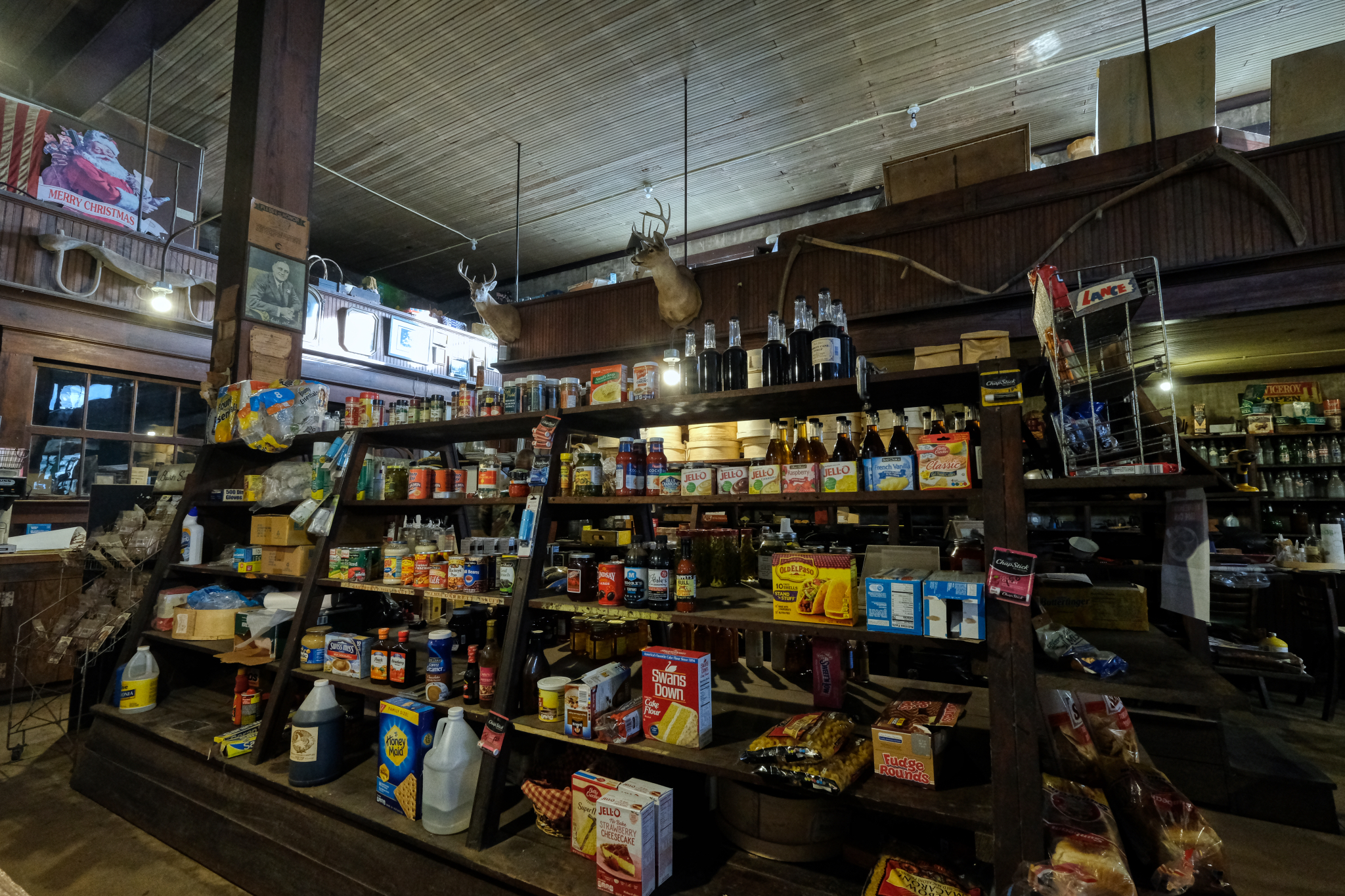 No computerized stock control here, no bar code scanning or shelf space earning ratios. You have to know your customers tastes. The array of food choices on offer speaks to the local cultural preferences.
No computerized stock control here, no bar code scanning or shelf space earning ratios. You have to know your customers tastes. The array of food choices on offer speaks to the local cultural preferences.
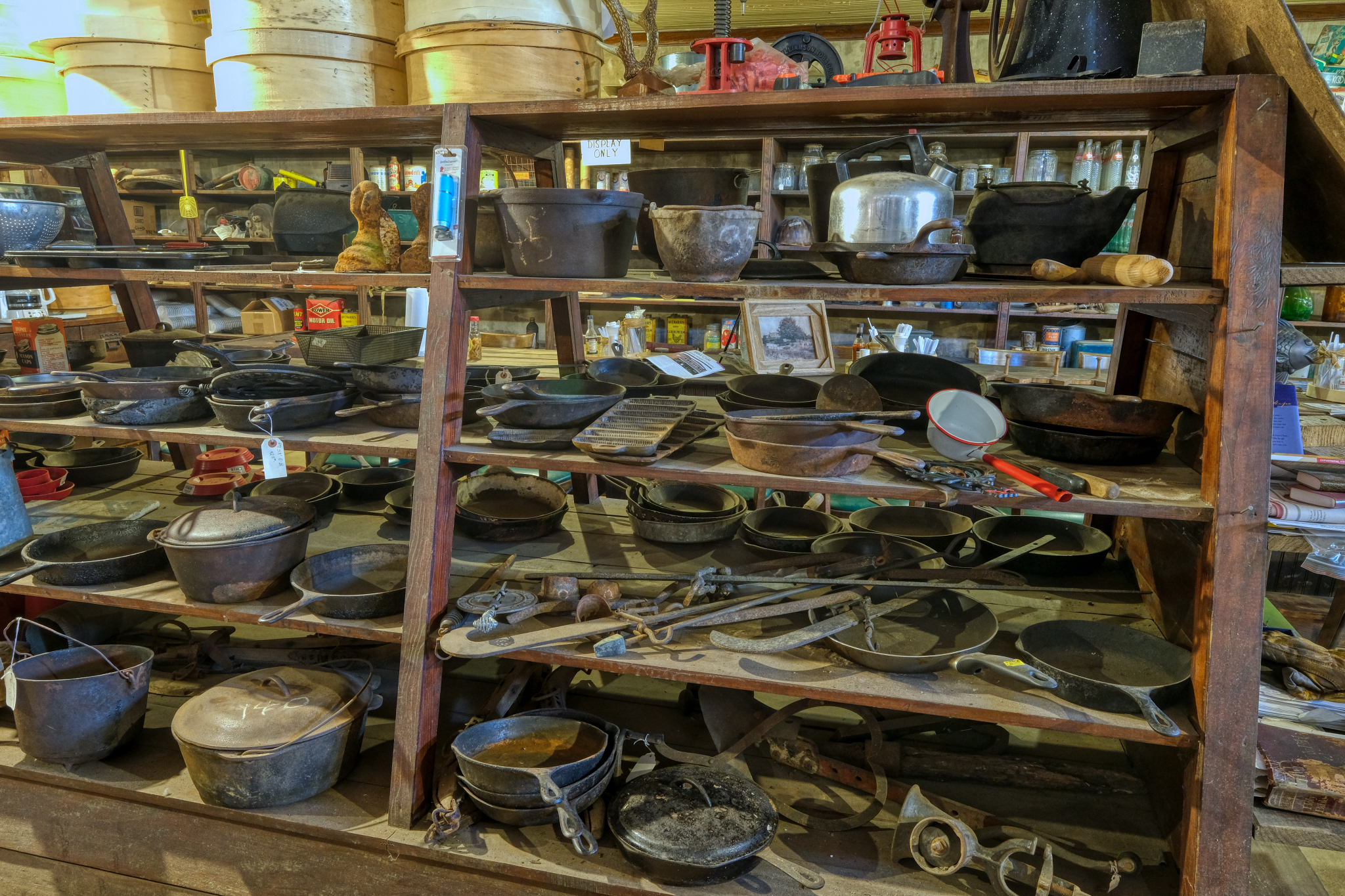 The dry goods isle was half merchandise and half museum display.
The dry goods isle was half merchandise and half museum display.
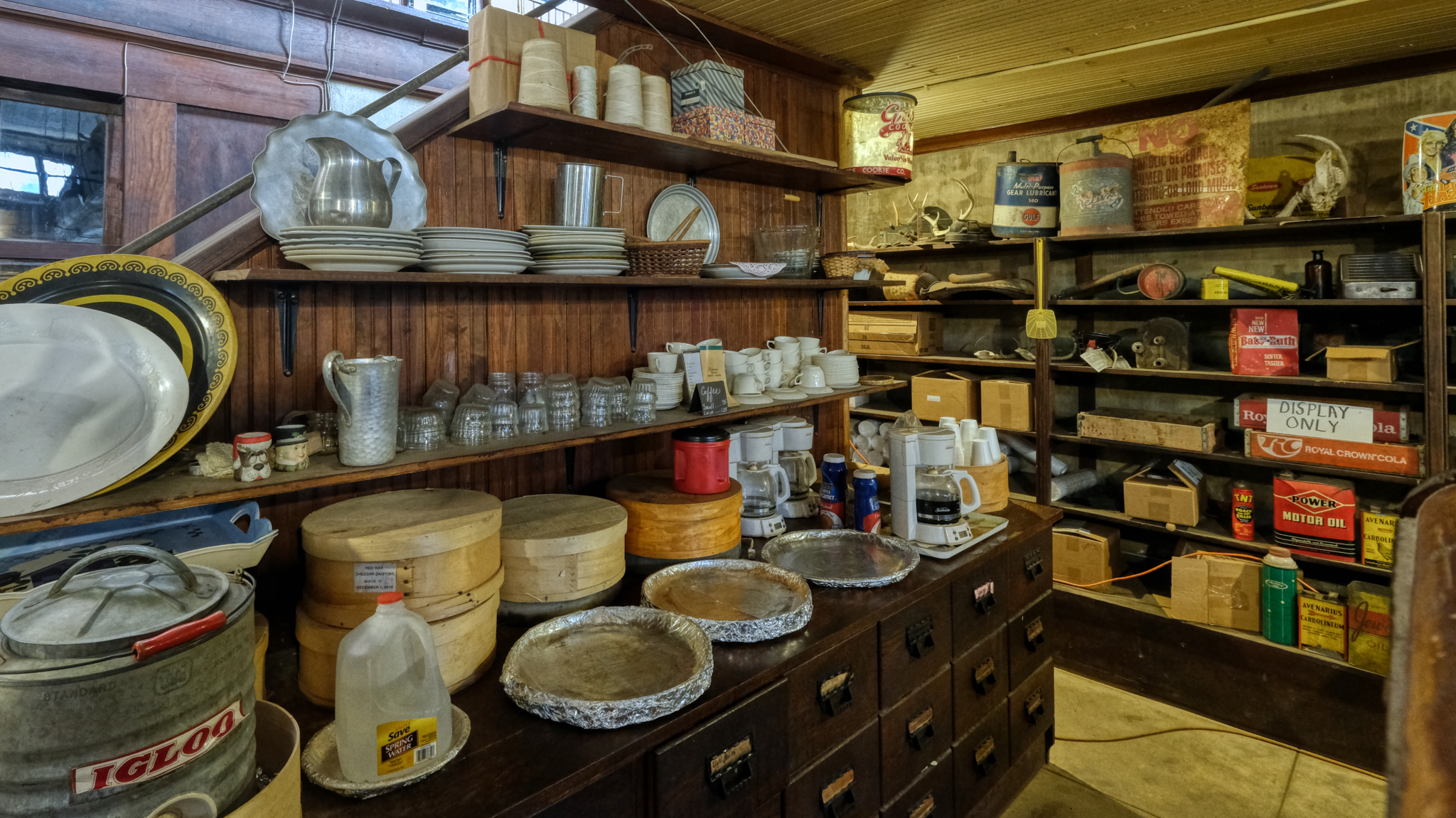 There was a small "kitchen" area in the back. Coffee, but it looked like we were either too late or too early for the cakes that go on the foil-covered trays.
There was a small "kitchen" area in the back. Coffee, but it looked like we were either too late or too early for the cakes that go on the foil-covered trays.
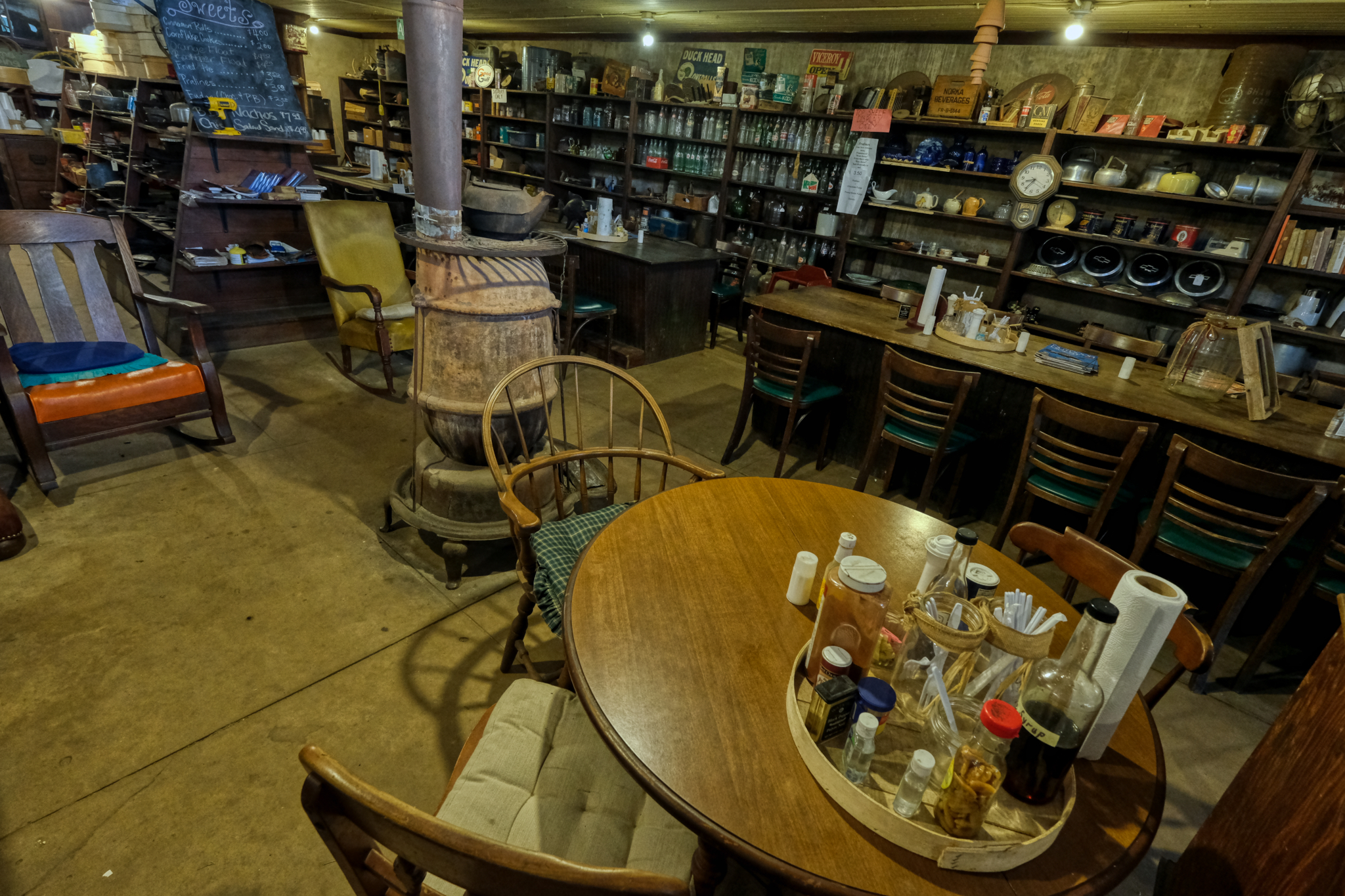 An inviting pot belly stove surrounded by the "eating area." I wondered if these seats filled up in the afternoon and evening with regulars who stop in to chat and for beer and snacks.
An inviting pot belly stove surrounded by the "eating area." I wondered if these seats filled up in the afternoon and evening with regulars who stop in to chat and for beer and snacks.
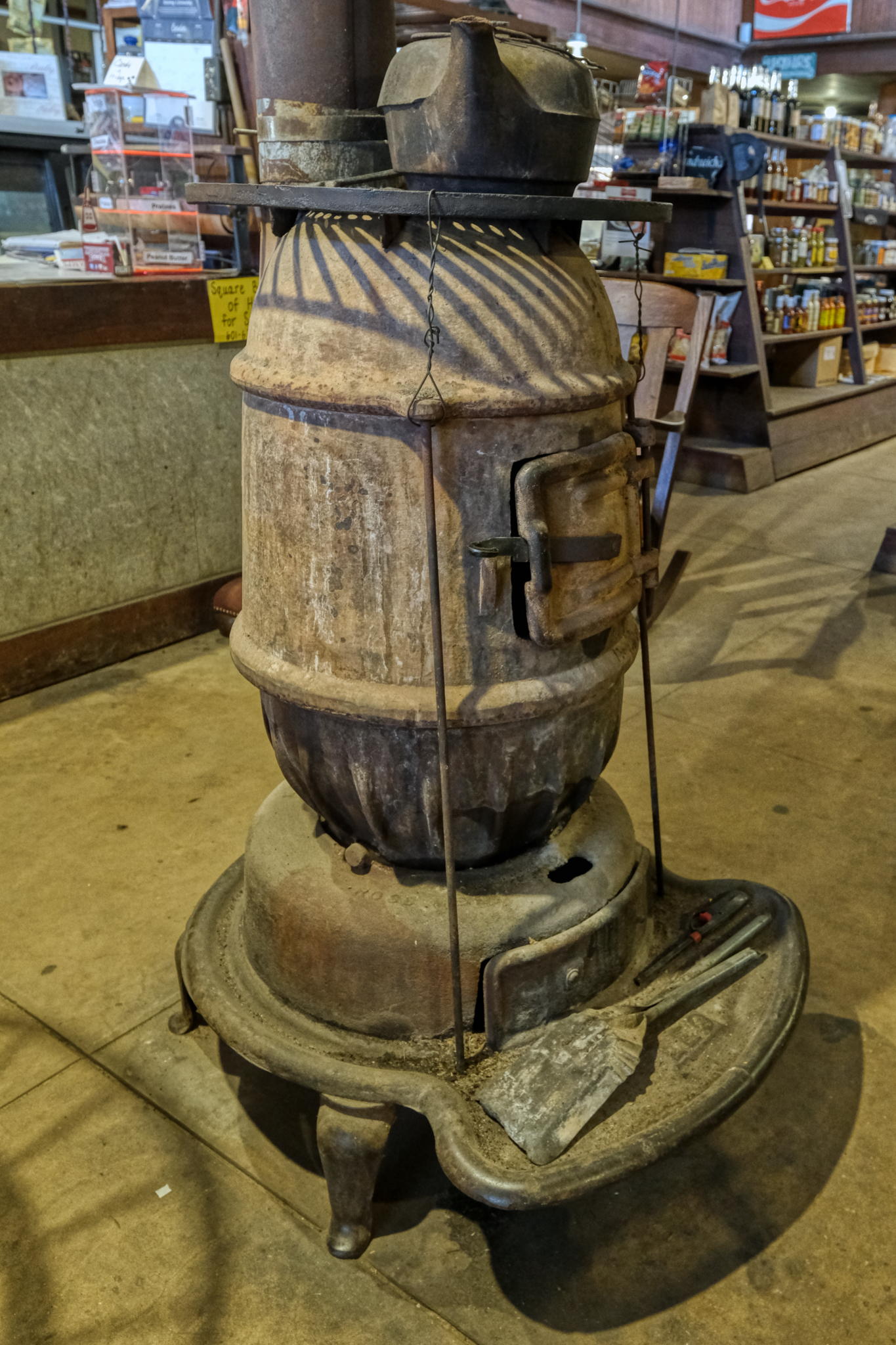 The pot belly stove was a work of art made of the patina of the passage of time.
The pot belly stove was a work of art made of the patina of the passage of time.
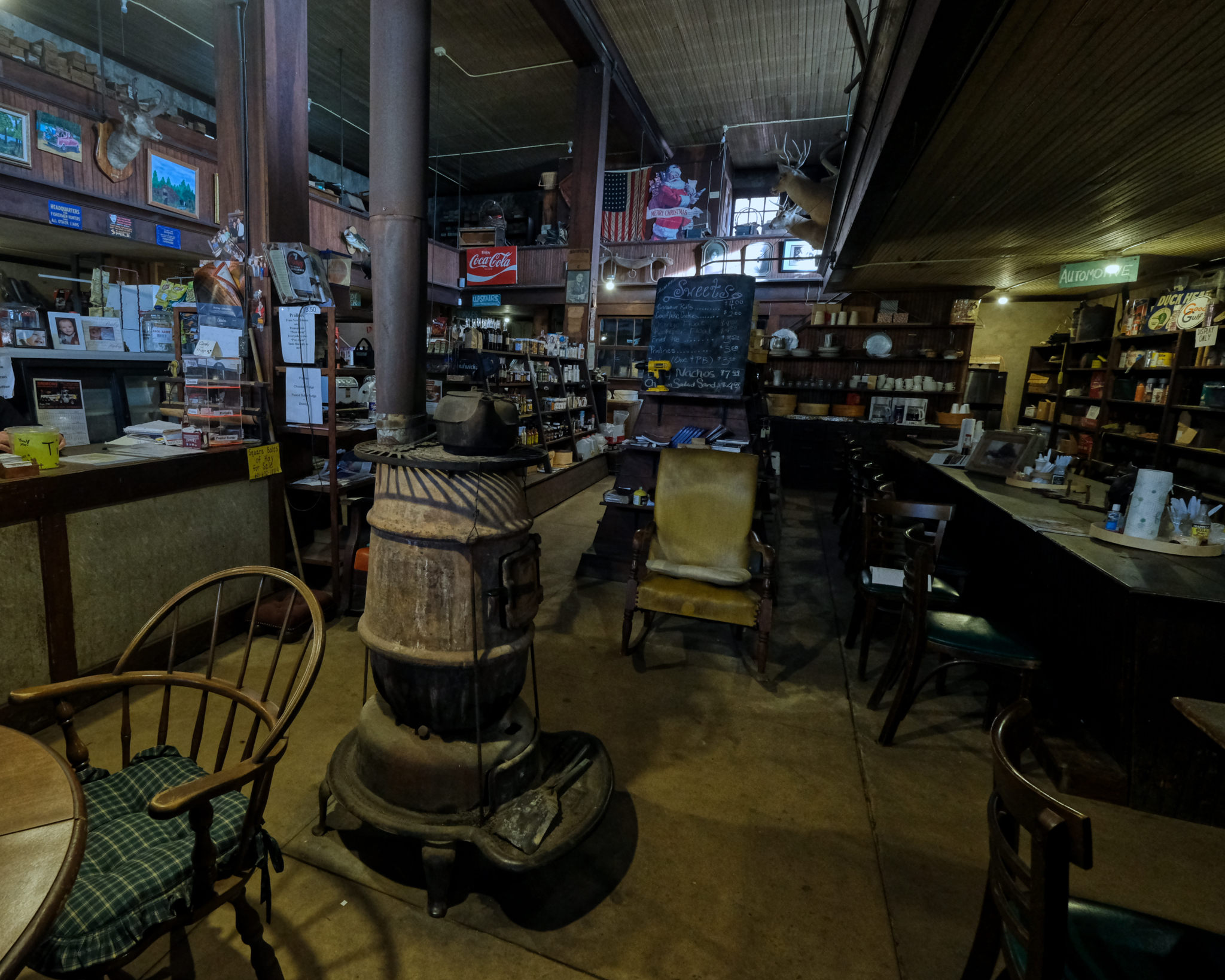 The pot belly stove stood in a place of prominence . . . in the center. It looked like it has been used right up into the present. It was early October, but not yet chilly in eastern Mississippi, so it had not been stoked on this day.
The pot belly stove stood in a place of prominence . . . in the center. It looked like it has been used right up into the present. It was early October, but not yet chilly in eastern Mississippi, so it had not been stoked on this day.
 The long side wall was was reserved for the "display only" shelving.
The long side wall was was reserved for the "display only" shelving.
 I walked around the old store in big loops taking photos and being stunned by the disheveled beauty of this space.
I walked around the old store in big loops taking photos and being stunned by the disheveled beauty of this space.
 I hadn't seen or heard him enter, but at some point an old African American man came in and made himself at home. He and the proprietor exchanged some friendly conversation in low, almost silent tones.
I hadn't seen or heard him enter, but at some point an old African American man came in and made himself at home. He and the proprietor exchanged some friendly conversation in low, almost silent tones.
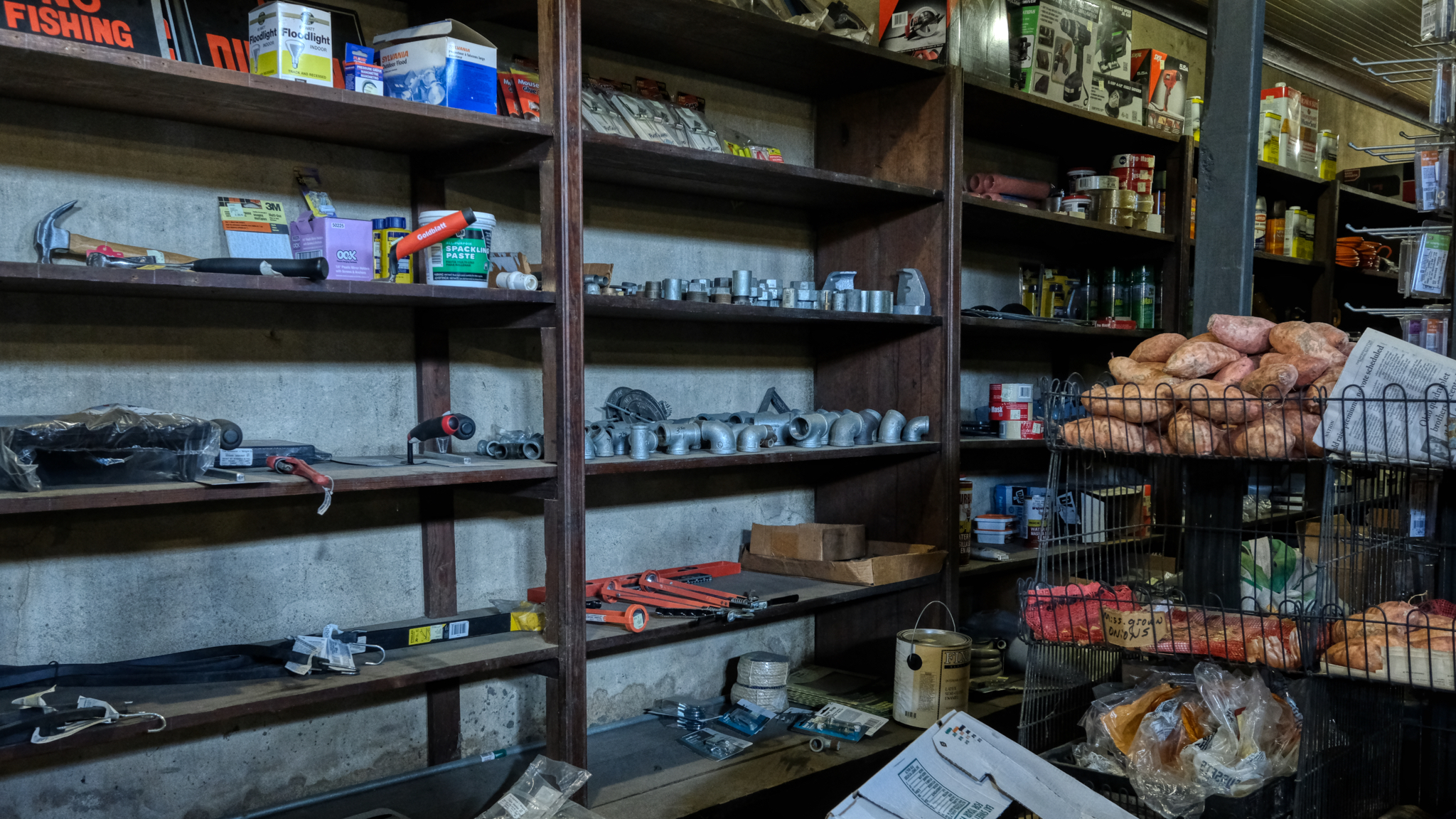 An "array of mixed plumbing supplies" and sweet potatoes.
An "array of mixed plumbing supplies" and sweet potatoes.
 "May I take some photos out back," I asked. "Go right ahead," he replied as he pointed to this door next to the nail bins.
"May I take some photos out back," I asked. "Go right ahead," he replied as he pointed to this door next to the nail bins.
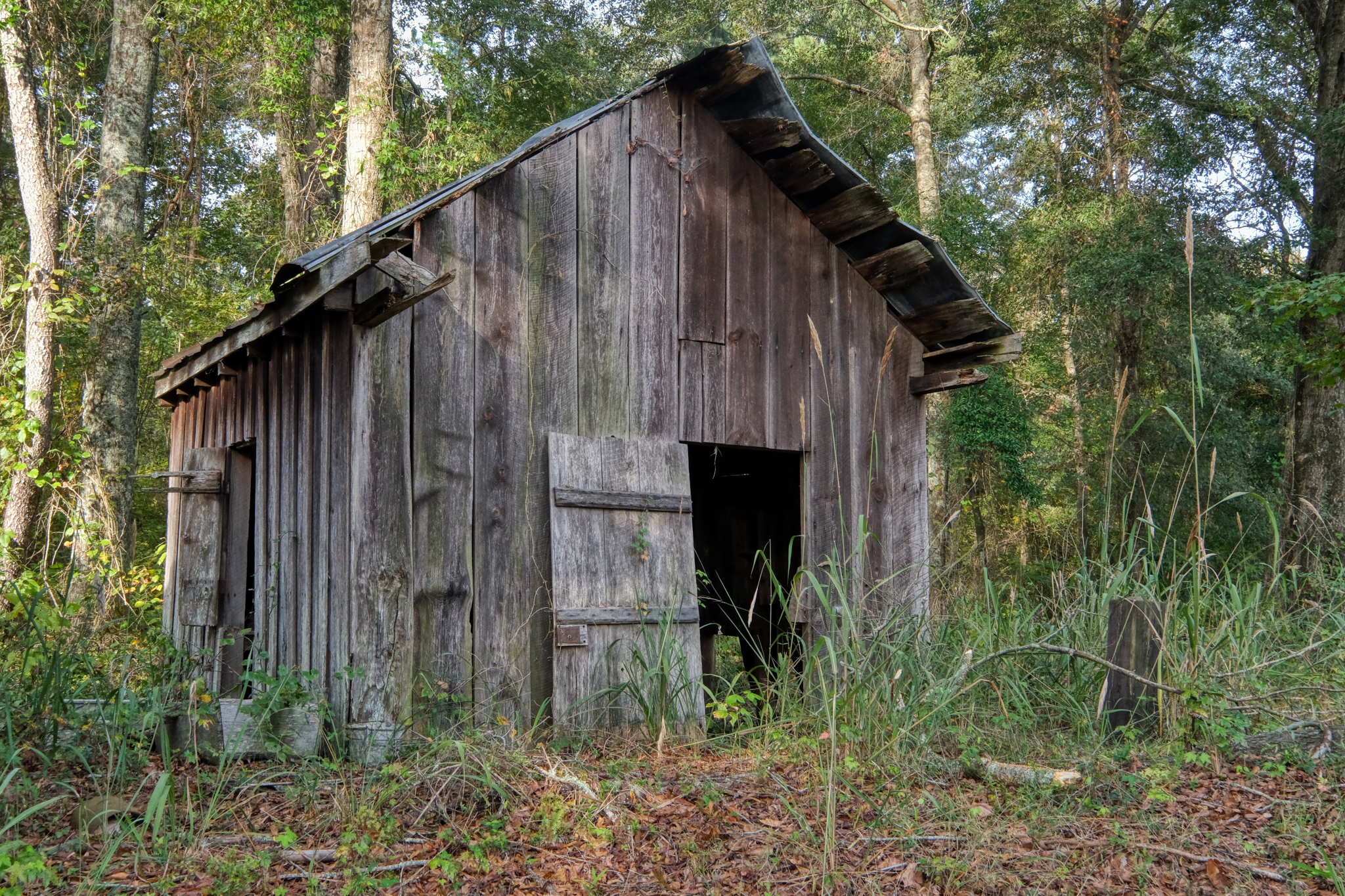 Nice. A fine old, weathered back yard shed.
Nice. A fine old, weathered back yard shed.
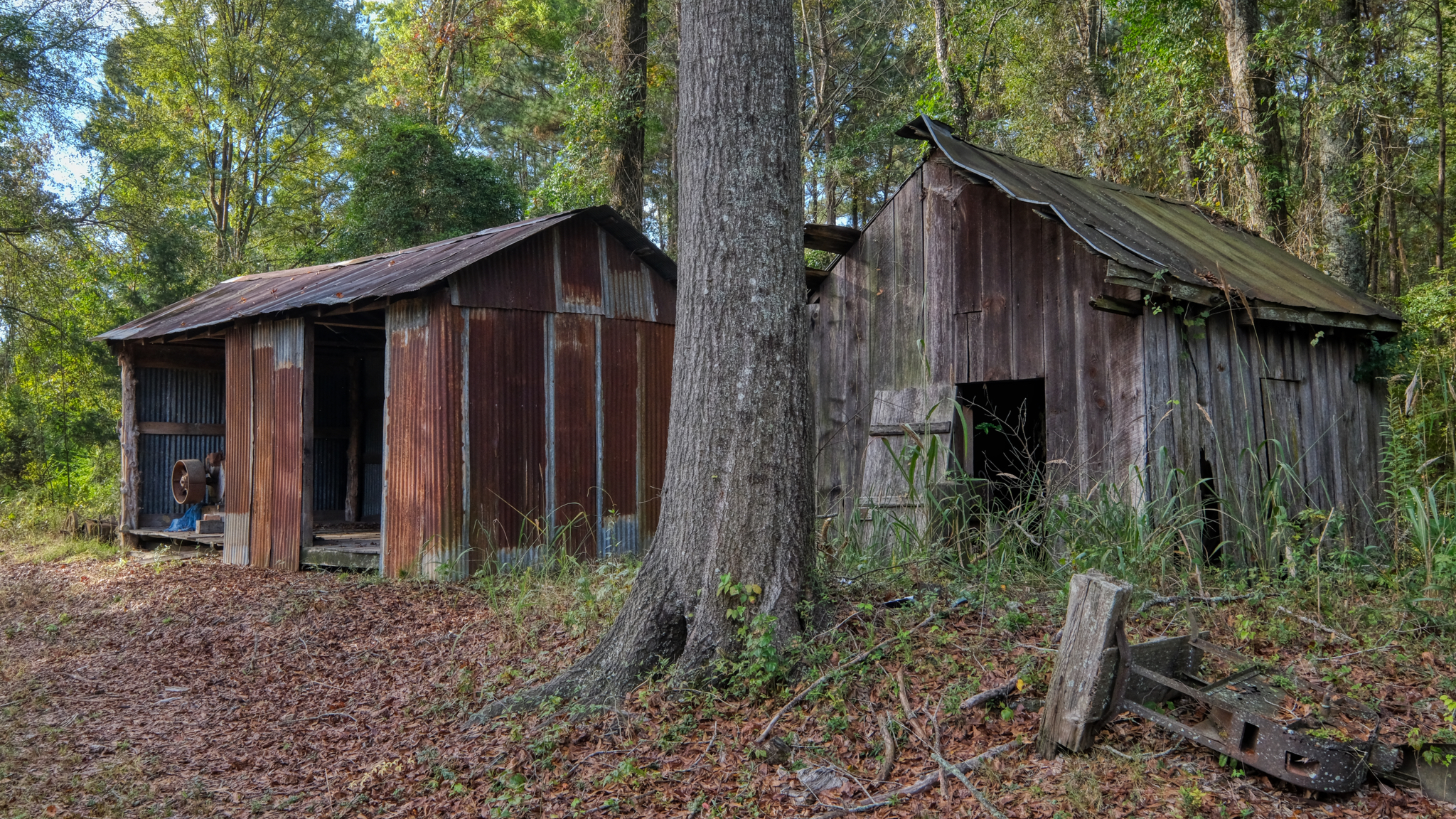 I love old rusted corrugation . . . I live for dilapidation and rusted corrugation . . .
I love old rusted corrugation . . . I live for dilapidation and rusted corrugation . . .
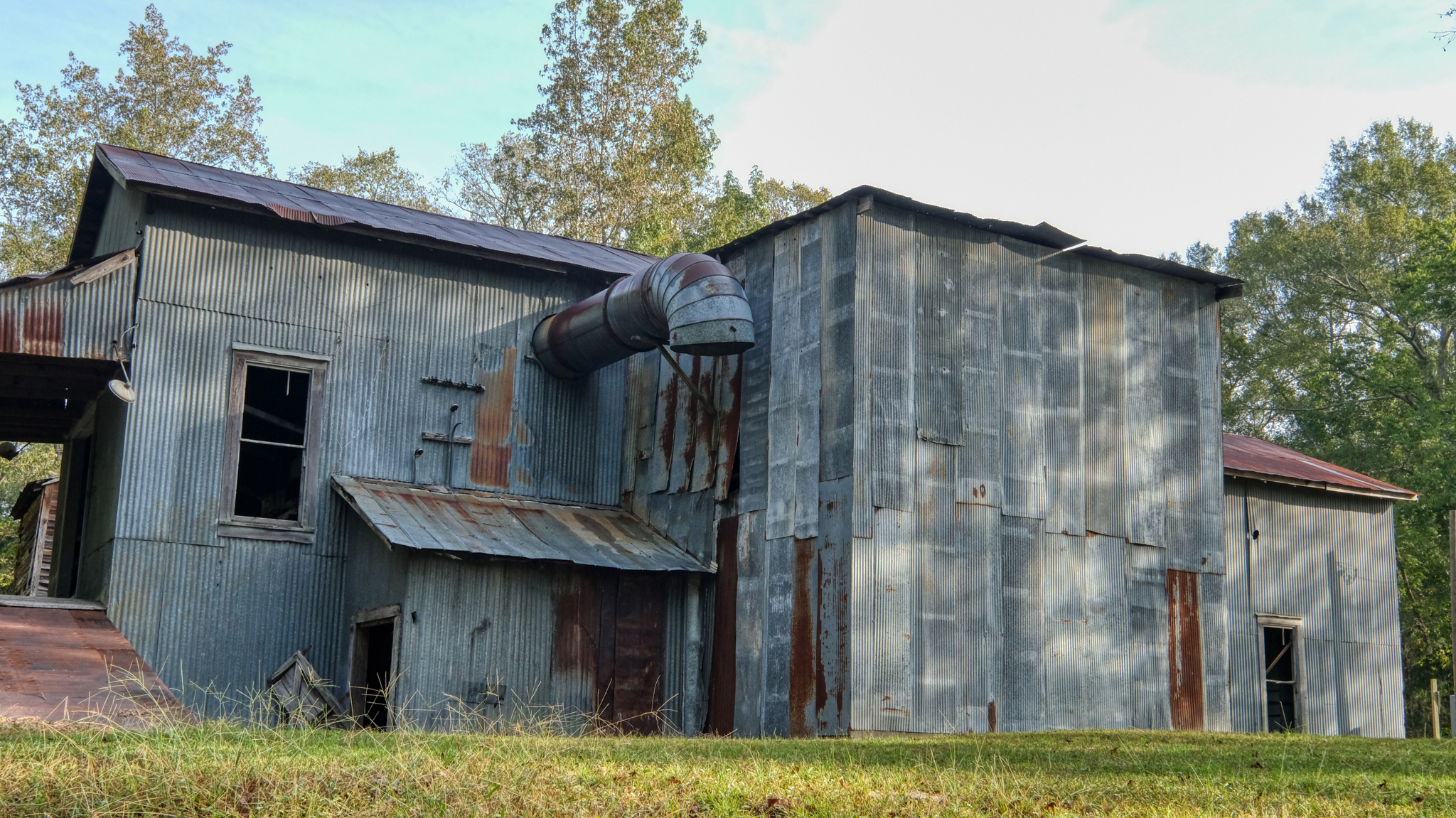 There was also an old "mill" of some kind behind the store. I decided to snoop around a little. An absolutely gorgeous corrugated building.
There was also an old "mill" of some kind behind the store. I decided to snoop around a little. An absolutely gorgeous corrugated building.
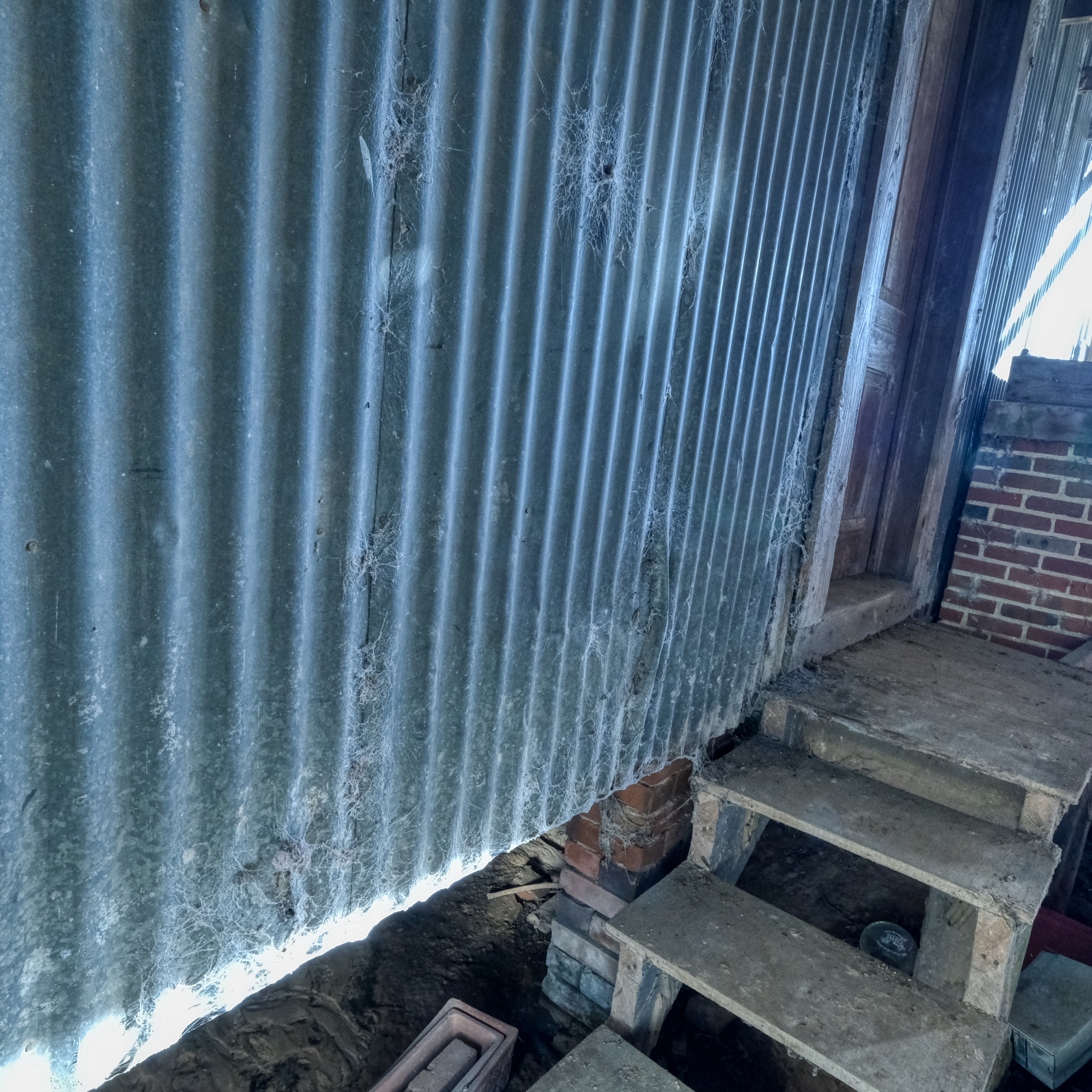 This door to the mill was locked . . . but what a photo!
This door to the mill was locked . . . but what a photo!
 This door was locked from the inside.
This door was locked from the inside.
 This image! The things in this photo were made, manufactured, built, and assembled by somebody working somewhere at some real time and place in the past. That cart was made for the purpose of moving around more than one man can hold at once. It is also a tool of work . . . it was the focus of labor for some person as a part of their paid employment, day after day.
This image! The things in this photo were made, manufactured, built, and assembled by somebody working somewhere at some real time and place in the past. That cart was made for the purpose of moving around more than one man can hold at once. It is also a tool of work . . . it was the focus of labor for some person as a part of their paid employment, day after day.
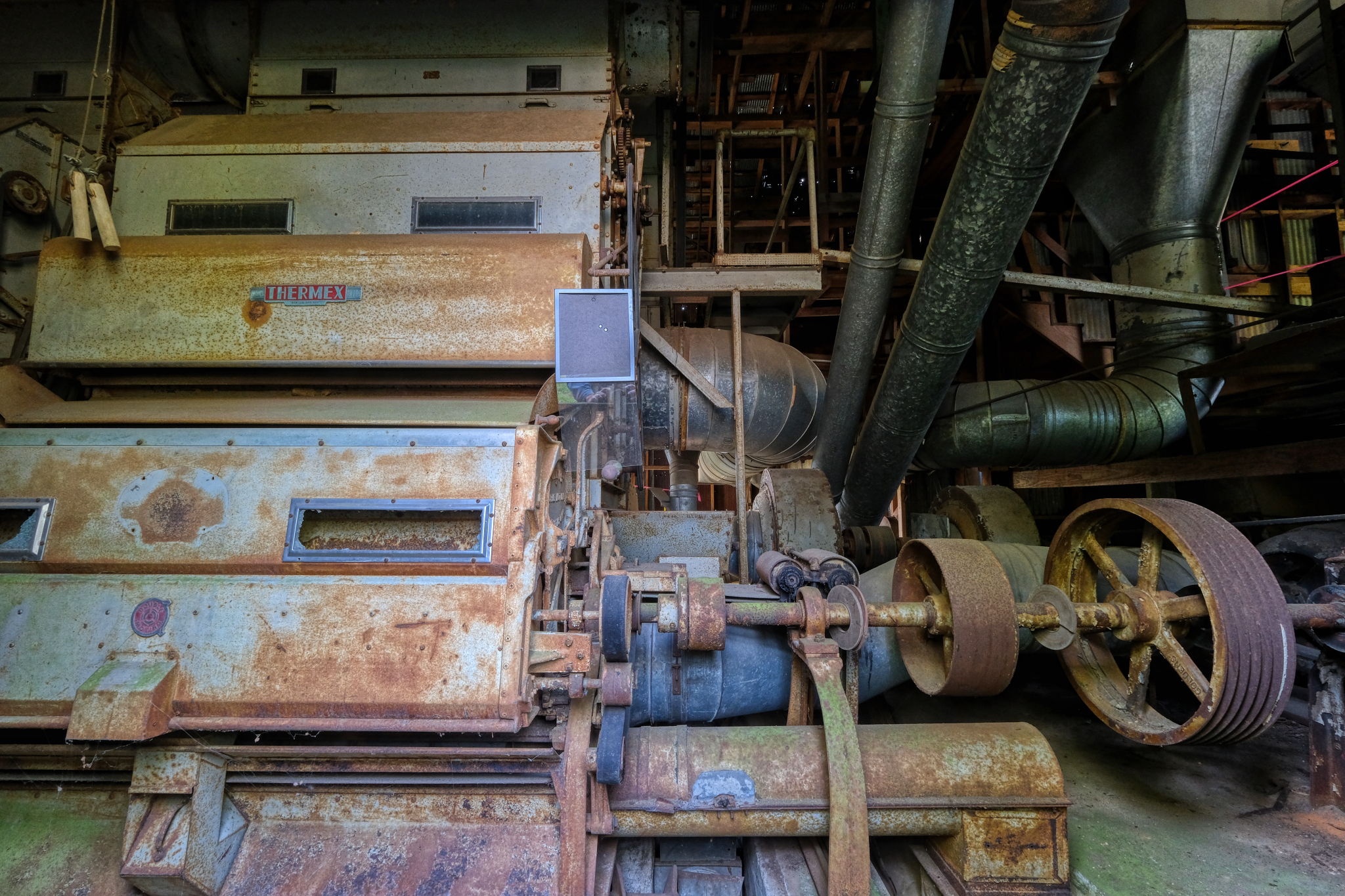 At last I found a large opened door on the side of the mill. This machinery was inside . . . I snooped around more inside, but for the life of me, I could not figure out what this machinery was used for. I even did a Google search . . . my guess was that it was a corn grinding operation at some time in the past.
At last I found a large opened door on the side of the mill. This machinery was inside . . . I snooped around more inside, but for the life of me, I could not figure out what this machinery was used for. I even did a Google search . . . my guess was that it was a corn grinding operation at some time in the past.
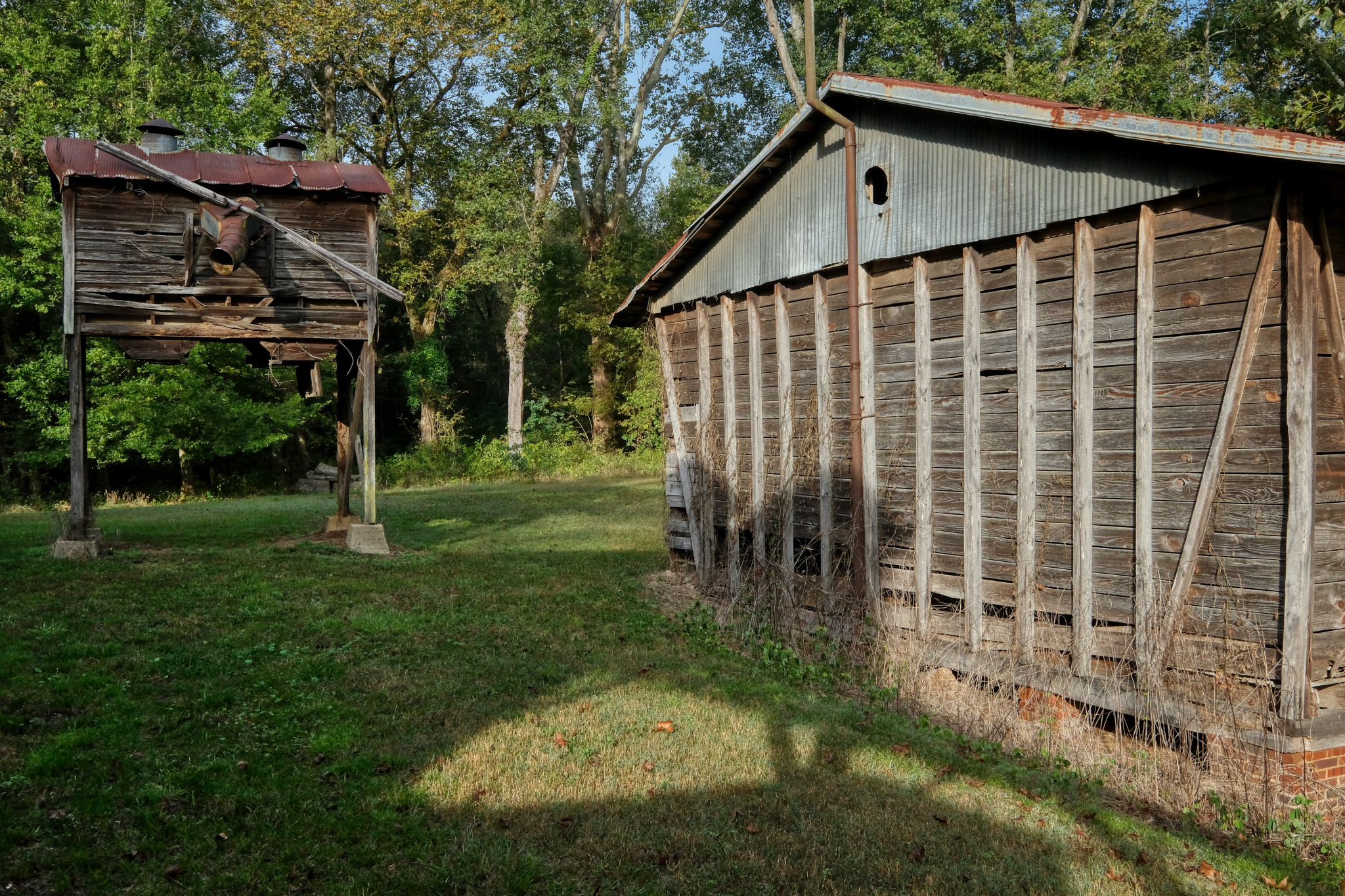 These structures next to the mill were hints as to the purpose of the mill. One looks like a 'corn crib,' but I am not sure.
These structures next to the mill were hints as to the purpose of the mill. One looks like a 'corn crib,' but I am not sure.
 Was ground corn meal blown up into this hopper for loading into trucks or barrels? I don't know, but I loved the aged patina of the weathered wood . . .
Was ground corn meal blown up into this hopper for loading into trucks or barrels? I don't know, but I loved the aged patina of the weathered wood . . .
 The sun broke through a thin cloud cover and the light became wonderful.
The sun broke through a thin cloud cover and the light became wonderful.
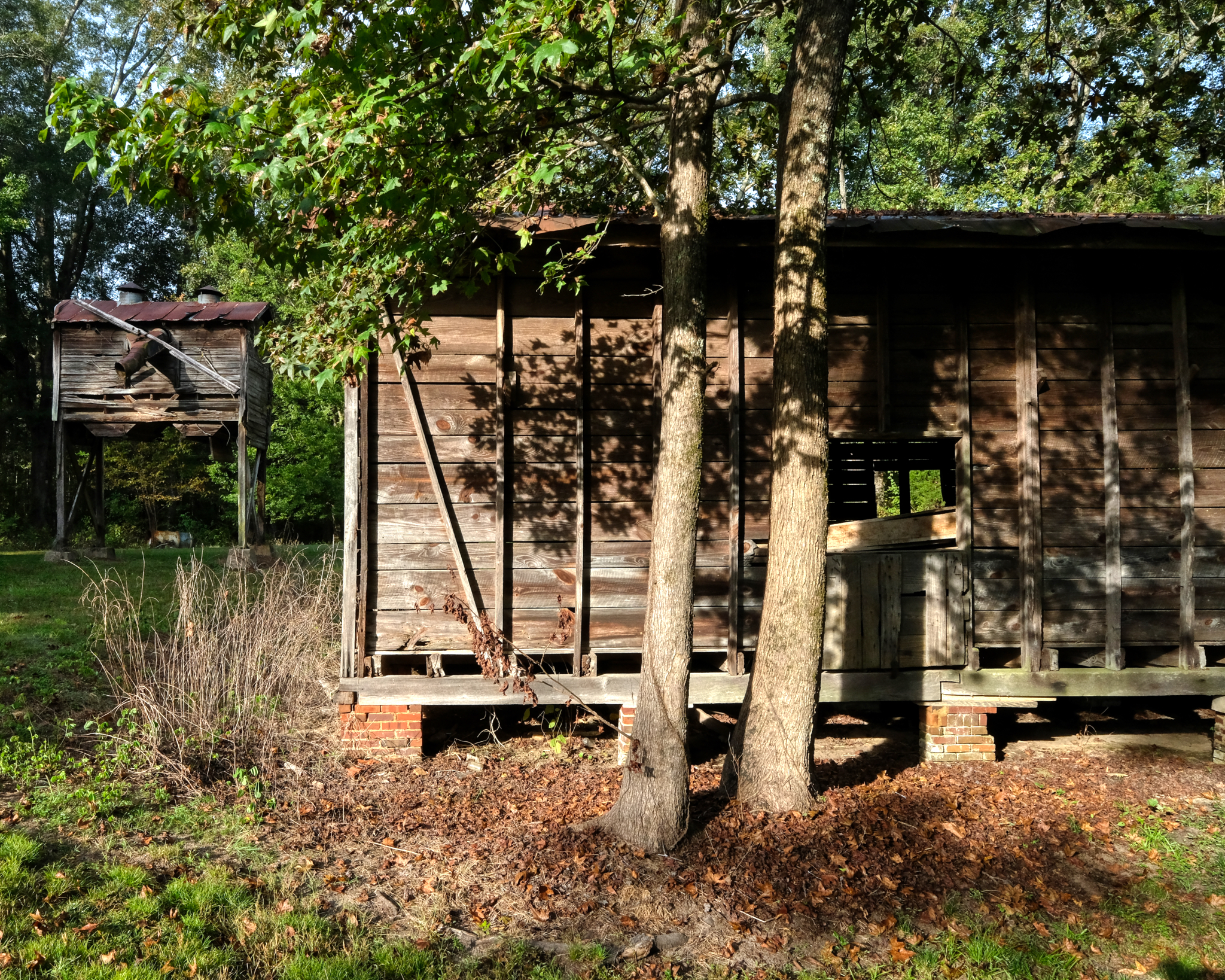 Perhaps rooms for the hired seasonal mill workers?
Perhaps rooms for the hired seasonal mill workers?
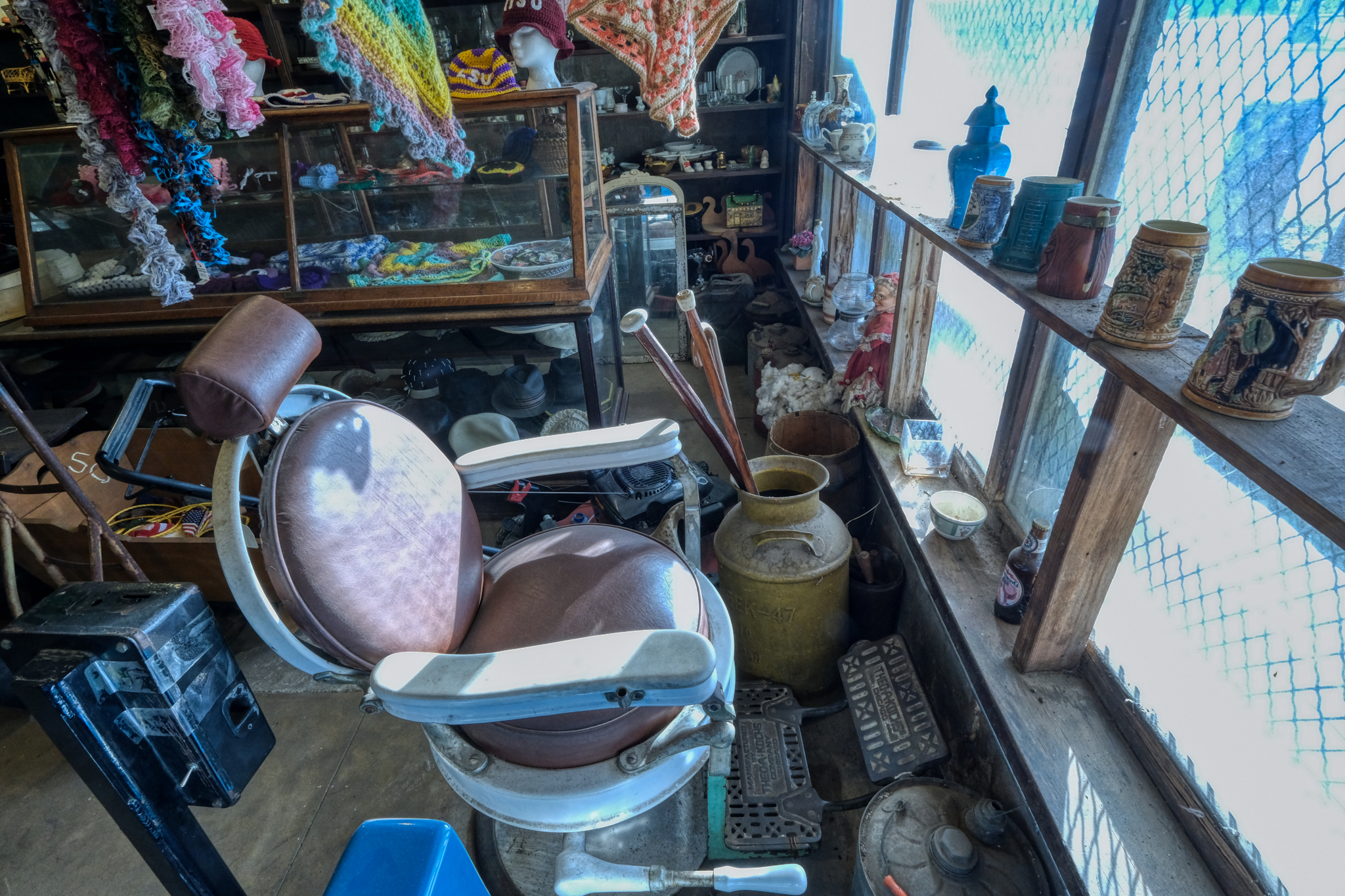 I hadn't noticed this barber chair on the way in . . . but . . . I could have spent all day in that old country store and its outbuildings . . . but Bud and I had to hit the road. We were heading for a place of great historical significance; Selma, Alabama, a place I have always wanted to make a pilgrimage.
I hadn't noticed this barber chair on the way in . . . but . . . I could have spent all day in that old country store and its outbuildings . . . but Bud and I had to hit the road. We were heading for a place of great historical significance; Selma, Alabama, a place I have always wanted to make a pilgrimage.
USA Road Trip: Moab & Dead Horse Point, Utah
 Tuesday, May 11, 2021 at 6:21PM
Tuesday, May 11, 2021 at 6:21PM 
My year-long USA camper road trip/sabbatical continued on from Winslow, Arizona to Moab, Utah. Early October 2018.
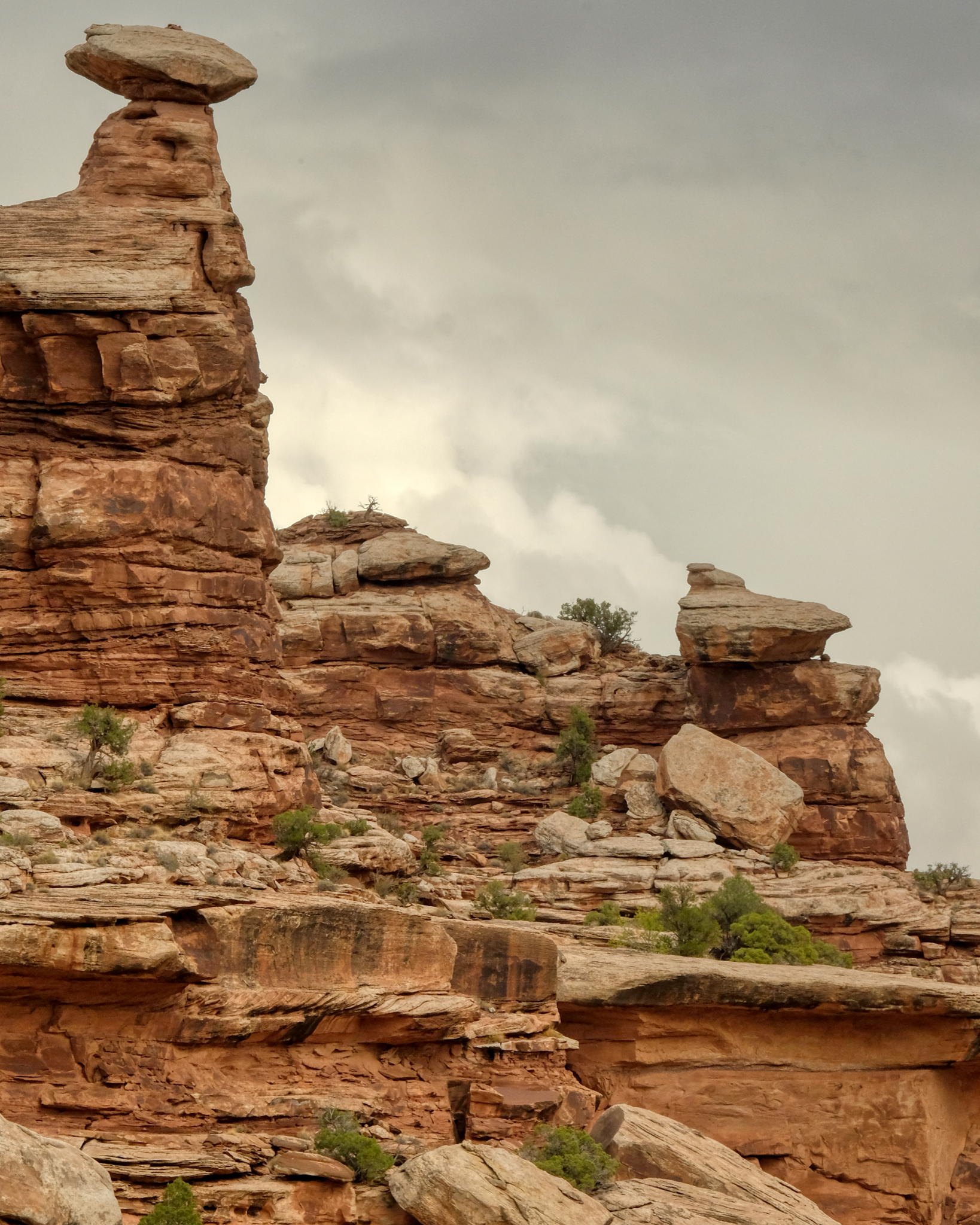 Rain. Yes, it rains in the desert.
Rain. Yes, it rains in the desert.
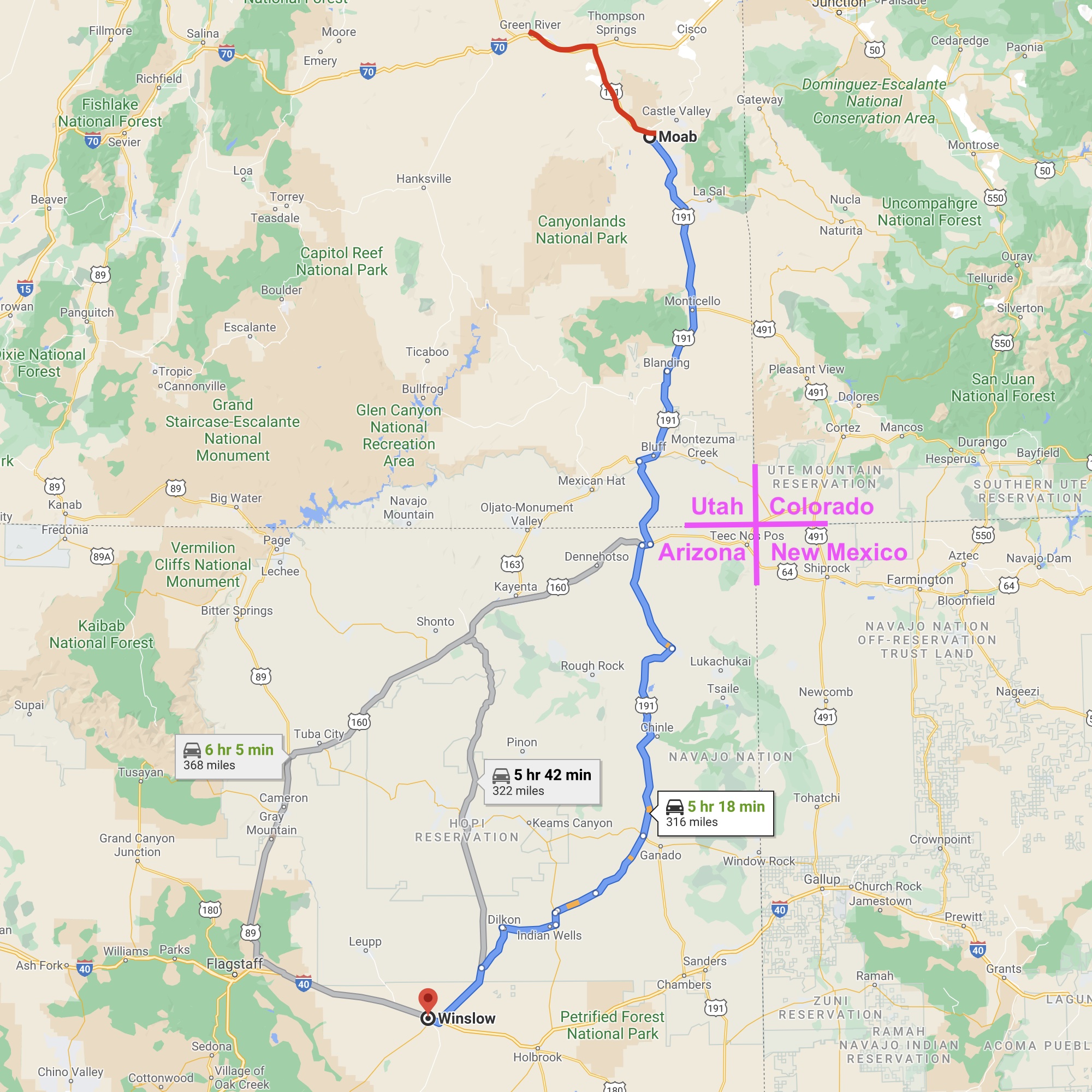
After an all day drive from Winslow, Arizona - through beautiful desert country in the Four Corners area of the American Southwest, I arrived in Moab, Utah in the middle of a major rain storm . . . record rain and a danger of flash flooding. I wanted to stay a night in a motel rather than in my camper . . . dry and warm. I Googled motels in Moab, looked up quite a few: all expensive and showing FULL . . . but one . . .
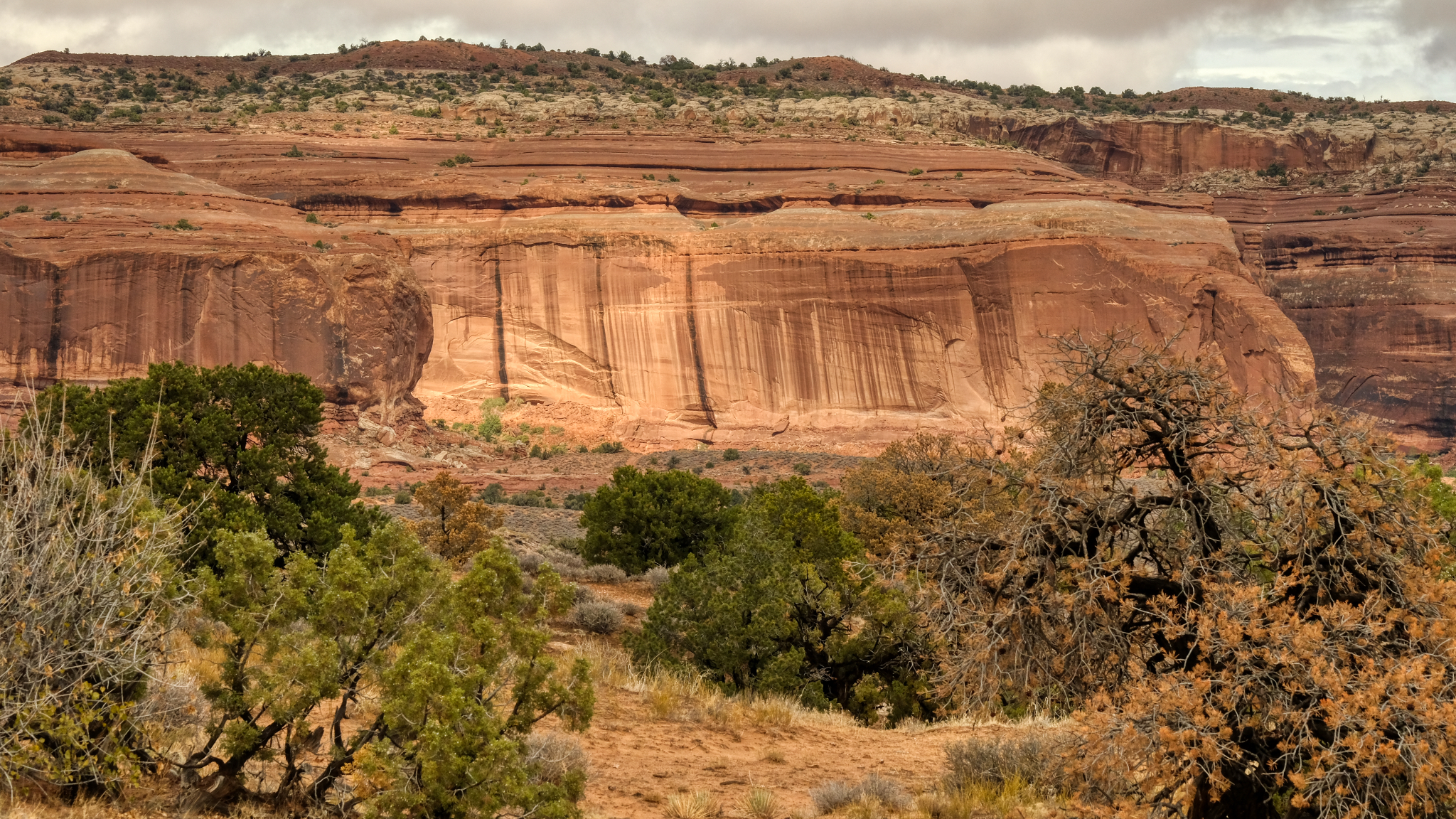 As I neared the town of Moab the rain increased, streaking the red cliffs.
As I neared the town of Moab the rain increased, streaking the red cliffs.
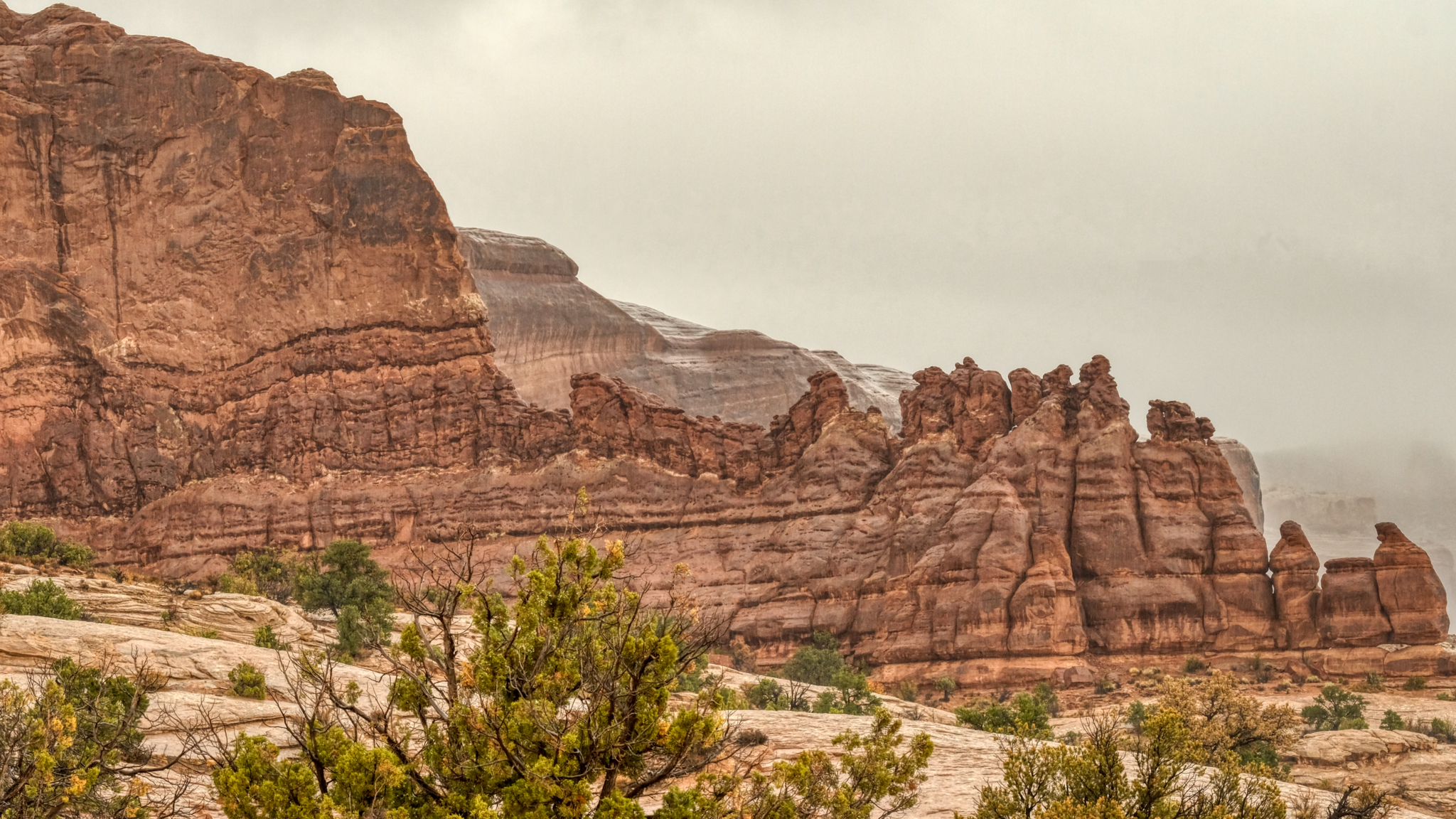 The red rock formations got wetter and wetter as I approached Moab.
The red rock formations got wetter and wetter as I approached Moab.
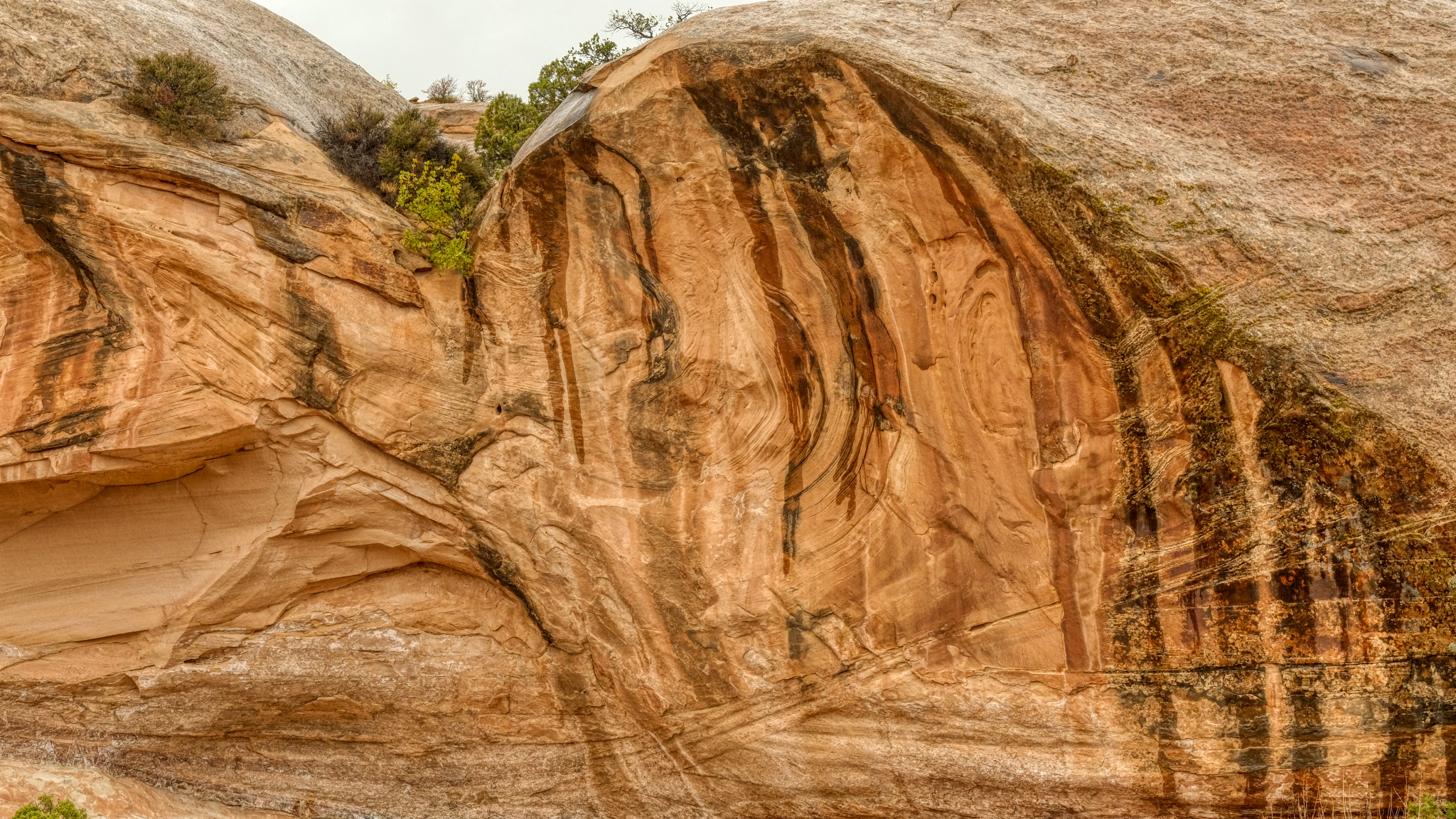 I discovered desert rock formations become even more fascinating when they are wet.
I discovered desert rock formations become even more fascinating when they are wet.
 And the rain continued to come down harder and harder. When I arrived at the only motel showing vacancies in Moab, I found out that the last room had just been taken, but I could come back the next day and stay for two nights. I booked it and went up the highway for 51 miles to Green River, Utah, on Interstate 70 where I found a room for the night.
And the rain continued to come down harder and harder. When I arrived at the only motel showing vacancies in Moab, I found out that the last room had just been taken, but I could come back the next day and stay for two nights. I booked it and went up the highway for 51 miles to Green River, Utah, on Interstate 70 where I found a room for the night.
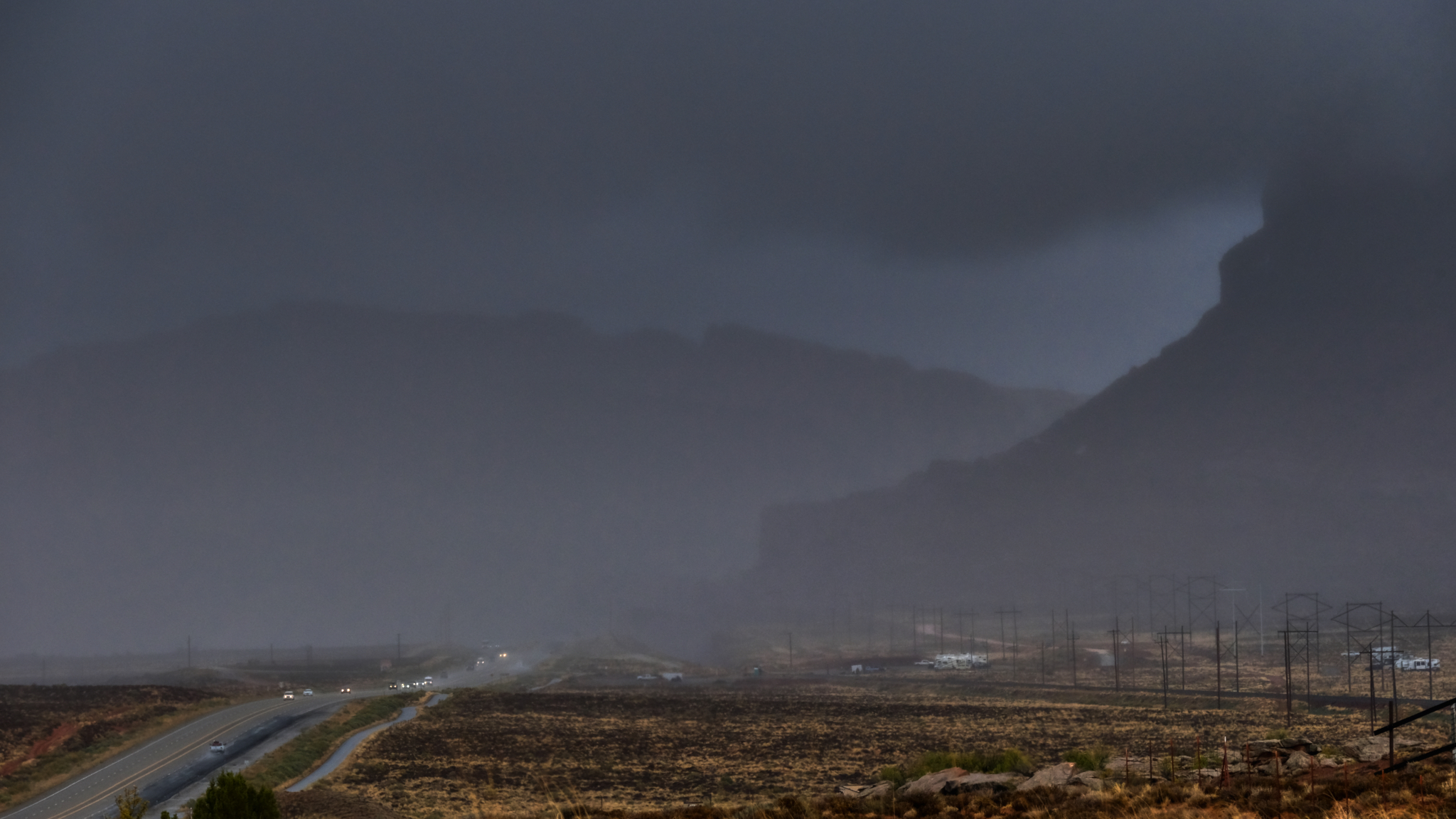 Driving north on Highway 191 out of Moab in a driving rain storm.
Driving north on Highway 191 out of Moab in a driving rain storm.
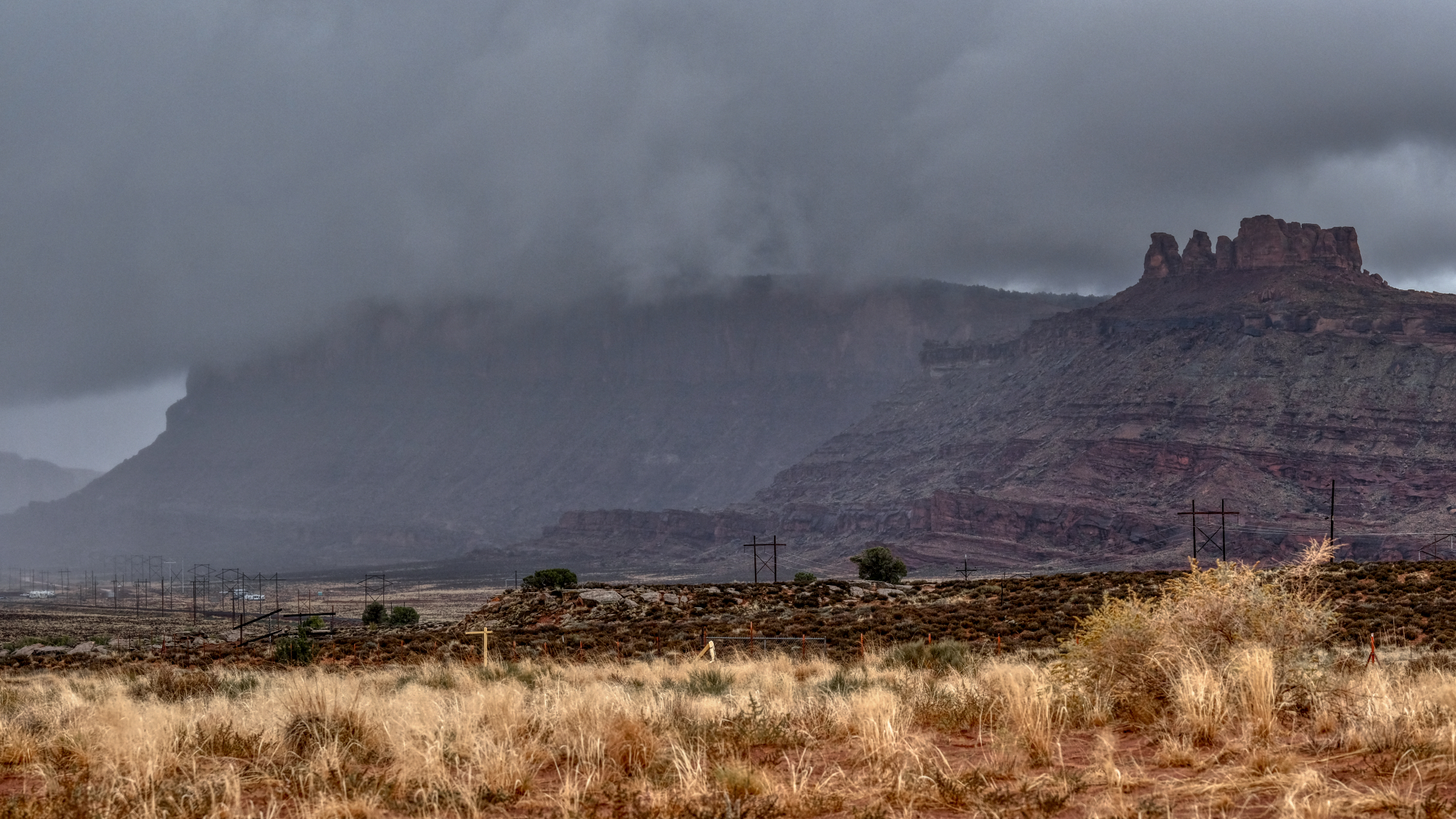 Water poured off of the mesas and buttes.
Water poured off of the mesas and buttes.
 After a Sunday night in a Green River, Utah roadside motel (where I was able to watch an NFL game), I drove back to Moab to check for motels there . . . still in a light rain. I found one and sat out the day on the internet and watching Monday Night Football, as the rain became heavy all day. The next morning it was cloudy, with clear spots, so I headed to an RV park and bought a slot for camper next to a German couple who had been on a one year camper road trip in the USA.
After a Sunday night in a Green River, Utah roadside motel (where I was able to watch an NFL game), I drove back to Moab to check for motels there . . . still in a light rain. I found one and sat out the day on the internet and watching Monday Night Football, as the rain became heavy all day. The next morning it was cloudy, with clear spots, so I headed to an RV park and bought a slot for camper next to a German couple who had been on a one year camper road trip in the USA.
 Moab is the "Outdoor Adventure Capitol of the USA" . . . and also a very interesting old mining town. I stopped in a gems and fossil shop to look for dinosaur fossils for my grandson at a place that had lots of antique mining equipment laying about . . .
Moab is the "Outdoor Adventure Capitol of the USA" . . . and also a very interesting old mining town. I stopped in a gems and fossil shop to look for dinosaur fossils for my grandson at a place that had lots of antique mining equipment laying about . . .
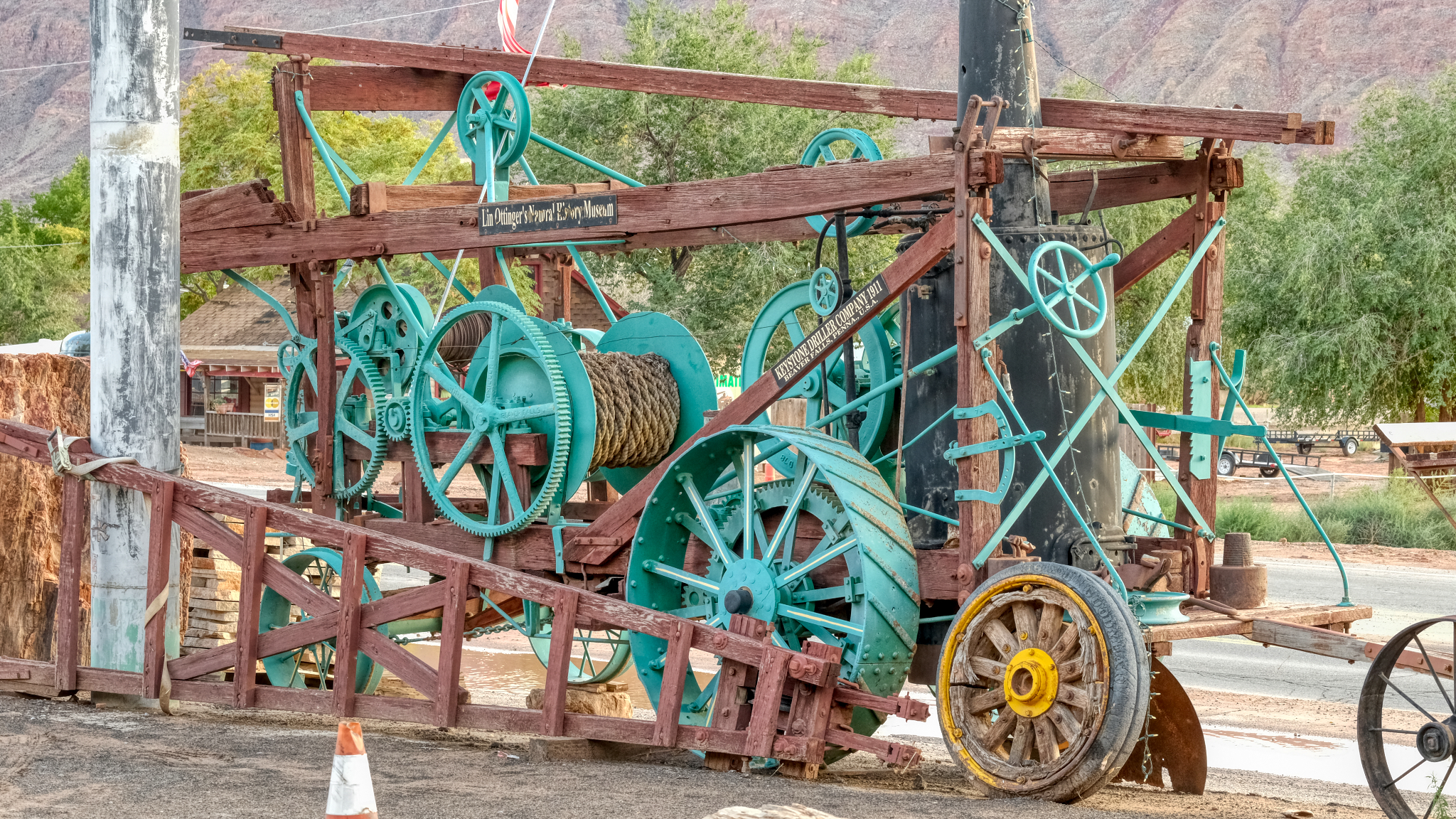 . . . an old mine winch . . .
. . . an old mine winch . . .
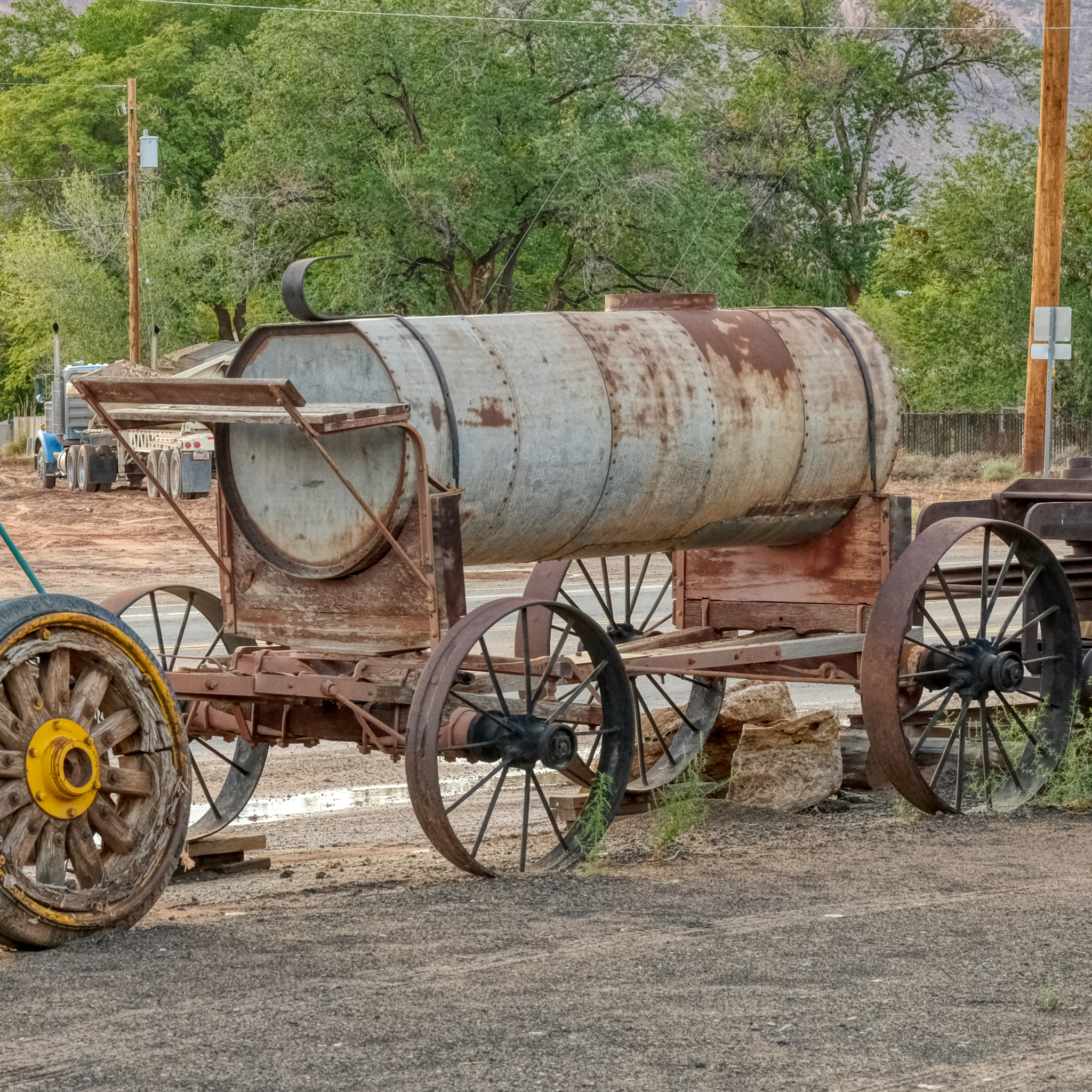 . . . a water wagon that once services a long forgotten mining operation.
. . . a water wagon that once services a long forgotten mining operation.
 The good people in the rock shop advised that I go and see Dead Horse Overlook State Park, about 20 miles out of town . . . and through fantastic high desert chaparral country.
The good people in the rock shop advised that I go and see Dead Horse Overlook State Park, about 20 miles out of town . . . and through fantastic high desert chaparral country.
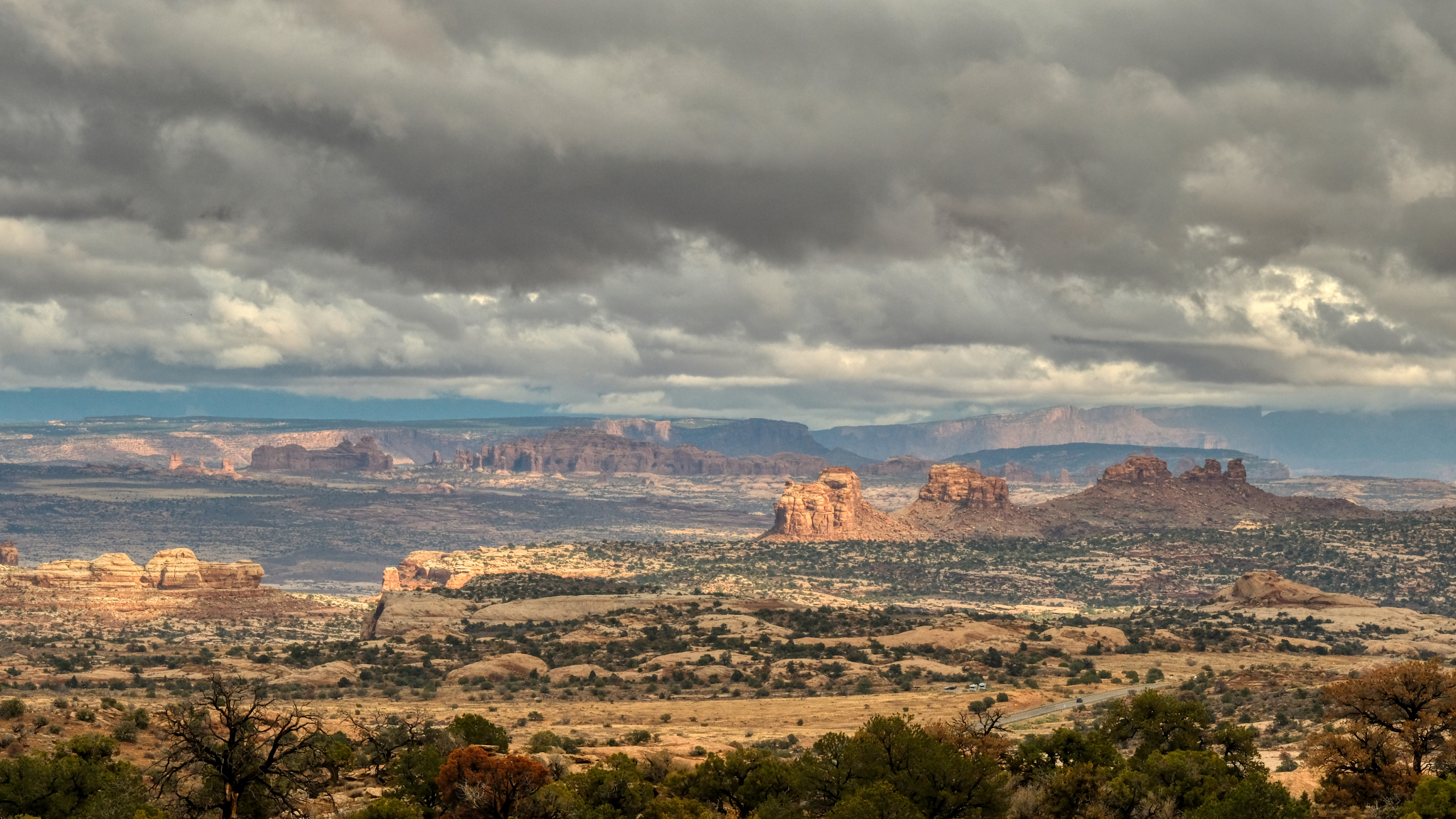 The small paved road out to Dead Horse Overlook was GRAND!
The small paved road out to Dead Horse Overlook was GRAND!
 The sky became very dark and I was worried that I would lose another day in bad weather . . . I pushed on to Dead Horse Overlook.
The sky became very dark and I was worried that I would lose another day in bad weather . . . I pushed on to Dead Horse Overlook.
 As I neared the overlook I knew I was in for something truly wonderful.
As I neared the overlook I knew I was in for something truly wonderful.
 Now and again I would get a glimpse through the roadside shrubbery of a grand landscape . . . .
Now and again I would get a glimpse through the roadside shrubbery of a grand landscape . . . .
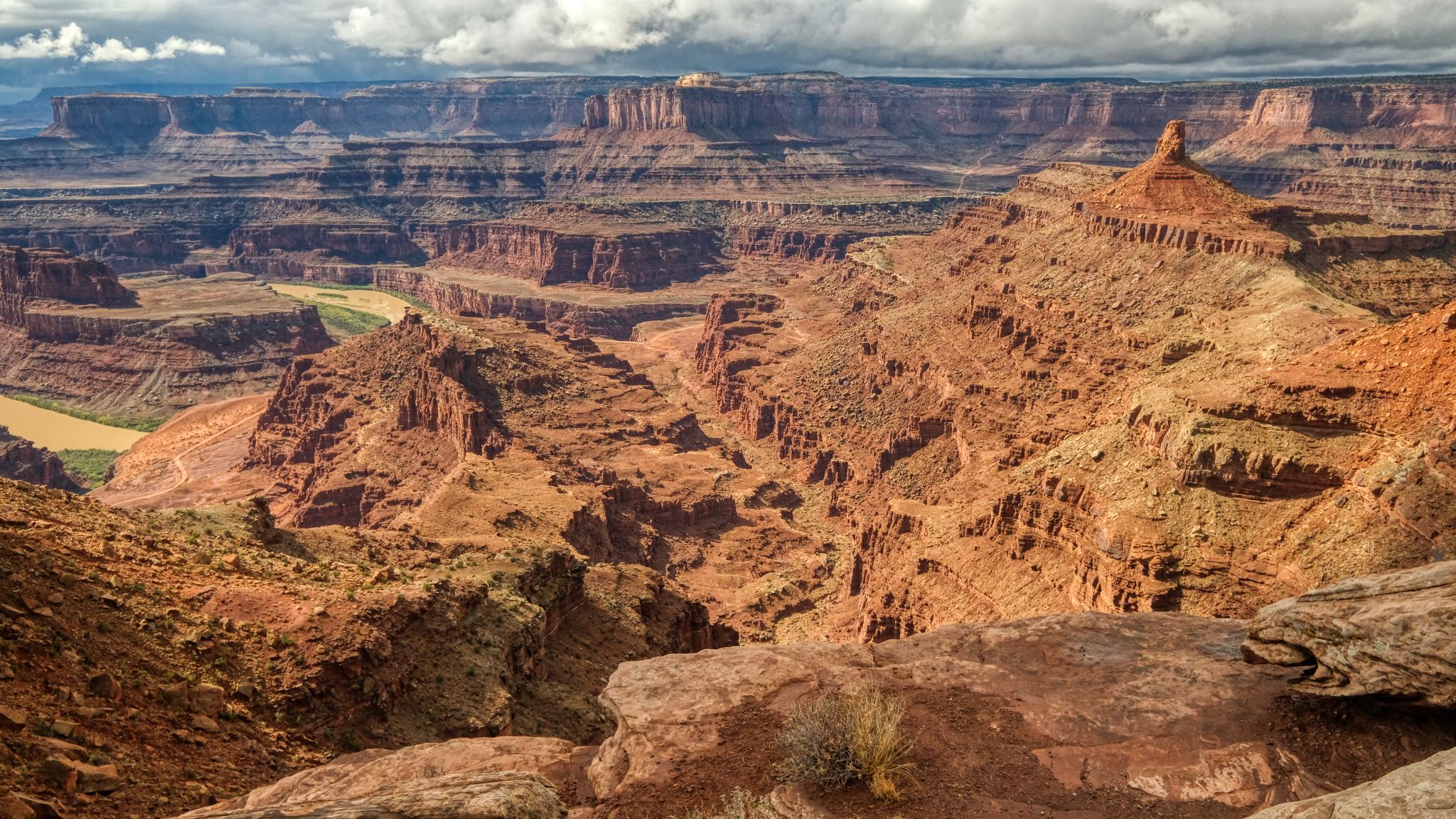 When I finally arrived at Dead Horse Overlook I parked right next to the precipice of this amazing sight! The grandest view I have ever seen! I was parked out on a ridge that jutted out into this spectacular canyon! There was a 300 degree view from where I stood. This view is looking north.
When I finally arrived at Dead Horse Overlook I parked right next to the precipice of this amazing sight! The grandest view I have ever seen! I was parked out on a ridge that jutted out into this spectacular canyon! There was a 300 degree view from where I stood. This view is looking north.
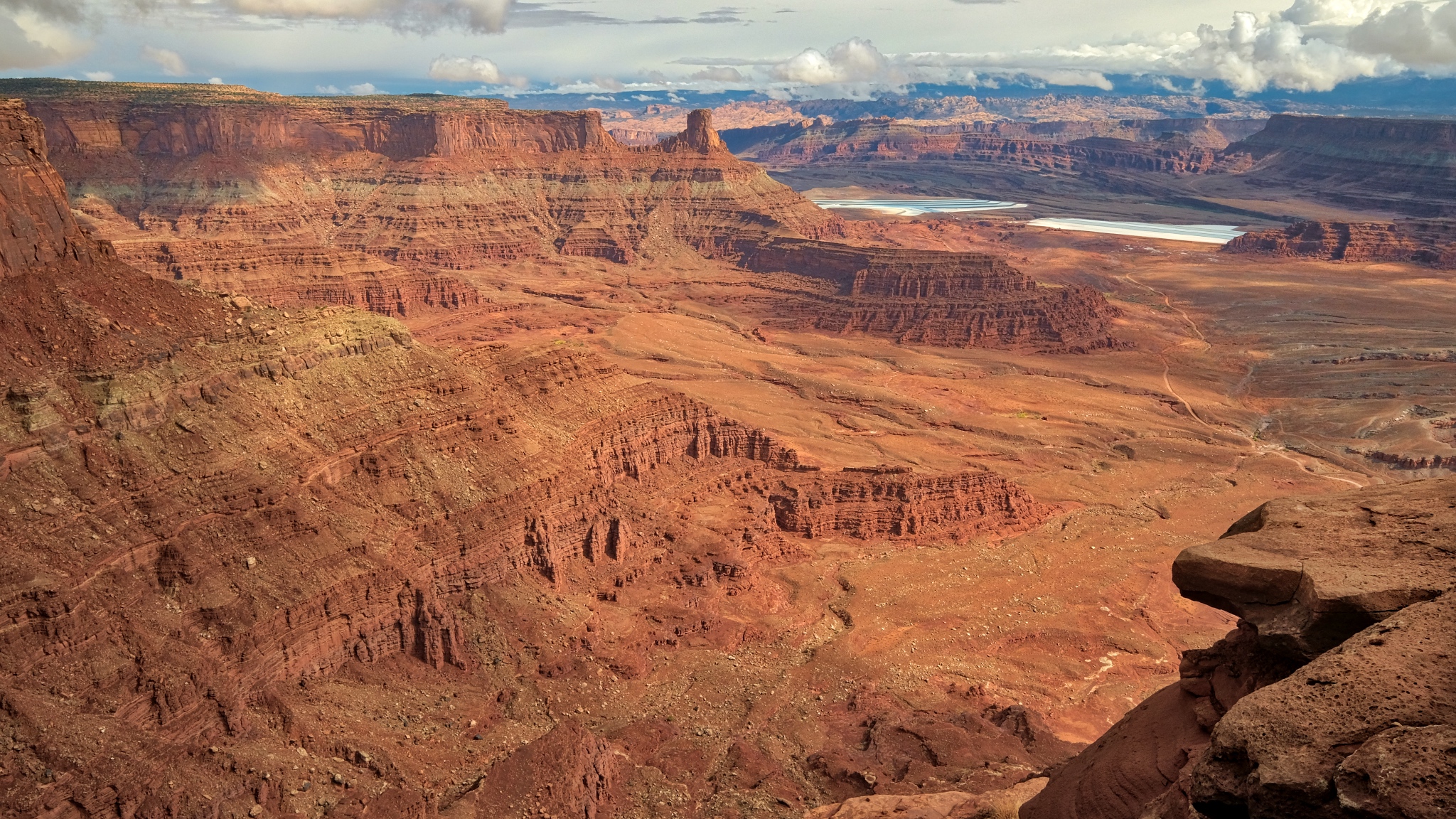 I walked across the road to this south facing view of the mammoth canyon!
I walked across the road to this south facing view of the mammoth canyon!
 Potash evaporation ponds could be seen in the distance in the south side view.
Potash evaporation ponds could be seen in the distance in the south side view.
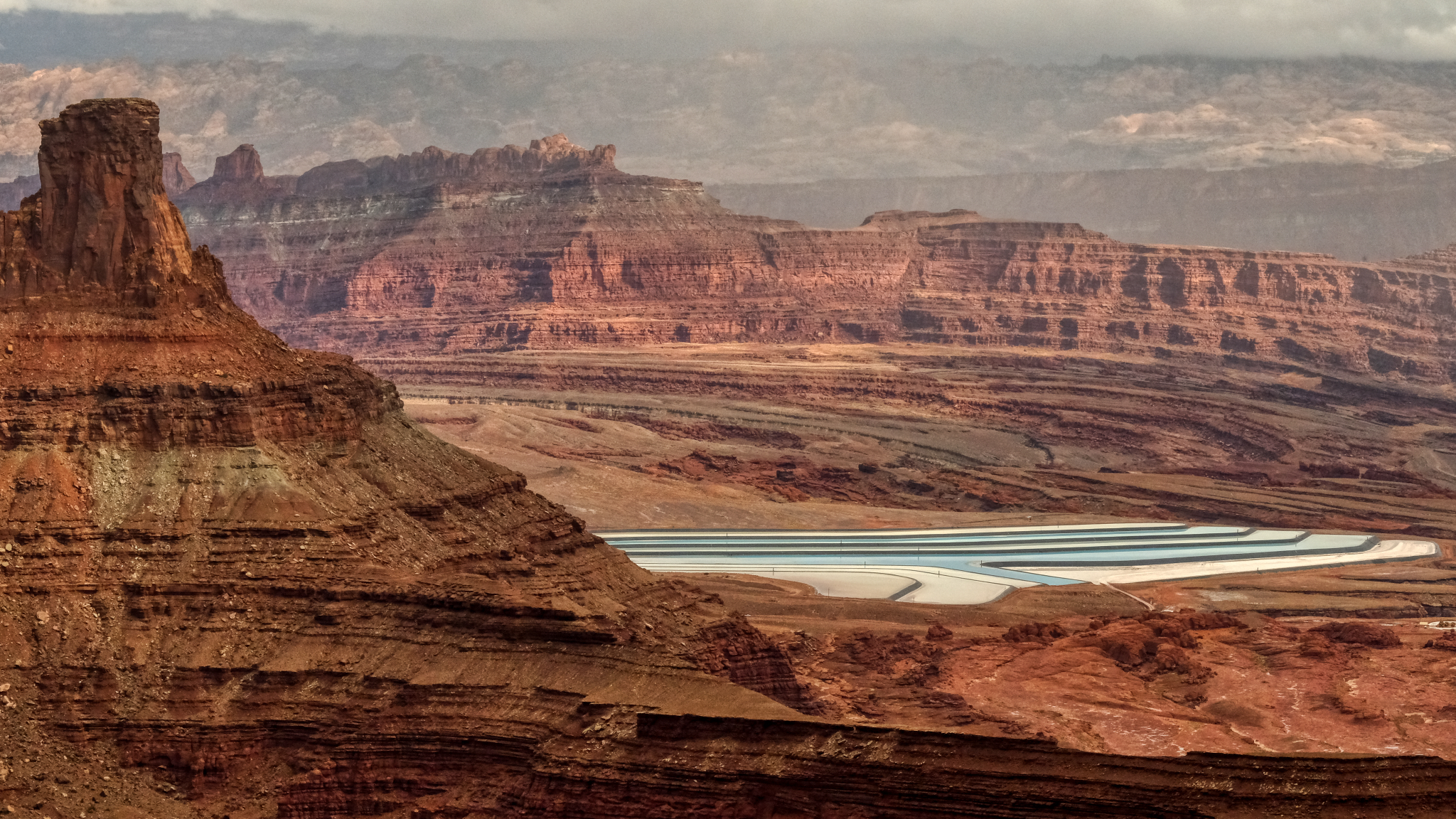 I was left speechless by the grandeur of this place . . . and so were the 15-20 other tourists there . . . walking around very slowly with their mouths open . . . in complete silence.
I was left speechless by the grandeur of this place . . . and so were the 15-20 other tourists there . . . walking around very slowly with their mouths open . . . in complete silence.
 Astonishing beauty.
Astonishing beauty.
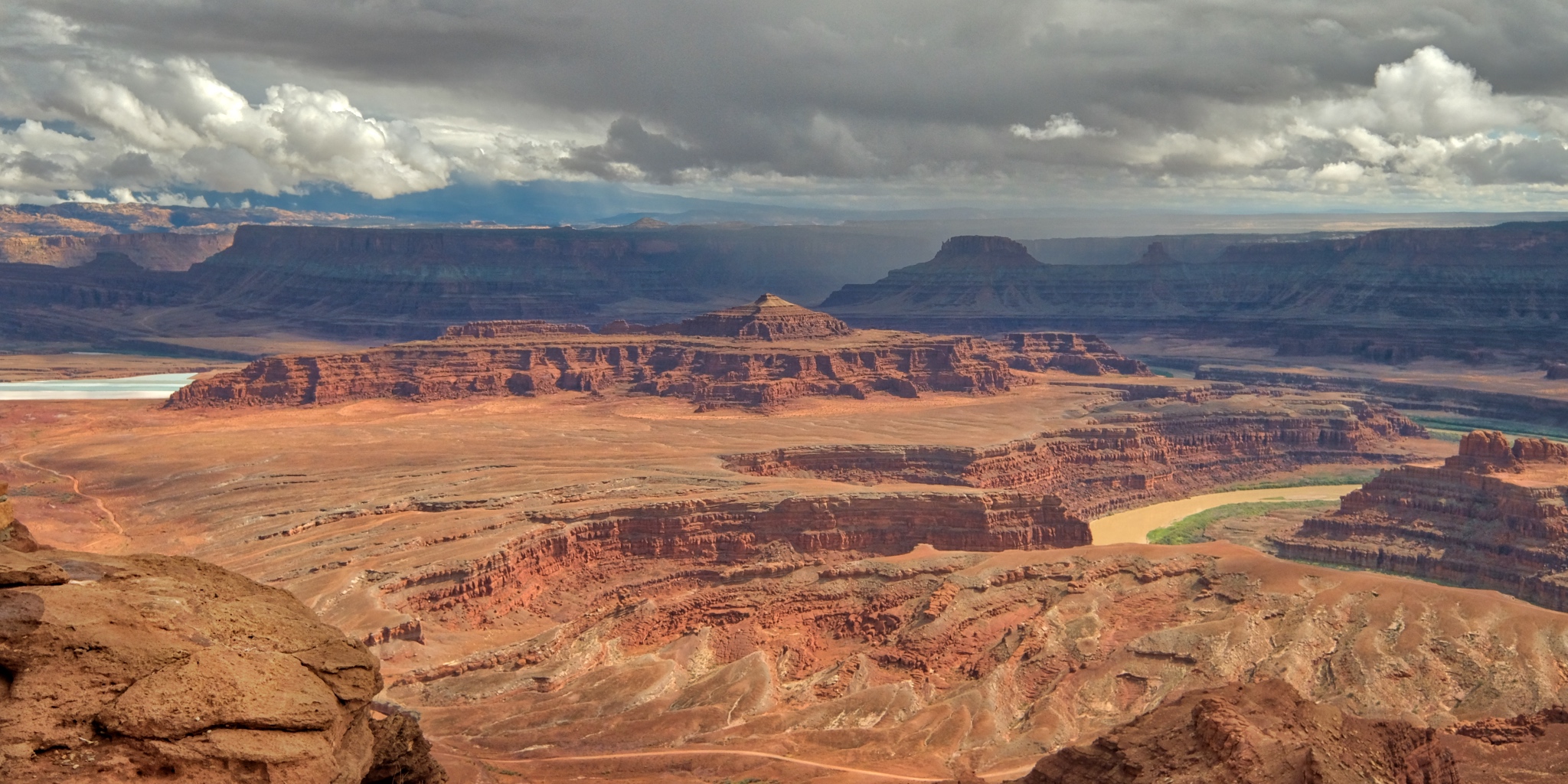 I walked along the south edge toward the outermost point of the ridge . . .
I walked along the south edge toward the outermost point of the ridge . . .
 A meandering Colorado River cuts its way through the red rock.
A meandering Colorado River cuts its way through the red rock.

At last I stood out at the end of the ridge . . . with the entire canyon below . . .
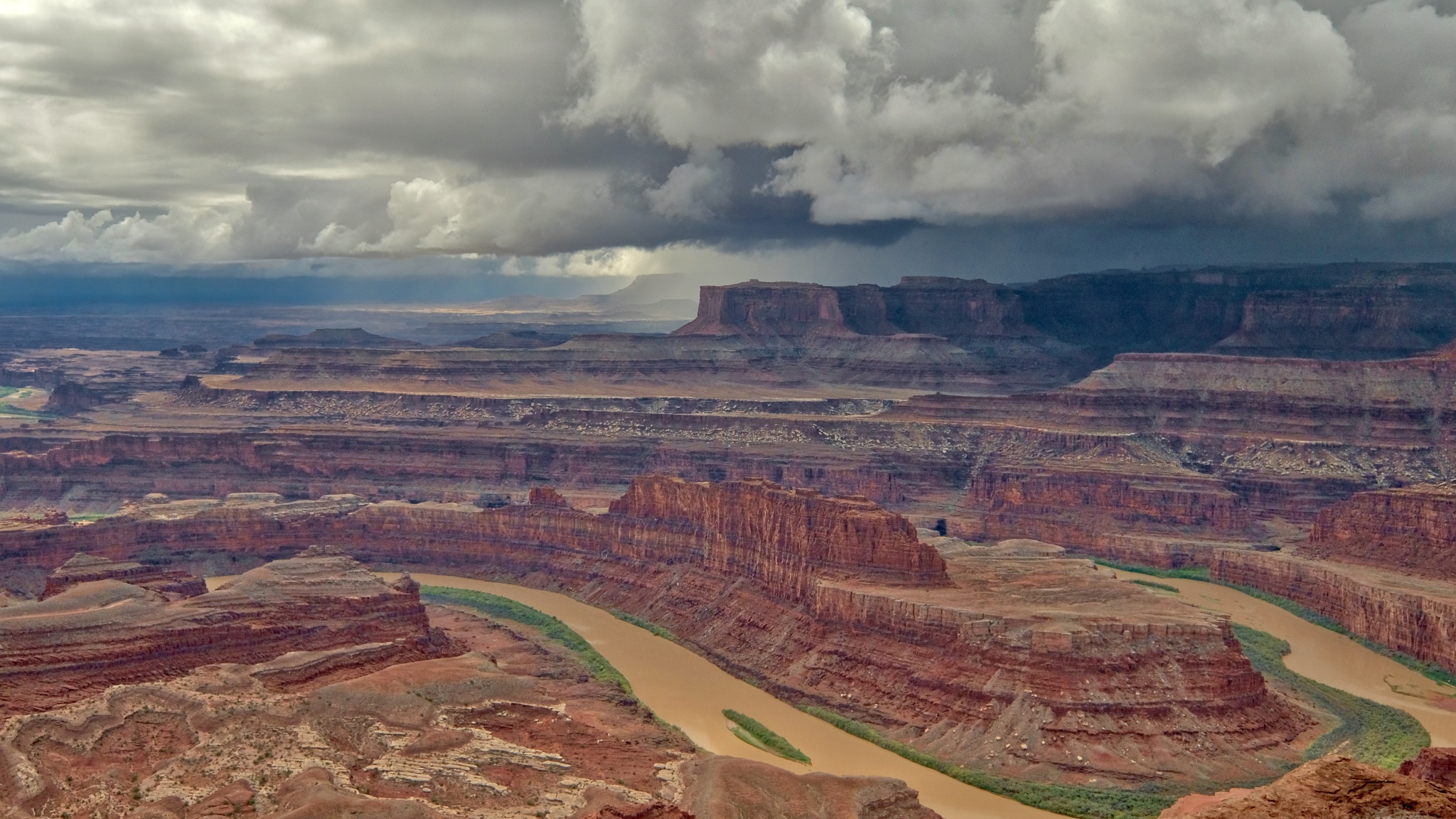 Looking north from the ridge point I could see the storm clouds gathering on the far canyon rim.
Looking north from the ridge point I could see the storm clouds gathering on the far canyon rim.
 Indescribable beauty.
Indescribable beauty.
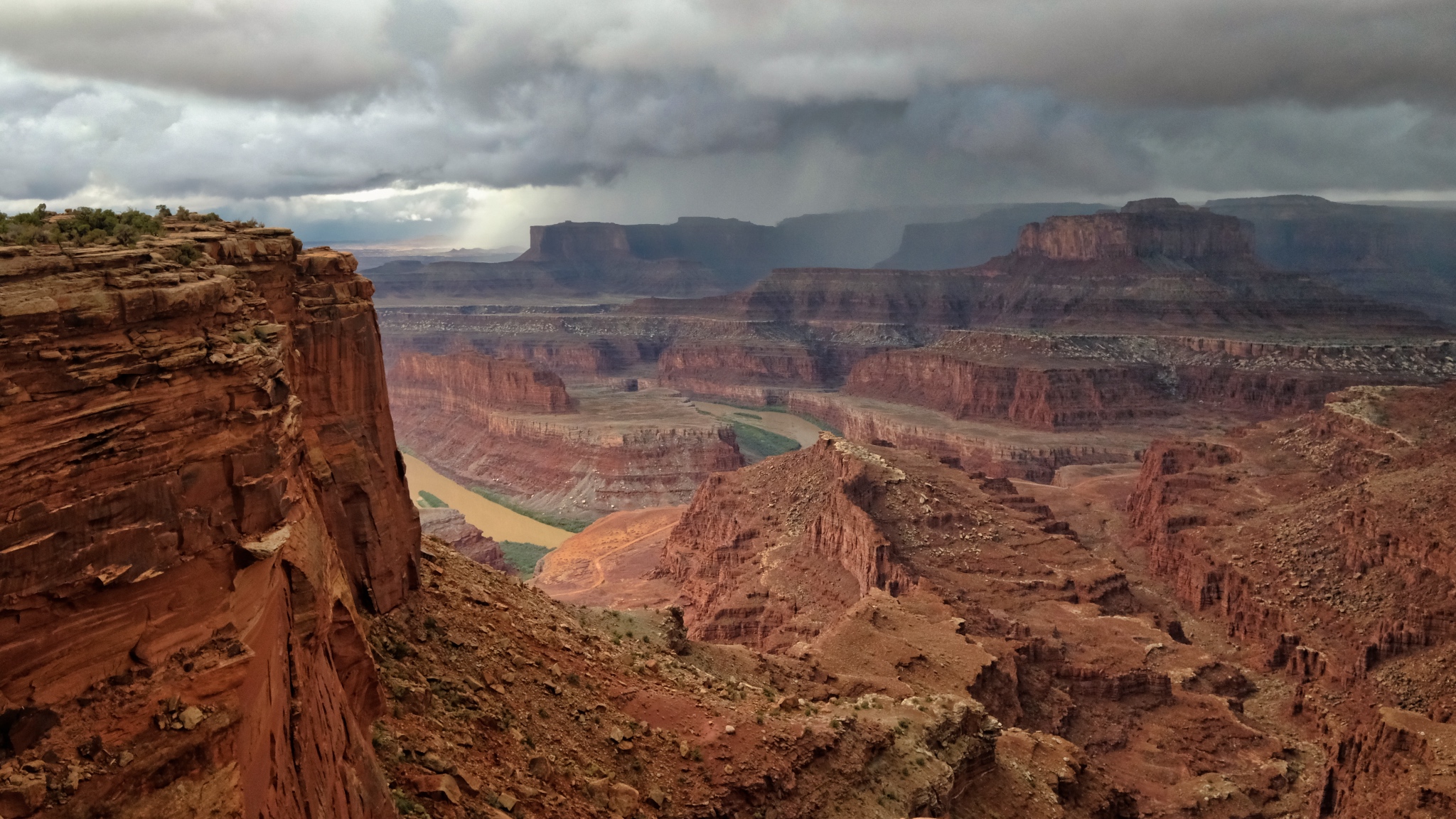 The rain moved rapidly across the canyon.
The rain moved rapidly across the canyon.
 The rain came swiftly . . . I ran to my camper.
The rain came swiftly . . . I ran to my camper.
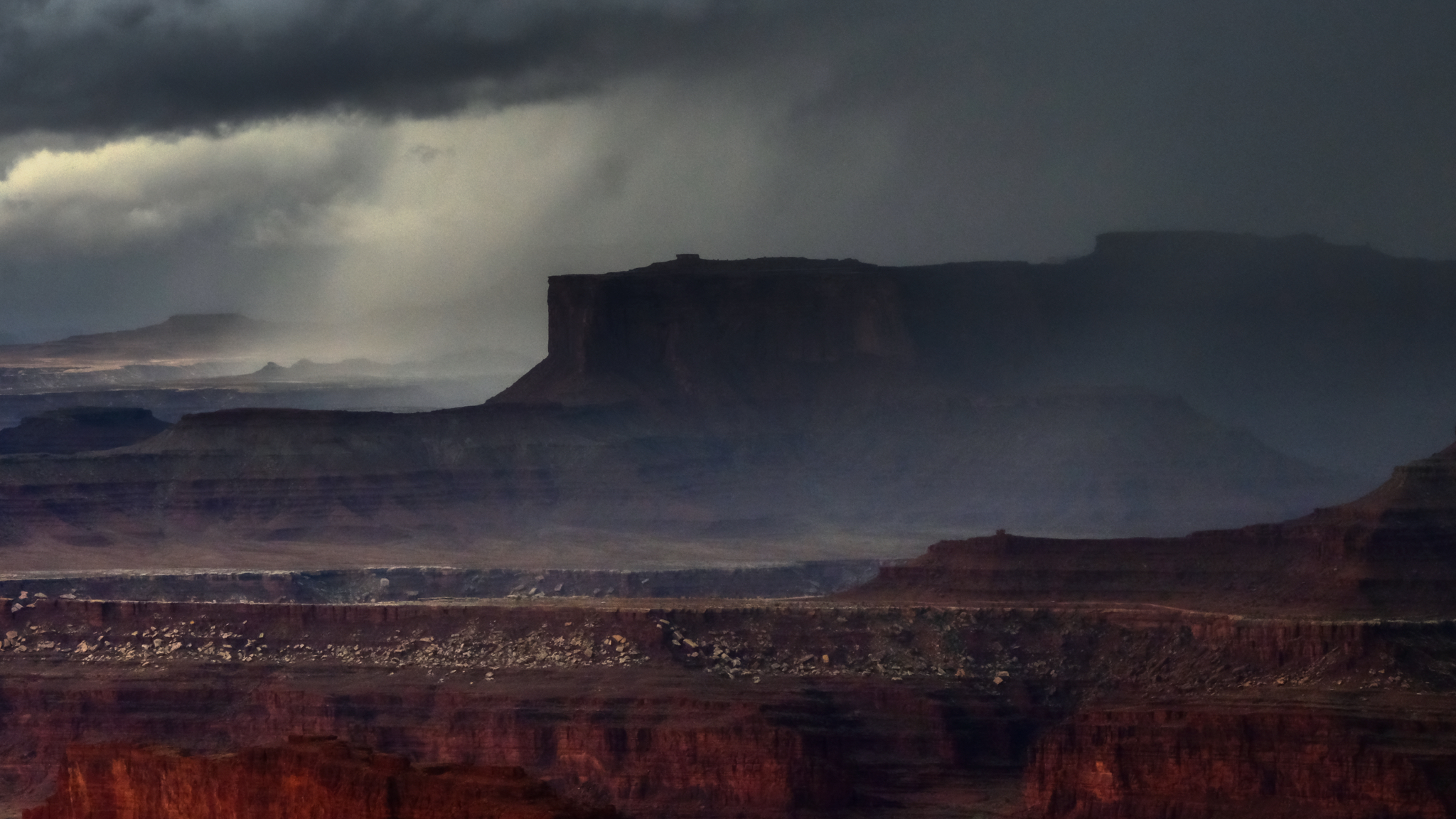 I hated to have to leave this incredible place . . . I slowly drove away from Dead Horse Point State Park, Utah.
I hated to have to leave this incredible place . . . I slowly drove away from Dead Horse Point State Park, Utah.
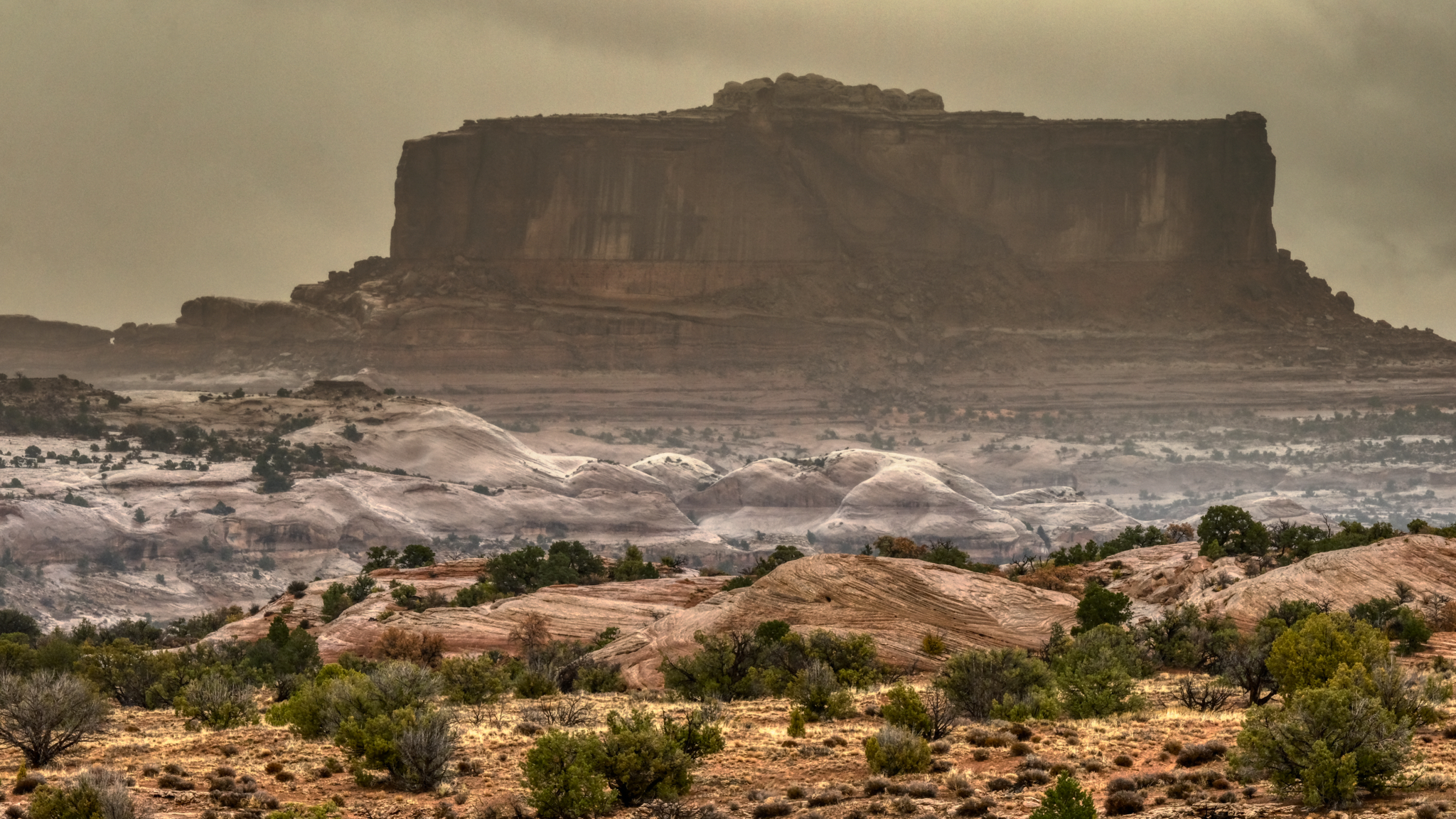 Back down the road through the rain toward my motel room in Moab . . . too cold and wet for a campground . . .
Back down the road through the rain toward my motel room in Moab . . . too cold and wet for a campground . . .
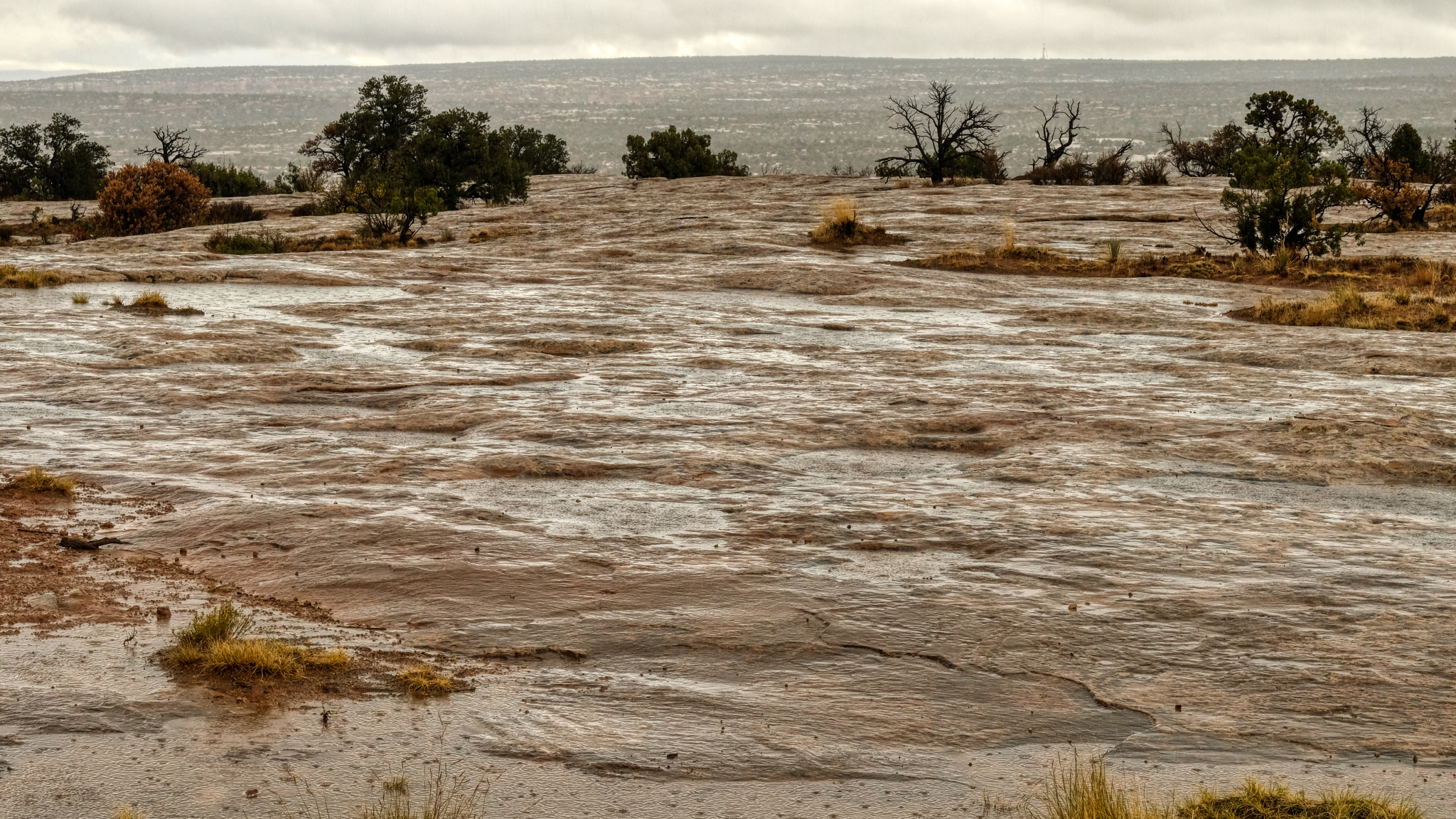 Hard rain on hard flat rock.
Hard rain on hard flat rock.
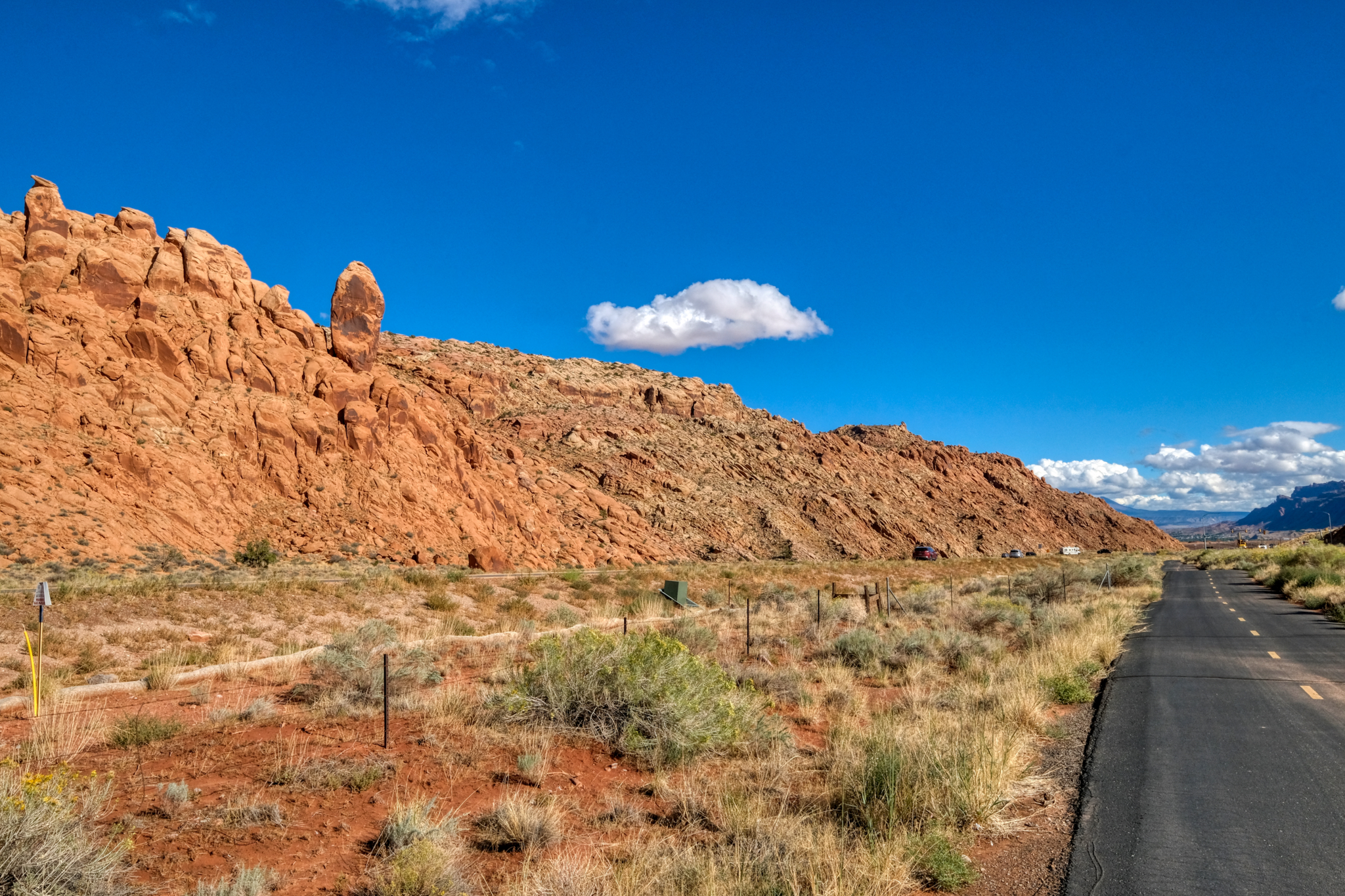 The next morning broke bright and sunny. I left my motel and found a nice RV park at the edge of town, got a space, set up, and set off on my bicycle. As it turned out, my RV park was at the beginning of a long and paved bike trail that led out of town and up into the red rock canyons.
The next morning broke bright and sunny. I left my motel and found a nice RV park at the edge of town, got a space, set up, and set off on my bicycle. As it turned out, my RV park was at the beginning of a long and paved bike trail that led out of town and up into the red rock canyons.
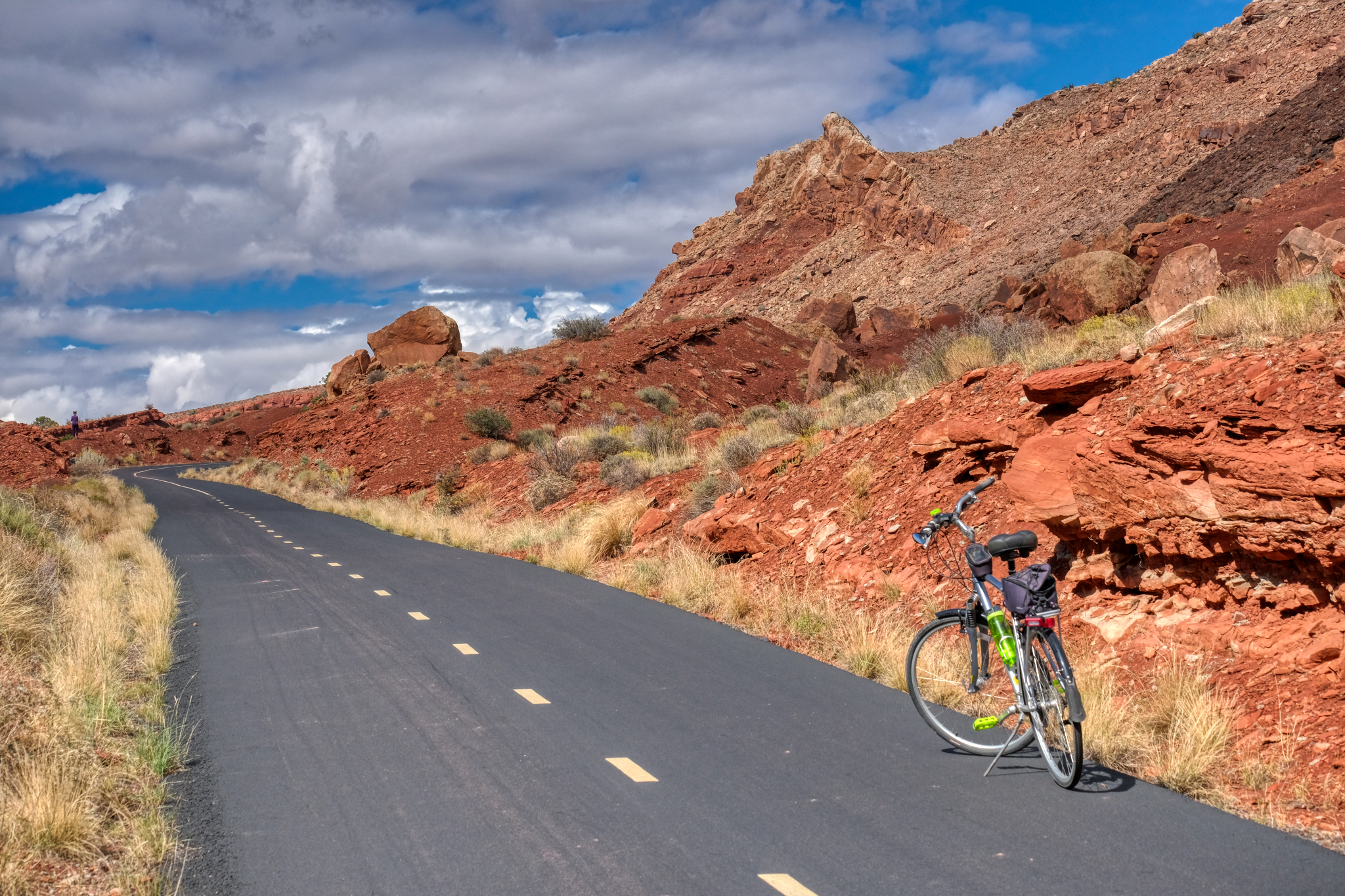 The trail was beautifully paved and at a not too steep grade. Perfect.
The trail was beautifully paved and at a not too steep grade. Perfect.
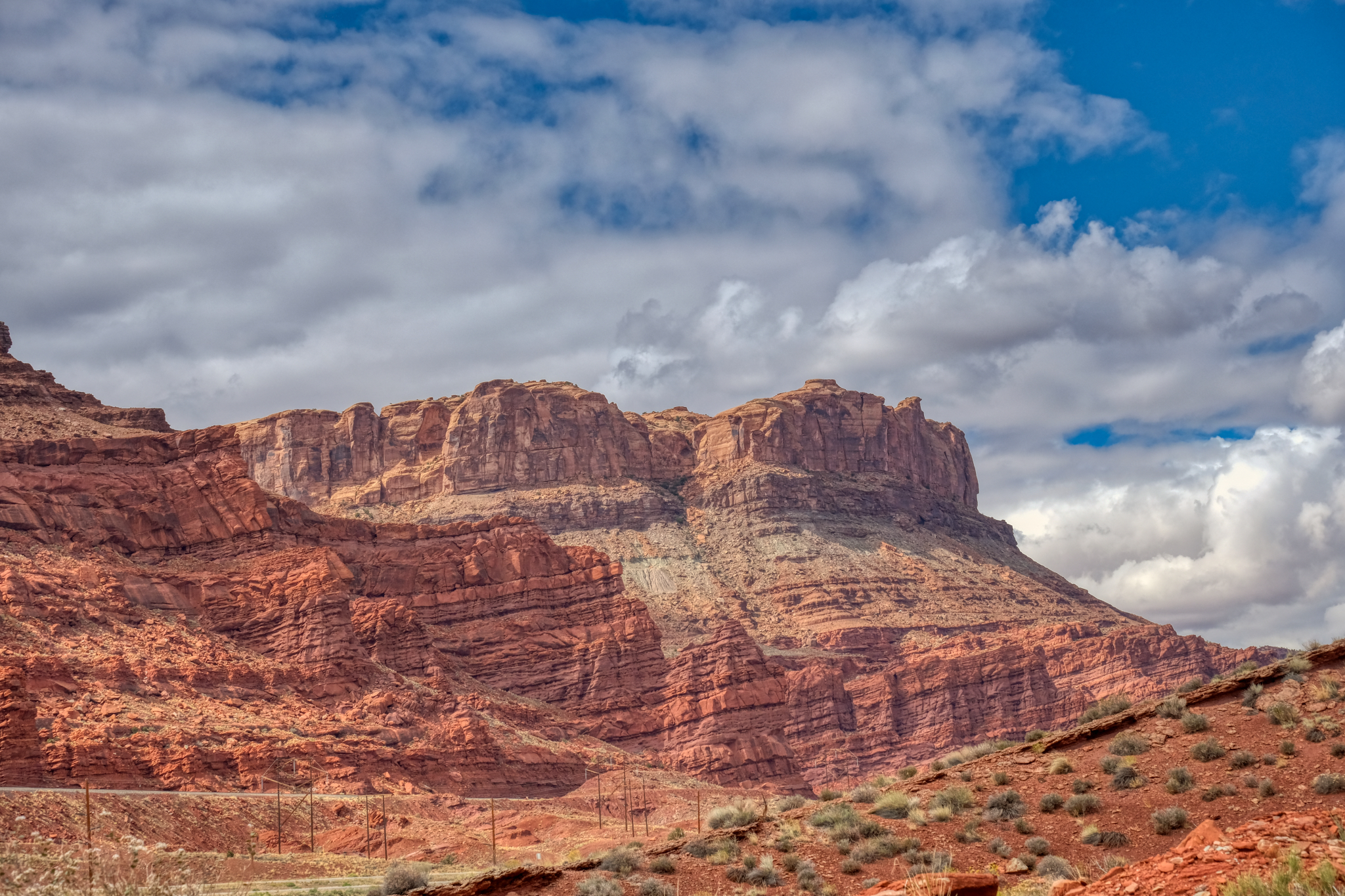 The views coming up the bike trail out of Moab were spectacular!
The views coming up the bike trail out of Moab were spectacular!
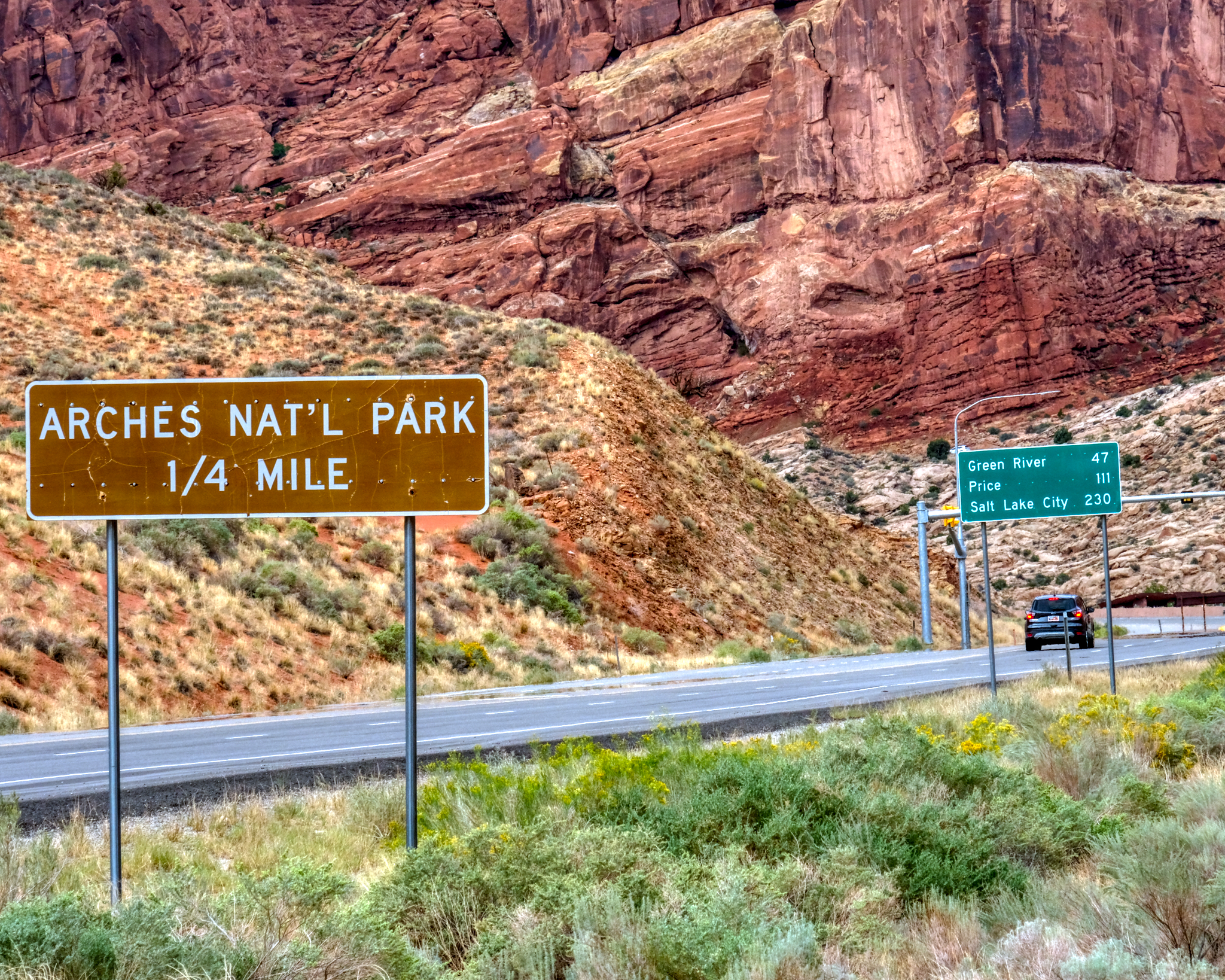 The cut-off road to the Arches National Park was just outside of town . . . .
The cut-off road to the Arches National Park was just outside of town . . . .
 I thought about going into the Arches National Park, but the road was always busy . . . and so was the Visitors Center. I couldn't imagine seeing anything more impressive than Dead Horse Point overlook.
I thought about going into the Arches National Park, but the road was always busy . . . and so was the Visitors Center. I couldn't imagine seeing anything more impressive than Dead Horse Point overlook.
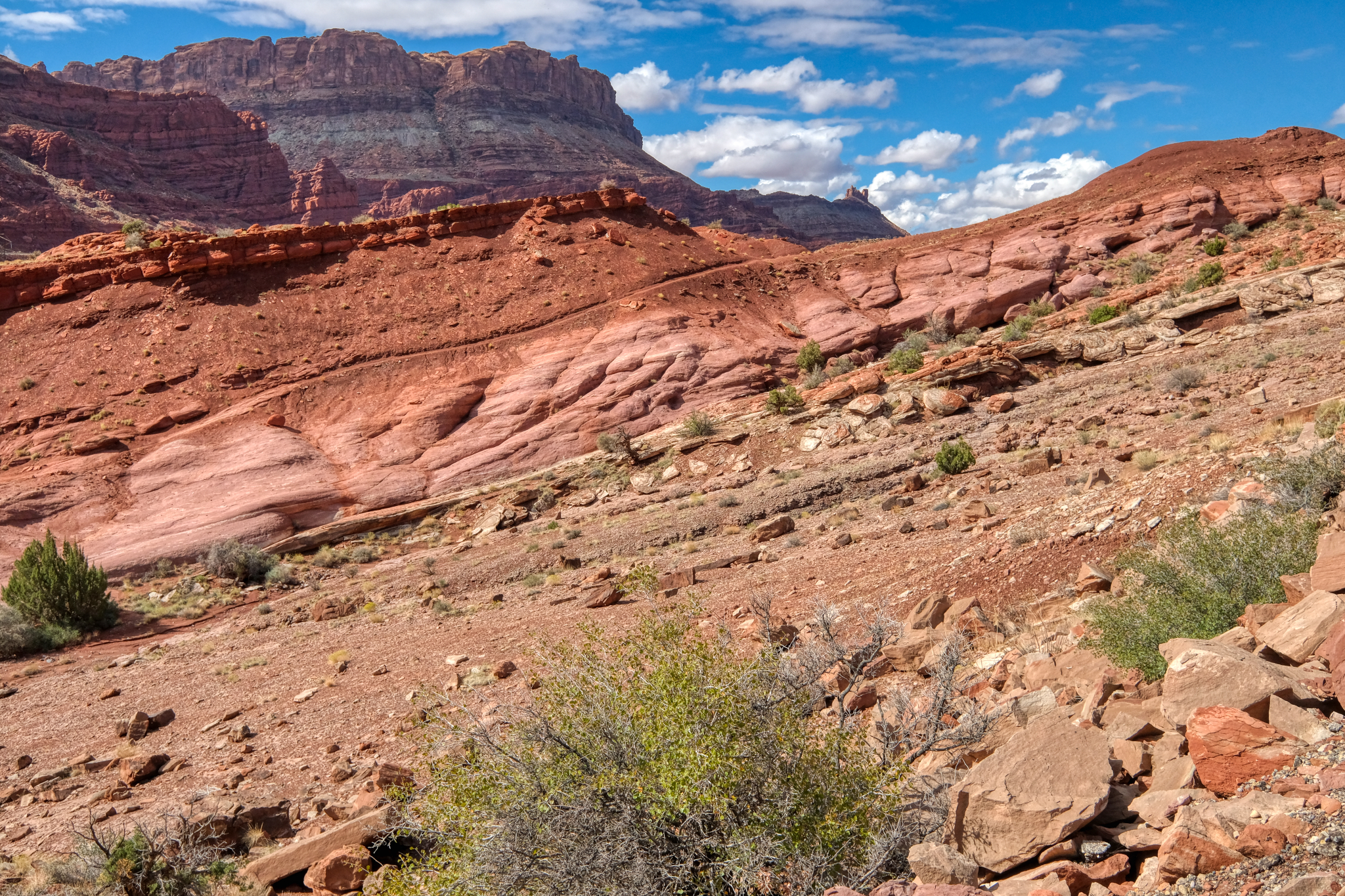 I must have been a geologist in a previous life. My college roommate was a 'geomorphologist' and I guess I got the geology interest from him. This scenery fascinates me no end.
I must have been a geologist in a previous life. My college roommate was a 'geomorphologist' and I guess I got the geology interest from him. This scenery fascinates me no end.
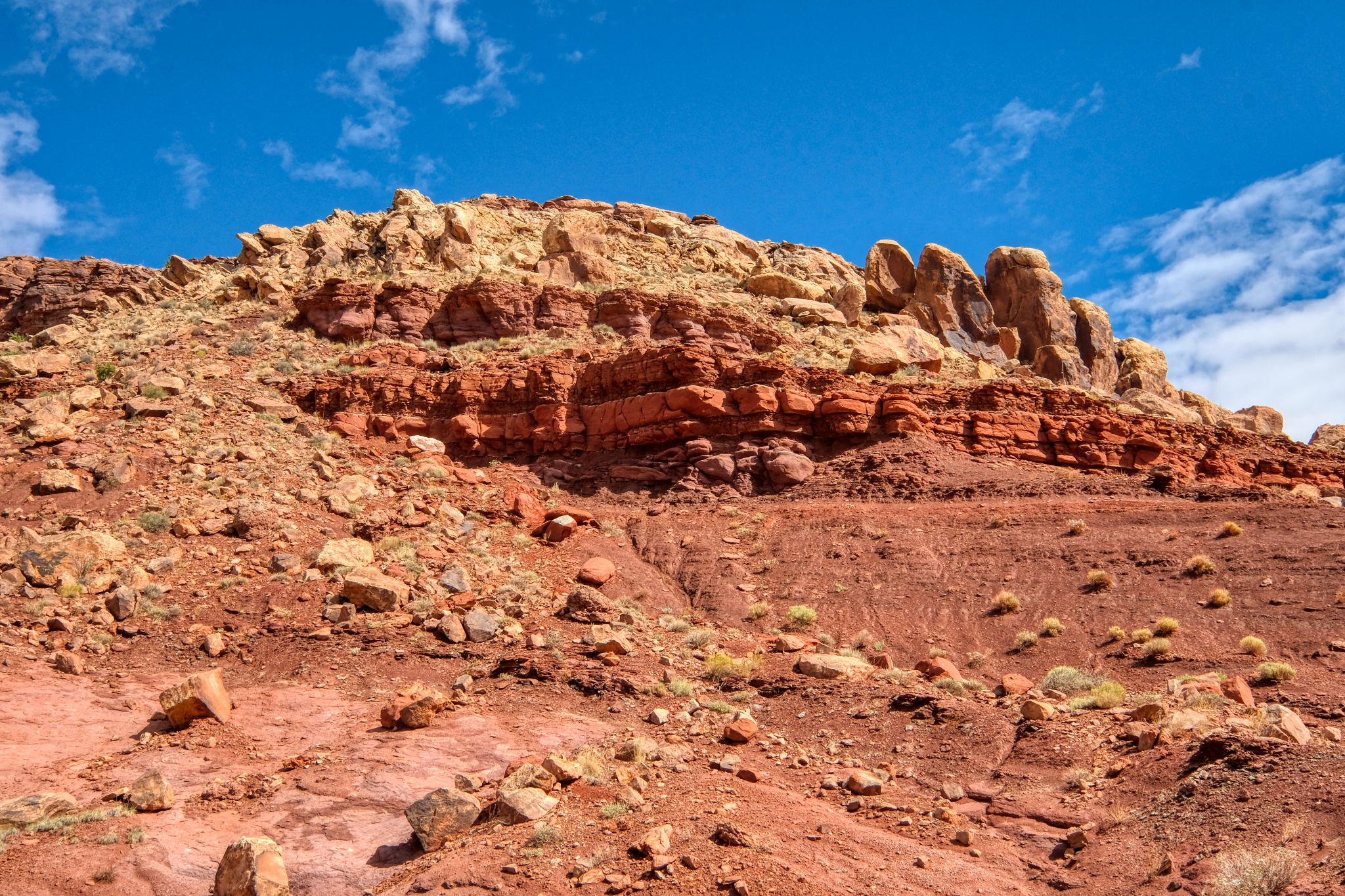 Layered rock outcrops lined the bike trail.
Layered rock outcrops lined the bike trail.
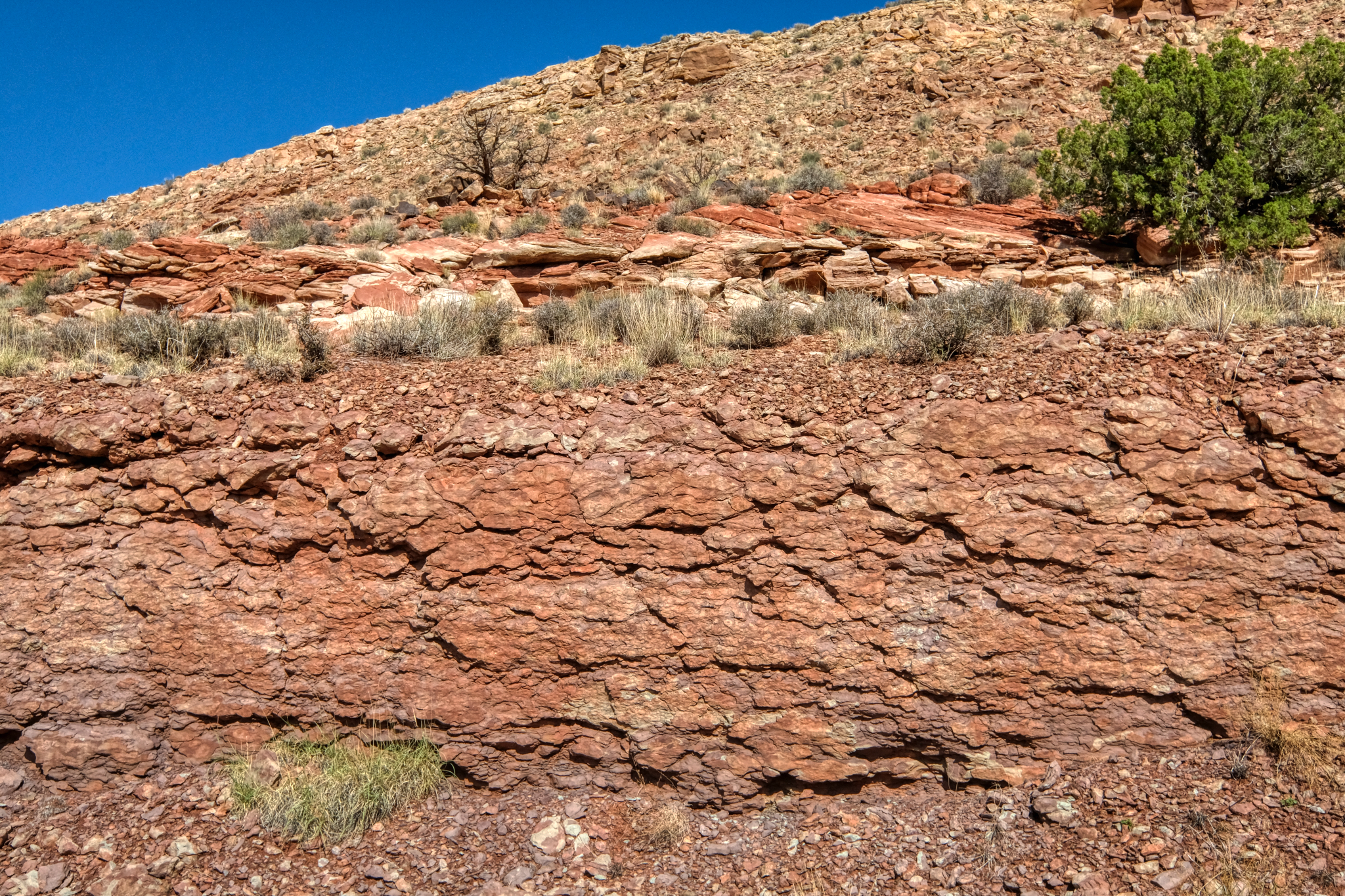 Layers of ancient, solidified mud (?) along the way.
Layers of ancient, solidified mud (?) along the way.
 The geological formations seemed to completely change every 200-300 meters.
The geological formations seemed to completely change every 200-300 meters.
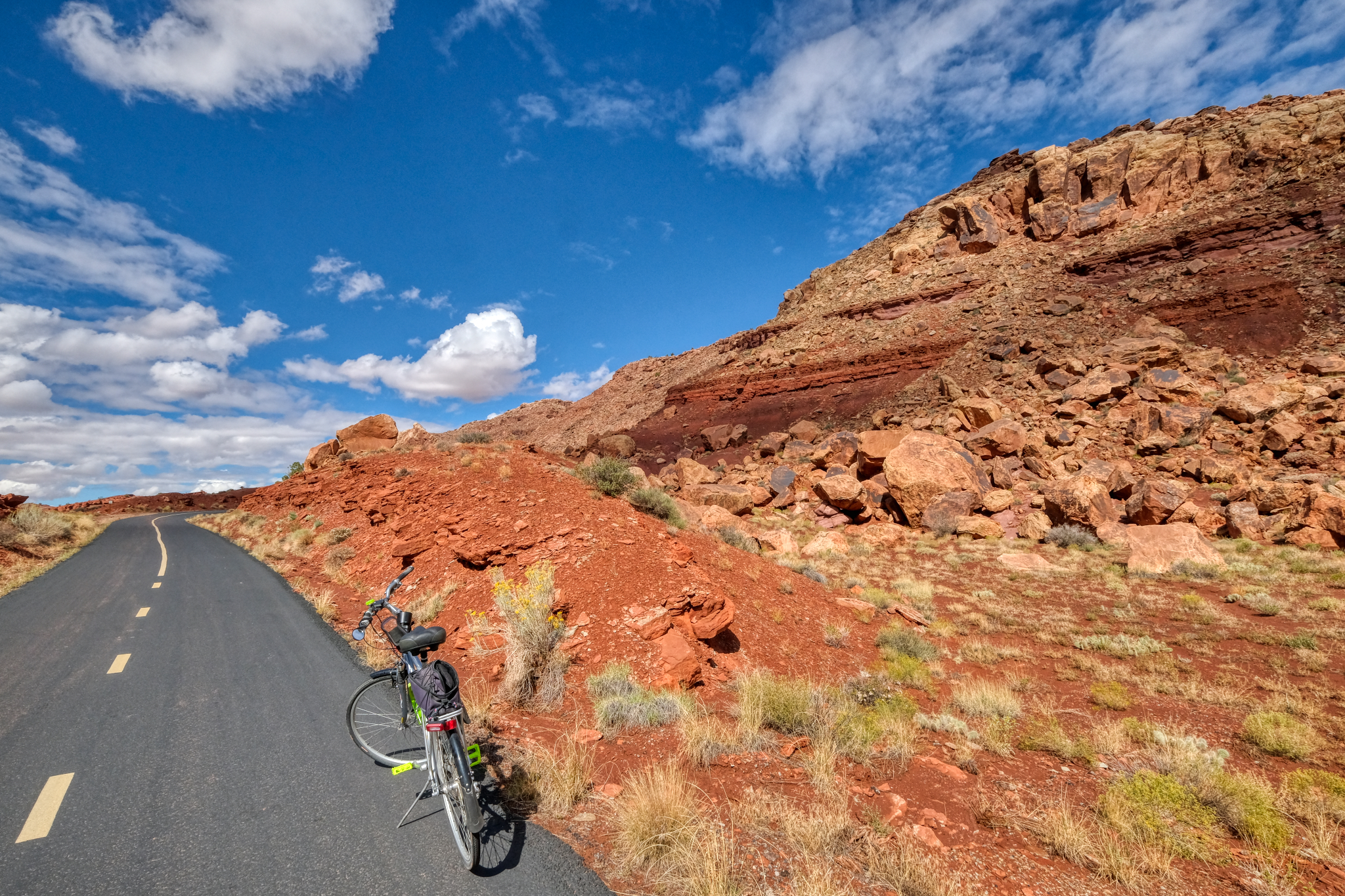 I stopped often (especially when the bike trail got steep) to snap photos and drink water. I packed a nice lunch too.
I stopped often (especially when the bike trail got steep) to snap photos and drink water. I packed a nice lunch too.
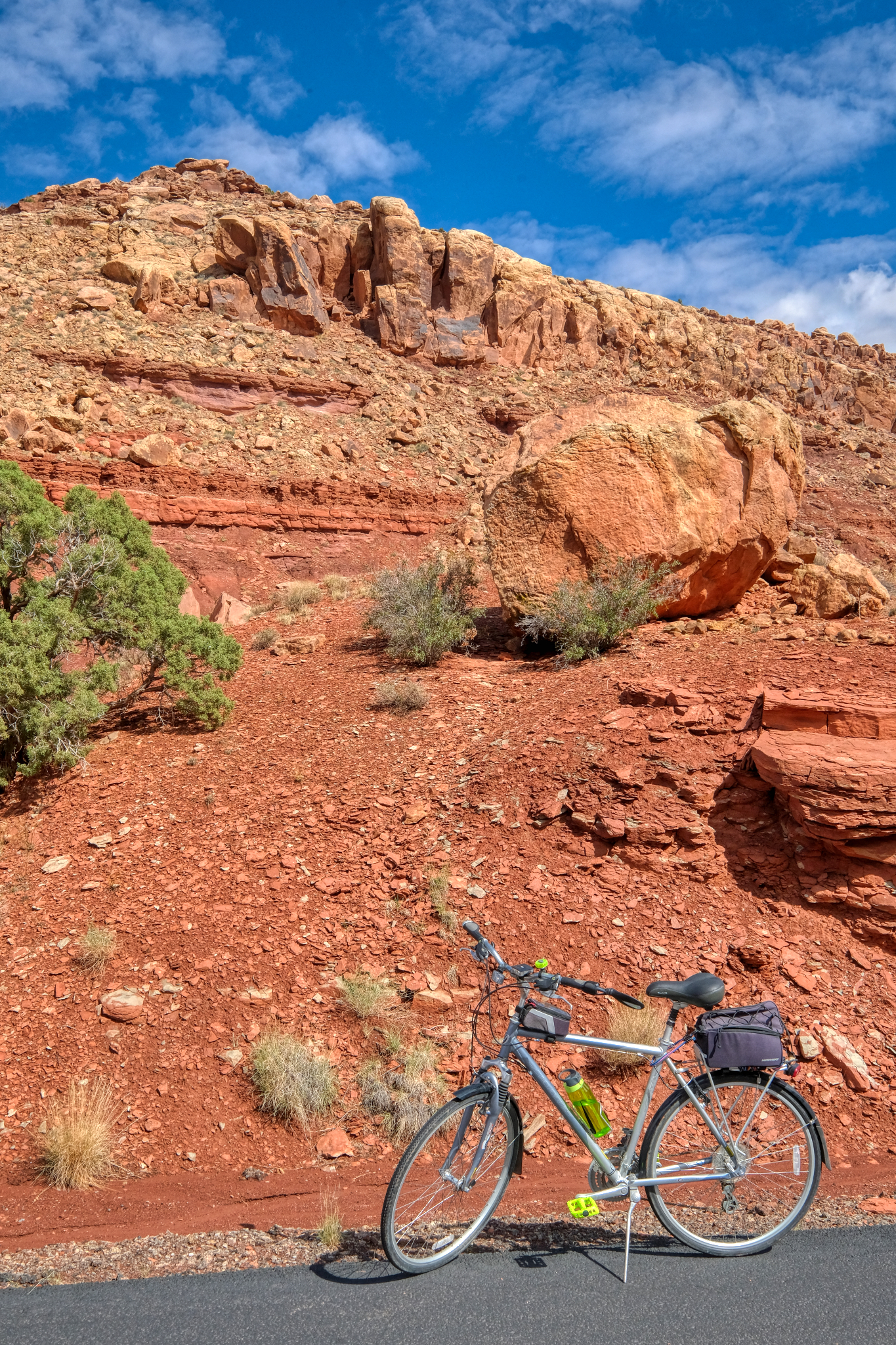 A lovely spot to stop and be amazed by the geology of this fabulous place.
A lovely spot to stop and be amazed by the geology of this fabulous place.
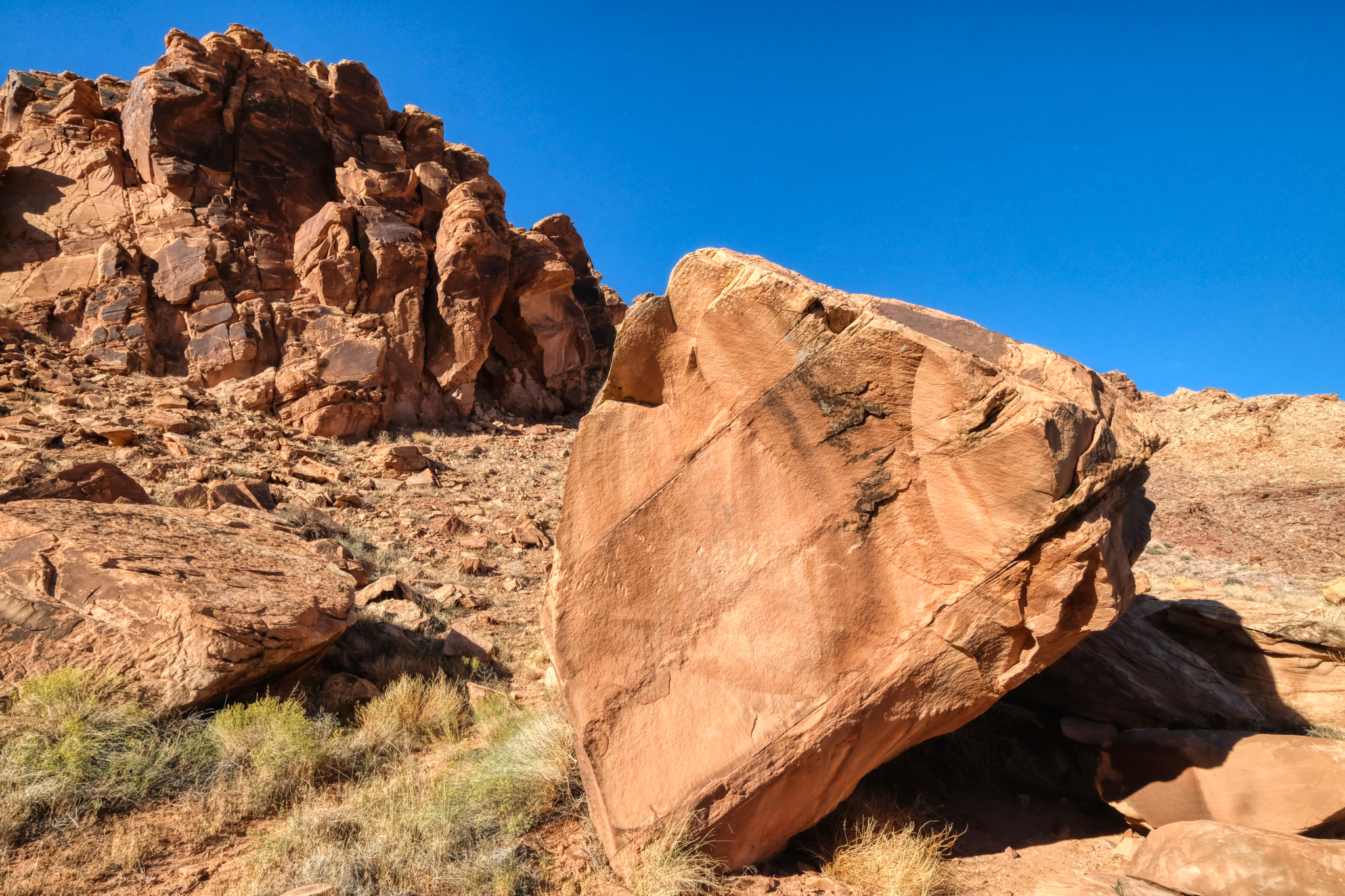 The opportunities for dramatic nature photos were endless.
The opportunities for dramatic nature photos were endless.
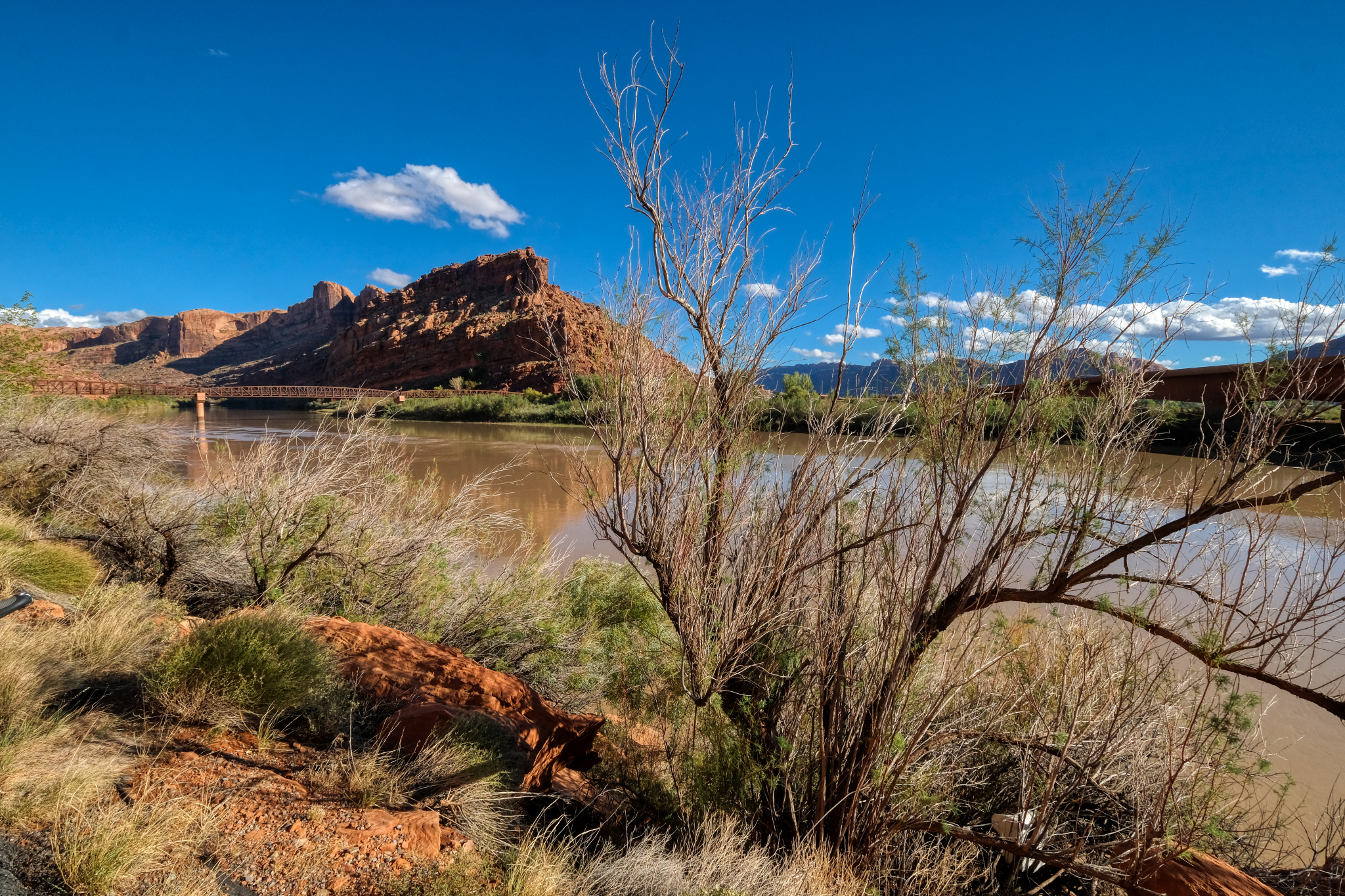 At one point just out of Moab, the canyon widened out as the Colorado River crossed under the bike path. It was the best bicycle bridge I had ever seen.
At one point just out of Moab, the canyon widened out as the Colorado River crossed under the bike path. It was the best bicycle bridge I had ever seen.
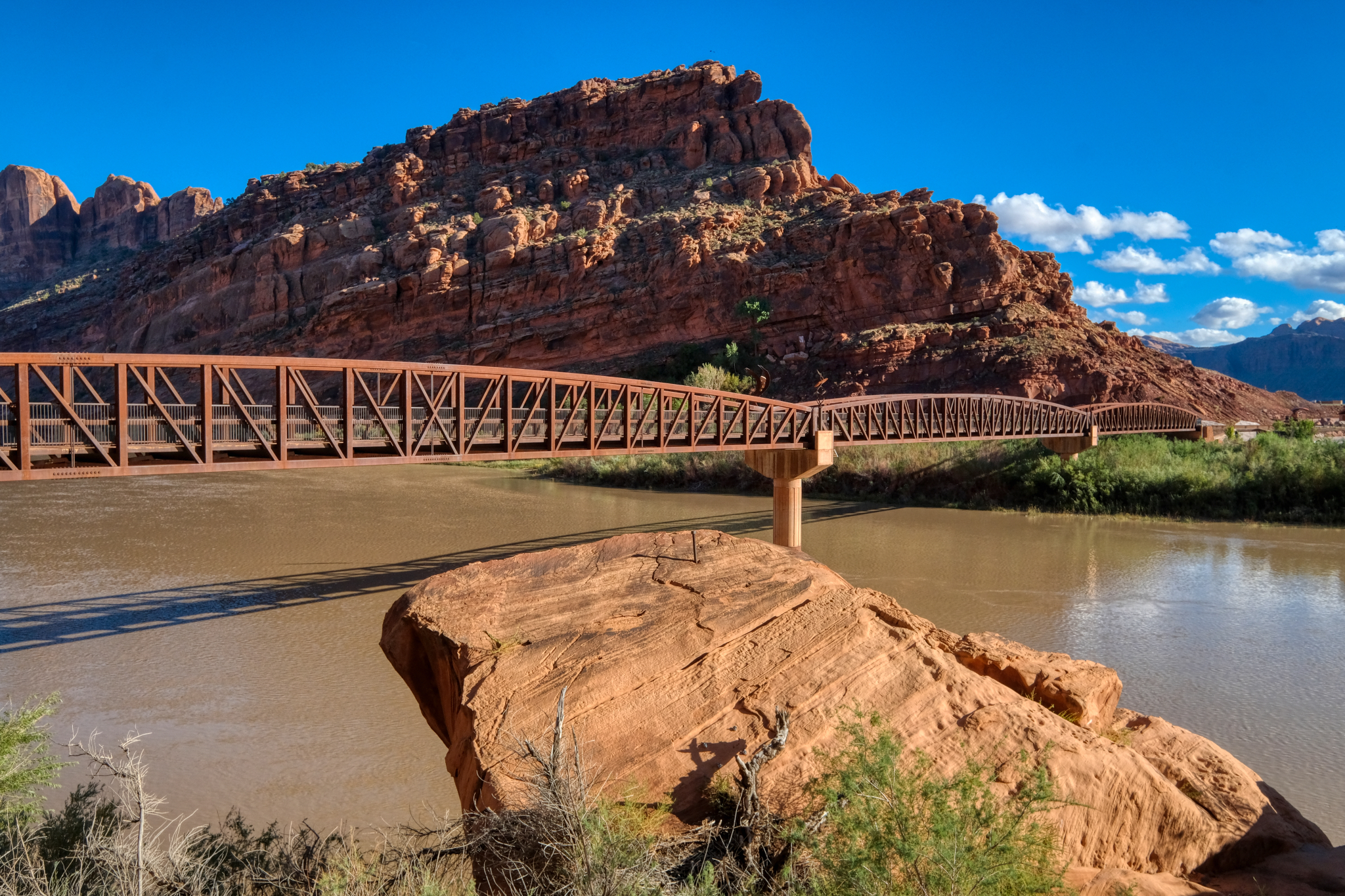 Such a wondrous place for a long bike ride.
Such a wondrous place for a long bike ride.
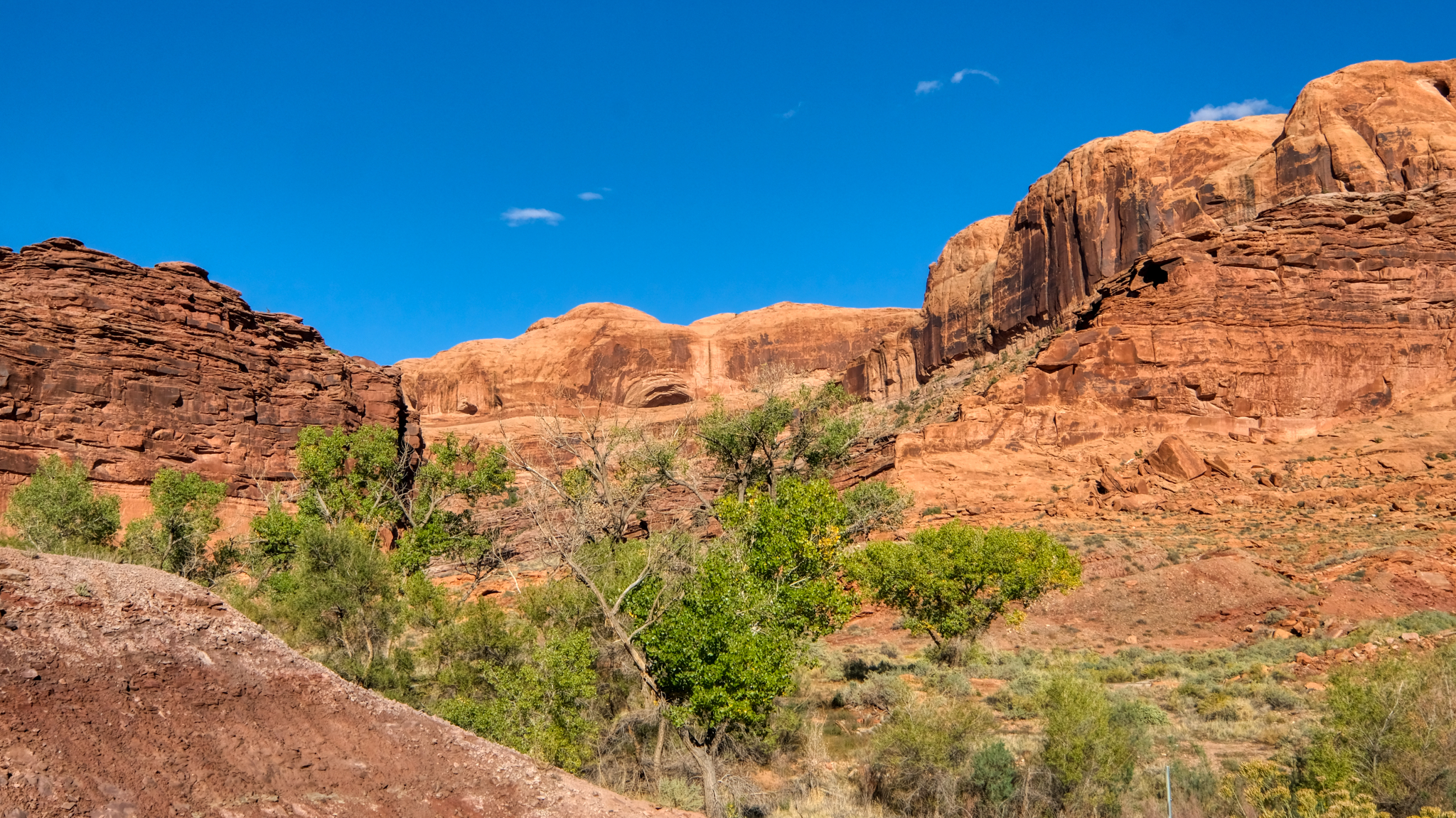 There were only occasionally patches of large plant life . . .
There were only occasionally patches of large plant life . . .
 I rode my bike on up the very long steep uphill trail . . . noticing more "cactus" type plants the higher I went.
I rode my bike on up the very long steep uphill trail . . . noticing more "cactus" type plants the higher I went.
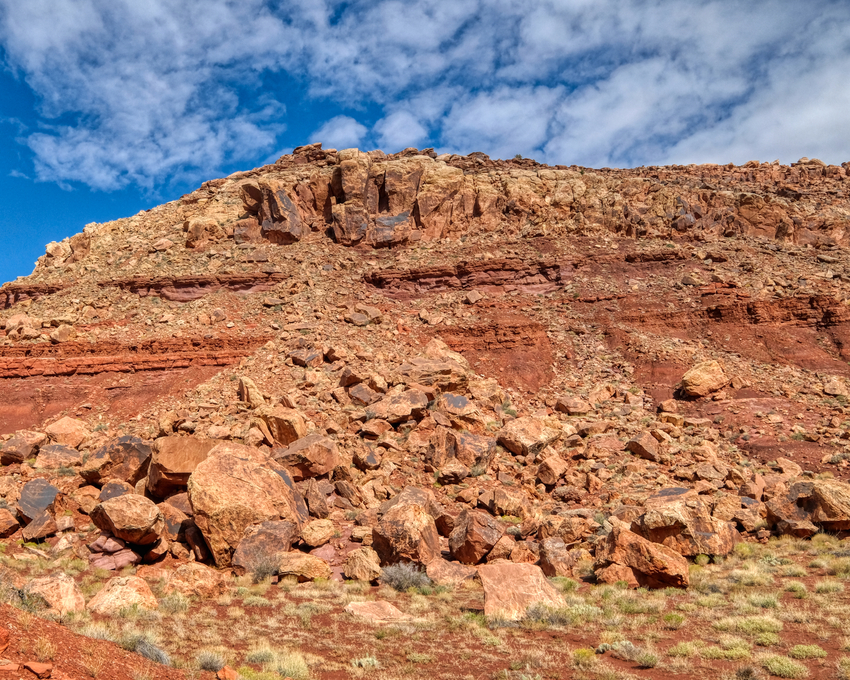 More and more geological changes.
More and more geological changes.
 Rocky desert portrait.
Rocky desert portrait.
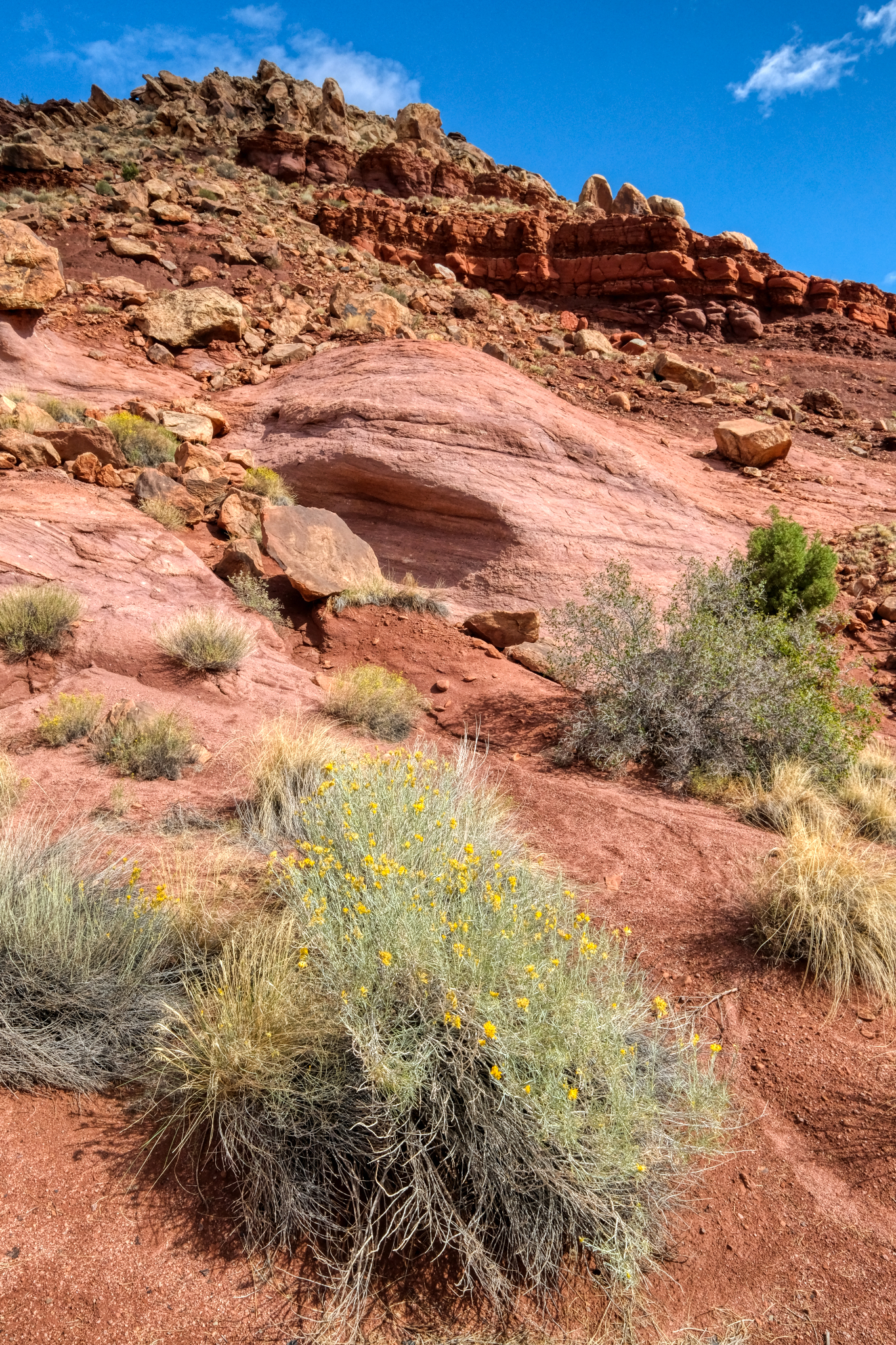 Rocky desert flora portrait.
Rocky desert flora portrait.
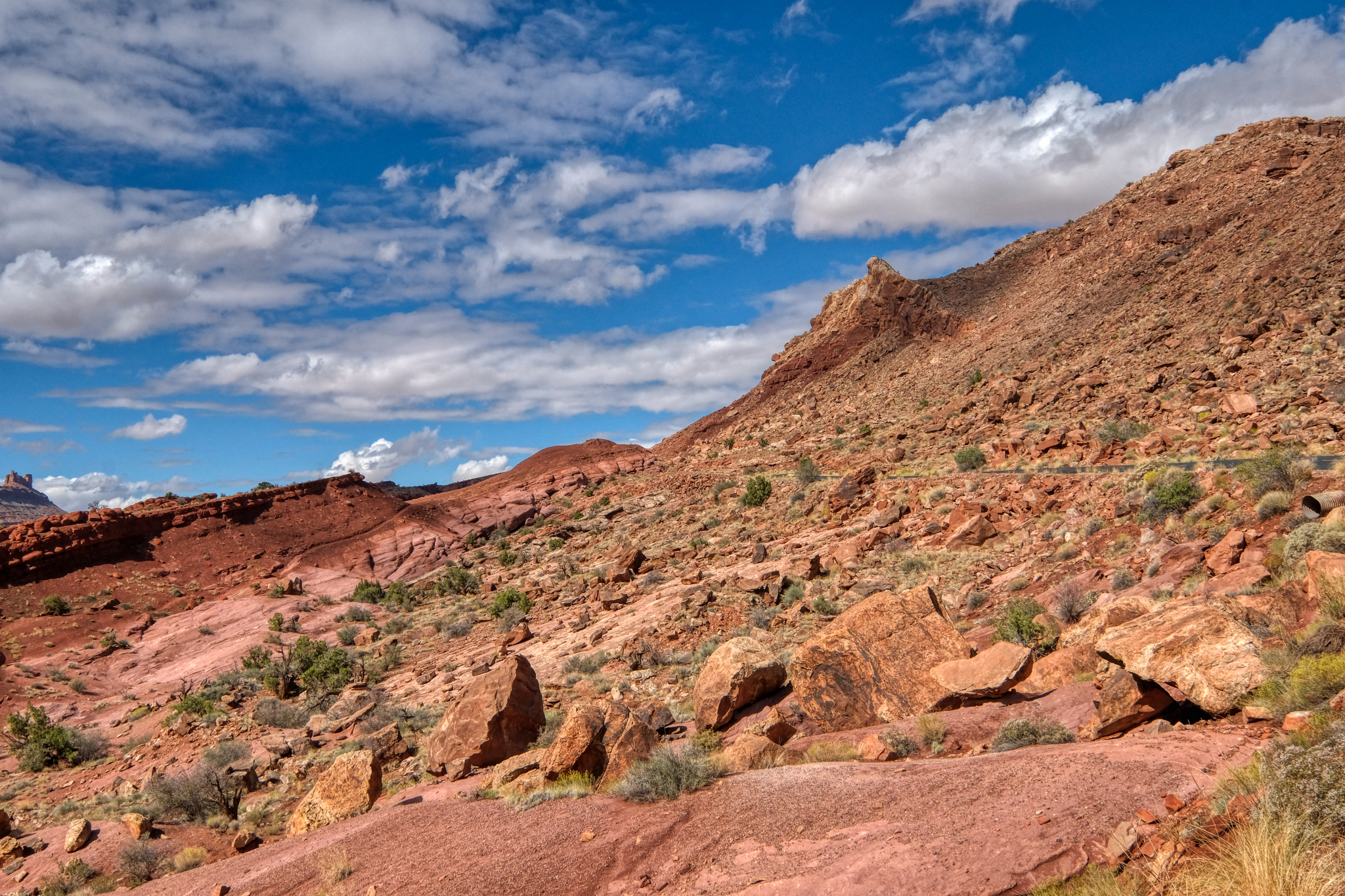 After riding uphill all day I was getting ready to turn back in the late afternoon . . . after I climbed this last steep hill.
After riding uphill all day I was getting ready to turn back in the late afternoon . . . after I climbed this last steep hill.
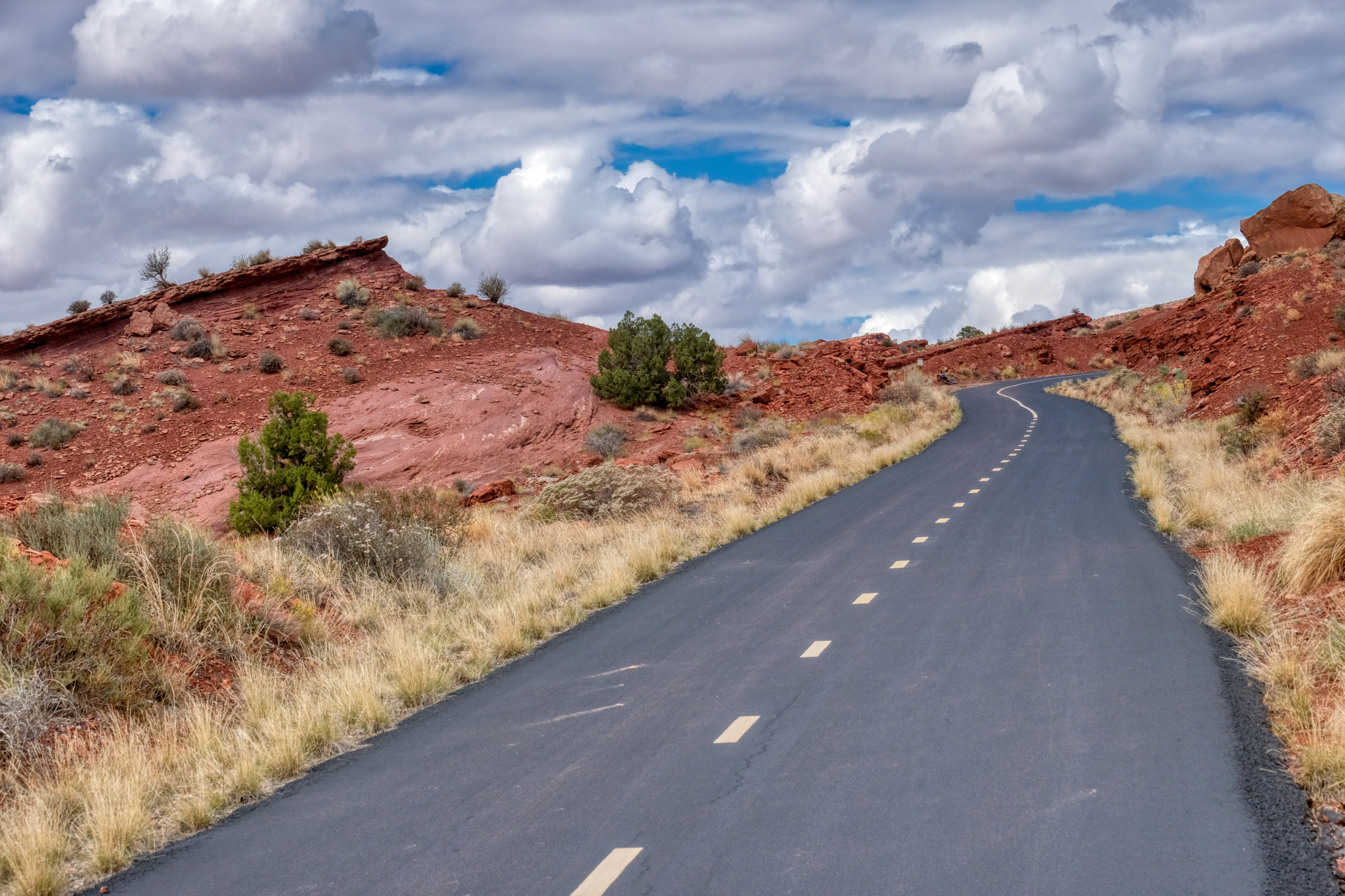 My last steep climb.
My last steep climb.
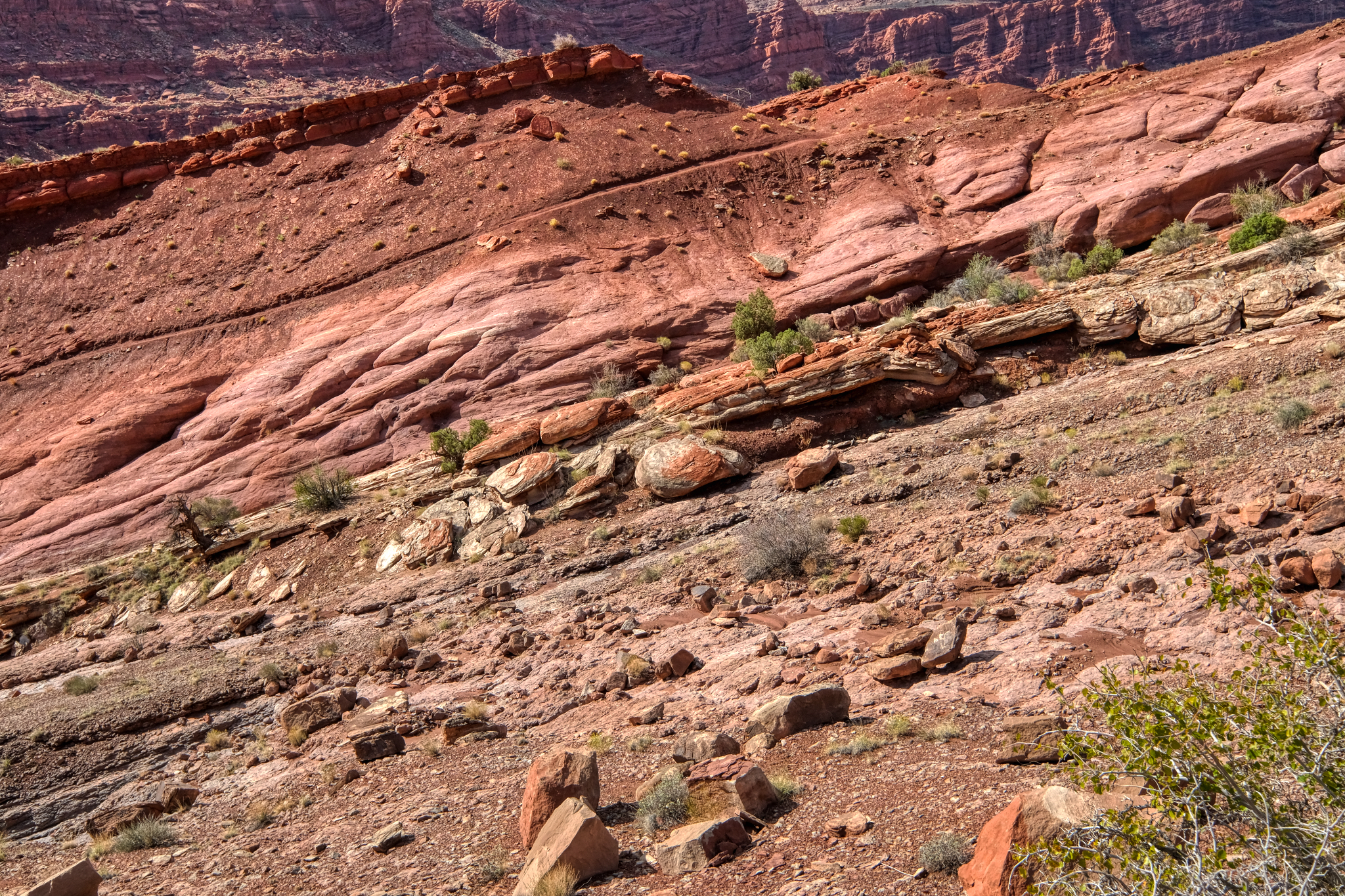 At last I reach my 'this is far enough for the day' point . . . and it was beautiful. I consoled myself with the knowledge that it would be all downhill to my RV camp site in Moab.
At last I reach my 'this is far enough for the day' point . . . and it was beautiful. I consoled myself with the knowledge that it would be all downhill to my RV camp site in Moab.
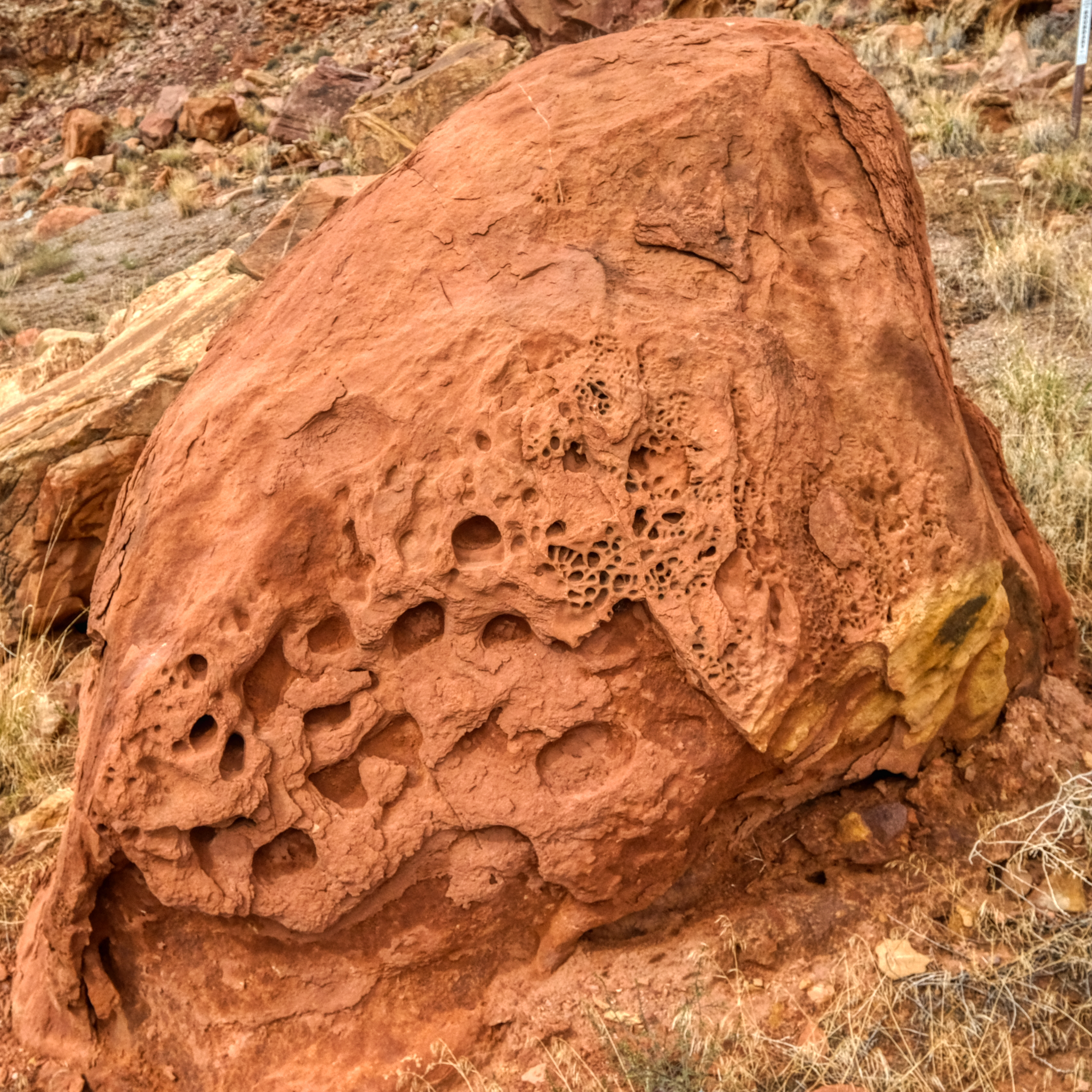 I felt that it must get pretty windy and dusty up here . . . and turned around right here . . .
I felt that it must get pretty windy and dusty up here . . . and turned around right here . . .
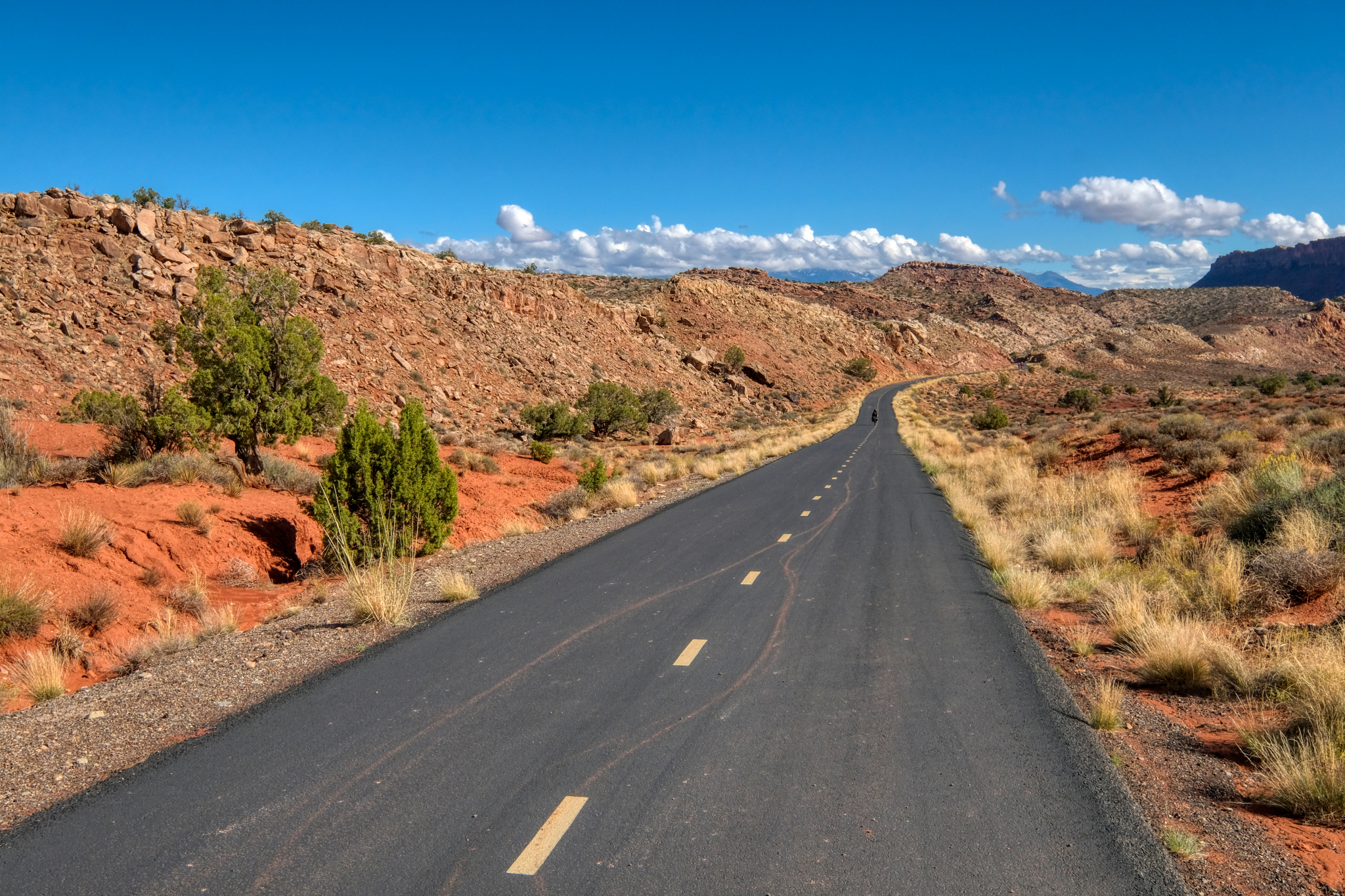 And downhill I went . . . and saw the very first bike rider all day . . . a woman from South Africa. She stopped and we asked each other where we were from. I said Bangkok, Thailand . . . and she laughed. On we rode, she uphill, and I coasting back to my camper.
And downhill I went . . . and saw the very first bike rider all day . . . a woman from South Africa. She stopped and we asked each other where we were from. I said Bangkok, Thailand . . . and she laughed. On we rode, she uphill, and I coasting back to my camper.
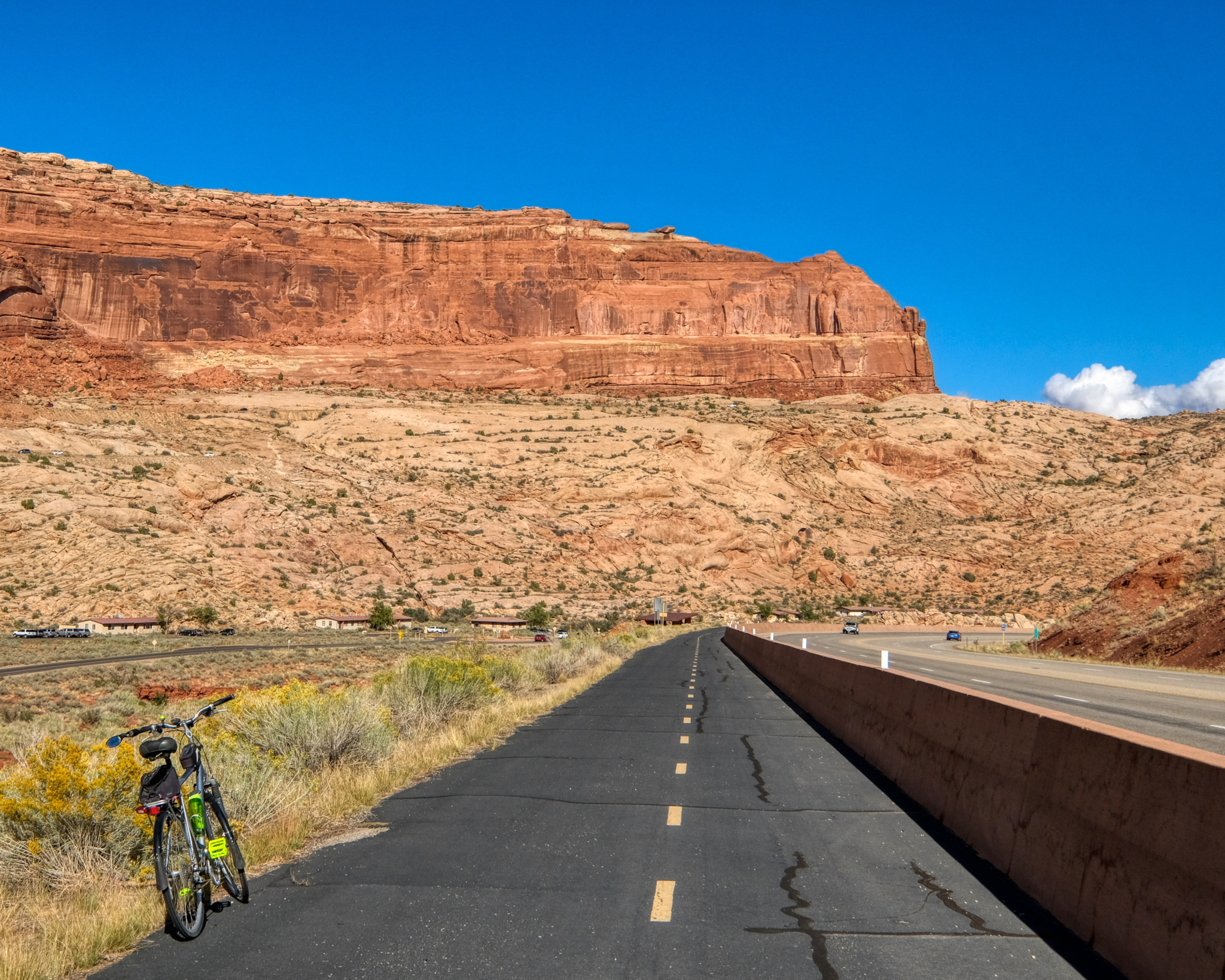 The bike trail ran next to Highway 191 for a short while on my way back.
The bike trail ran next to Highway 191 for a short while on my way back.
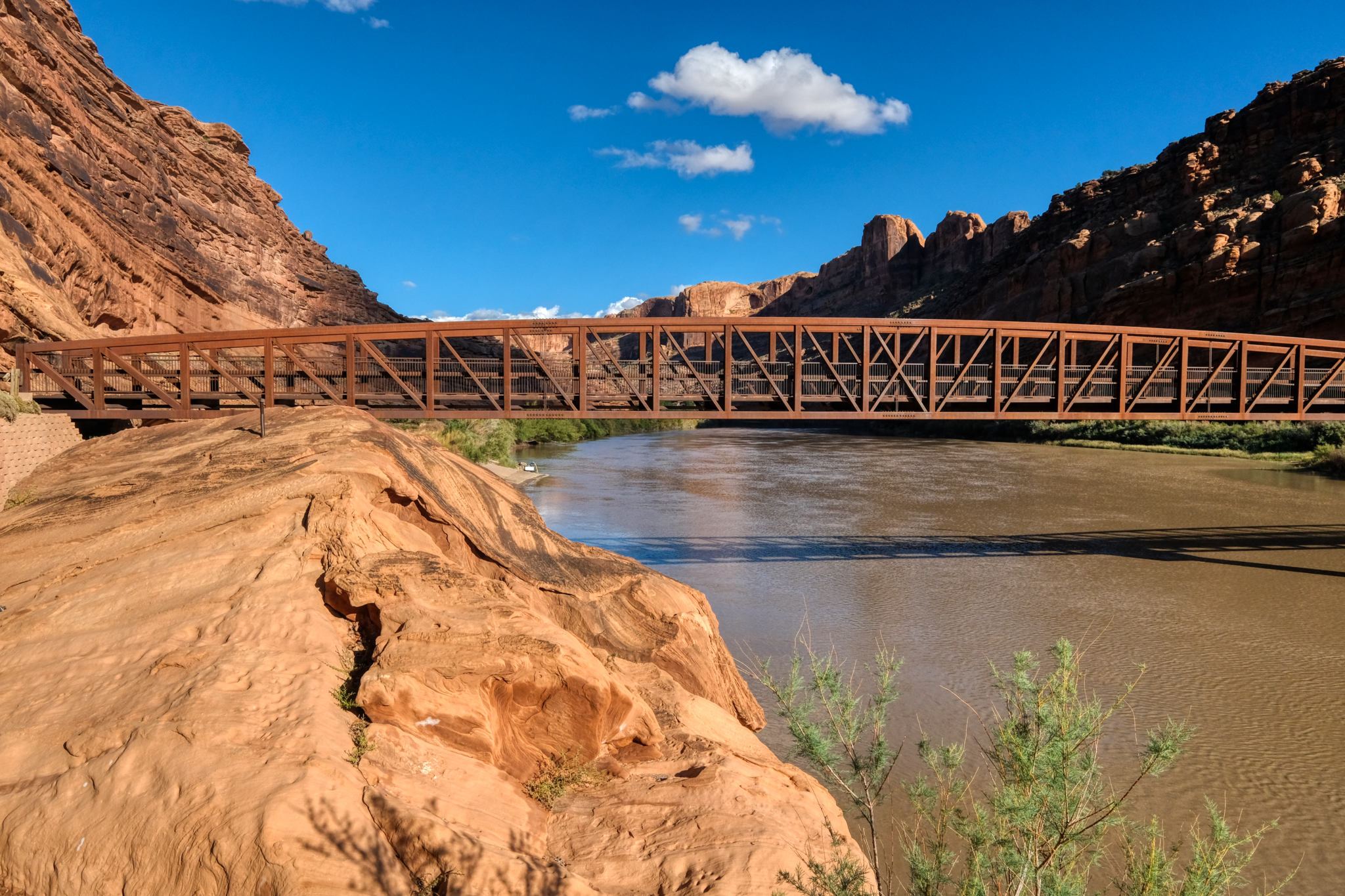 And back across the Colorado River bike bridge . . .
And back across the Colorado River bike bridge . . .
 My last stop for a photo of my bike and a stone cliff . . . not far from my Slick Rock RV Campground (very nice place with very nice people working there). The next morning I would wake before dawn . . . and before coffee . . . for the long drive over the Rocky Mountains to my next destination: visiting an old high school friend in Colorado Springs, Colorado.
My last stop for a photo of my bike and a stone cliff . . . not far from my Slick Rock RV Campground (very nice place with very nice people working there). The next morning I would wake before dawn . . . and before coffee . . . for the long drive over the Rocky Mountains to my next destination: visiting an old high school friend in Colorado Springs, Colorado.
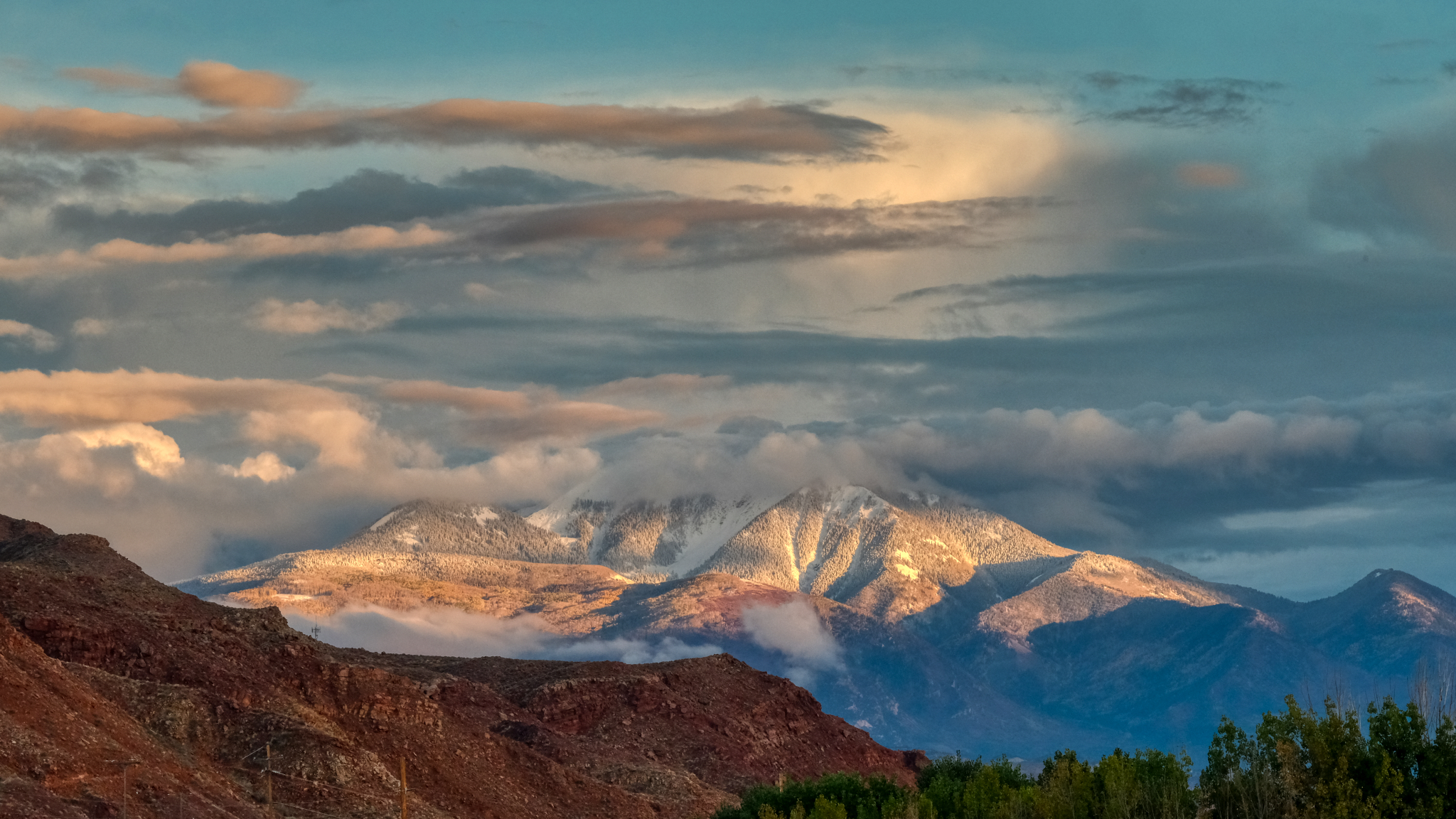 I headed out of Moab on my birthday on highway I-70 heading east to Colorado . . . this was the last view of Utah . . . snow on the mountains . . . little did I know that I would drive across the high Rocky Mountain passes during the very first snow storm of the season . . . but that is another story.
I headed out of Moab on my birthday on highway I-70 heading east to Colorado . . . this was the last view of Utah . . . snow on the mountains . . . little did I know that I would drive across the high Rocky Mountain passes during the very first snow storm of the season . . . but that is another story.
 Dr. Jeff Harper | Comments Off |
Dr. Jeff Harper | Comments Off | Pandemic Silver Linings: Two Week-End Trips in Khao Yai
 Sunday, March 21, 2021 at 11:16AM
Sunday, March 21, 2021 at 11:16AM The first Khao Yai week-end . . . . small roads and beautiful temples.
 As my university has called off live, in-person instruction, I have been making my lessons at home and posting them online. This has had the hidden benefit of allowing me to physically be wherever I want to be, as long as I have a computer and a good internet connection. So twice in the last month my wonderful wife and I have gone up to the mountains of Khao Yai, 2 1/2 hours northeast of Bangkok.
As my university has called off live, in-person instruction, I have been making my lessons at home and posting them online. This has had the hidden benefit of allowing me to physically be wherever I want to be, as long as I have a computer and a good internet connection. So twice in the last month my wonderful wife and I have gone up to the mountains of Khao Yai, 2 1/2 hours northeast of Bangkok.
 We visited friends at Toscana Valley in Khao Yai.
We visited friends at Toscana Valley in Khao Yai.
 Khao Yai is a region at the western end of Sankamphaeng Mountain Range and is a heavily wooded area with a fair amount of natural environment still with wild animals, such as elephant and tigers, in the Khao Yai National Park.
Khao Yai is a region at the western end of Sankamphaeng Mountain Range and is a heavily wooded area with a fair amount of natural environment still with wild animals, such as elephant and tigers, in the Khao Yai National Park.
 Although Khao Yai is known for the National Park, much of the region is developed for weekenders from Bangkok to escape the city hear (especially in the 'cool season'). There are many, many small resorts and tourist activities sprinkled around the beautiful countryside . . . as well as an interesting assortment of Buddhist Wats.
Although Khao Yai is known for the National Park, much of the region is developed for weekenders from Bangkok to escape the city hear (especially in the 'cool season'). There are many, many small resorts and tourist activities sprinkled around the beautiful countryside . . . as well as an interesting assortment of Buddhist Wats.
 So, while my wife played golf at the beautiful courses in the area, I explored the small roads to see what I could see. . . .
So, while my wife played golf at the beautiful courses in the area, I explored the small roads to see what I could see. . . .
 I had fun following 'points of interest' signs . . . and seeing if I could get to the hilltop temples I could see here and there in the landscape.
I had fun following 'points of interest' signs . . . and seeing if I could get to the hilltop temples I could see here and there in the landscape.
 Wat Sanaamsai is a giant white Buddha statue on top of a hill. To get there you have to climb up hundreds of stairs.
Wat Sanaamsai is a giant white Buddha statue on top of a hill. To get there you have to climb up hundreds of stairs.
 Hundreds of stairs and hundreds of bells to be rung.
Hundreds of stairs and hundreds of bells to be rung.
 I am often amused by the cartoonish monks who adorn Buddhist shrines and altars in Thailand. I decided to light some incense and candles before I embarked on the hundreds of steps. Fortunately, some nice people pointed out that I could drive all the way to the top if I wanted to. So I drove up.
I am often amused by the cartoonish monks who adorn Buddhist shrines and altars in Thailand. I decided to light some incense and candles before I embarked on the hundreds of steps. Fortunately, some nice people pointed out that I could drive all the way to the top if I wanted to. So I drove up.
 In addition to a fine mandala, there was a wonderful view across Khao Yai from the top of the stairs.
In addition to a fine mandala, there was a wonderful view across Khao Yai from the top of the stairs.
 I was glad that I hadn't walked up the stairs!
I was glad that I hadn't walked up the stairs!
 A fantastic giant Buddha image looking out over the valley.
A fantastic giant Buddha image looking out over the valley.

I loved this row of Buddha statues in the many symbolic poses.
 So many beautiful Wats in rural Thailand, and it seemed like there were more than the average number here in Khao Yai.
So many beautiful Wats in rural Thailand, and it seemed like there were more than the average number here in Khao Yai.
 Such a pretty setting for this hilltop Wat.
Such a pretty setting for this hilltop Wat.
 Back out driving on the small farm roads through a great variety of agricultural crops. These were planted in quite a few fields . . . but I have no idea what they were for.
Back out driving on the small farm roads through a great variety of agricultural crops. These were planted in quite a few fields . . . but I have no idea what they were for.
 Even out on the smallest rural roads there are little stalls for Thai street food.
Even out on the smallest rural roads there are little stalls for Thai street food.
 I saw a temple on a hill top and drove along very small rural lanes until I found the entrance.
I saw a temple on a hill top and drove along very small rural lanes until I found the entrance.
 I eventually found the Wat entry . . . and drove up the steep hill.
I eventually found the Wat entry . . . and drove up the steep hill.
 The road did not go all the way to the top. I parked and found the steep steps to the top. I opted to take a service path that wound along the side of the steep hill.
The road did not go all the way to the top. I parked and found the steep steps to the top. I opted to take a service path that wound along the side of the steep hill.
 The walk up to the temple had wonderful views out over the surrounding farm land. Some say this area looks like the Italian countryside around Tuscany.
The walk up to the temple had wonderful views out over the surrounding farm land. Some say this area looks like the Italian countryside around Tuscany.
 I arrived at last on top to discover a very fine, new Wat.
I arrived at last on top to discover a very fine, new Wat.
 Magnificent. Wat Pa Phu Hai Long.
Magnificent. Wat Pa Phu Hai Long.
 Buddhas of all kinds atop the hill.
Buddhas of all kinds atop the hill.
 A grand view.
A grand view.
 I love these stone balls that have been covered in gold leaf by pilgrims.
I love these stone balls that have been covered in gold leaf by pilgrims.
 Such an interesting contrast of shapes and textures . . .
Such an interesting contrast of shapes and textures . . .
 I left a donation at the beautiful altar.
I left a donation at the beautiful altar.
 I was sorry I had to leave this wat . . . it was so beautiful up on the hilltop.
I was sorry I had to leave this wat . . . it was so beautiful up on the hilltop.
 I enjoyed my walk back down the hill from the temple . . . and admired the view. Many people say this region of Thailand reminds them of Tuscany in Italy . . . yes, it does.
I enjoyed my walk back down the hill from the temple . . . and admired the view. Many people say this region of Thailand reminds them of Tuscany in Italy . . . yes, it does.
 I saw this little fellow near the car park.
I saw this little fellow near the car park.
 We stayed at the guest house at the Tuscana Resort, an Italian-themed development for mostly Bangkok week-enders. Beautiful.
We stayed at the guest house at the Tuscana Resort, an Italian-themed development for mostly Bangkok week-enders. Beautiful.
___________________________________________________
A Second Week-end Trip to Khao Yai: A Buddha Cave and a Floating Market Garden
 Another week-end out and about on the country roads of Khao Yai while my wife played golf.
Another week-end out and about on the country roads of Khao Yai while my wife played golf.
 Just a village Wat along a country road.
Just a village Wat along a country road.
 Such a wonderful, and brand new temple. So new, in fact, there was no sign and no marking on GoogleMaps.
Such a wonderful, and brand new temple. So new, in fact, there was no sign and no marking on GoogleMaps.
 There are an abundance of Wats to see in Khao Yai. This one on the way to the Magic Caves.
There are an abundance of Wats to see in Khao Yai. This one on the way to the Magic Caves.
 A beautiful multi-roofed staircase leading to a hilltop Chedi and temple . . .
A beautiful multi-roofed staircase leading to a hilltop Chedi and temple . . .
 I opted not to walk up the hundreds of steps to the top of the hill. The caves beckoned.
I opted not to walk up the hundreds of steps to the top of the hill. The caves beckoned.
 My GPS took me to this place.
My GPS took me to this place.
 My GPS makes perfect artistic decisions sometimes, for next to the hill was this fantastic corrugated building hung with an aging banner of some long forgotten festival. Textures to dream about!
My GPS makes perfect artistic decisions sometimes, for next to the hill was this fantastic corrugated building hung with an aging banner of some long forgotten festival. Textures to dream about!
 Road dust obscuring a sitting monk image . . . and corrugation . . .
Road dust obscuring a sitting monk image . . . and corrugation . . .
 The other end of the banner held another fabulous image.
The other end of the banner held another fabulous image.
MAGIC CAVE LAND
 After snooping around for a while I found the cave entrance located inside Wat Tham Trai Rat, a woman approached me and showed me a card that said she was an official guide for the Magic Cave Land. I asked how much it cost (in Thai)" and she answered in English, "Something or nothing." She took out her keys and we walked in the cave.
After snooping around for a while I found the cave entrance located inside Wat Tham Trai Rat, a woman approached me and showed me a card that said she was an official guide for the Magic Cave Land. I asked how much it cost (in Thai)" and she answered in English, "Something or nothing." She took out her keys and we walked in the cave.
 And down we went under the Earth into a colorful and wondrous world.
And down we went under the Earth into a colorful and wondrous world.
 Not long after the Buddha altar grottos began to appear. Magnificent!
Not long after the Buddha altar grottos began to appear. Magnificent!
 Ad on in to the cave we walked. Of course there were colored psychedelic lighting throughout!
Ad on in to the cave we walked. Of course there were colored psychedelic lighting throughout!
 Buddhas, monks, and hermit statuary throughout.
Buddhas, monks, and hermit statuary throughout.
 Some of the Buddha altars were more formal . . .
Some of the Buddha altars were more formal . . .
 I'll bet this place was on the Hippie 'must see' list!
I'll bet this place was on the Hippie 'must see' list!
 It seemed like wherever you looked there would be a Buddha statue in a nitch in the rocks. Wonderful.
It seemed like wherever you looked there would be a Buddha statue in a nitch in the rocks. Wonderful.
 Although the cave is not completely full of amazing rock formations, there are enough to make anyone with an interest in geology interested.
Although the cave is not completely full of amazing rock formations, there are enough to make anyone with an interest in geology interested.
 There were some fascinating flowing rock formations.
There were some fascinating flowing rock formations.
 After about 39 minutes of walking and stooping through narrow and low passages, a sign in the dim shadows appeared . . . I thought, "this is going to be interesting" . . .
After about 39 minutes of walking and stooping through narrow and low passages, a sign in the dim shadows appeared . . . I thought, "this is going to be interesting" . . .
 "Interesting" is an understatement. Truly a wondrous thing to see deep in a cave in Thailand.
"Interesting" is an understatement. Truly a wondrous thing to see deep in a cave in Thailand.
 Not only 'cave man bones' but the bones of animals and perhaps other humans were embedded in the stone display.
Not only 'cave man bones' but the bones of animals and perhaps other humans were embedded in the stone display.
 We caught up with a big family here . . . they were rubbing the bones and then spreading the 'bone spirits' around their heads . . . so, of course, I did the same. Very therapeutic.
We caught up with a big family here . . . they were rubbing the bones and then spreading the 'bone spirits' around their heads . . . so, of course, I did the same. Very therapeutic.
 As there always are, pots for making donations to the upkeep of the caves and nearby wat. I left coins in each.
As there always are, pots for making donations to the upkeep of the caves and nearby wat. I left coins in each.
 At one point there was an opening in the cave ceiling and a perfect light shaft shown through . . . I wished it had fallen on a golden Buddha . . . but it didn't.
At one point there was an opening in the cave ceiling and a perfect light shaft shown through . . . I wished it had fallen on a golden Buddha . . . but it didn't.
 My favorite Buddha altar in the cave. Magnificent.
My favorite Buddha altar in the cave. Magnificent.
 Astonishingly beautiful cave Buddha altar.
Astonishingly beautiful cave Buddha altar.
 Colorfully lit passages . . .
Colorfully lit passages . . .
 Passing from underground room to room and 'discovering' new vistas and Buddha altars. Extraordinary!
Passing from underground room to room and 'discovering' new vistas and Buddha altars. Extraordinary!
 After a 90 minute 'tour' underground we at last came to the stairs leading out. It was a very interesting experience in a low key kind of way. The cave was very low key, not at all an over-developed tourist attraction. It is, after all a Buddhist temple.
After a 90 minute 'tour' underground we at last came to the stairs leading out. It was a very interesting experience in a low key kind of way. The cave was very low key, not at all an over-developed tourist attraction. It is, after all a Buddhist temple.
The Khao Yai Floating Market
 I stopped in at the Khao Yai Floating Market and was greeted by this old Chevy pick-up. Nice.
I stopped in at the Khao Yai Floating Market and was greeted by this old Chevy pick-up. Nice.
 Another nice, funky old Vespa with a side-car at the entrance.
Another nice, funky old Vespa with a side-car at the entrance.
 Although it would be fair to say that the Khao Yai Floating Market is a bit of a 'tourist trap' . . . it is not without its charms, beauty, interest, pretty gardens, and photo opportunities.
Although it would be fair to say that the Khao Yai Floating Market is a bit of a 'tourist trap' . . . it is not without its charms, beauty, interest, pretty gardens, and photo opportunities.
 You enter the 'floating market' through pleasant gardens before walking 100 meters down a hill to the pond (not a river) they dug for the water feature.
You enter the 'floating market' through pleasant gardens before walking 100 meters down a hill to the pond (not a river) they dug for the water feature.
 I didn't have a map of the layout, so I followed the signs . . . OH! COFFEE! I'll have to check it out . . . but first . . .
I didn't have a map of the layout, so I followed the signs . . . OH! COFFEE! I'll have to check it out . . . but first . . .
 I started along this wooden boardwalk to explore the old buildings. Very pretty.
I started along this wooden boardwalk to explore the old buildings. Very pretty.
 The actual 'floating market' does not actually float. It is a manufactured replica of a traditional Thai floating market [my photos of a real floating market can be found here]. It looks nice, but is not authentic.
The actual 'floating market' does not actually float. It is a manufactured replica of a traditional Thai floating market [my photos of a real floating market can be found here]. It looks nice, but is not authentic.
 Before the pandemic, one assumes, Bangkok week-enders would flock here for food, a little shopping, and to enjoy the gardens.
Before the pandemic, one assumes, Bangkok week-enders would flock here for food, a little shopping, and to enjoy the gardens.
 At 10:00am on the morning I visited the Khao Yai Floating Market I was the only patron.
At 10:00am on the morning I visited the Khao Yai Floating Market I was the only patron.
 Fortunately there was ONE little food stand open selling my favorite papaya salad (sum-tam).
Fortunately there was ONE little food stand open selling my favorite papaya salad (sum-tam).
 A side order of sticky rice and puffed rice cakes (and a CokeZero) made a nice snack. It was delicious.
A side order of sticky rice and puffed rice cakes (and a CokeZero) made a nice snack. It was delicious.
 I cold see that it would be nice to while away a hot afternoon in a hammock here . . .
I cold see that it would be nice to while away a hot afternoon in a hammock here . . .
 There were a few antique items setting around to create an old-timey feel.
There were a few antique items setting around to create an old-timey feel.
 The wooden boardwalk was a thing of beauty (to me!). It was a little strange to be in this place all alone . . .
The wooden boardwalk was a thing of beauty (to me!). It was a little strange to be in this place all alone . . .
 I was fascinated by this old barber shop . . . I wondered if a real barber occupied it as a business during more touristy times.
I was fascinated by this old barber shop . . . I wondered if a real barber occupied it as a business during more touristy times.
 All the little shops along the boardwalk were closed . . . on to the gardens.
All the little shops along the boardwalk were closed . . . on to the gardens.
 This is good. I love flower gardens.
This is good. I love flower gardens.
 A vast and wonderful hillside garden greeted me!
A vast and wonderful hillside garden greeted me!
 They had a good eye for color.
They had a good eye for color.
 I followed a black butterfly around for a while . . .
I followed a black butterfly around for a while . . .
 Sunflowers are such a happy sight . . . always.
Sunflowers are such a happy sight . . . always.
 A sunflower is an amazingly complex thing.
A sunflower is an amazingly complex thing.
 A sunflower is one big flower filled with many, many smaller flowers opening up in rings around the center. WOW!
A sunflower is one big flower filled with many, many smaller flowers opening up in rings around the center. WOW!
 Each sunflower is quite unique.
Each sunflower is quite unique.
 Someone thought it was a good idea to plant sunflowers in the rose garden . . . it sorta worked . . .
Someone thought it was a good idea to plant sunflowers in the rose garden . . . it sorta worked . . .
 Many different flower beds winding up the hill to what I hoped was an open coffee stand.
Many different flower beds winding up the hill to what I hoped was an open coffee stand.
 Beautiful colored whispy fronds.
Beautiful colored whispy fronds.
 The flower gardens were quite extensive and well-maintained, considering the wet season had yet to begin.
The flower gardens were quite extensive and well-maintained, considering the wet season had yet to begin.
 Up on the hill were a row of lounging huts . . . places to spend the day.
Up on the hill were a row of lounging huts . . . places to spend the day.
 The coffee shop was open . . . and the coffee was delicious. There were pleasant places to relax while enjoying the coffee (and a brownie) too.
The coffee shop was open . . . and the coffee was delicious. There were pleasant places to relax while enjoying the coffee (and a brownie) too.
 Two couples in their 20s showed up and took photos of each other in this heart-shaped 'frame.'
Two couples in their 20s showed up and took photos of each other in this heart-shaped 'frame.'
 It was hot, and it was time to leave. I walked back down the hill under the cover on these wonderful stairs.
It was hot, and it was time to leave. I walked back down the hill under the cover on these wonderful stairs.
 Shadow and pattern . . . on the stairs down . . .
Shadow and pattern . . . on the stairs down . . .
 I passed this along the way . . . I have no idea what the plan was for it . . . but it was very interesting.
I passed this along the way . . . I have no idea what the plan was for it . . . but it was very interesting.
 And back along the pond . . .
And back along the pond . . .
 . . . and across a very rickety bamboo bridge . . .
. . . and across a very rickety bamboo bridge . . .
 For some reason, there was an old fashioned schoolroom set up. I suspect the developers were collectors of all kinds of old stuff, and this project was a good place to display it.
For some reason, there was an old fashioned schoolroom set up. I suspect the developers were collectors of all kinds of old stuff, and this project was a good place to display it.
 And at last I was back to the Strawberry People and the park exit. It was worth the nominal entry fee for a nice morning of photography and coffee.
And at last I was back to the Strawberry People and the park exit. It was worth the nominal entry fee for a nice morning of photography and coffee.
 And we finished the day at our friends house for a magnificent BBQ in Toscana.
And we finished the day at our friends house for a magnificent BBQ in Toscana.